The document outlines a security and vulnerability assessment using tools like Microsoft Baseline Security Analyzer (MBSA) for Windows and OpenVAS for Linux. It highlights various vulnerabilities including missing security updates, administrative control issues, and password policies across both Windows and Linux systems. Additionally, it discusses password cracking experiments and ethical considerations in using password recovery tools, as well as provides insights into a risk assessment report for the Amazon Corporation.
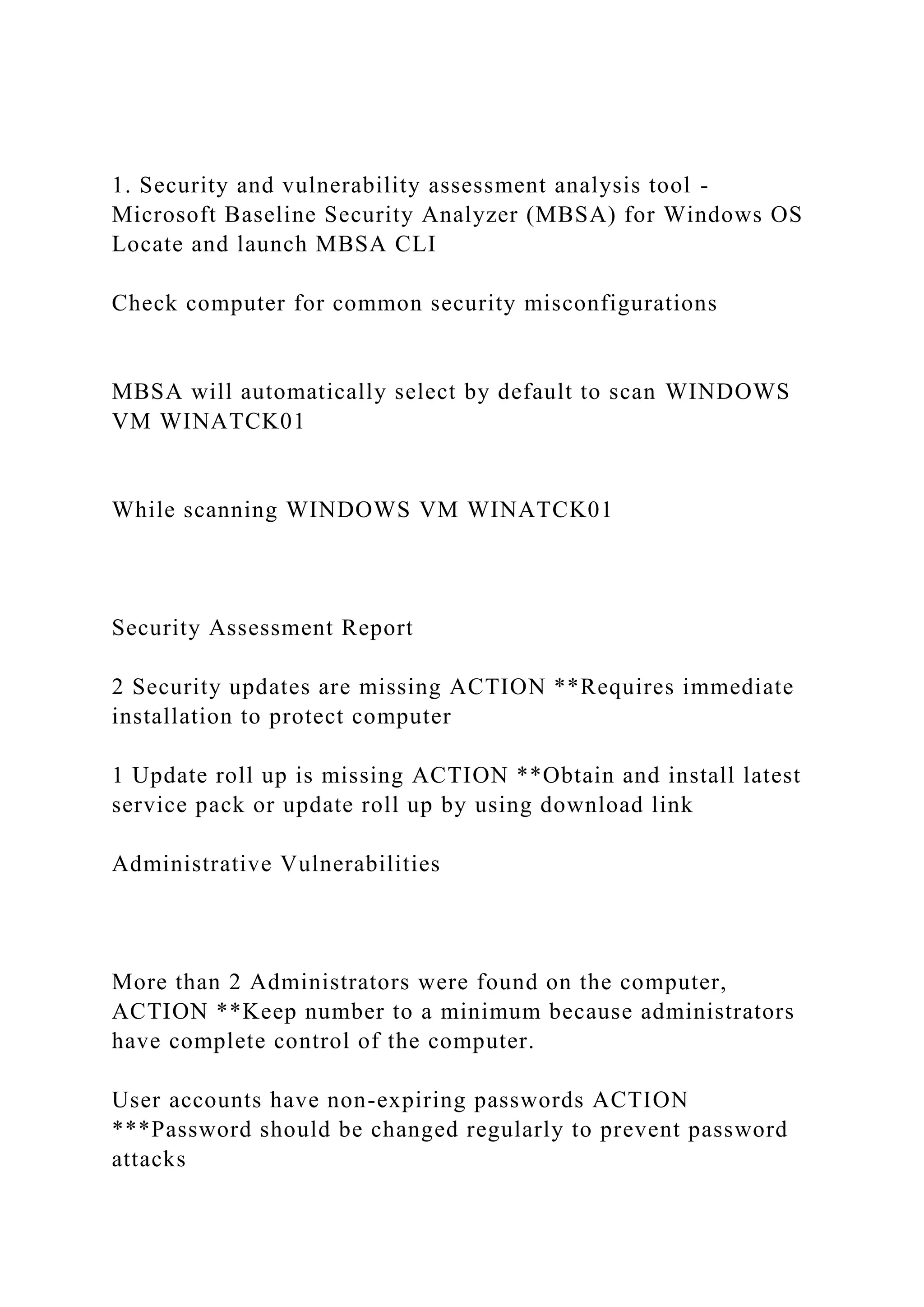
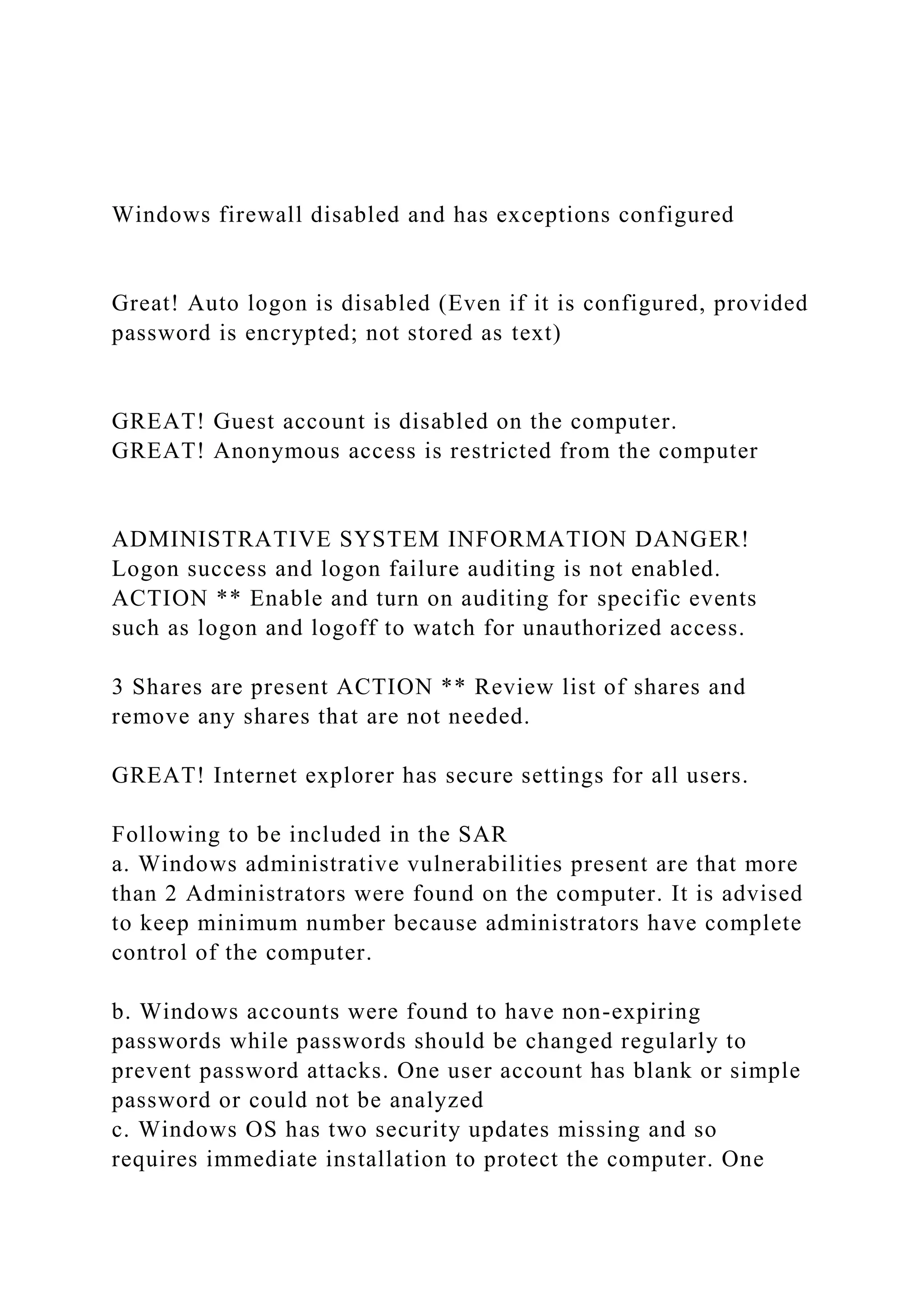
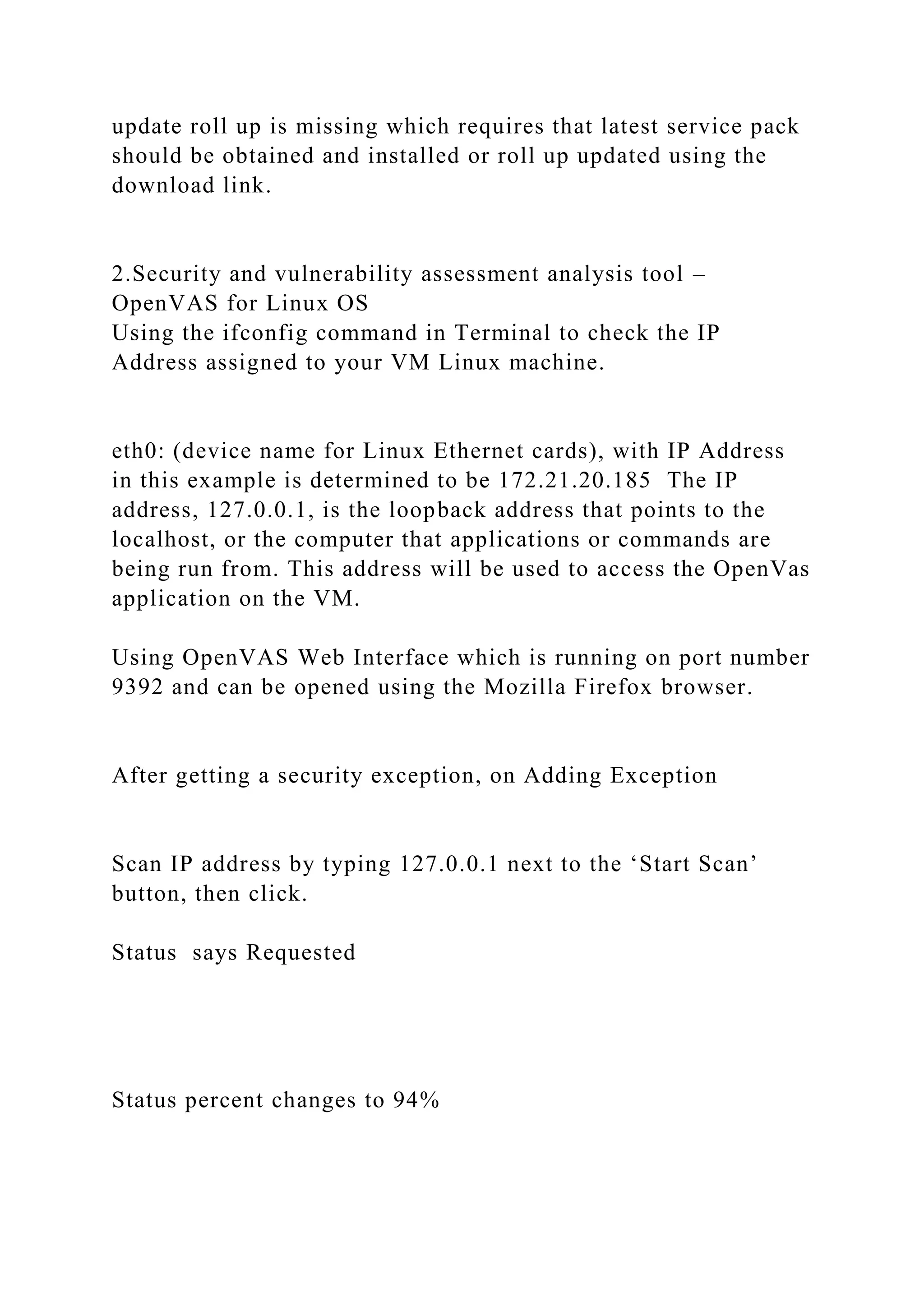
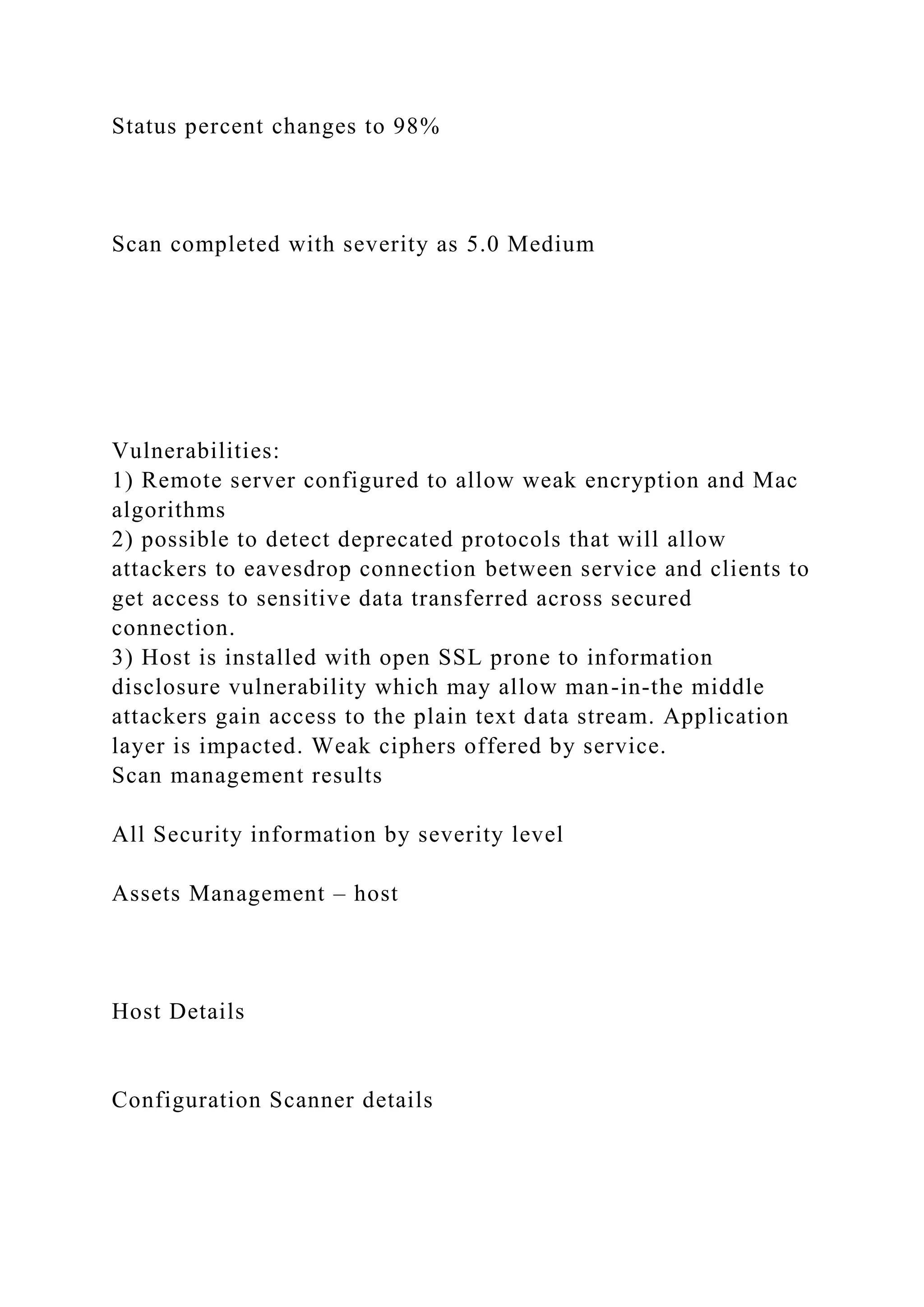
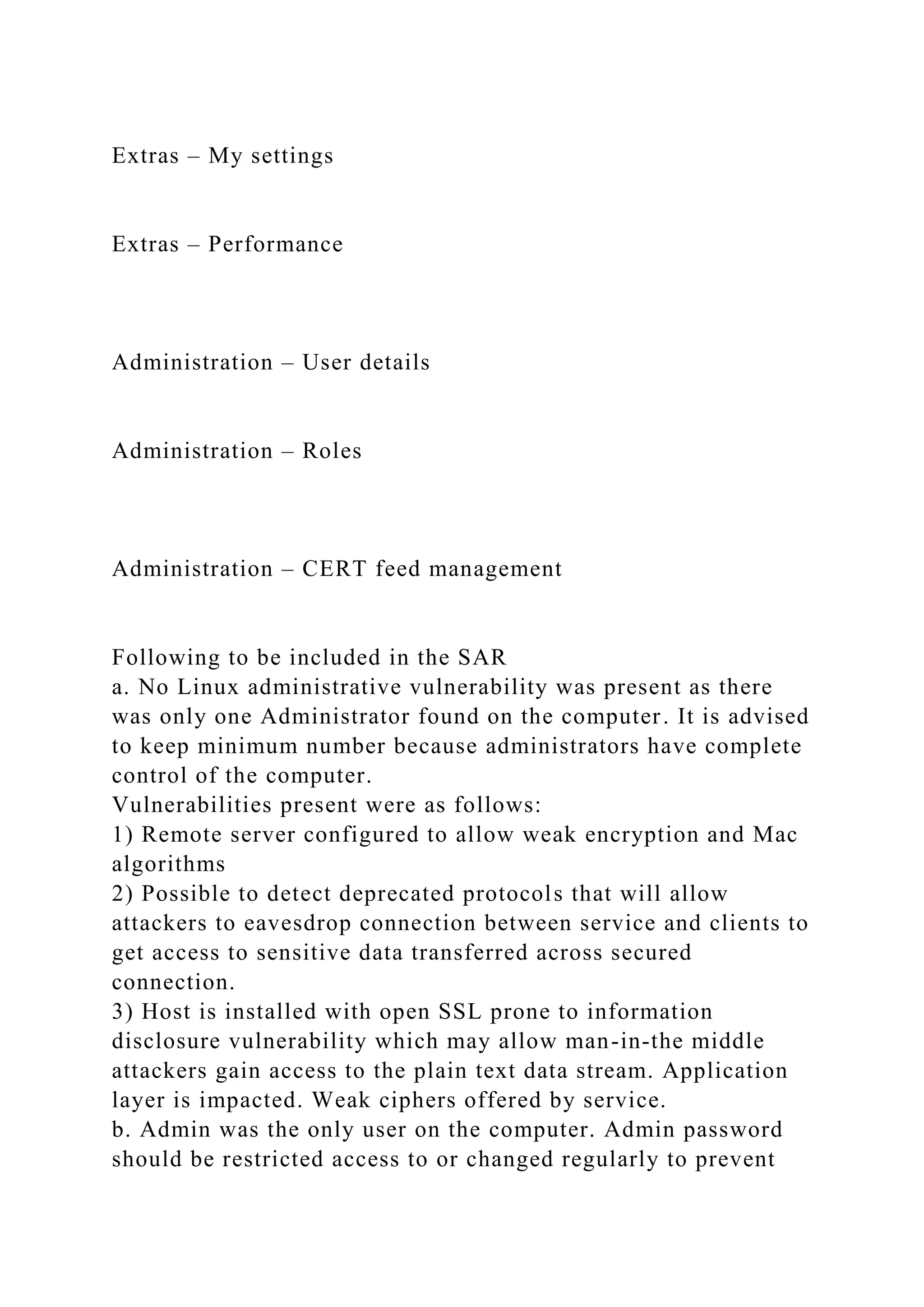

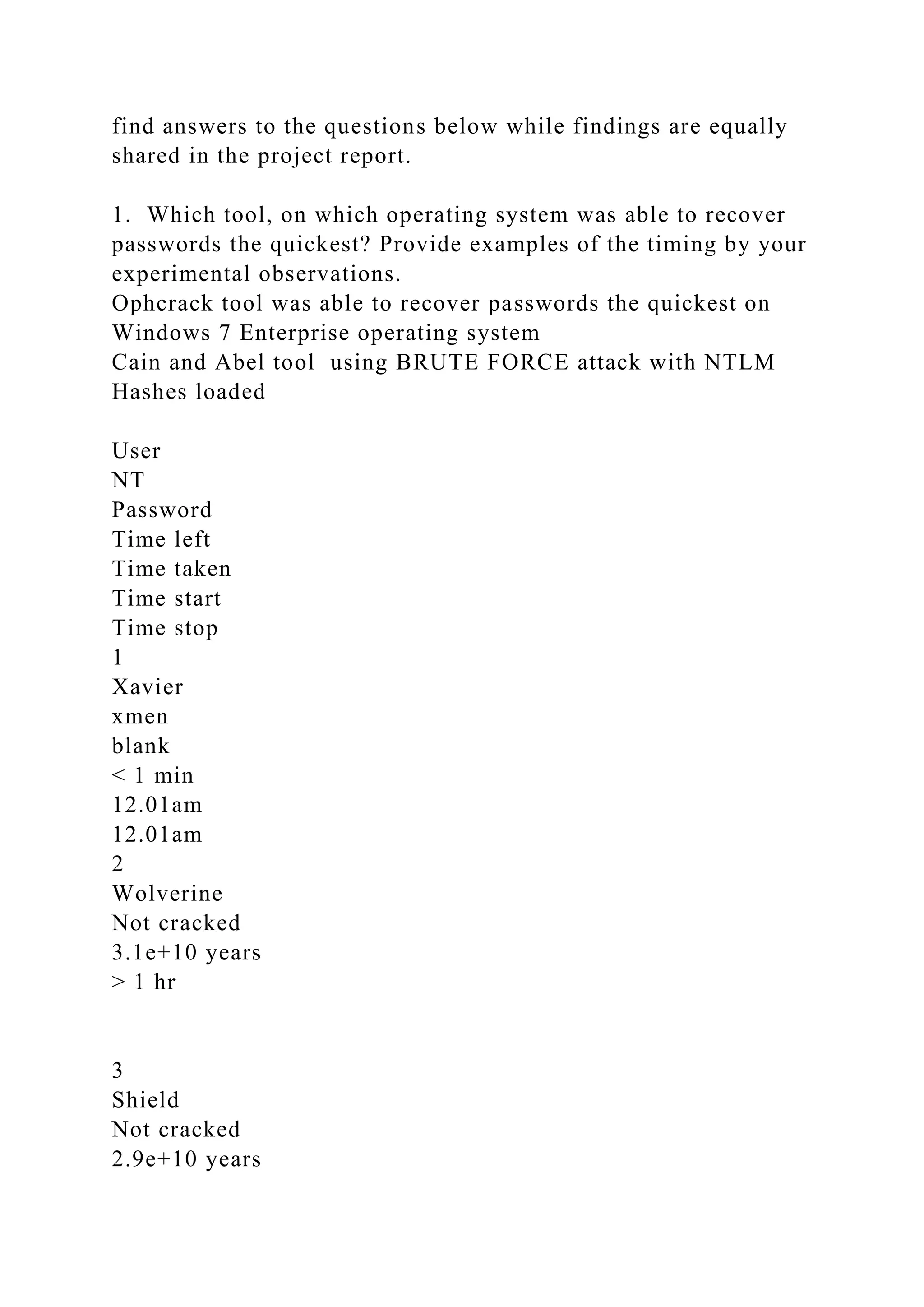
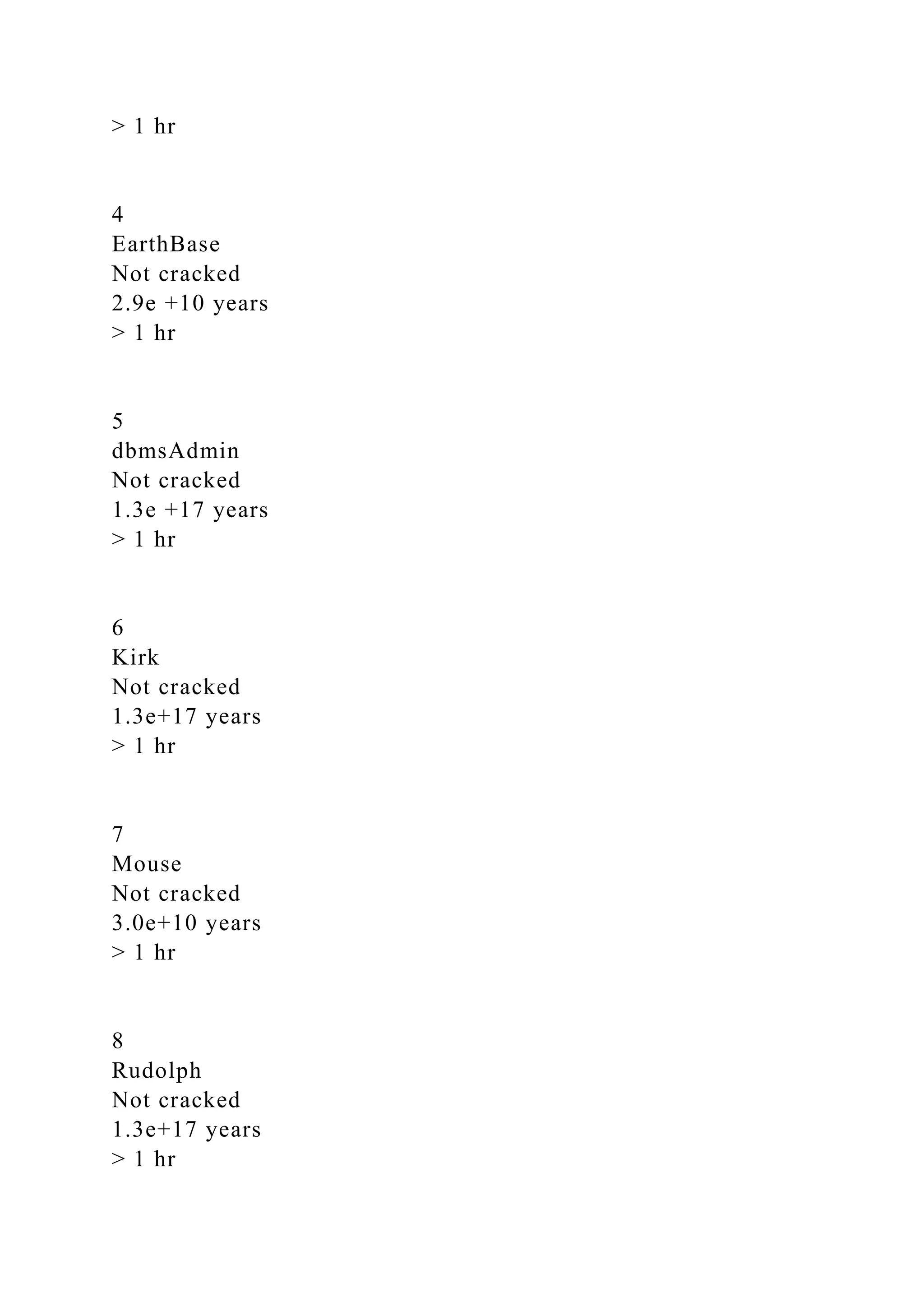


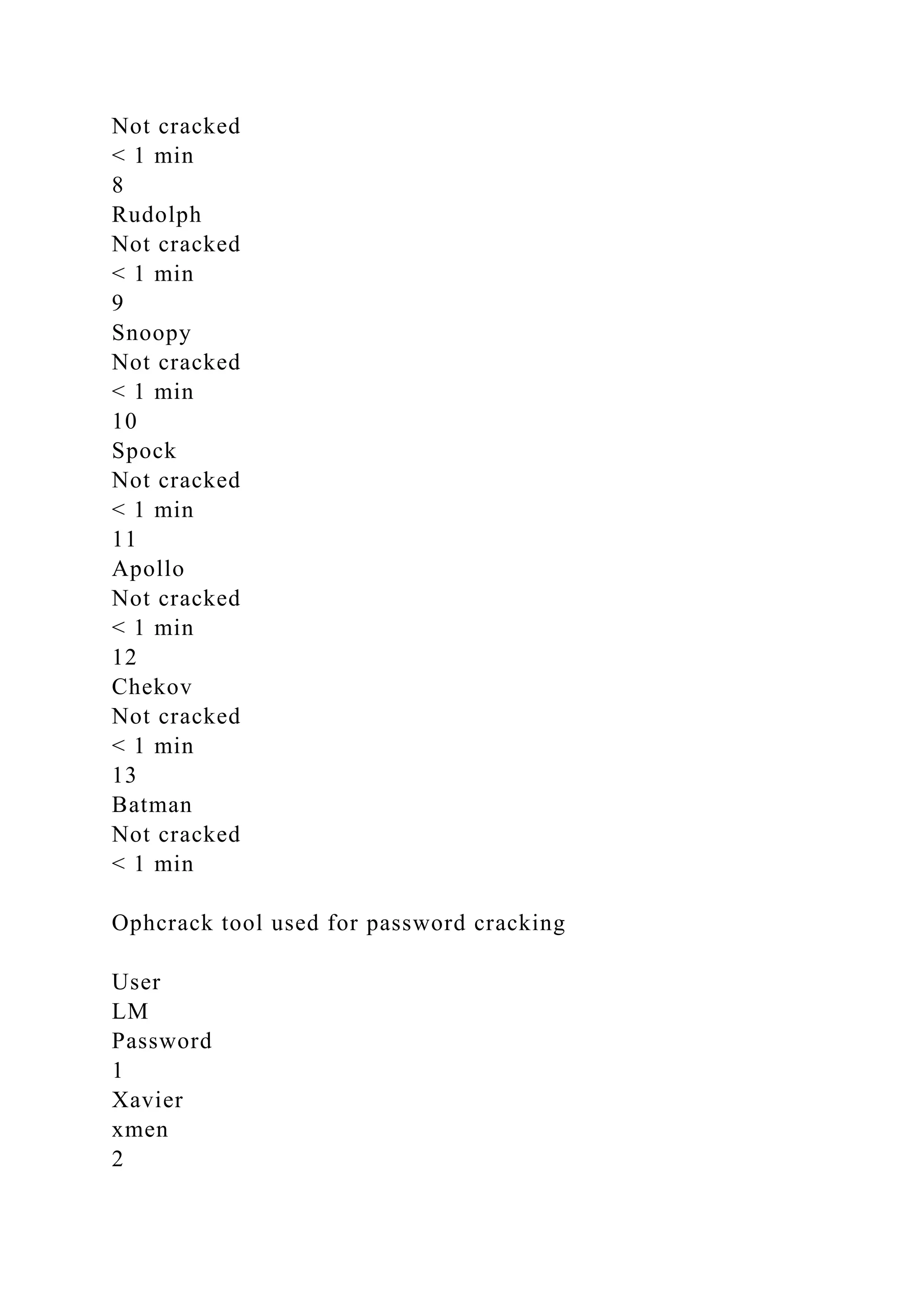

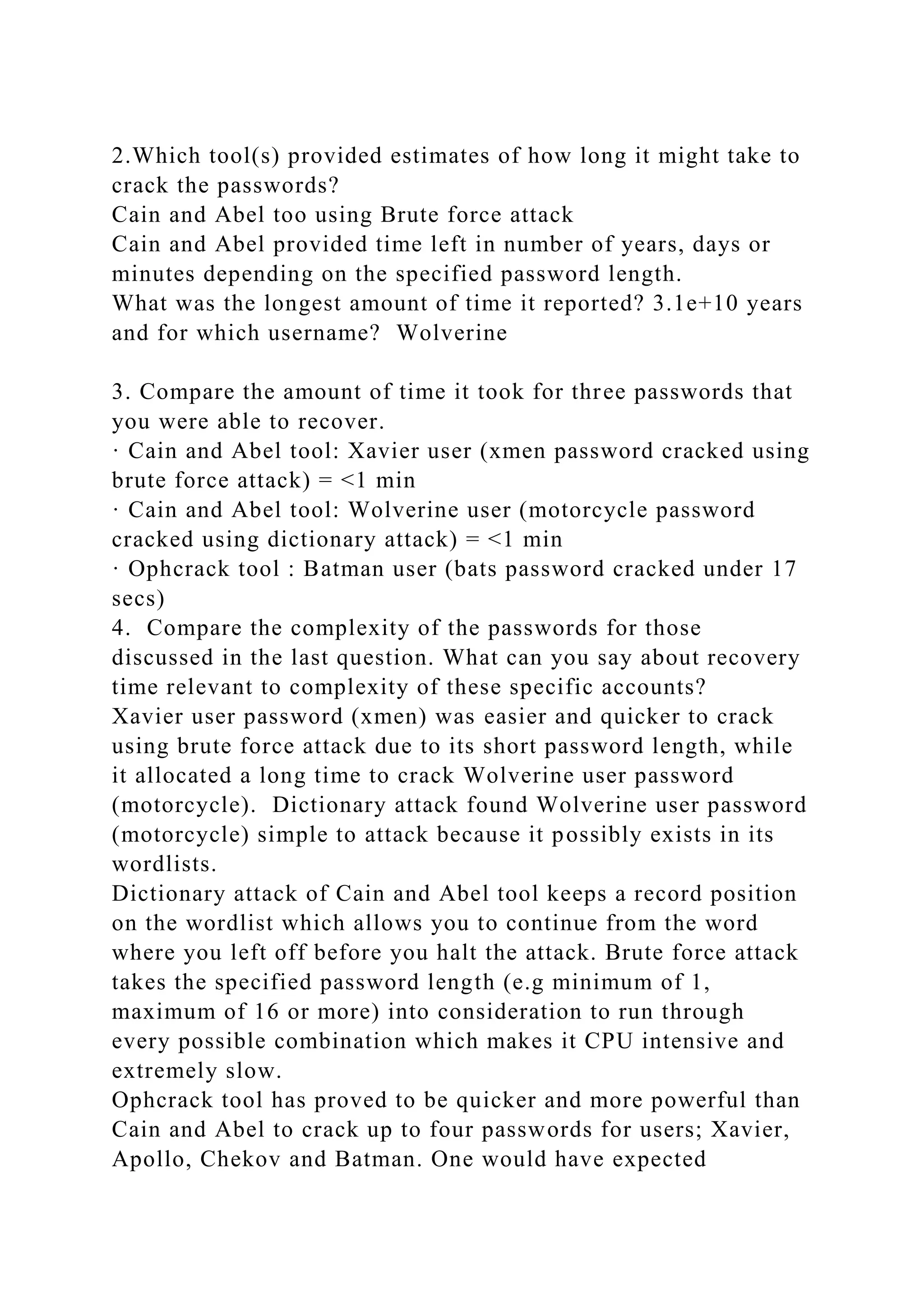
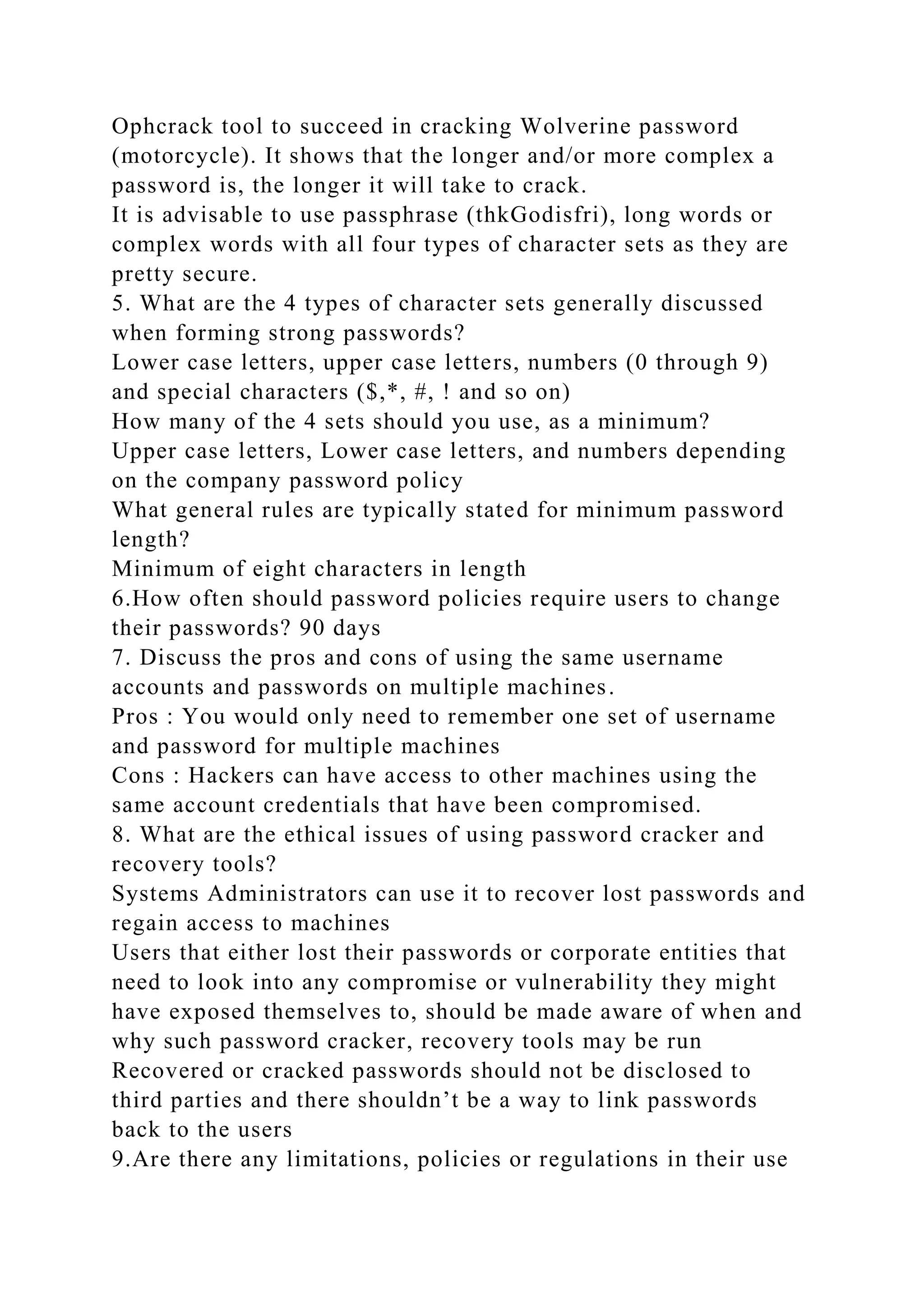
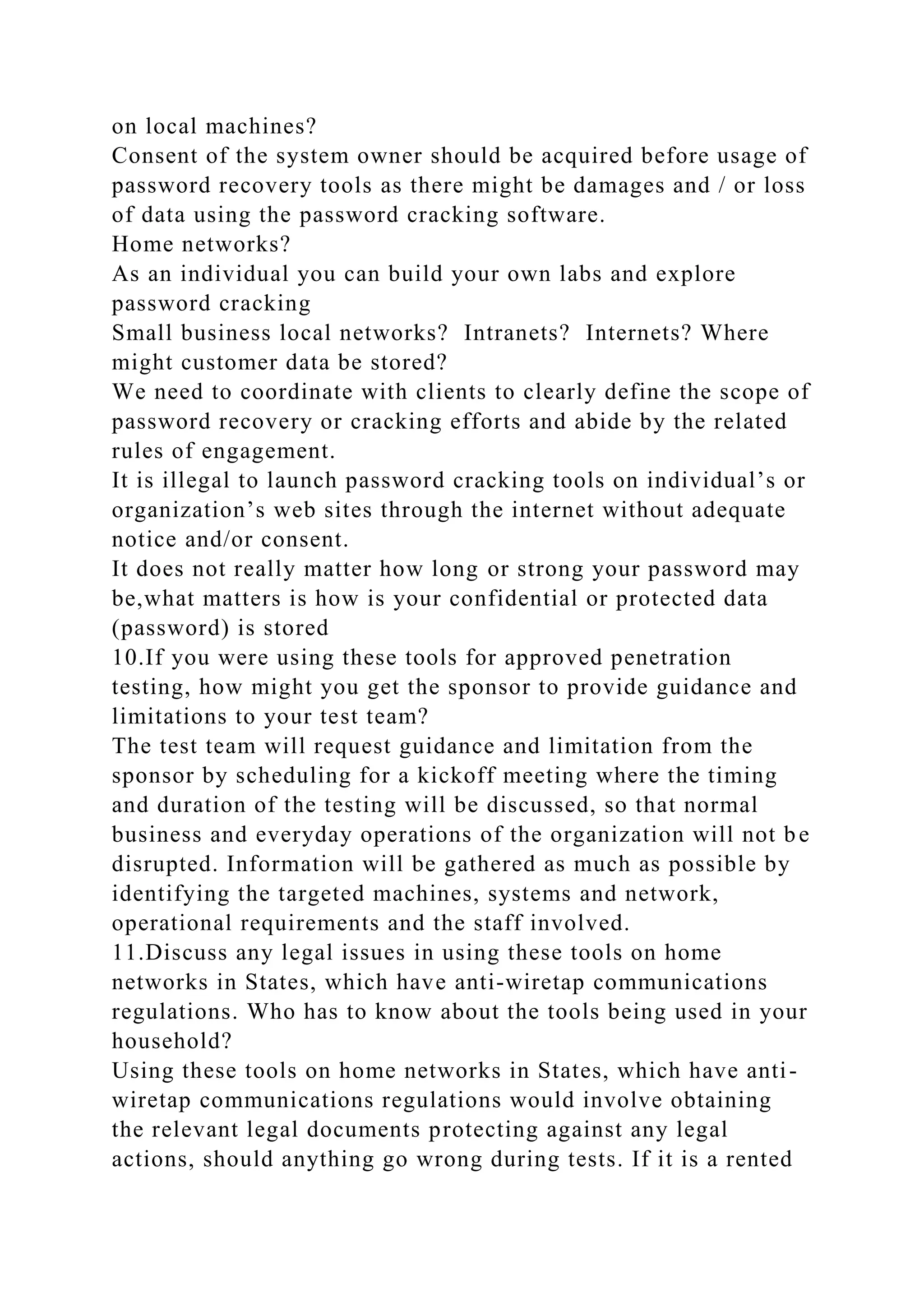
![apartment, the leasing office management needs to be informed.
Please, find screenshots of step by step exercise on password
cracking:
References
Password storage and hashing
● http://lifehacker.com/5919918/how-your-passwords-are-
stored-on-the-internet-and-whenyour-password-strength-doesnt-
matter
● http://www.darkreading.com/safely-storing-user-passwords-
hashing-vs-encrypting/a/did/1269374
● http://www.slashroot.in/how-are-passwords-stored-linux-
understanding-hashing-shadowutils
Click on Lab broker to allocate resources
Signing into the workspace with StudentFirst/[email protected]
Right on the desktop of VM WINATK01, click Lab Resource
then folder - Applications, locate and launch Cain.
After launch of Cain
Maximize screen and click Cracker tab
20 user accounts on the local machine used to populate the right
window.](https://image.slidesharecdn.com/1-221101035239-dffccca1/75/1-Security-and-vulnerability-assessment-analysis-tool-Microsoft-docx-16-2048.jpg)
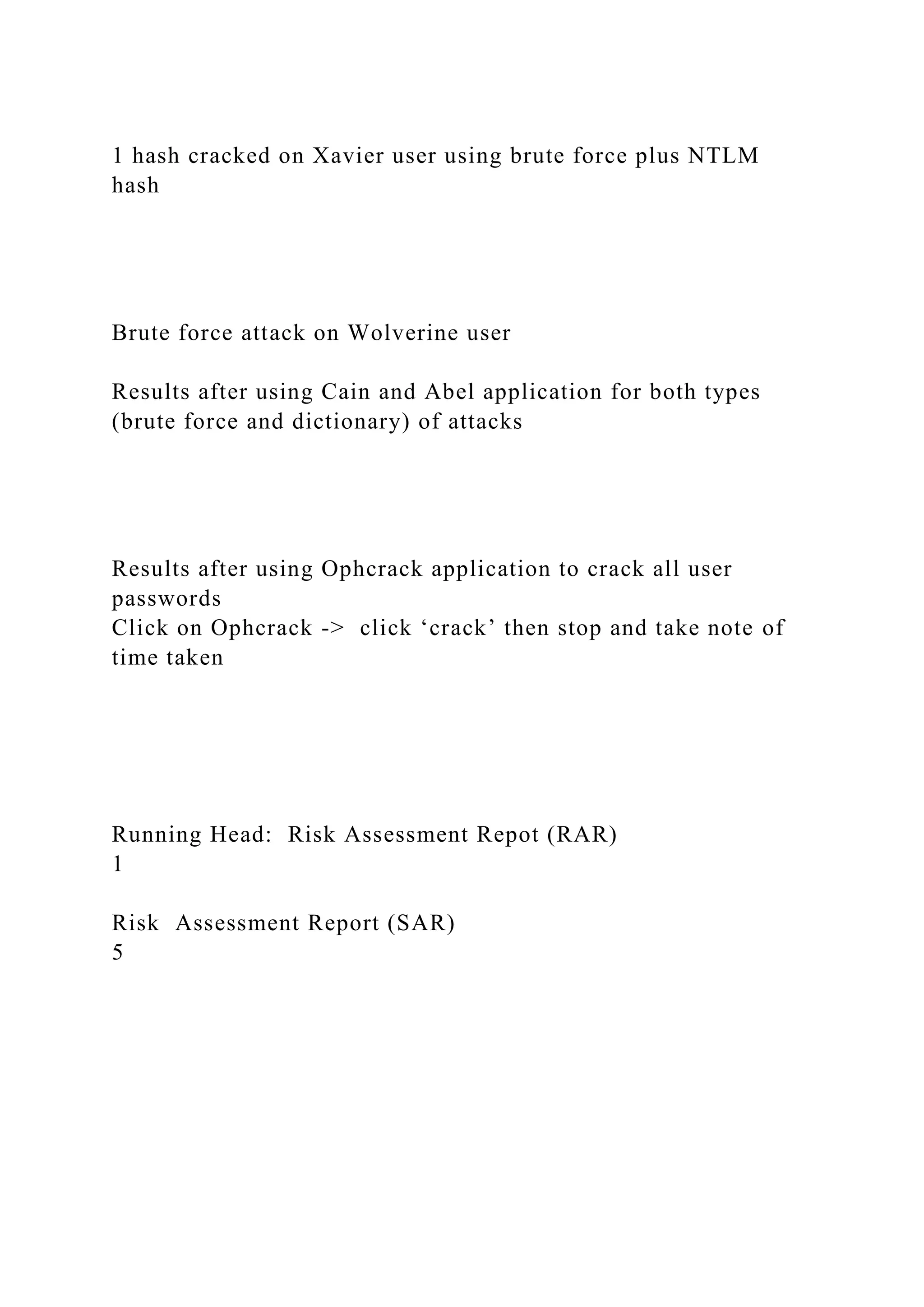
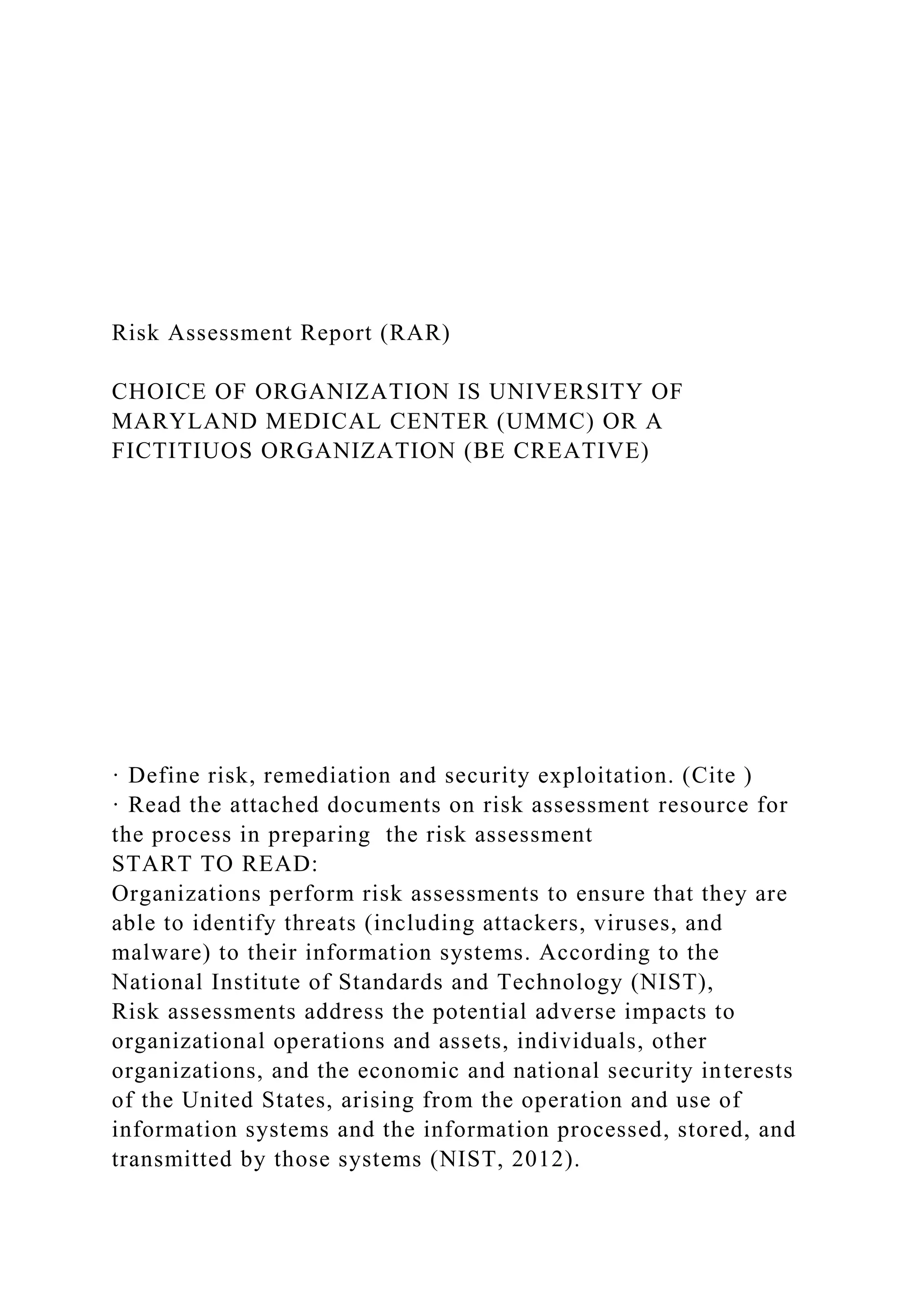
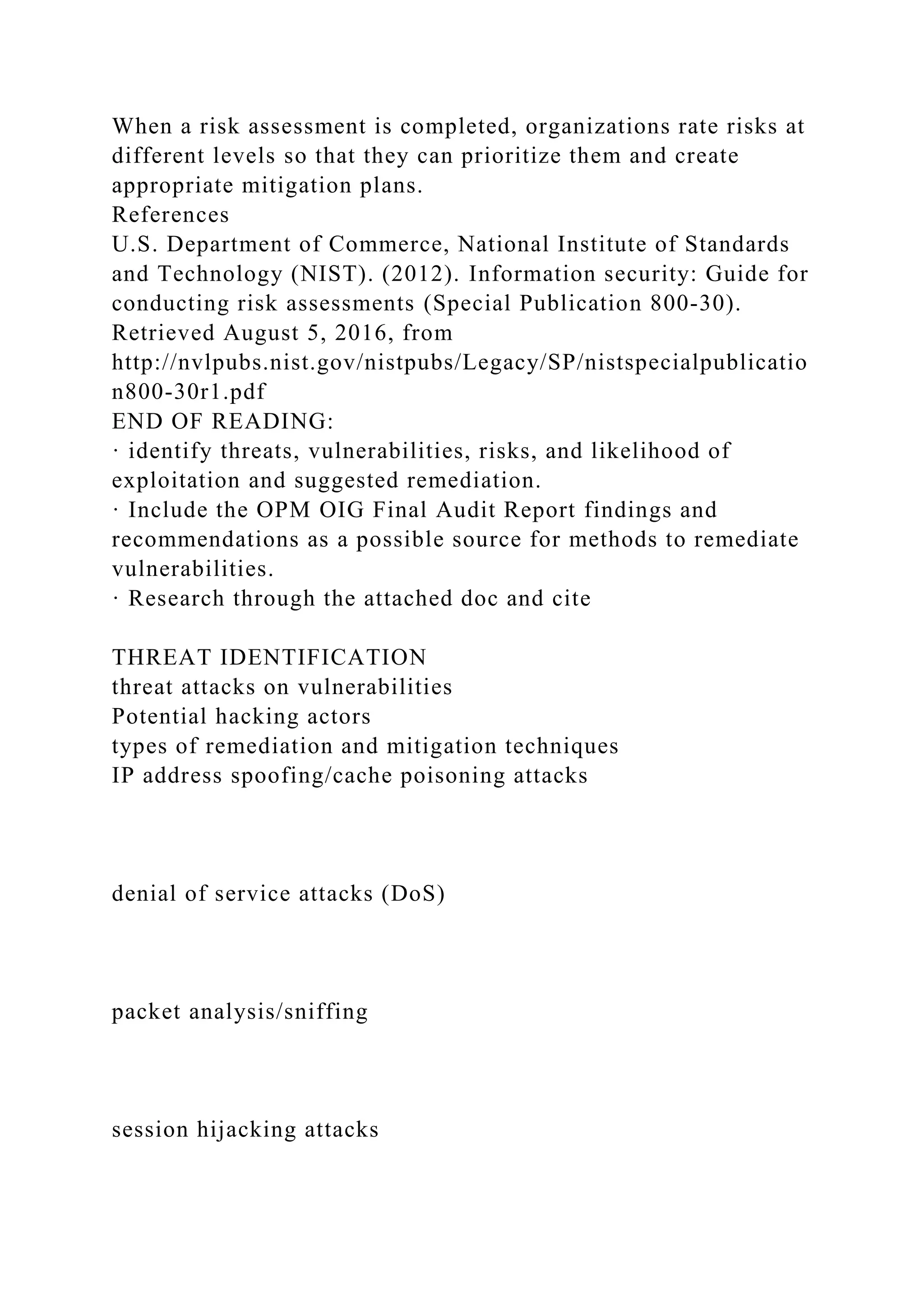
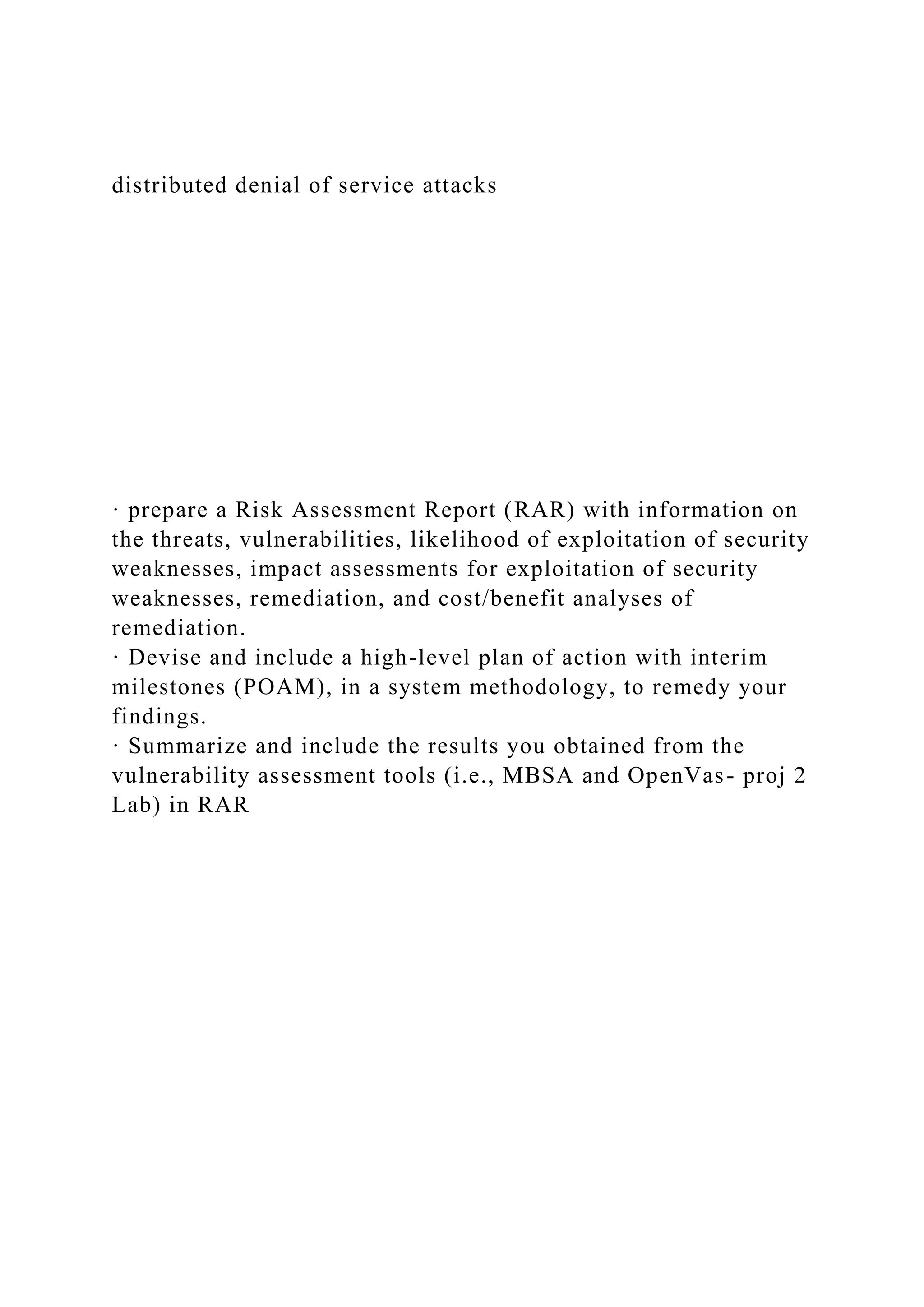
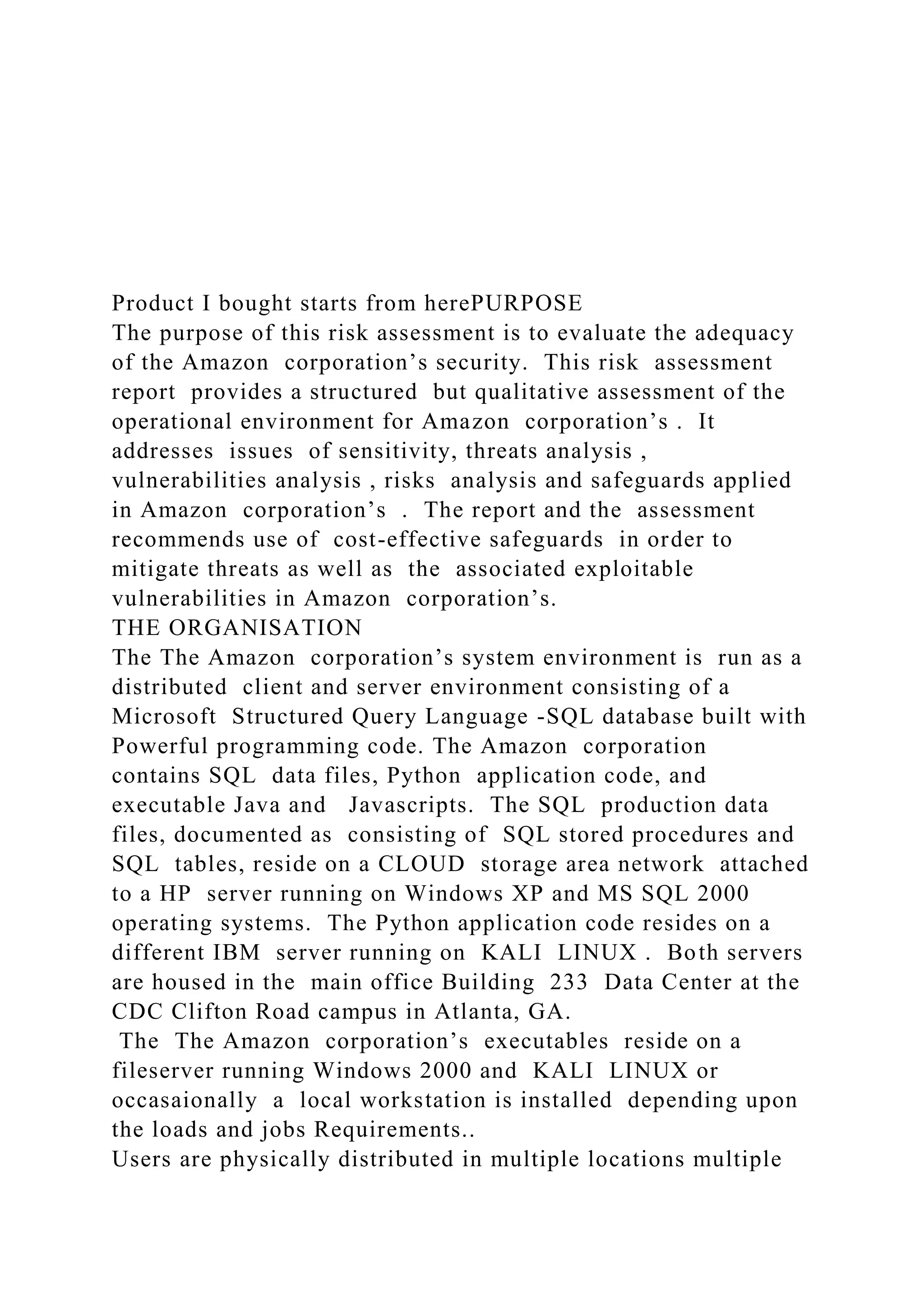



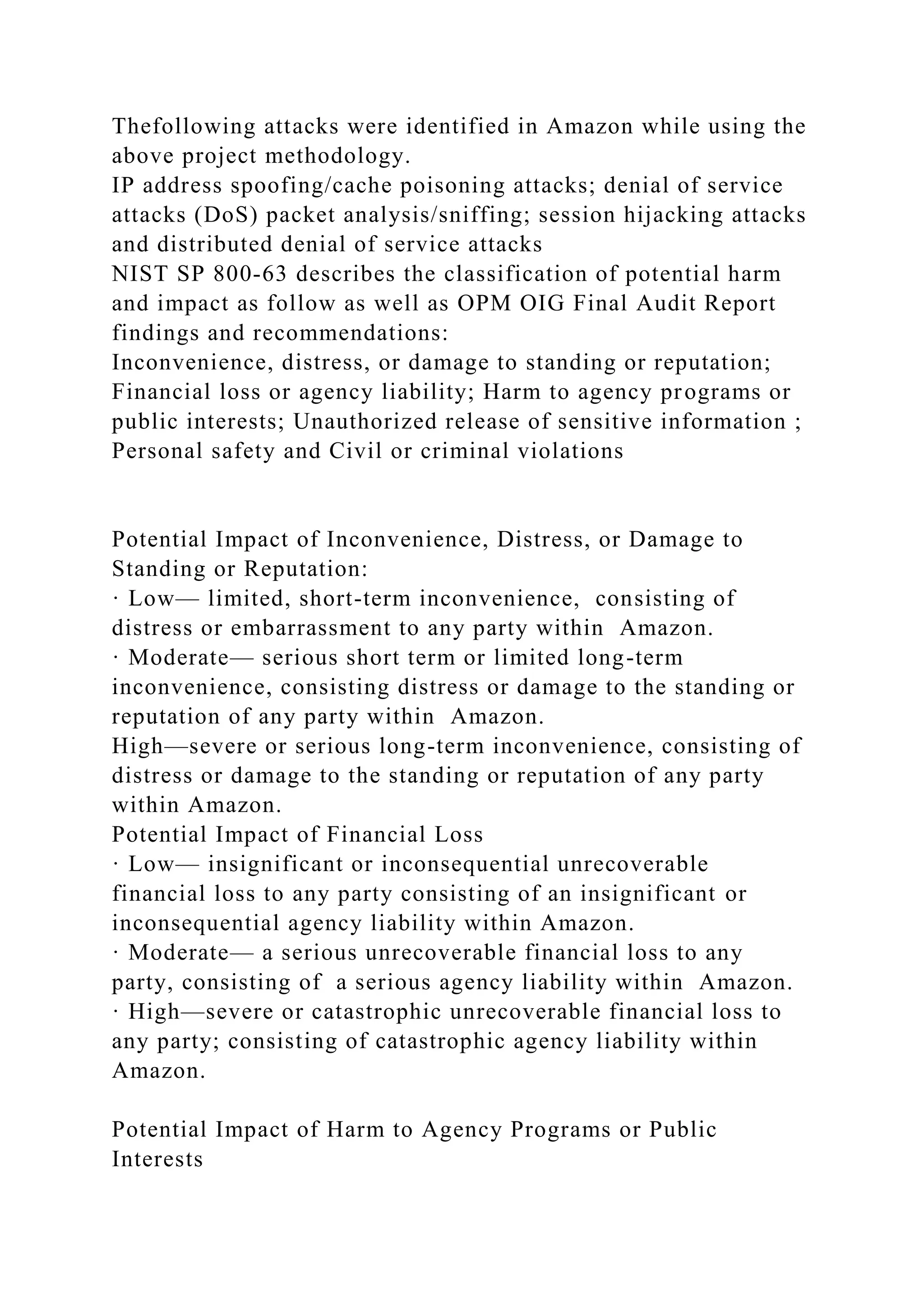

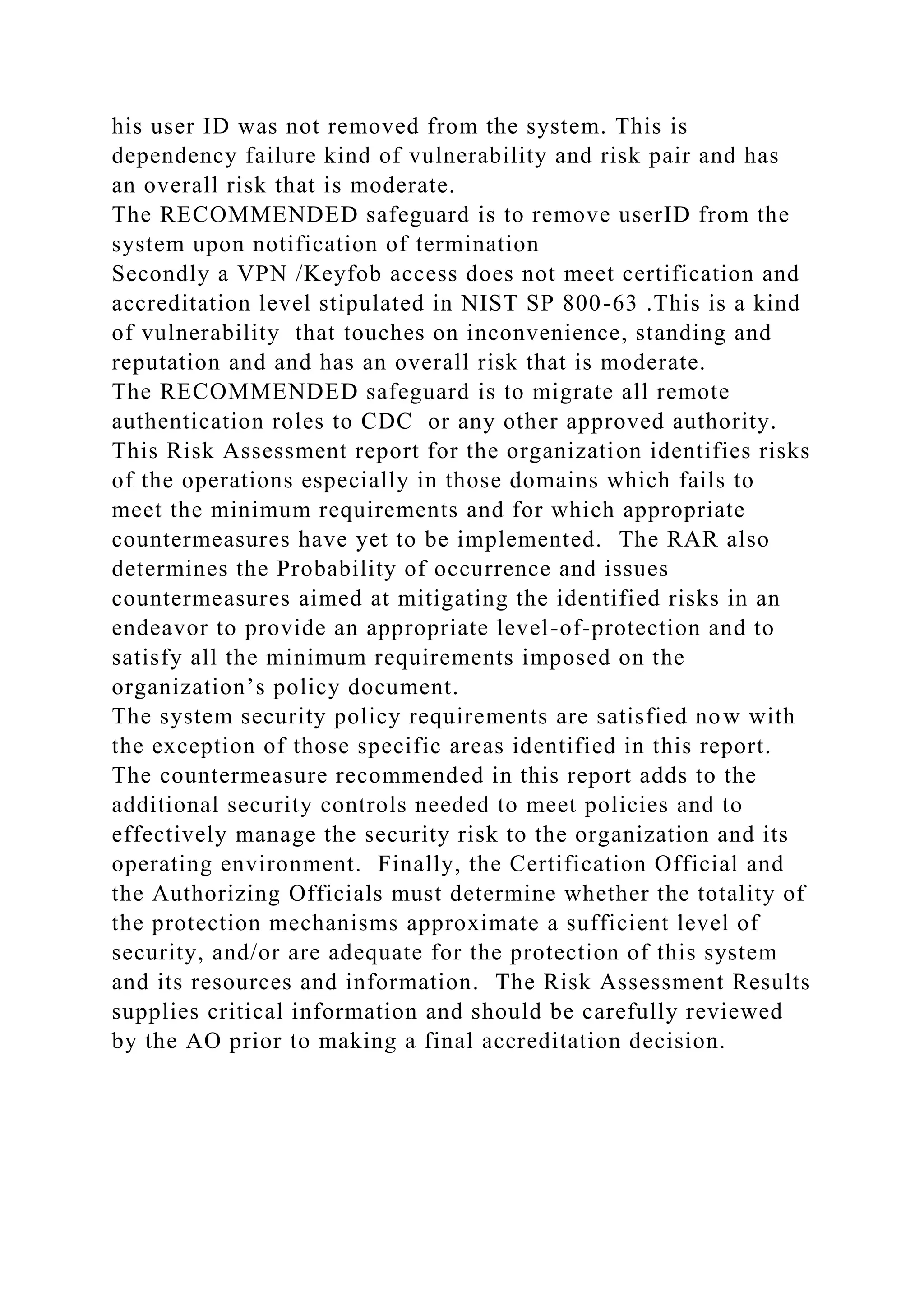

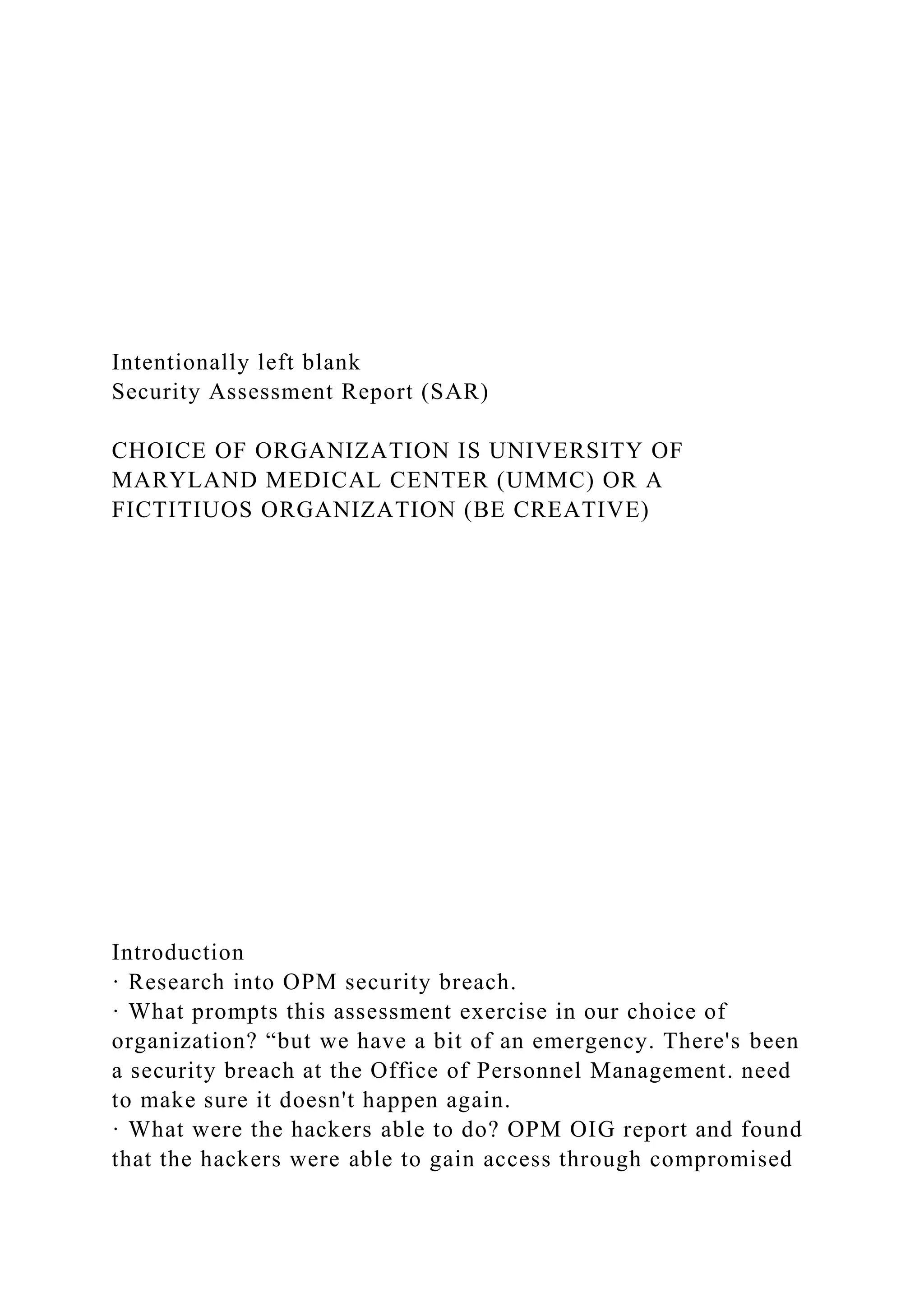

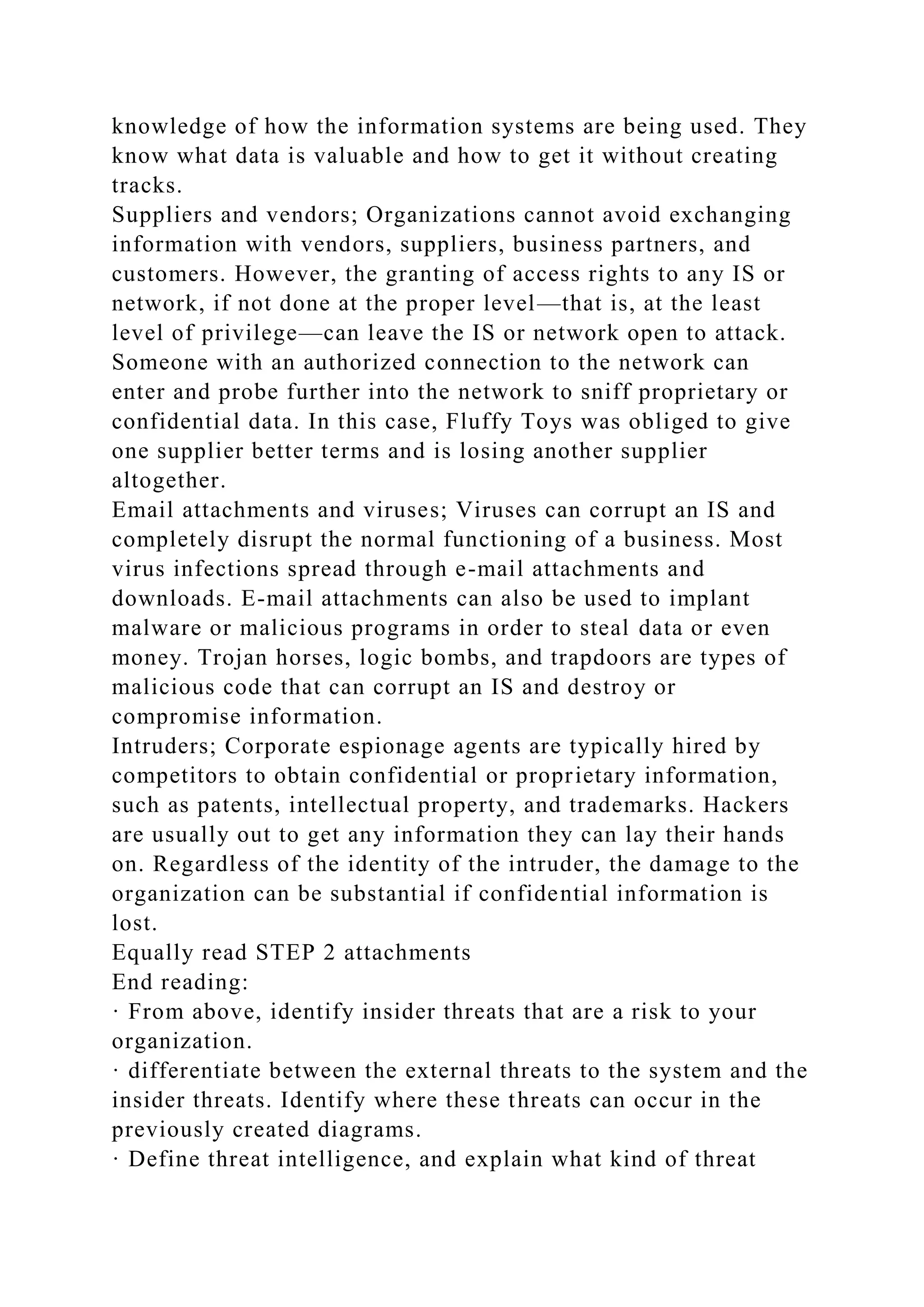

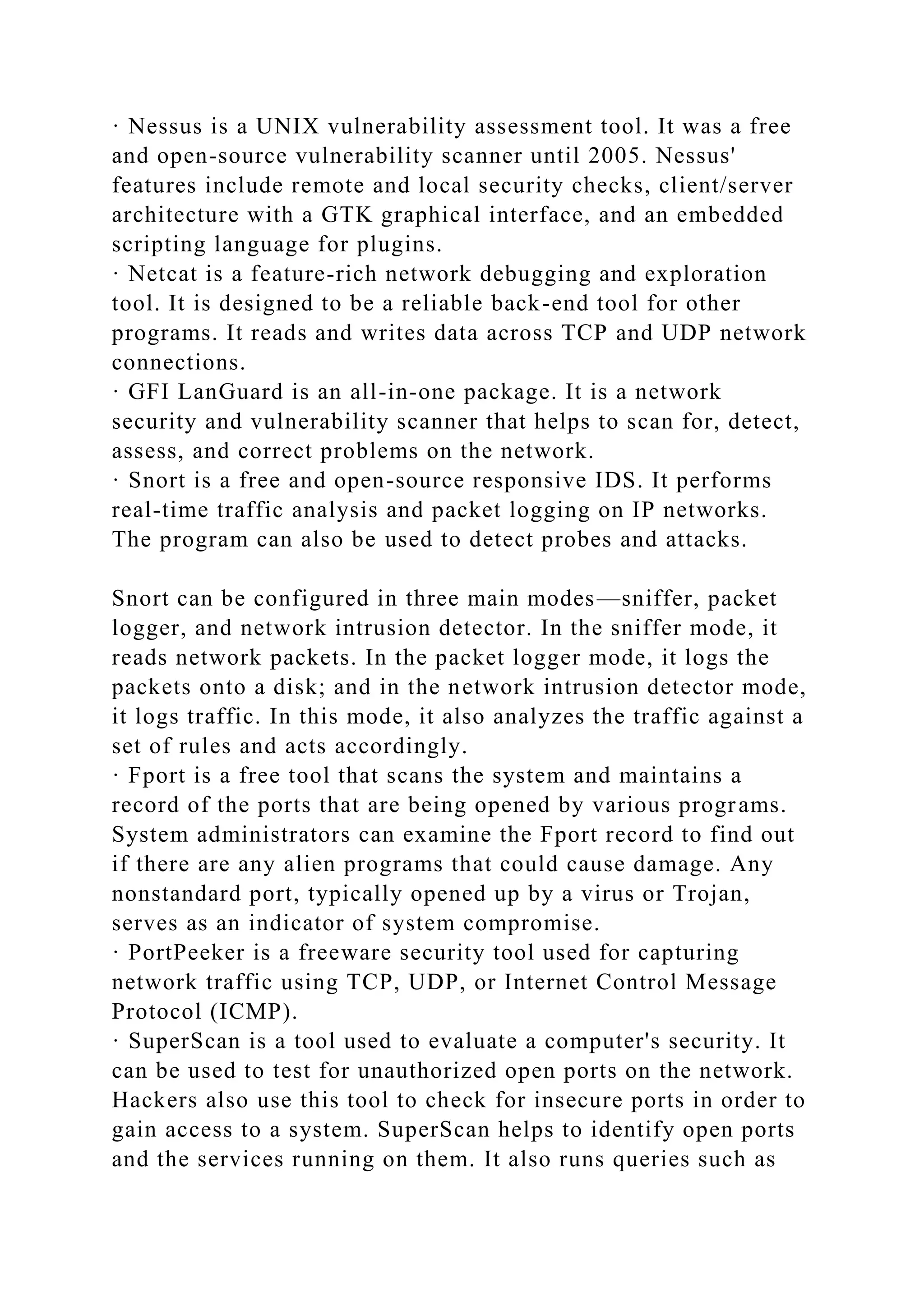
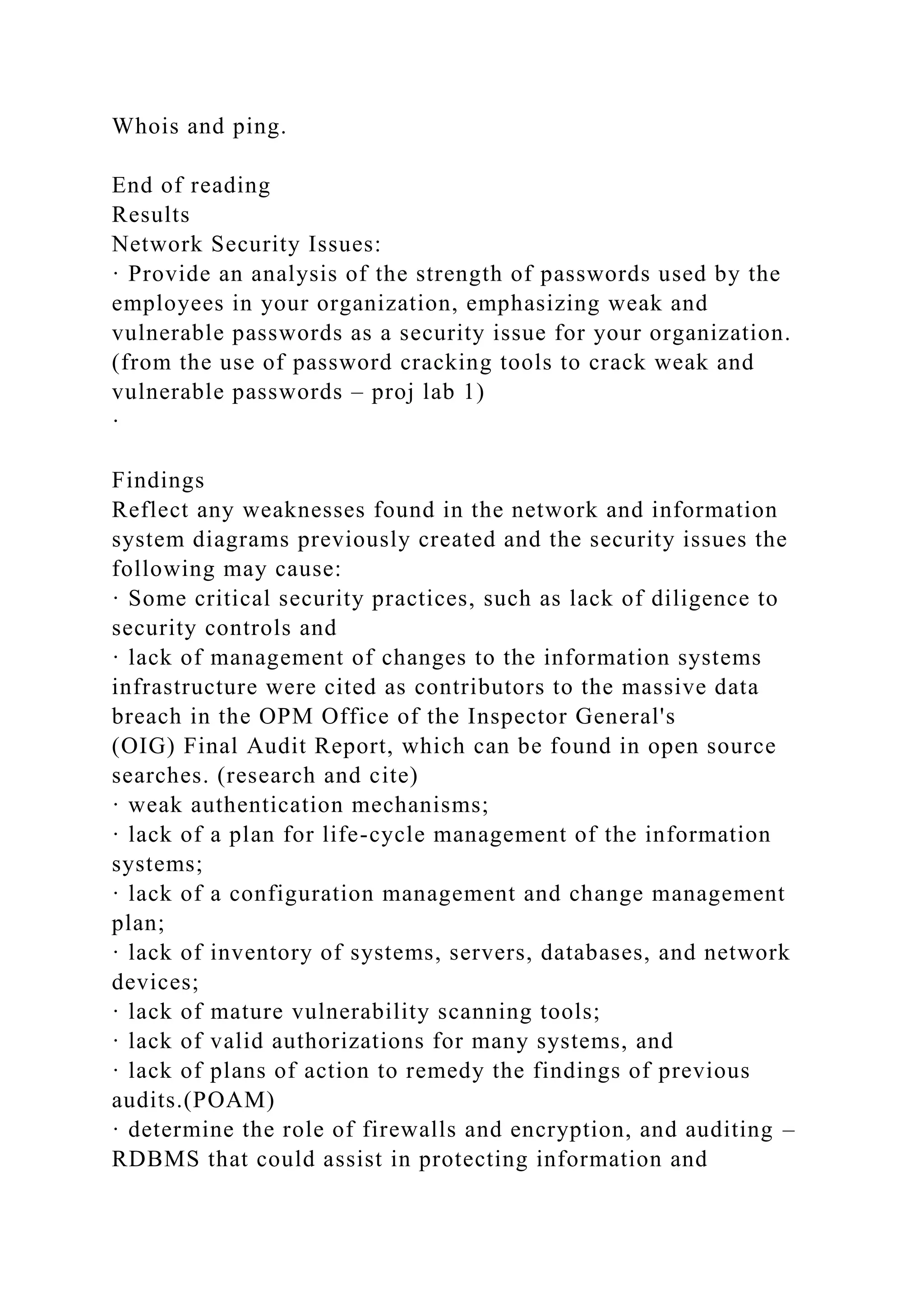
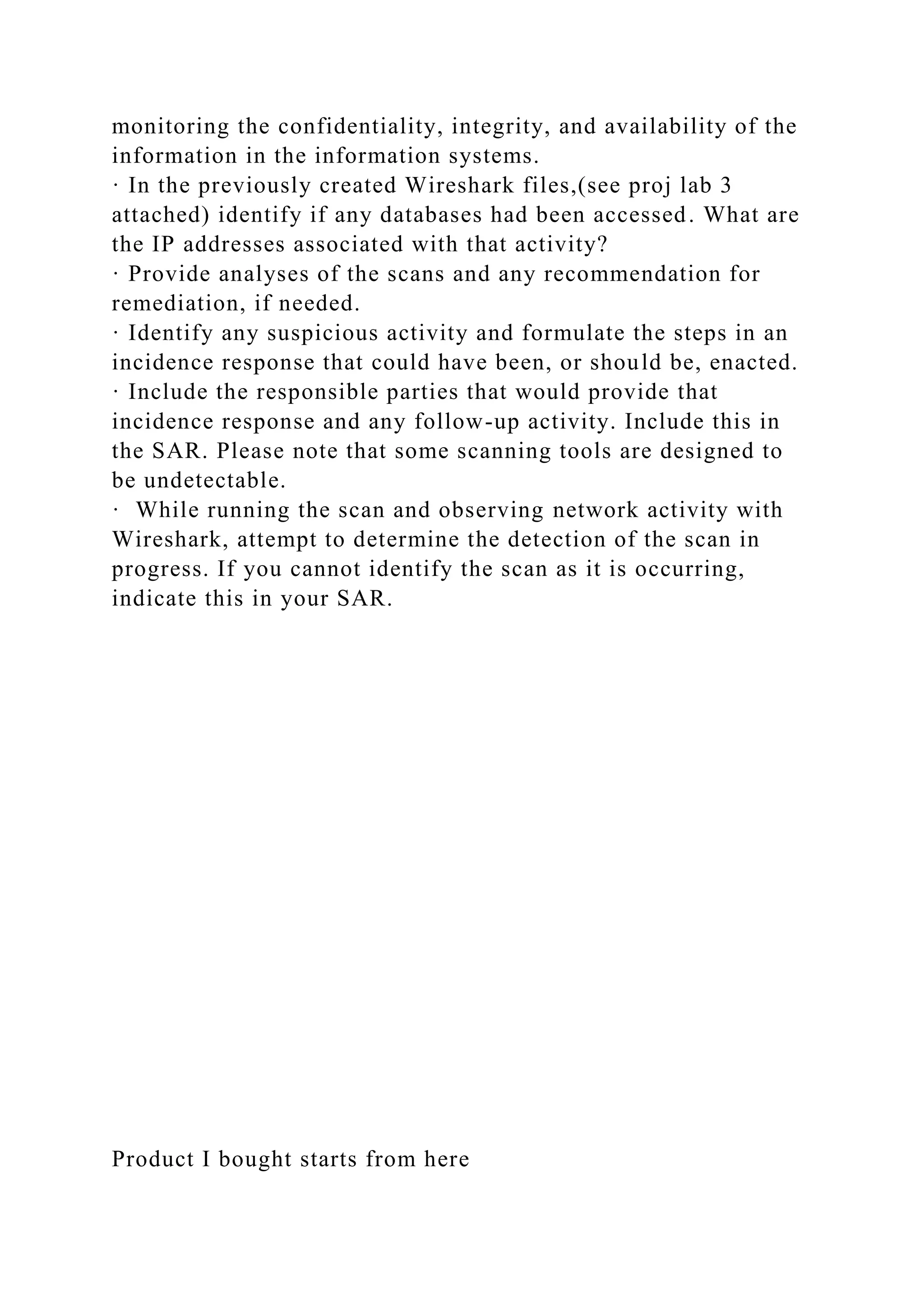
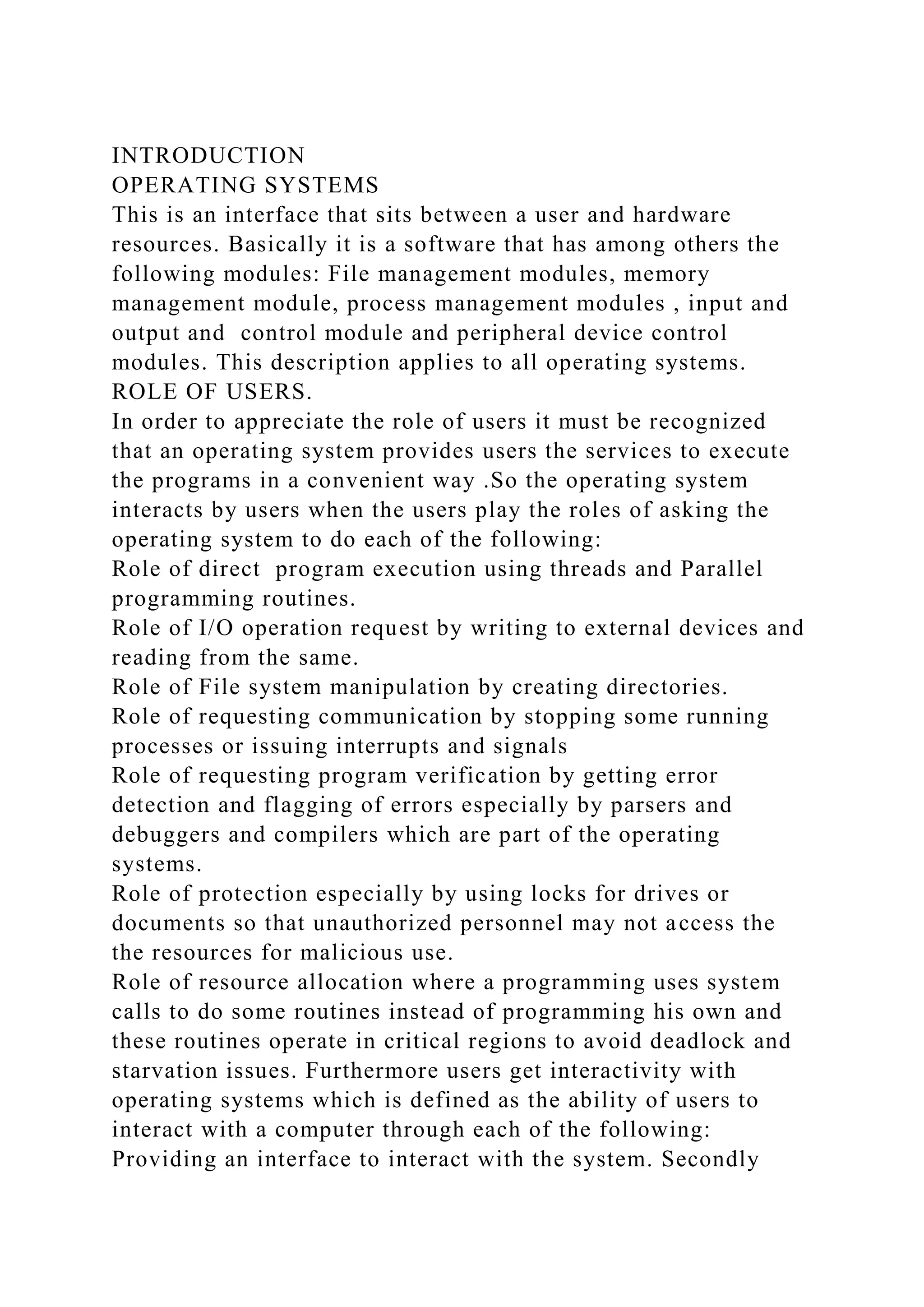
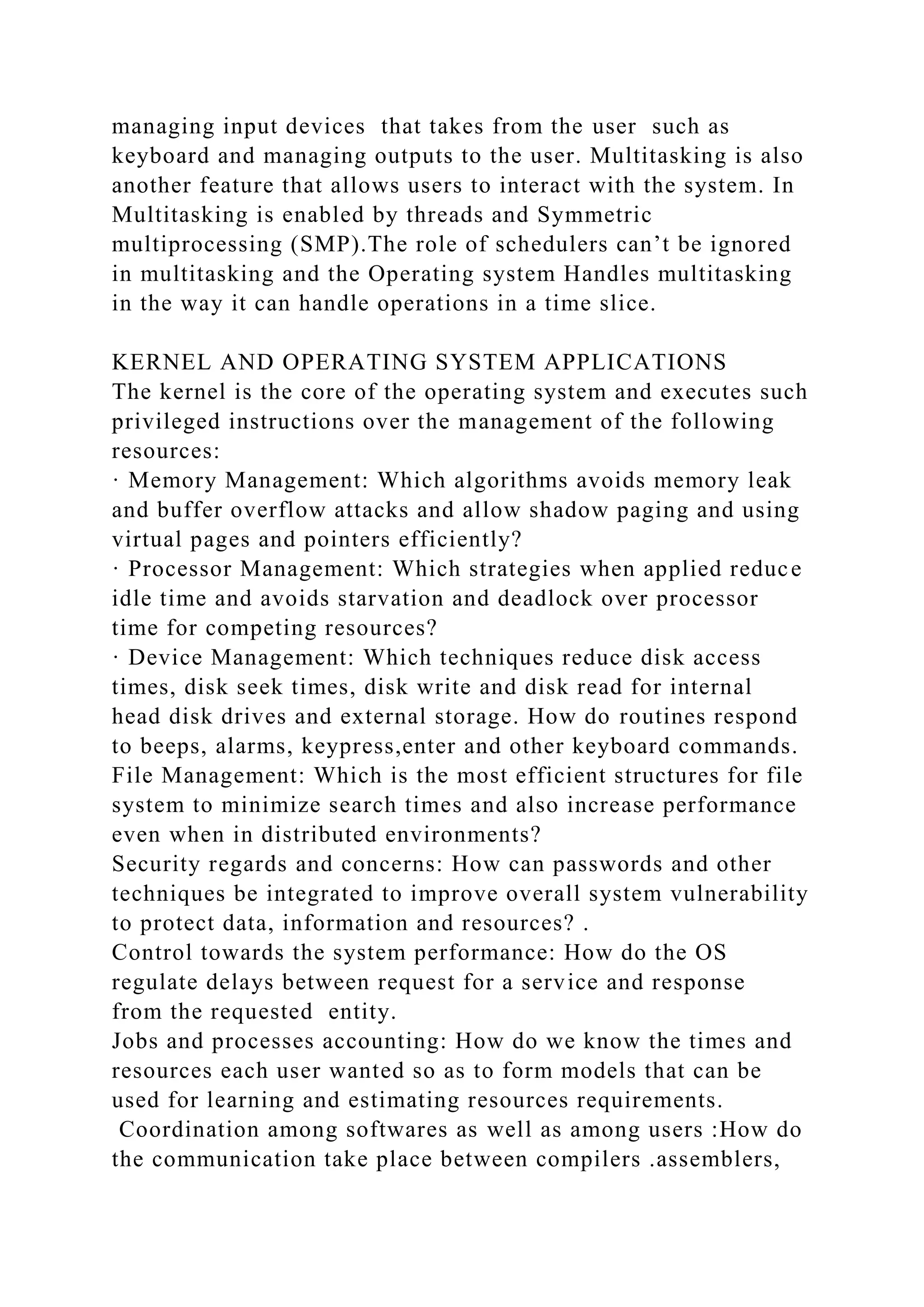

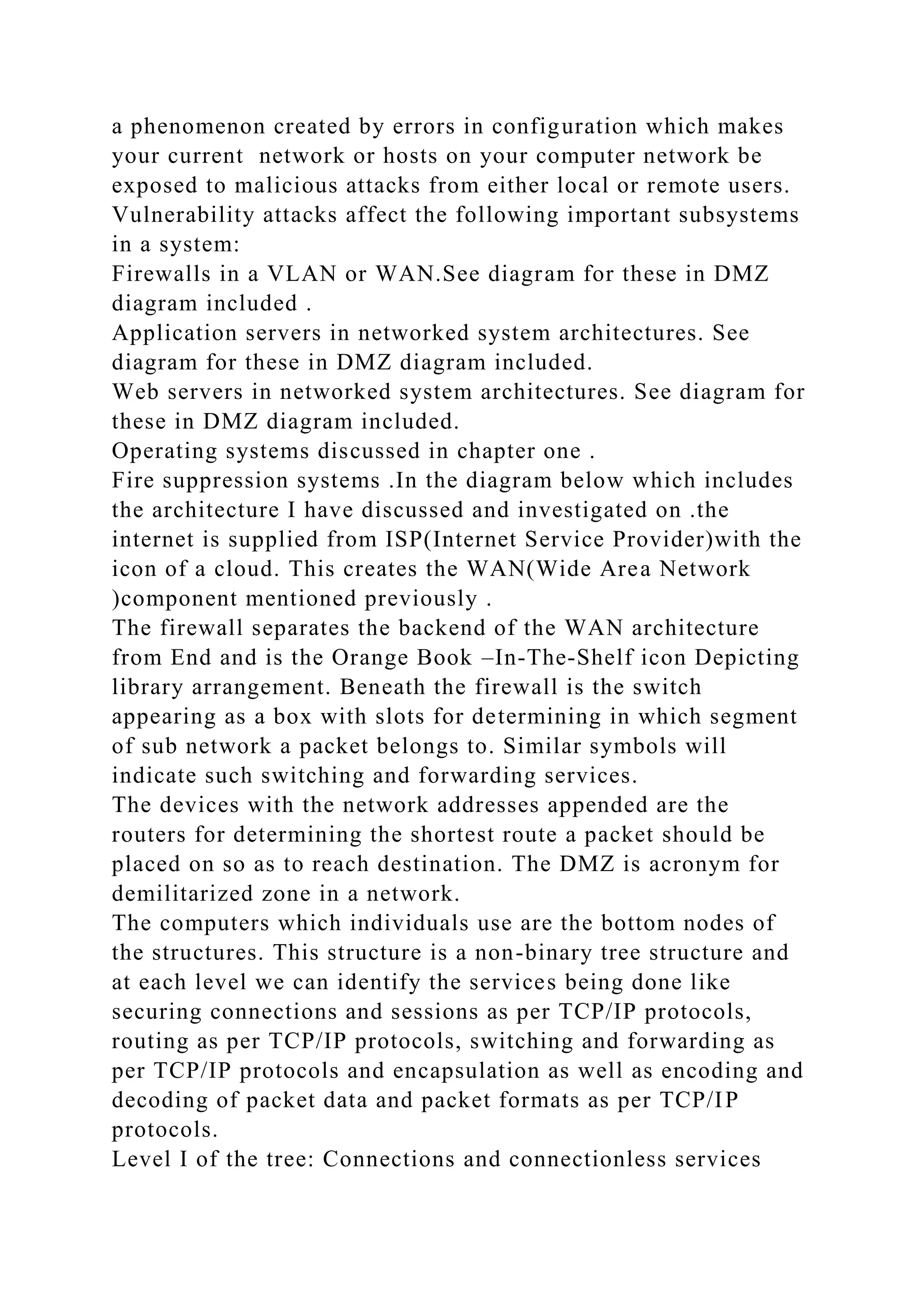

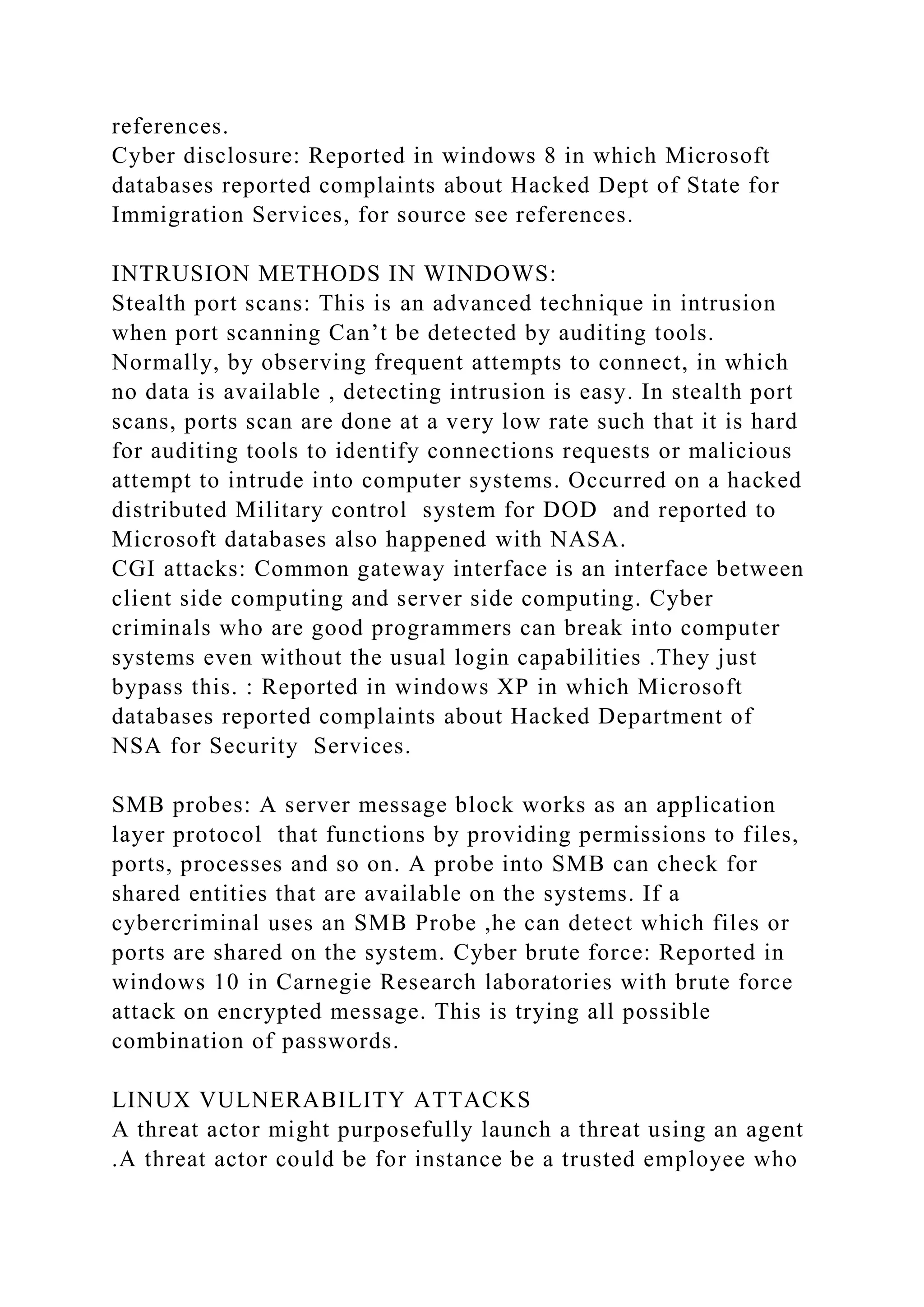
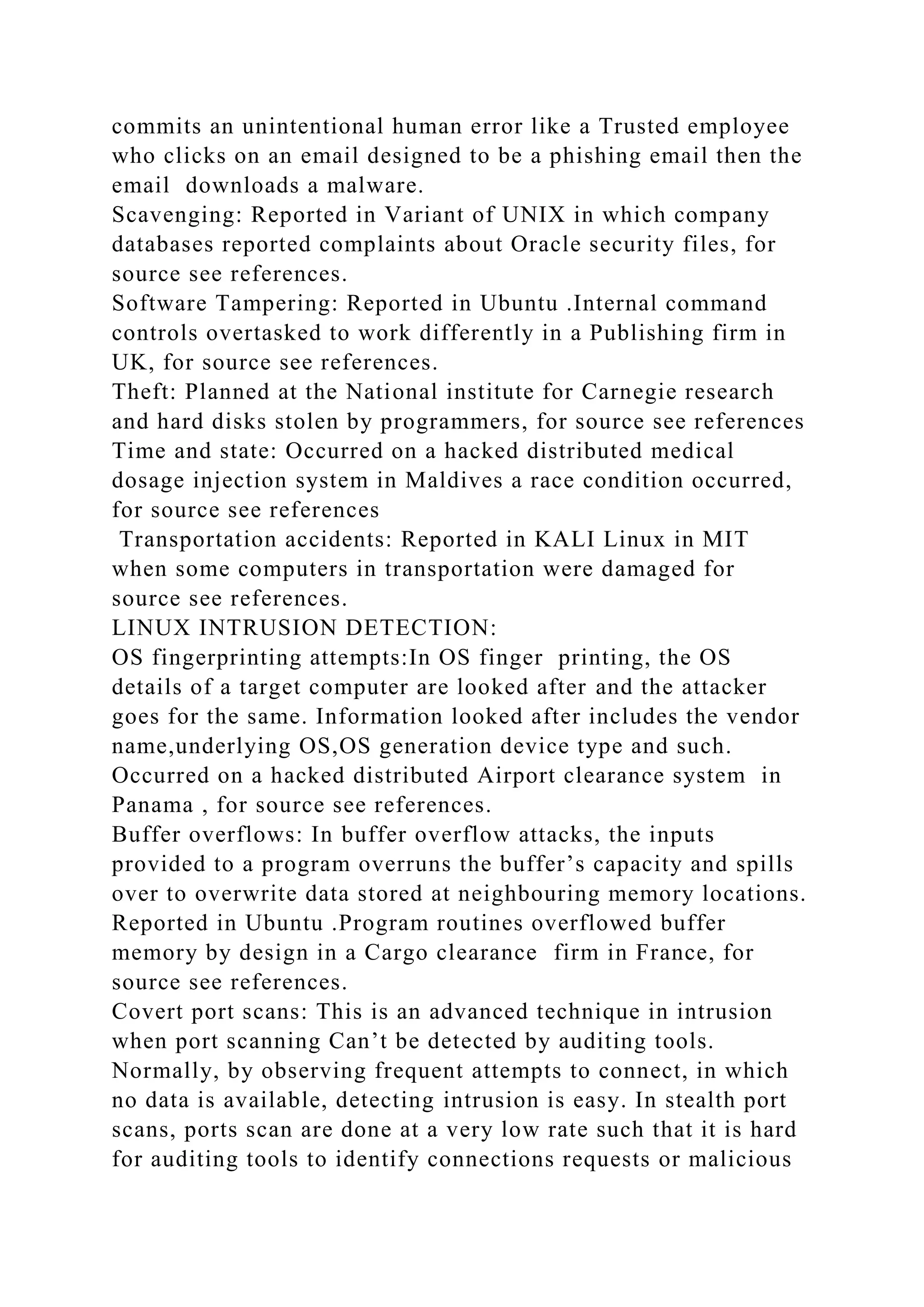
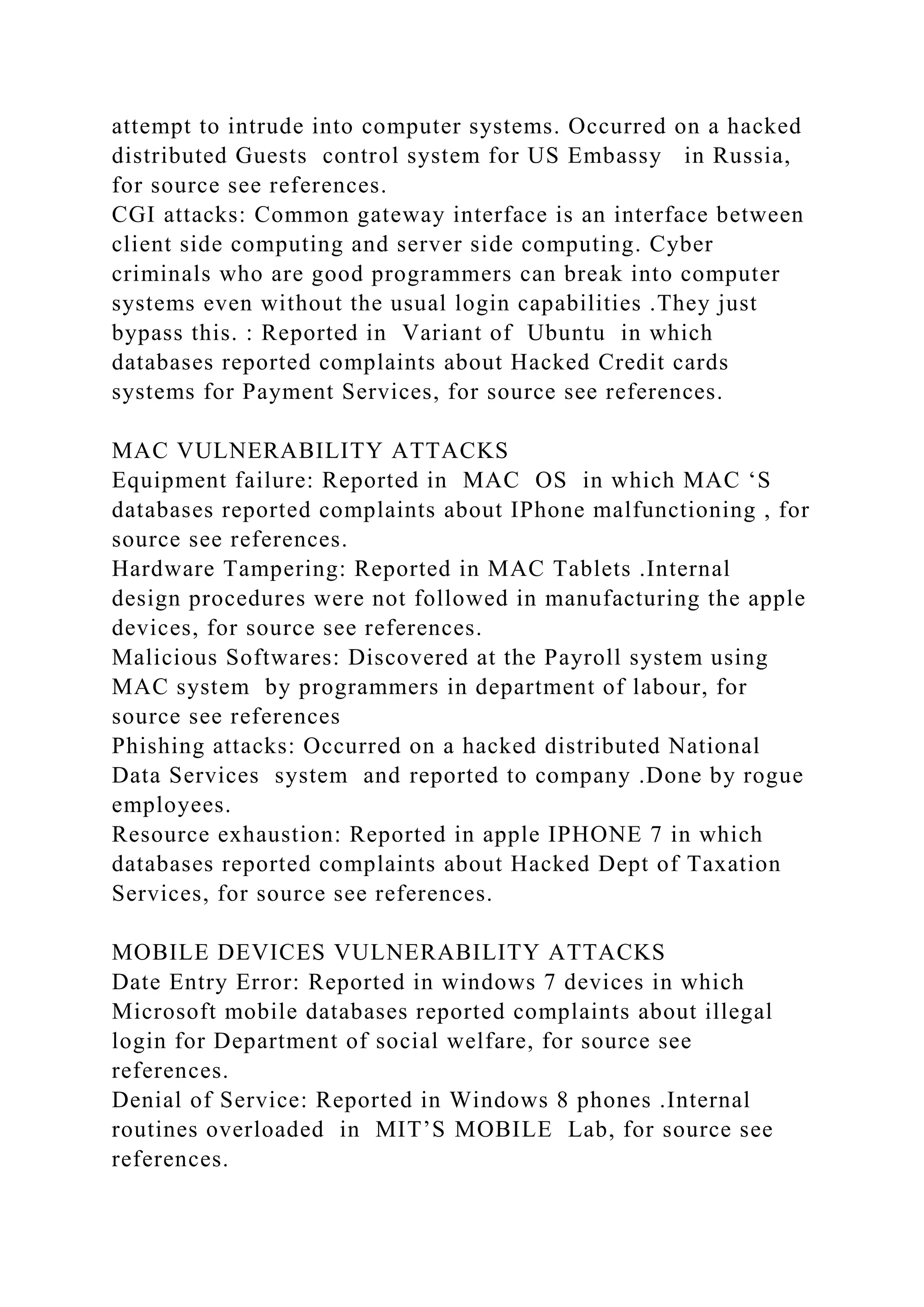
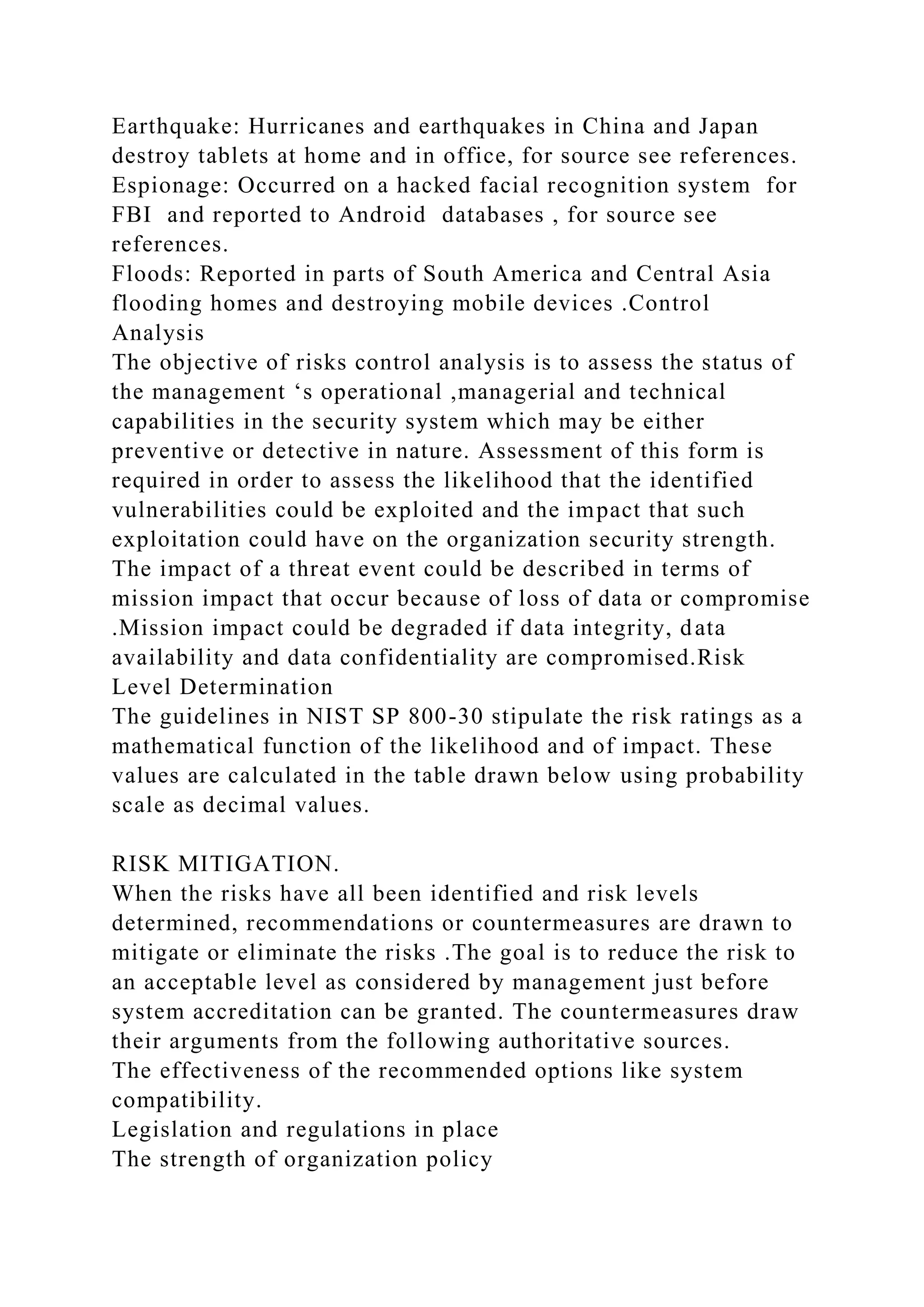



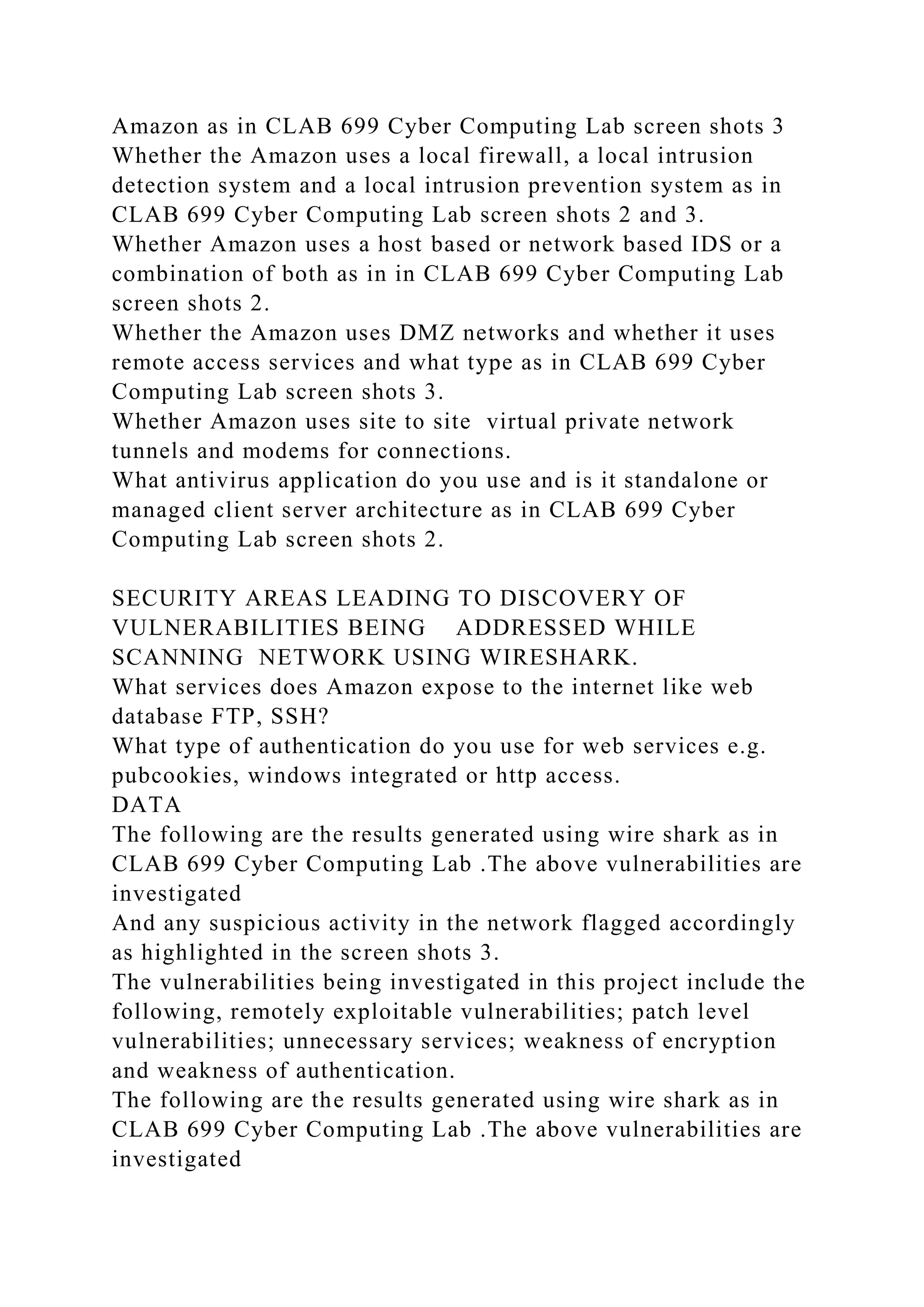
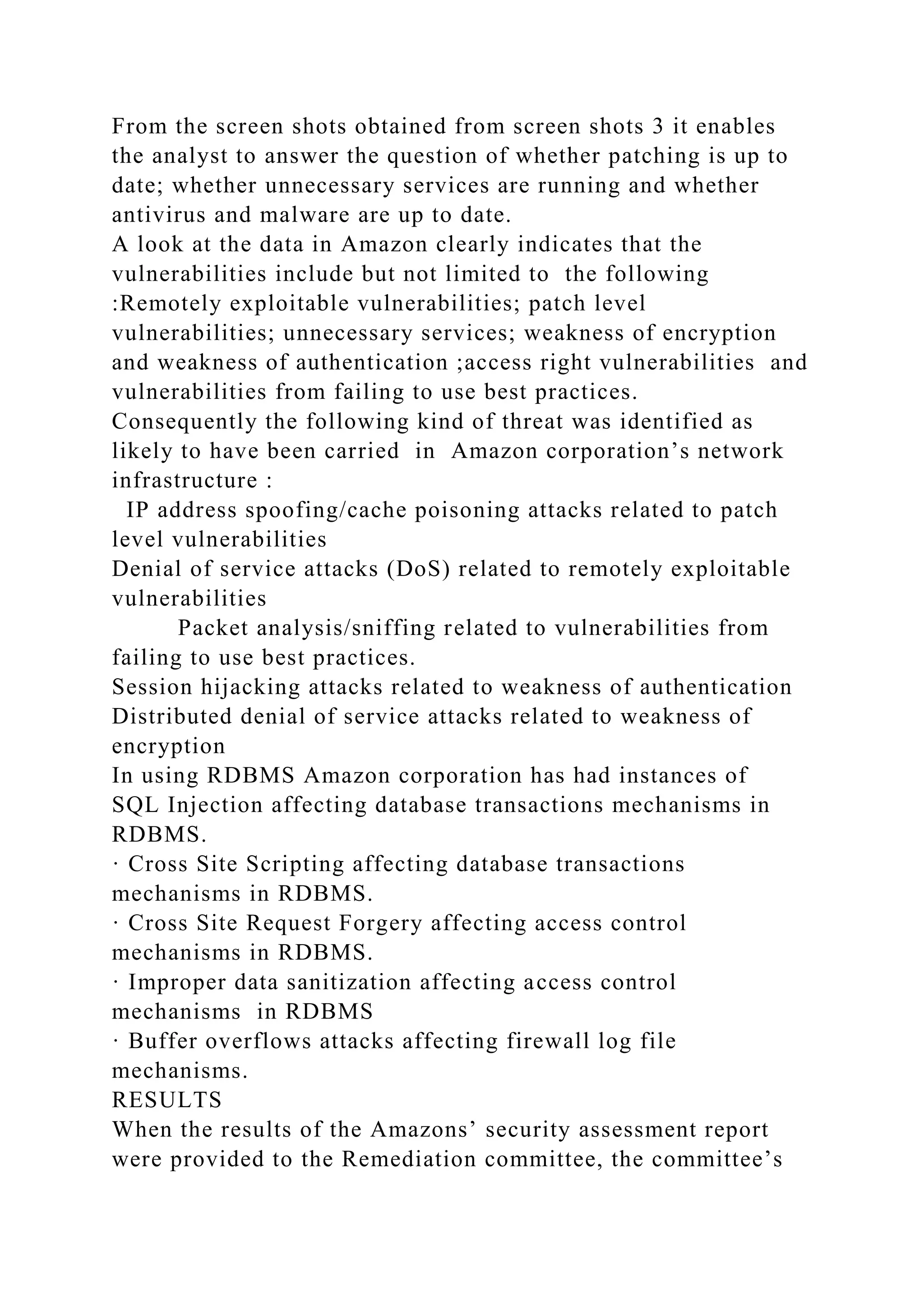
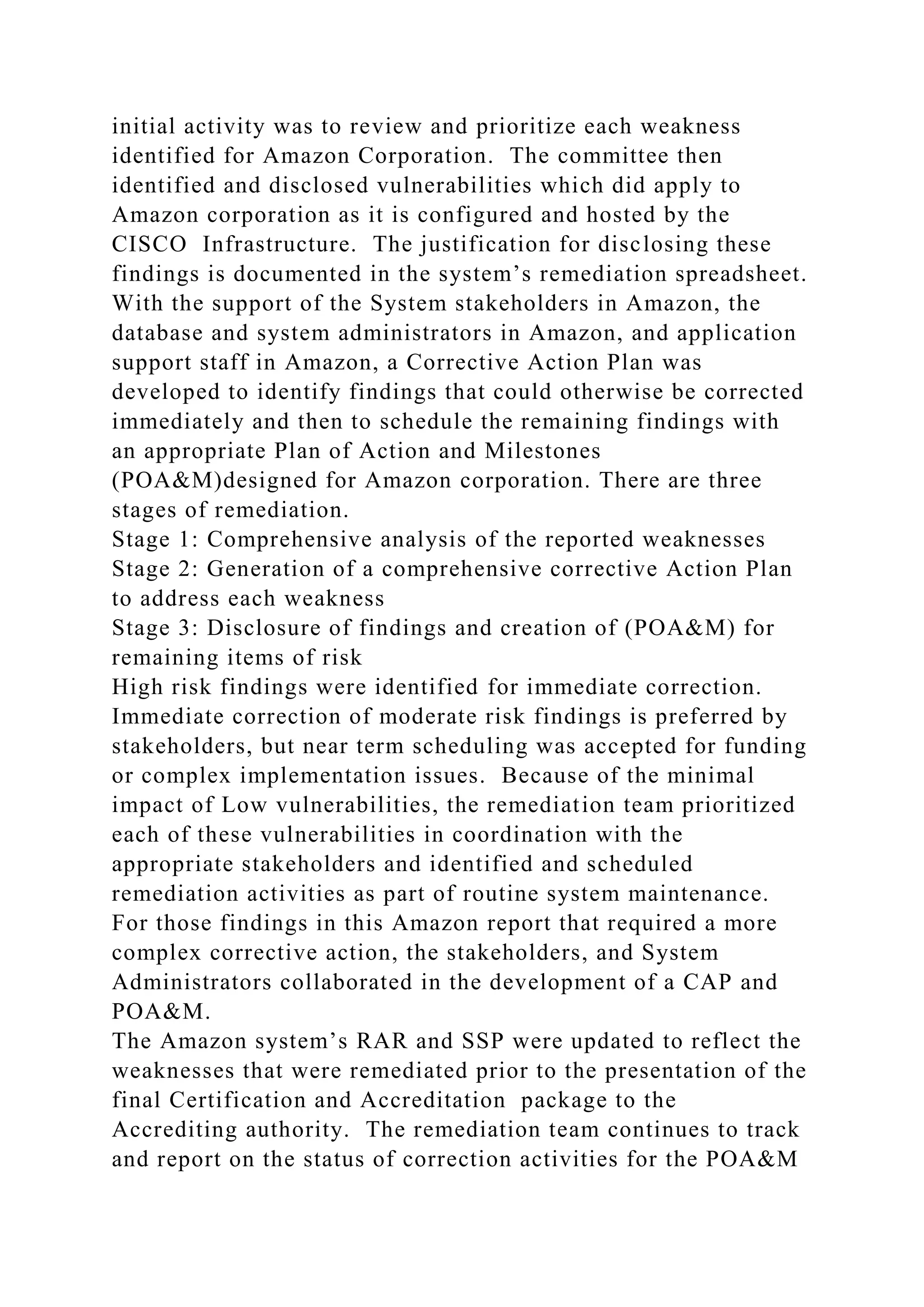
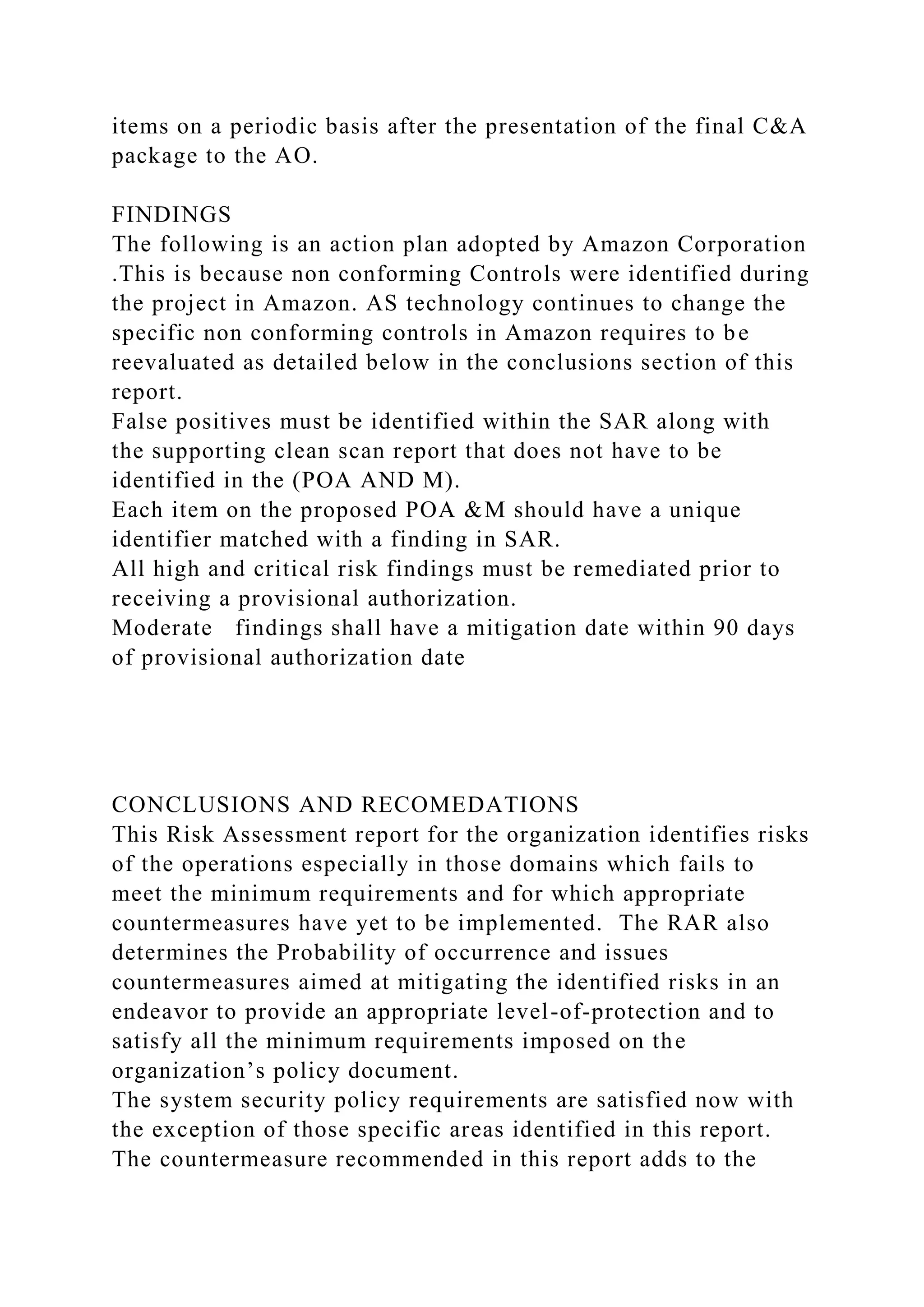
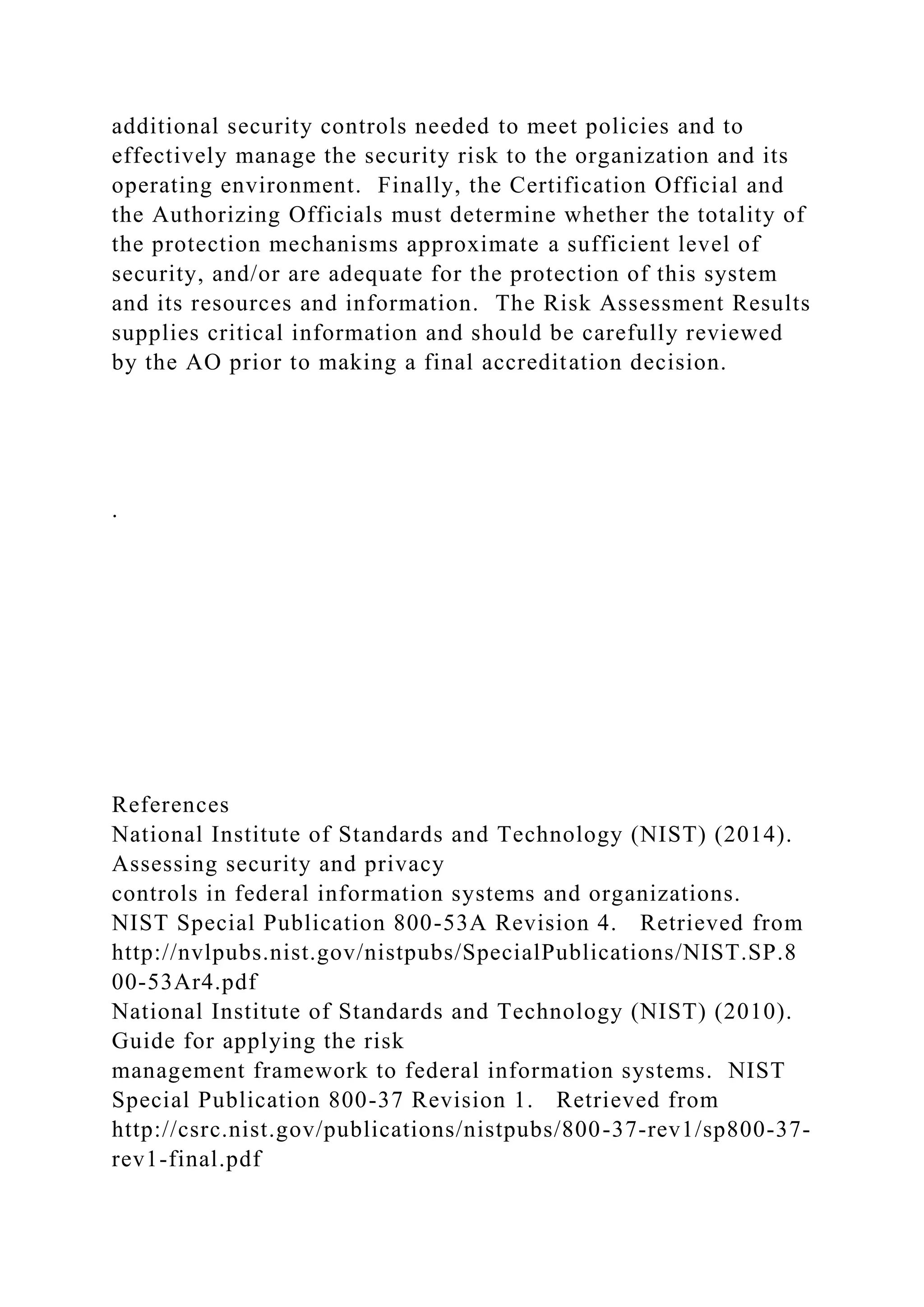
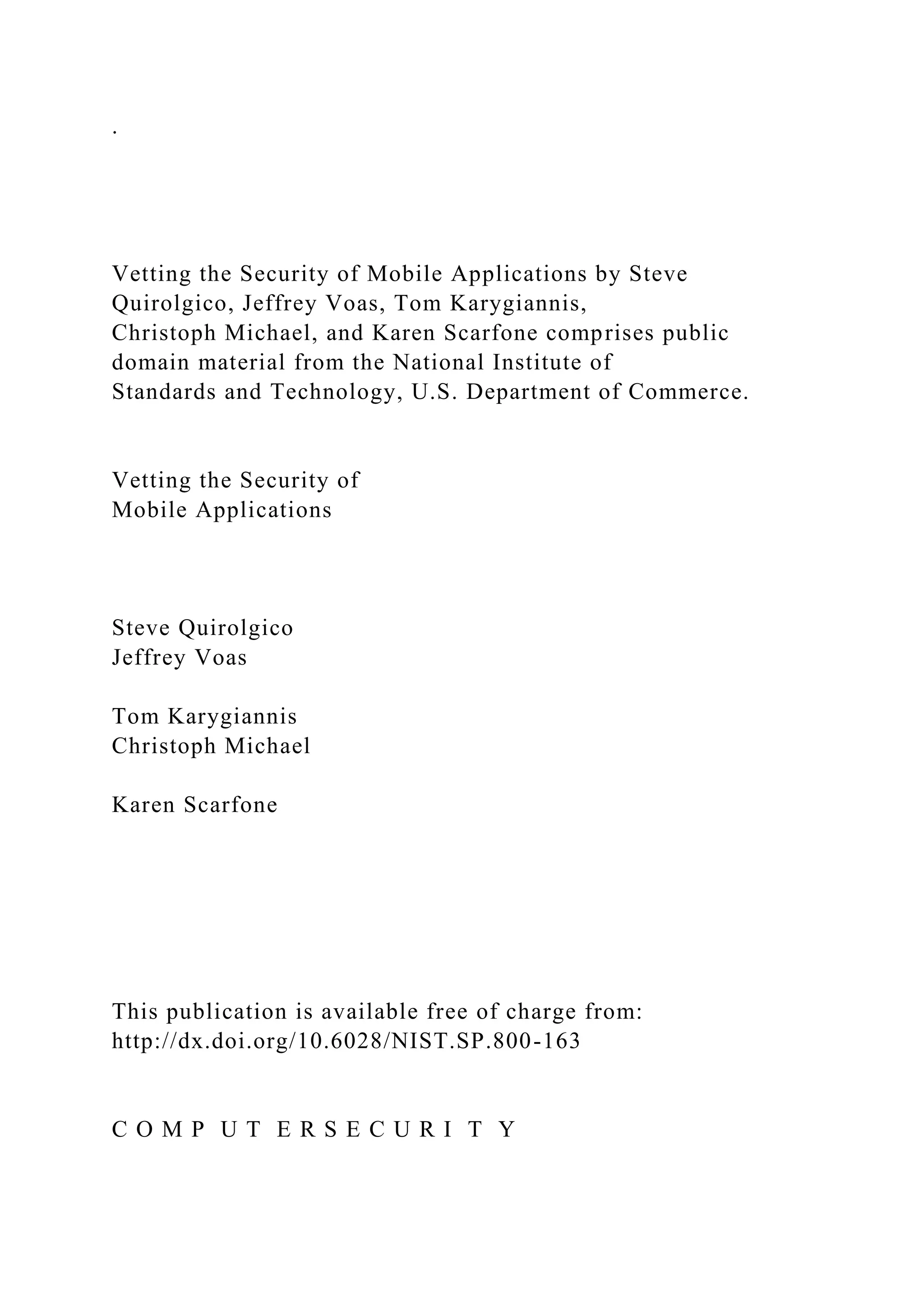
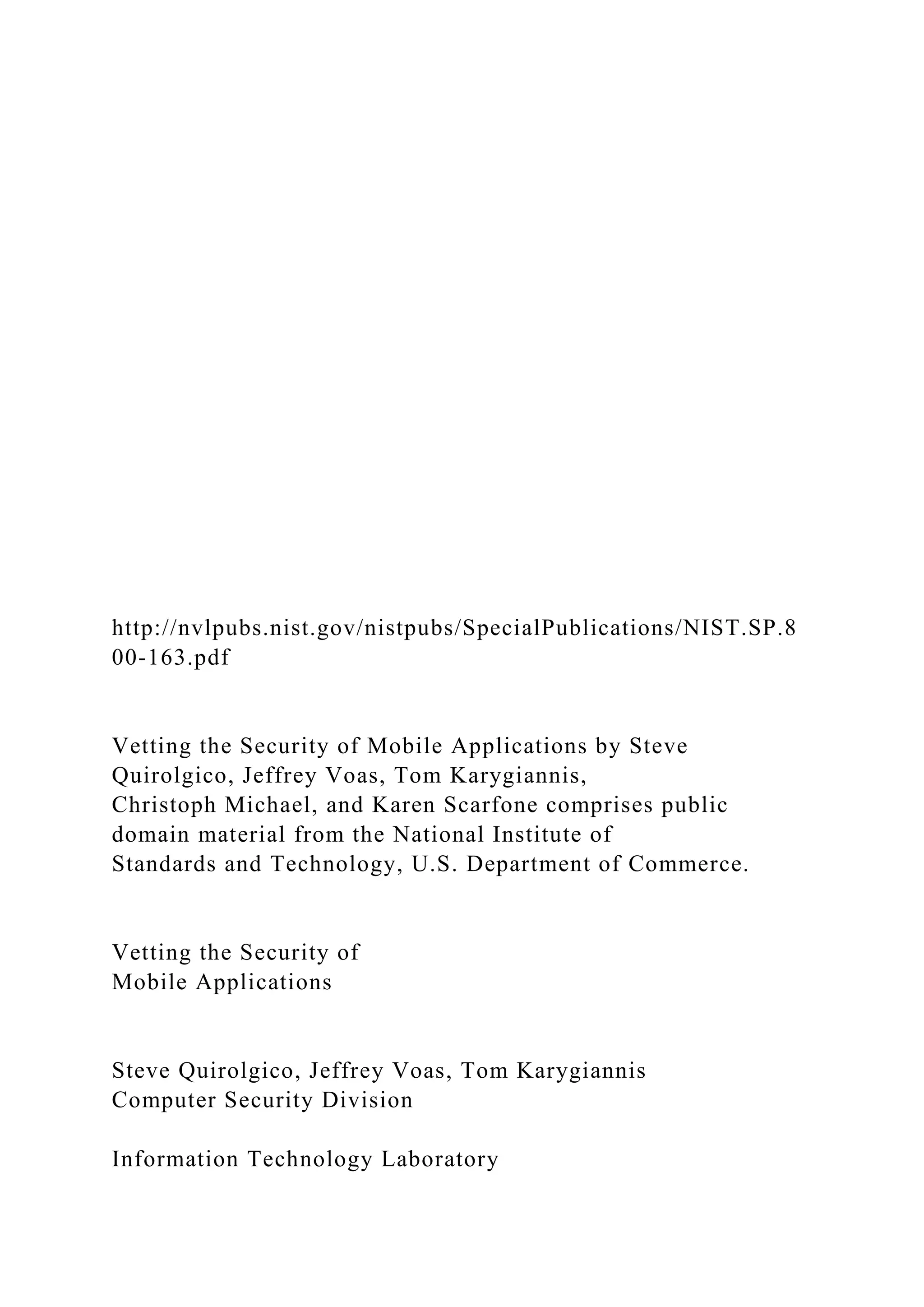
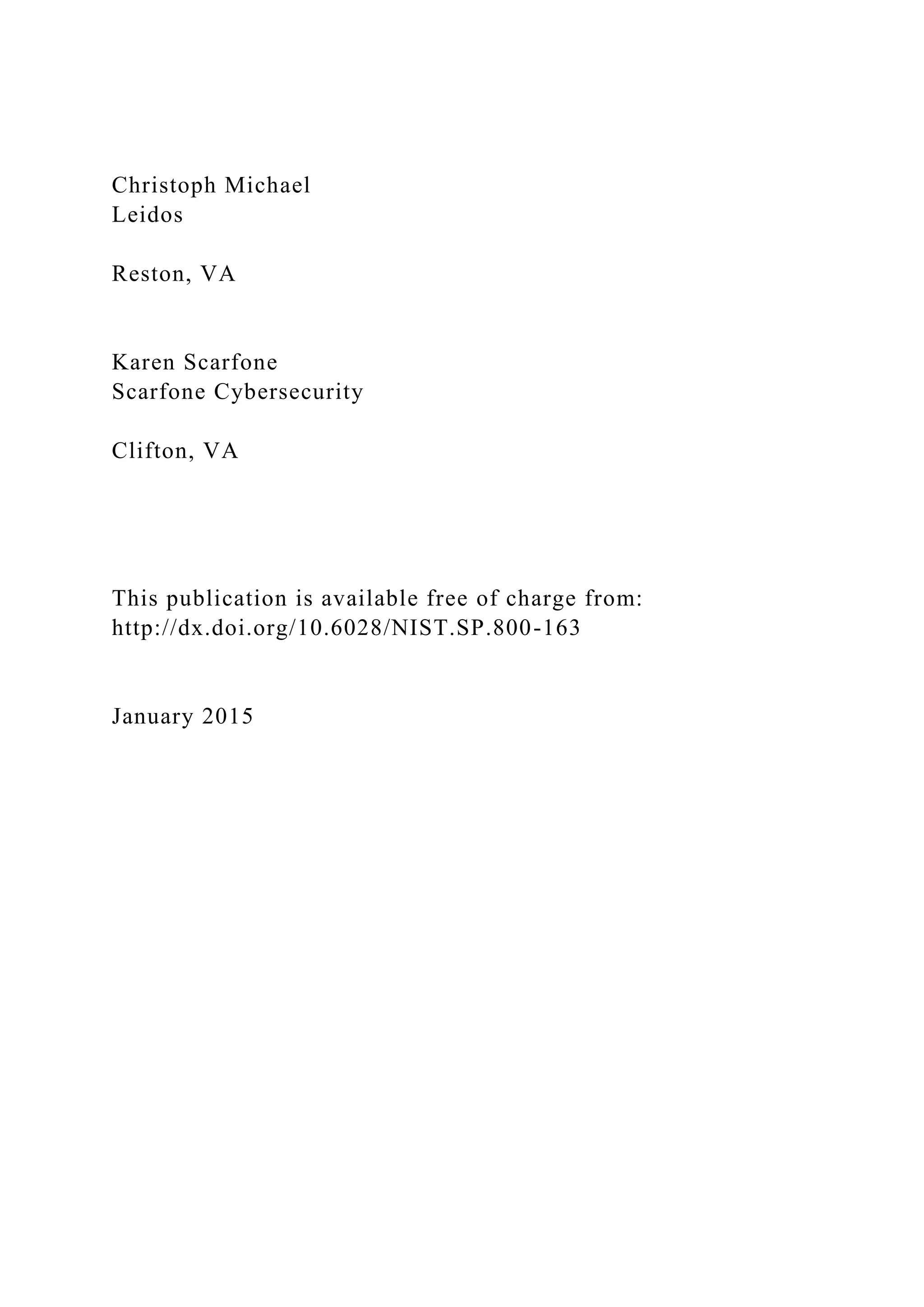


![entities, materials, or equipment are necessarily the best
available for the purpose.
There may be references in this publication to other
publications currently under development by NIST in
accordance with its assigned statutory responsibilities. The
information in this publication, including concepts and
methodologies, may be used by federal agencies even before the
completion of such companion publications. Thus,
until each publication is completed, current requirements,
guidelines, and procedures, where they exist, remain
operative. For planning and transition purposes, federal
agencies may wish to closely follow the development of
these new publications by NIST.
Organizations are encouraged to review all draft publications
during public comment periods and provide feedback
to NIST. All NIST Computer Security Division publications,
other than the ones noted above, are available at
http://csrc.nist.gov/publications.
Comments on this publication may be submitted to:
National Institute of Standards and Technology
Attn: Computer Security Division, Information Technology
Laboratory
100 Bureau Drive (Mail Stop 8930) Gaithersburg, MD 20899-
8930
[email protected]
ii](https://image.slidesharecdn.com/1-221101035239-dffccca1/75/1-Security-and-vulnerability-assessment-analysis-tool-Microsoft-docx-58-2048.jpg)
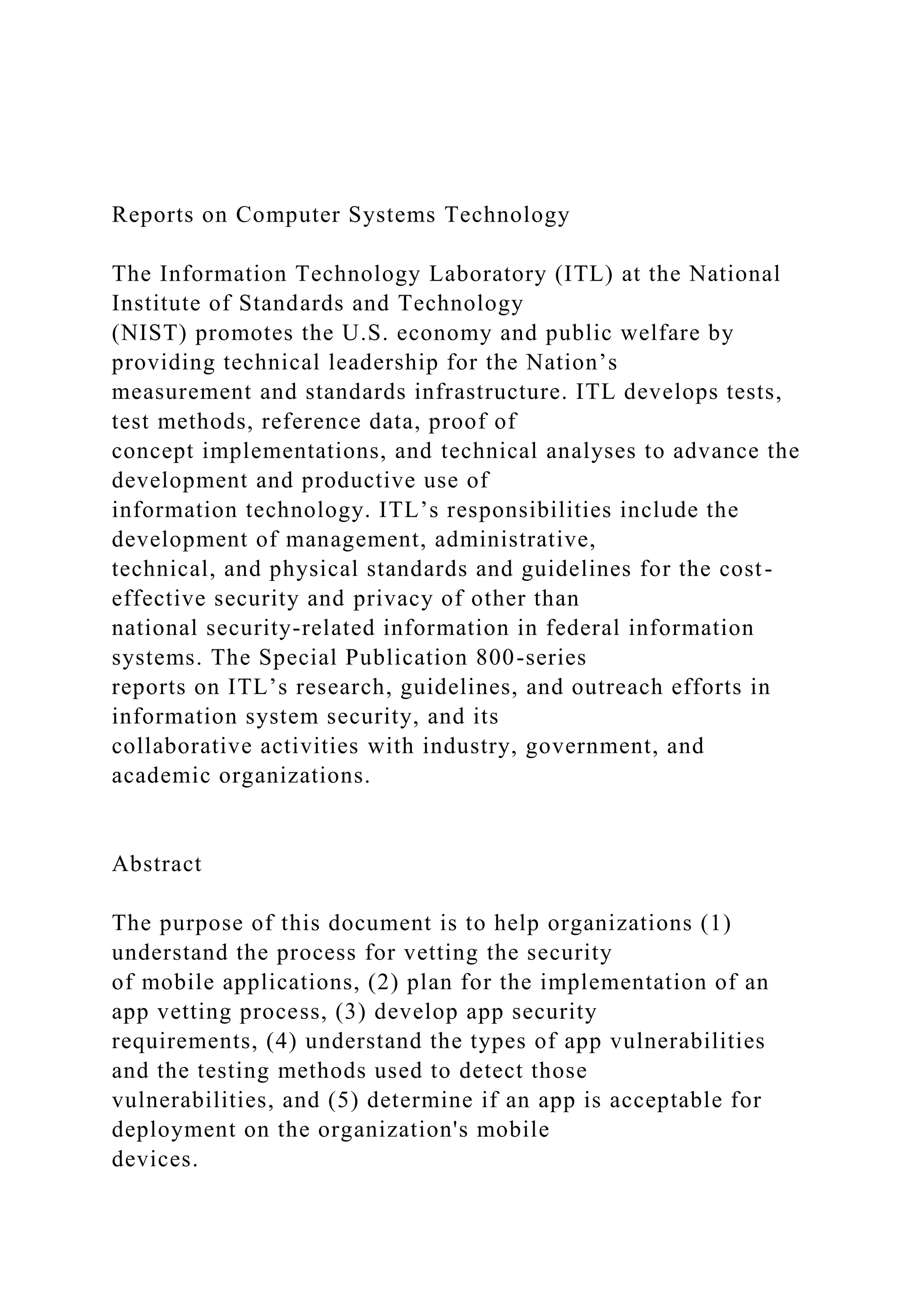
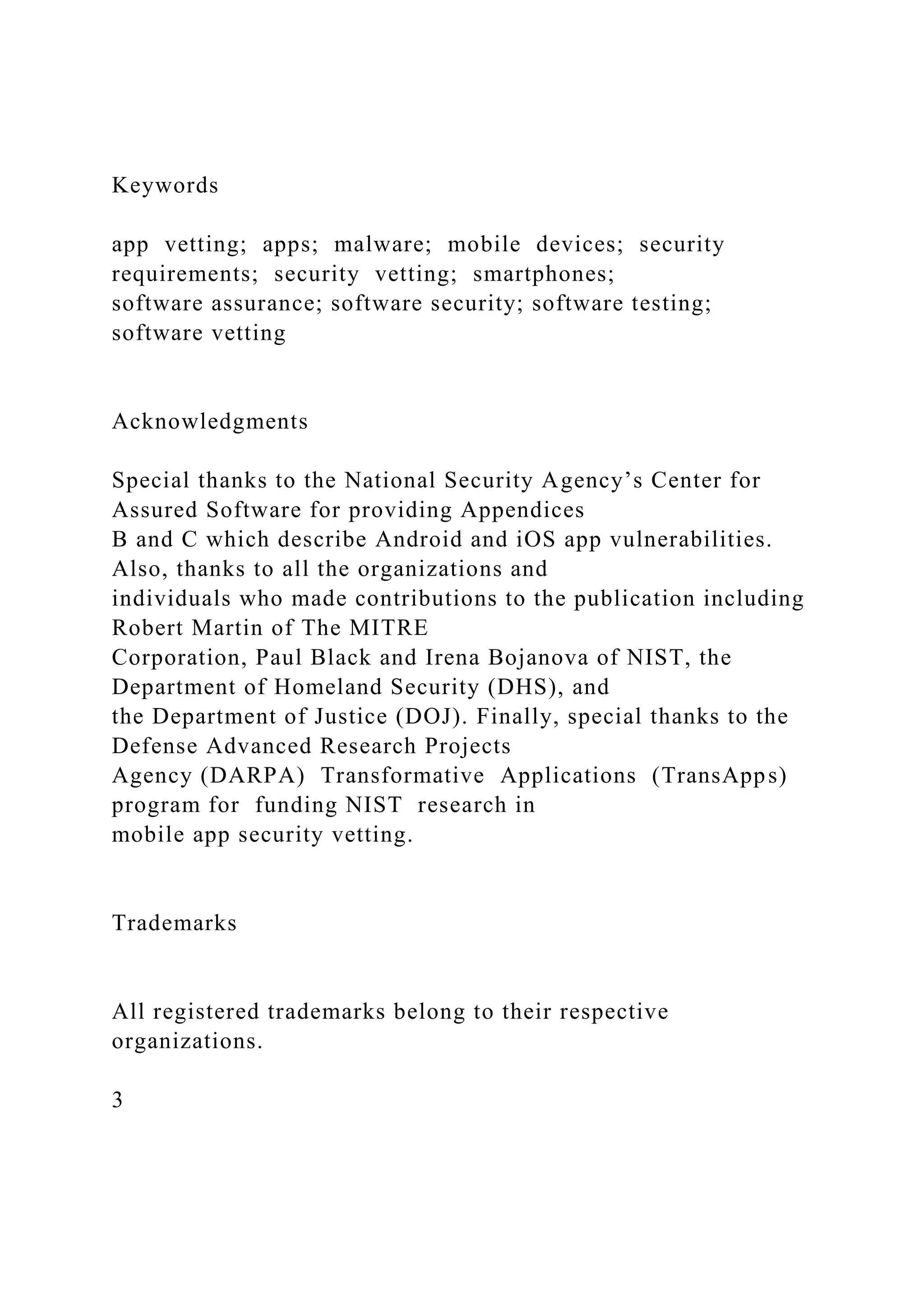
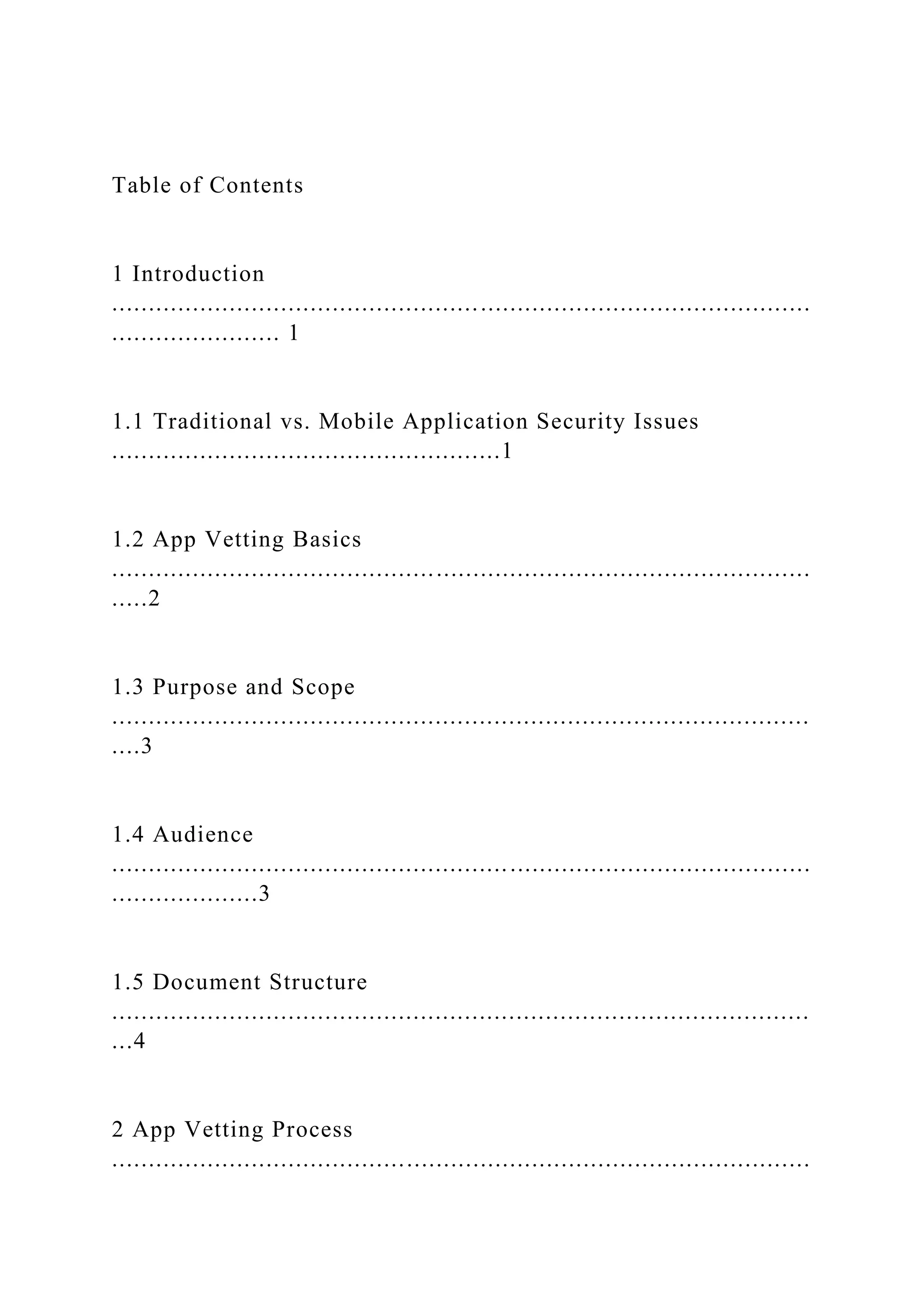
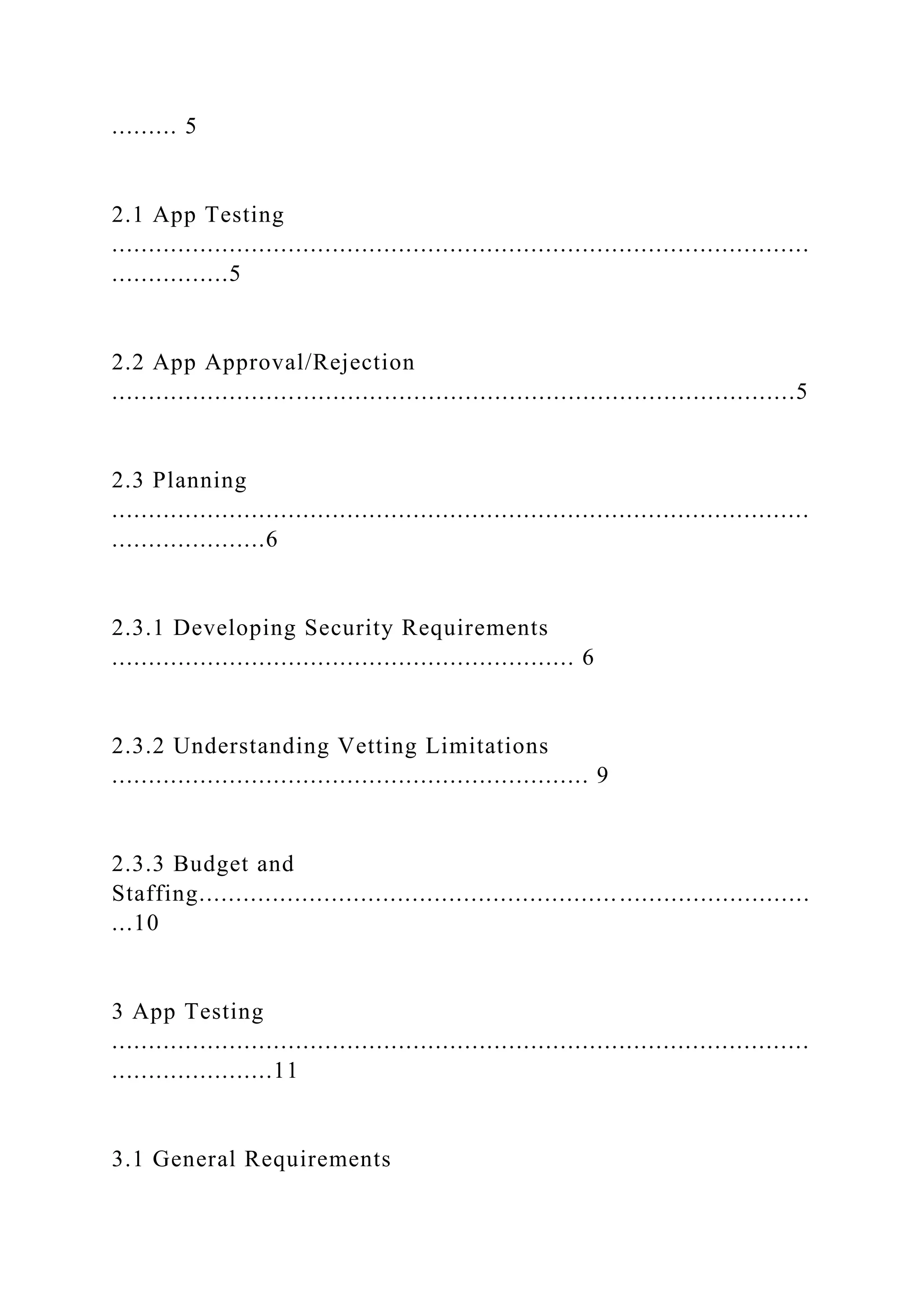
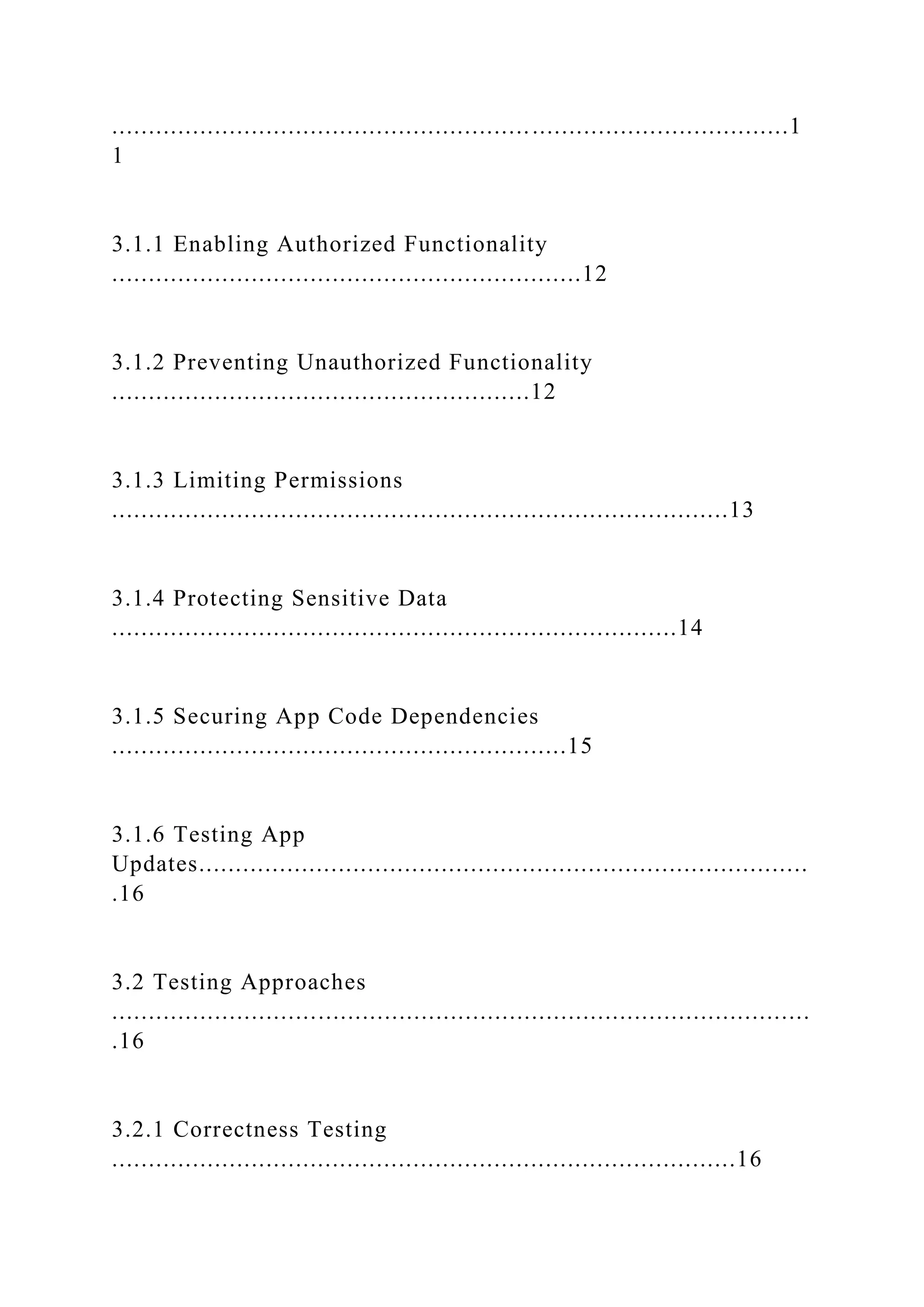
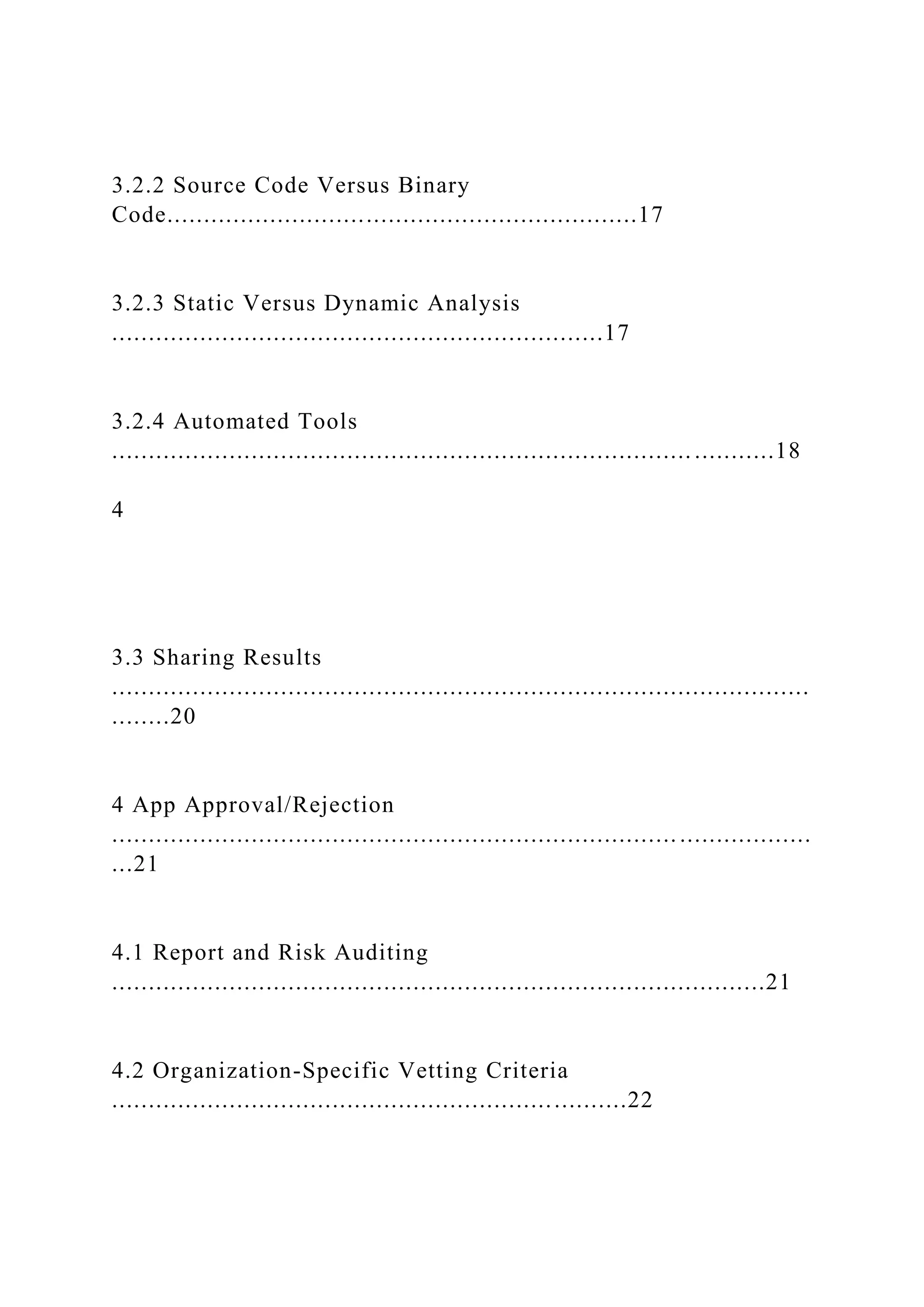
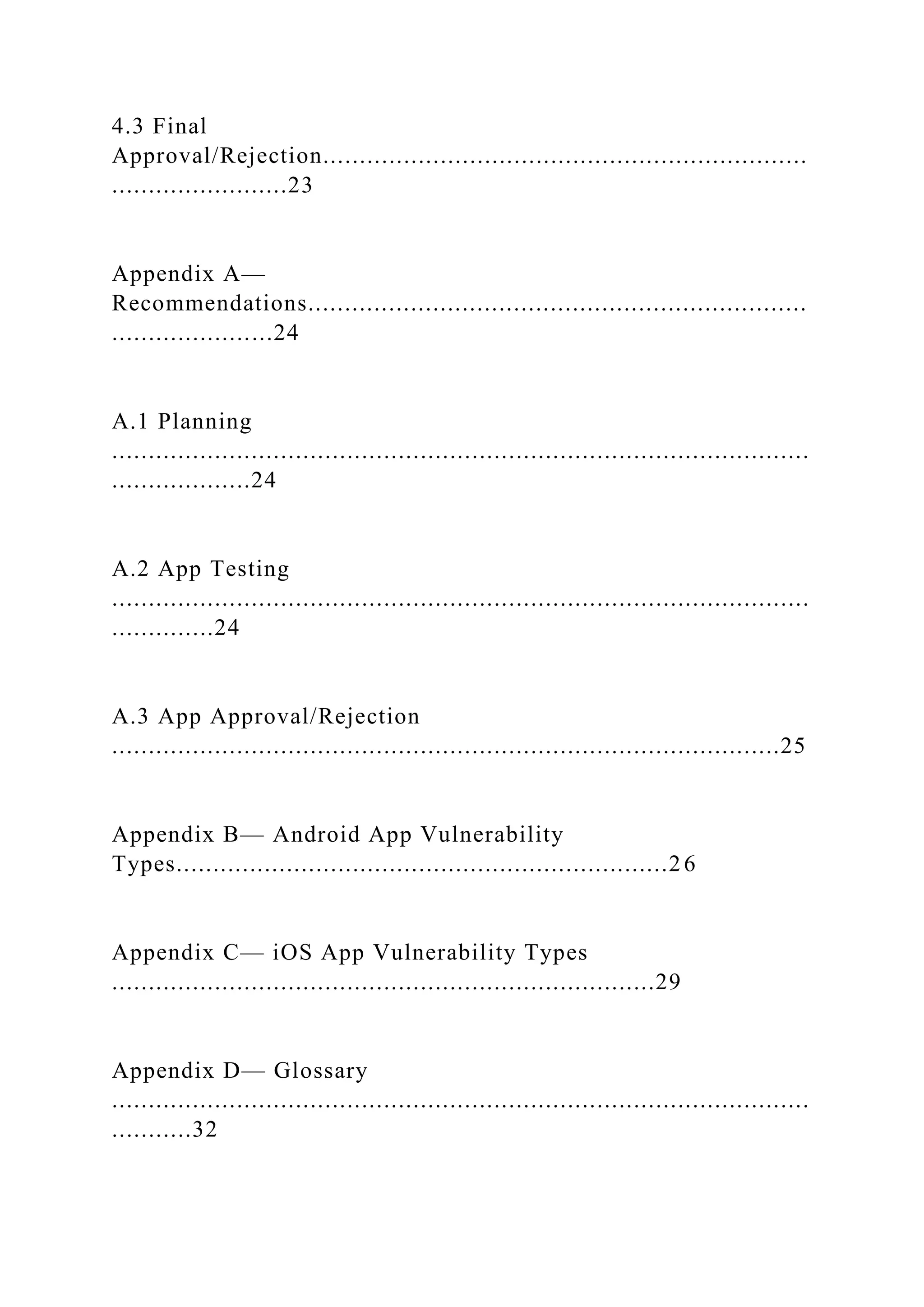
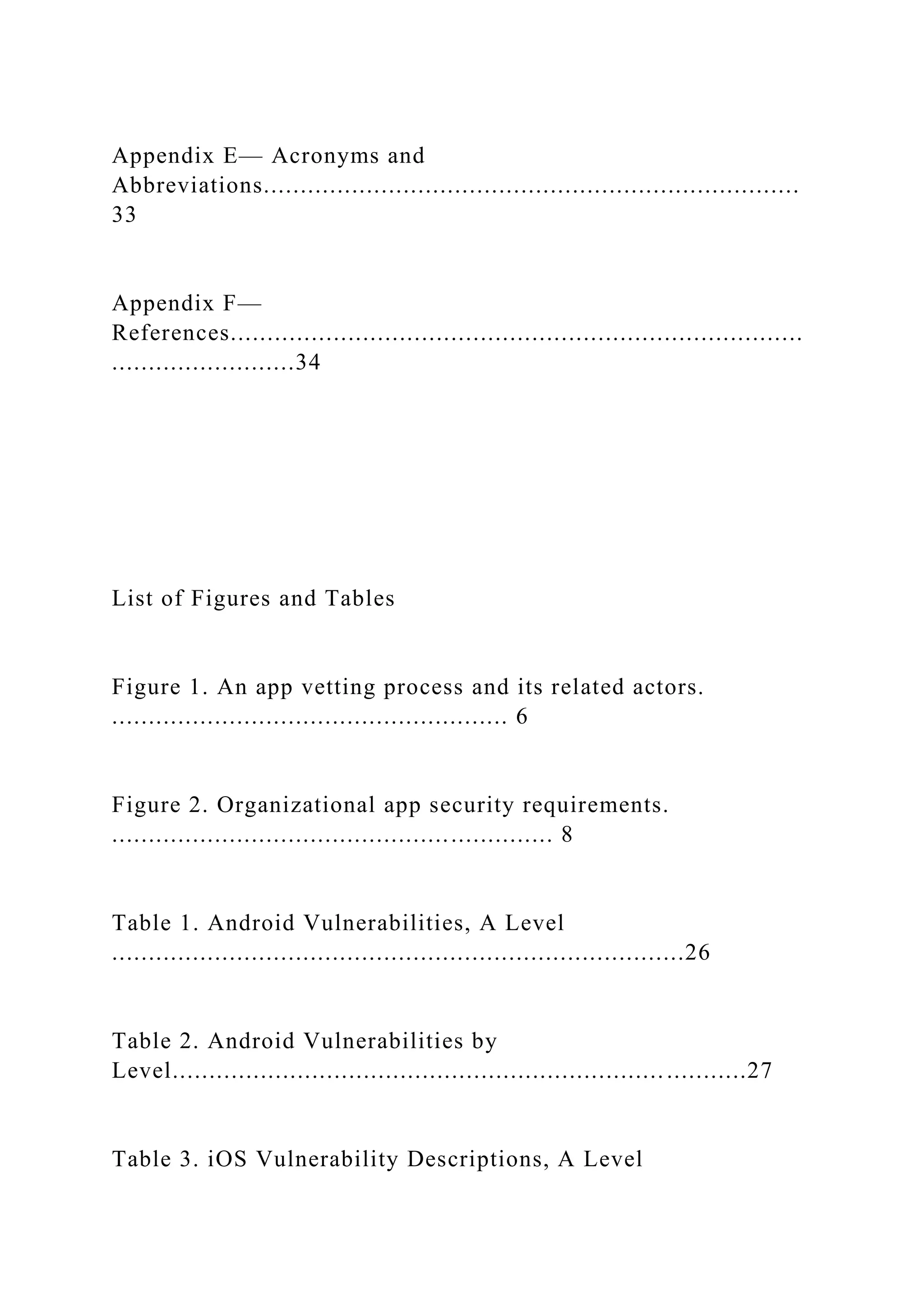
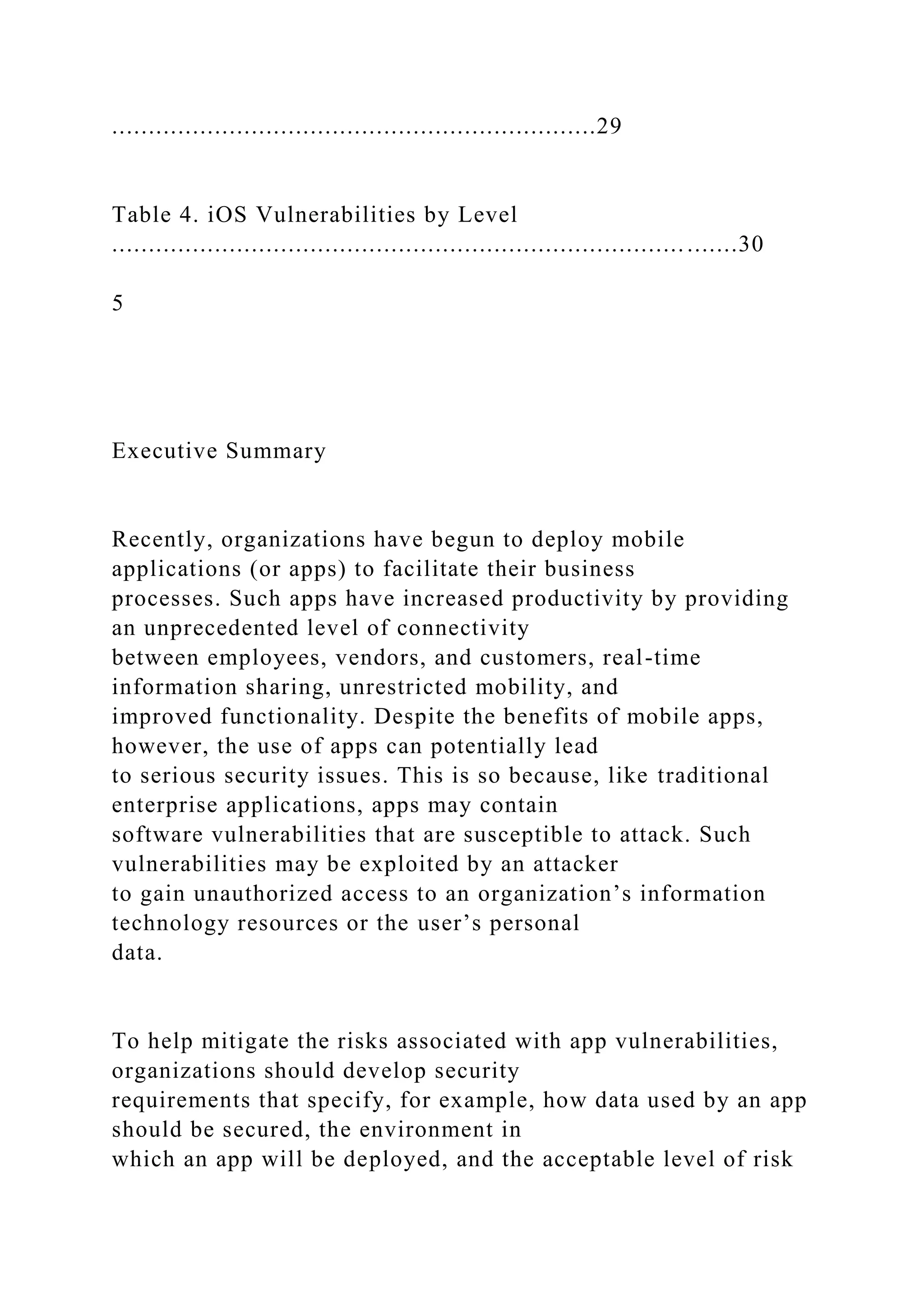
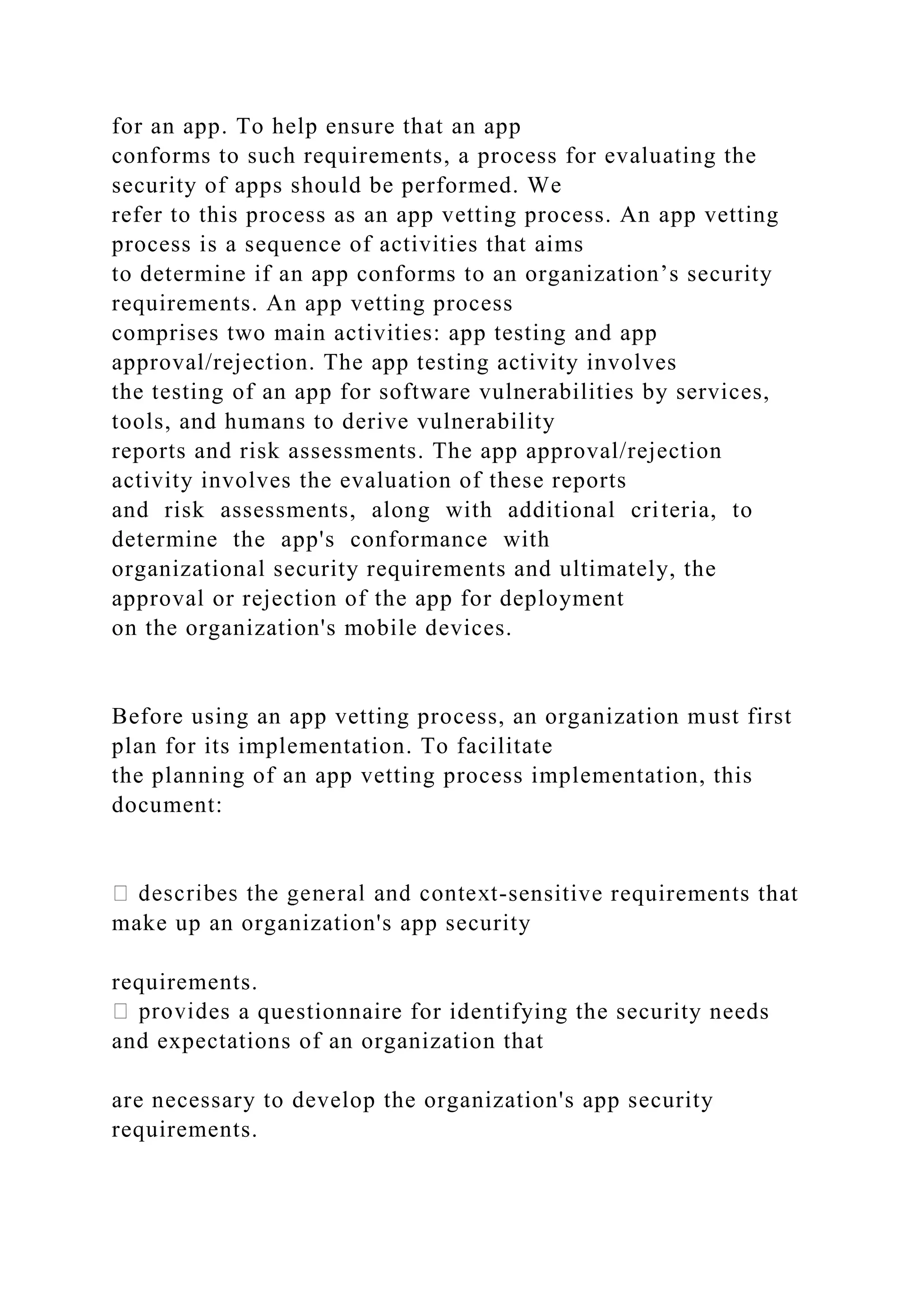

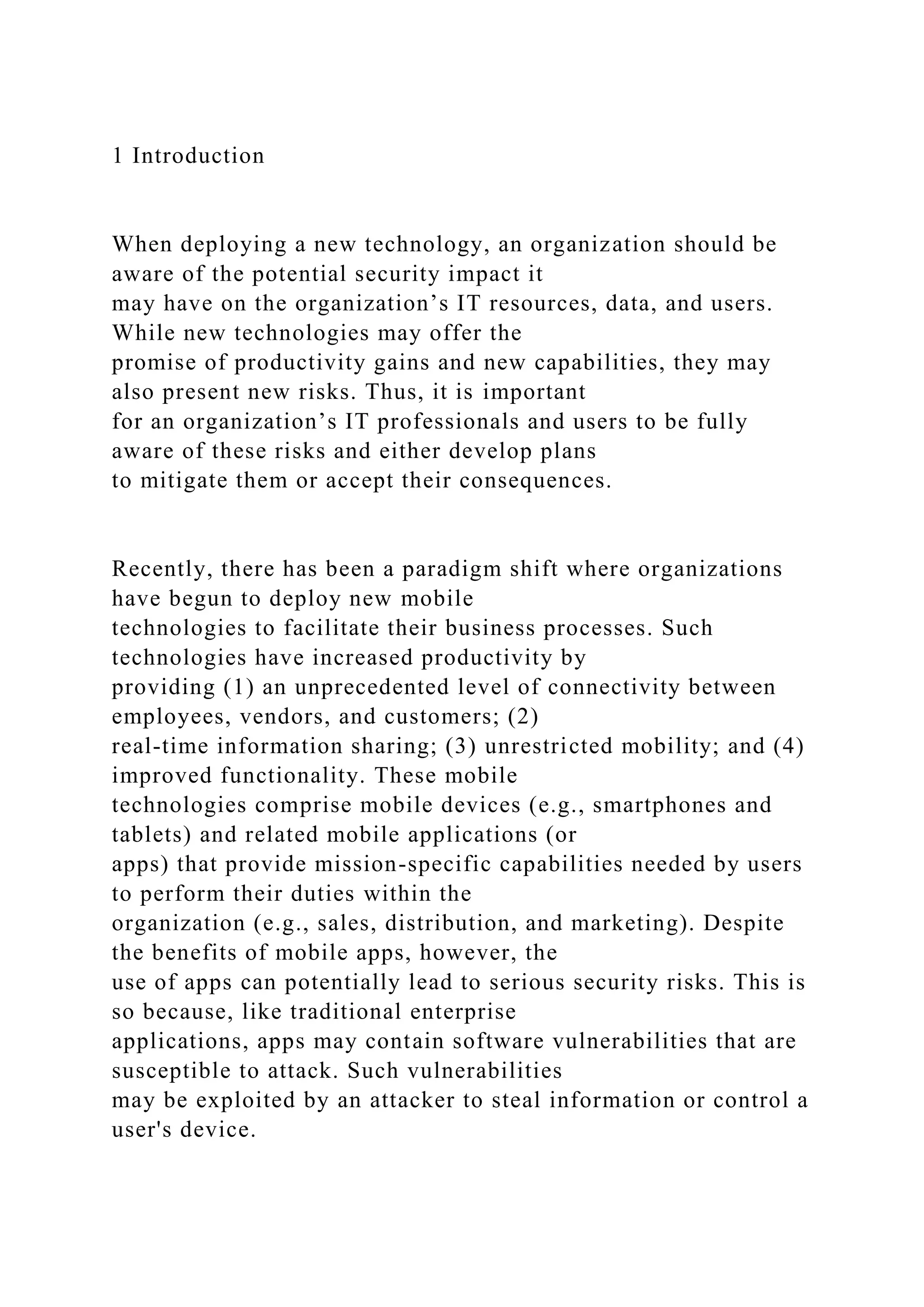
![To help mitigate the risks associated with software
vulnerabilities, organizations should employ software
assurance processes. Software assurance refers to “the level of
confidence that software is free from
vulnerabilities, either intentionally designed into the software
or accidentally inserted at any time during
its life cycle, and that the software functions in the intended
manner” [1]. The software assurance process
includes “the planned and systematic set of activities that
ensures that software processes and products
conform to requirements, standards, and procedures” [2]. A
number of government and industry legacy
software assurance standards exist that are primarily directed at
the process for developing applications
that require a high level of assurance (e.g., space flight,
automotive systems, and critical defense
systems).1 Although considerable progress has been made in the
past decades in the area of software
assurance, and research and development efforts have resulted
in a growing market of software assurance
tools and services, the state of practice for many today still
includes manual activities that are time-
consuming, costly, and difficult to quantify and make
repeatable. The advent of mobile computing adds
new challenges because it does not necessarily support
traditional software assurance techniques.
1.1 Traditional vs. Mobile Application Security Issues
The economic model of the rapidly evolving app marketplace
challenges the traditional software
development process. App developers are attracted by the
opportunities to reach a market of millions of](https://image.slidesharecdn.com/1-221101035239-dffccca1/75/1-Security-and-vulnerability-assessment-analysis-tool-Microsoft-docx-71-2048.jpg)
![users very quickly. However, such developers may have little
experience building quality software that is
secure and do not have the budgetary resources or motivation to
conduct extensive testing. Rather than
performing comprehensive software tests on their code
before making it available to the public,
developers often release apps that contain functionality flaws
and/or security-relevant weaknesses. That
can leave an app, the user’s device, and the user’s network
vulnerable to exploitation by attackers.
Developers and users of these apps often tolerate buggy,
unreliable, and insecure code in exchange for the
low cost. In addition, app developers typically update their apps
much more frequently than traditional
applications.
1 Examples of these software assurance standards include DO-
178B, Software Considerations in Airborne Systems and
Equipment Certification [3], IEC 61508 Functional Safety of
Electrical/Electronic/Programmable Electronic Safety-related
System [4], and ISO 26262 Road vehicles -- Functional safety
[5].
1
NIST SP 800-163 Vetting the Security of Mobile Applications
Organizations that once spent considerable resources to
develop in-house applications are taking
advantage of inexpensive third-party apps and web services to
improve their organization’s productivity.
Increasingly, business processes are conducted on mobile](https://image.slidesharecdn.com/1-221101035239-dffccca1/75/1-Security-and-vulnerability-assessment-analysis-tool-Microsoft-docx-72-2048.jpg)
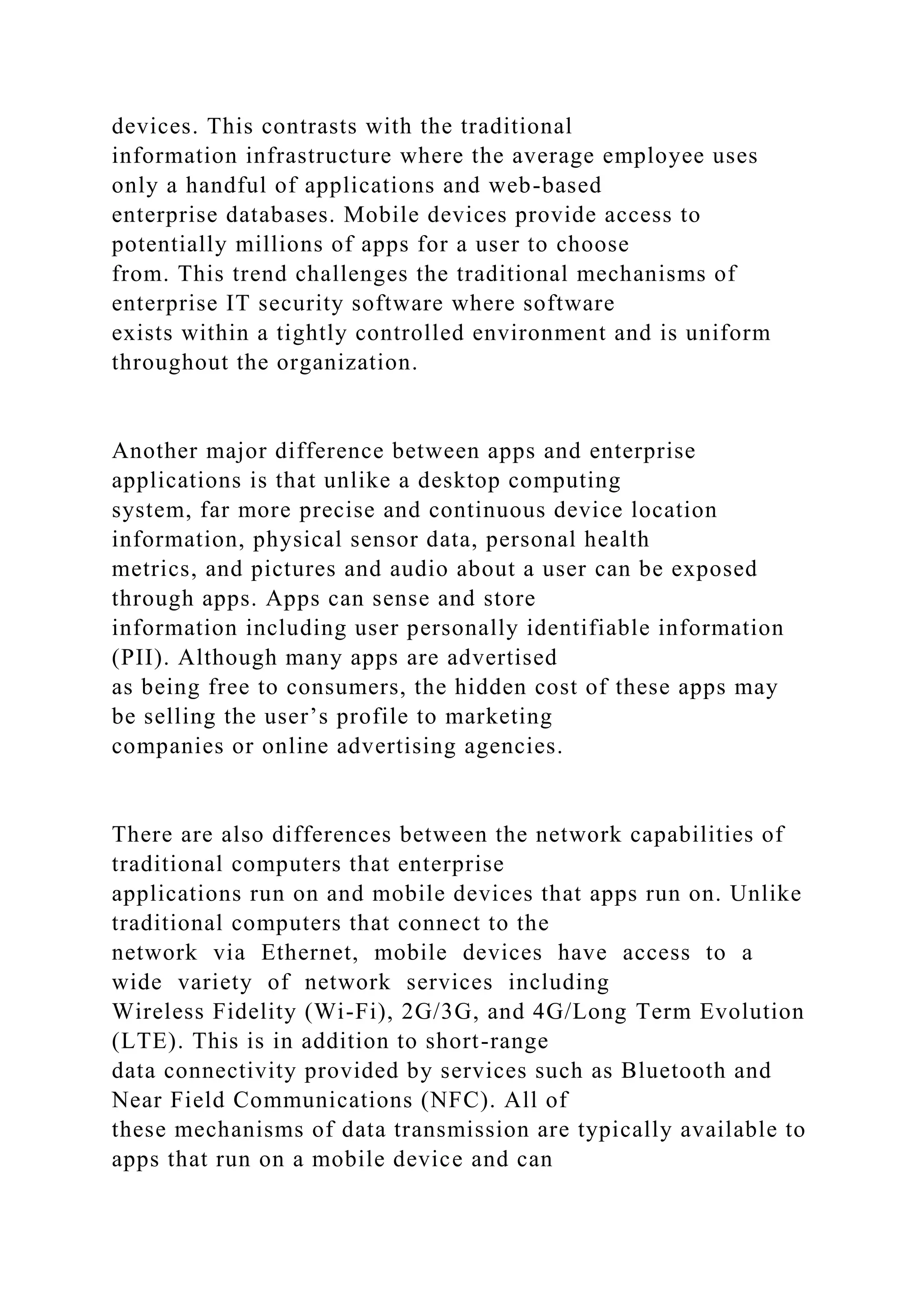
![be vectors for remote exploits. Further, mobile devices are not
physically protected to the same extent as
desktop or laptop computers and can therefore allow an attacker
to more easily (physically) acquire a lost
or stolen device.
1.2 App Vetting Basics
To provide software assurance for apps, organizations should
develop security requirements that specify,
for example, how data used by an app should be secured, the
environment in which an app will be
deployed, and the acceptable level of risk for an app (see [6] for
more information). To help ensure that
an app conforms to such requirements, a process for evaluating
the security of apps should be performed.
We refer to this process as an app vetting process. An app
vetting process is a sequence of activities that
aims to determine if an app conforms to the organization’s
security requirements.2 This process is
performed on an app after the app has been developed and
released for distribution but prior to its
deployment on an organization's mobile device. Thus, an app
vetting process is distinguished from
software assurance processes that may occur during the software
development life cycle of an app. Note
that an app vetting process typically involves analysis of an
app’s compiled, binary representation but can
also involve analysis of the app’s source code if it is available.
The software distribution model that has arisen with mobile
computing presents a number of software
assurance challenges, but it also creates opportunities. An app](https://image.slidesharecdn.com/1-221101035239-dffccca1/75/1-Security-and-vulnerability-assessment-analysis-tool-Microsoft-docx-74-2048.jpg)
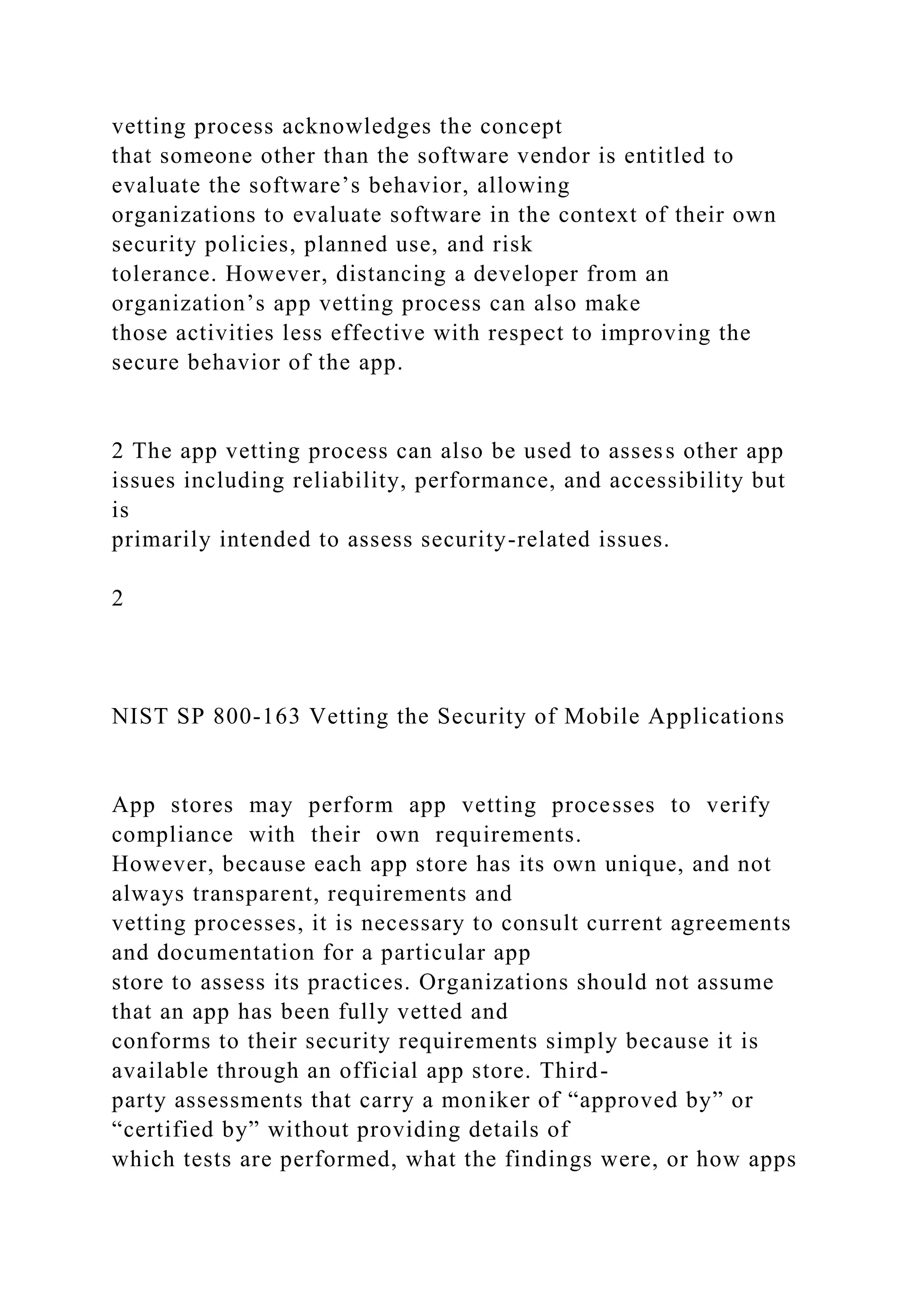

![1.3 Purpose and Scope
The purpose of this document is to help organizations (1)
understand the app vetting process, (2) plan for
the implementation of an app vetting process, (3) develop app
security requirements, (4) understand the
types of app vulnerabilities and the testing methods used to
detect those vulnerabilities, and (5) determine
if an app is acceptable for deployment on the organization's
mobile devices. Ultimately, the acceptance of
an app depends on the organization’s security requirements
which, in turn, depend on the environment in
which the app is deployed, the context in which it will be used,
and the underlying mobile technologies
used to run the app. This document highlights those elements
that are particularly important to be
considered before apps are approved as “fit-for-use.”
Note that this document does not address the security of the
underlying mobile platform and operating
system, which are addressed in other publications [6, 7, 8].
While these are important characteristics for
organizations to understand and consider in selecting mobile
devices, this document is focused on how to
vet apps after the choice of platform has been made. Similarly,
discussion surrounding the security of web
services used to support back-end processing for apps is out of
scope for this document.
1.4 Audience
This document is intended for organizations that plan to](https://image.slidesharecdn.com/1-221101035239-dffccca1/75/1-Security-and-vulnerability-assessment-analysis-tool-Microsoft-docx-77-2048.jpg)

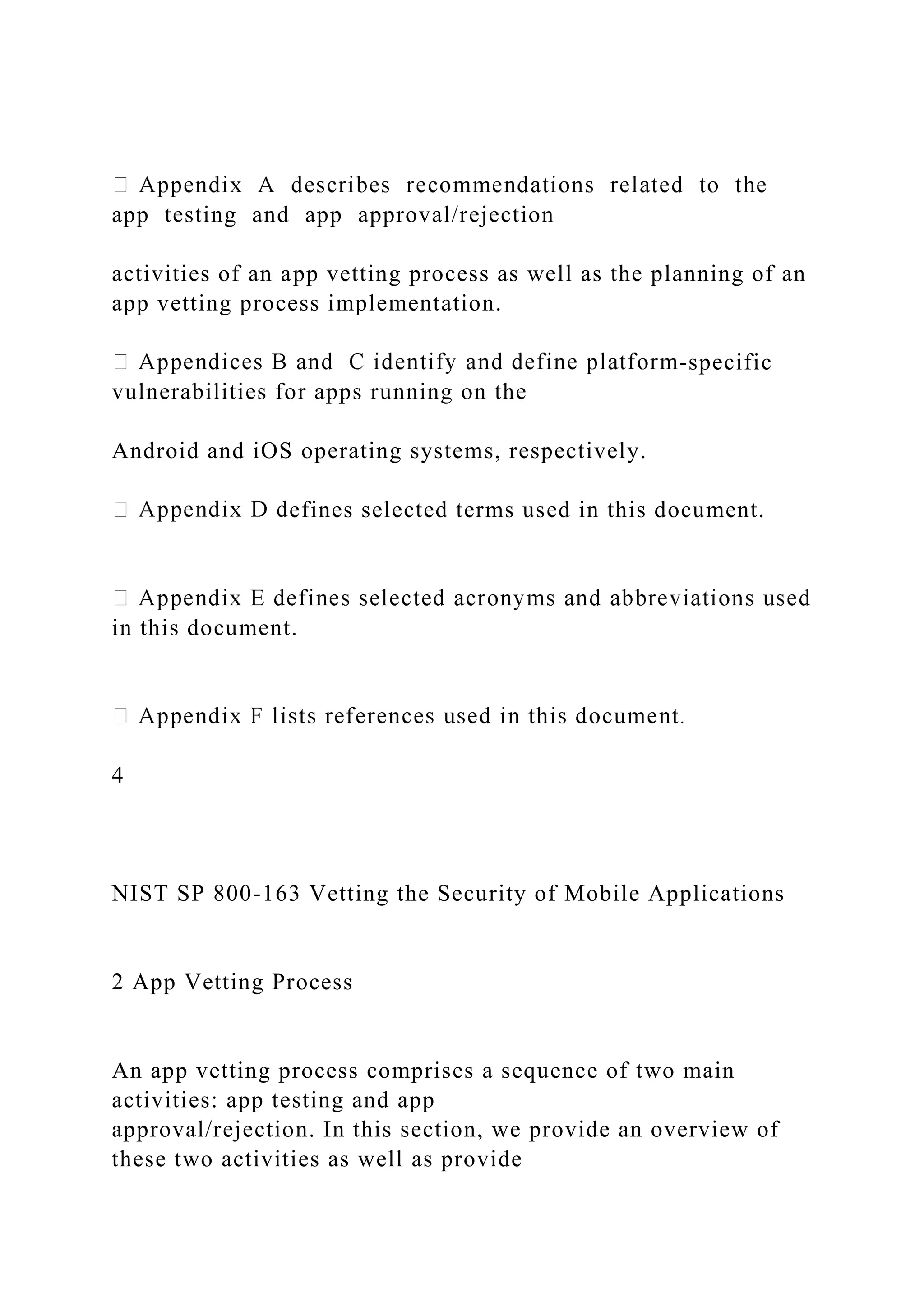
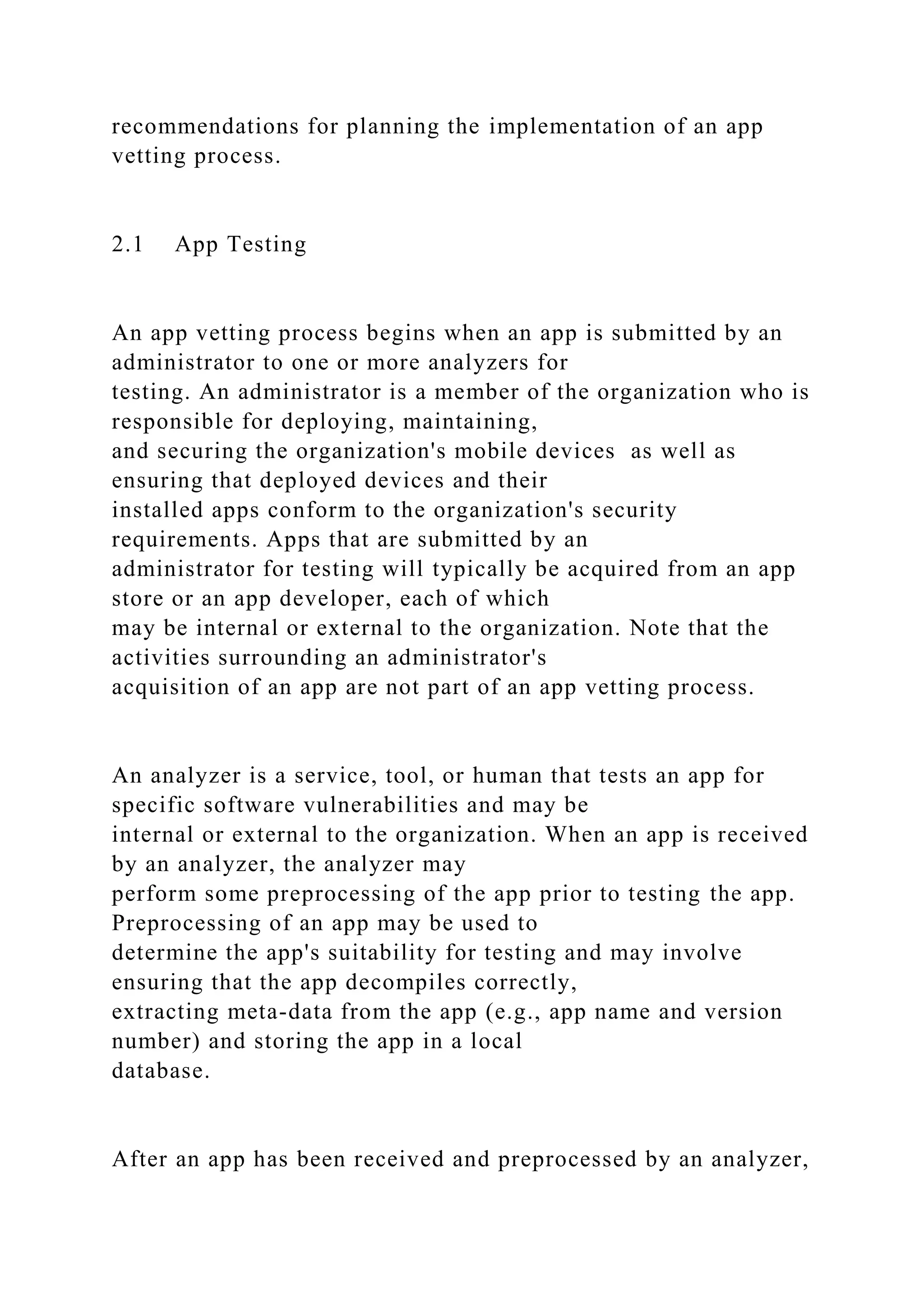

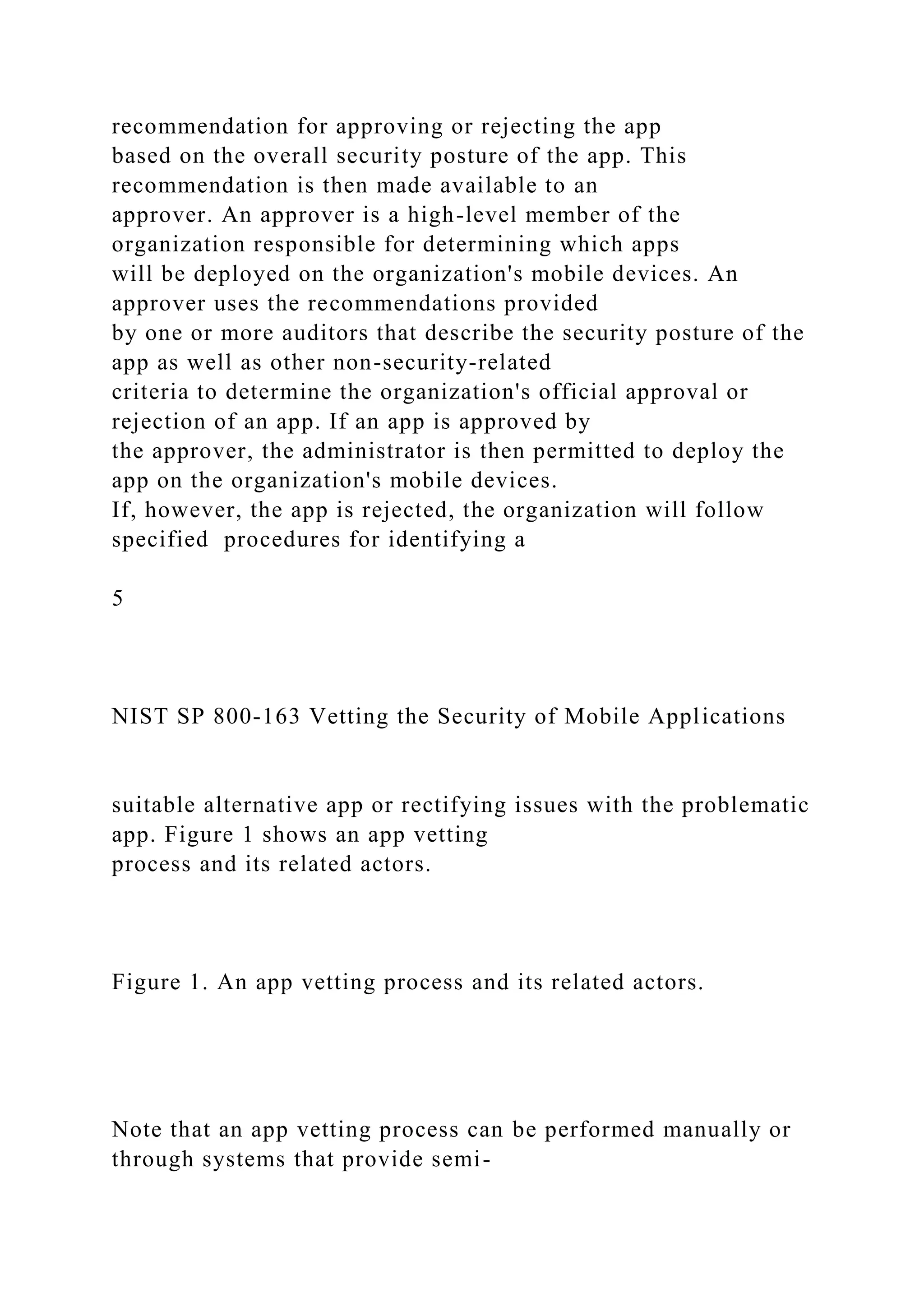
![automated management of the app testing and app
approval/rejection activities [9]. Further note that
although app vetting processes may vary among organizations,
organizations should strive to implement a
process that is repeatable, efficient, consistent, and that limits
errors (e.g., false positive and false negative
results).
2.3 Planning
Before an organization can implement an app vetting process, it
is necessary for the organization to first
(1) develop app security requirements, (2) understand the
limitations of app vetting, and (3) procure a
budget and staff for supporting the app vetting
process. Recommendations for planning the
implementation of an app vetting process are described in
Appendix A.1.
2.3.1 Developing Security Requirements
App security requirements state an organization’s expectations
for app security and drive the evaluation
process. When possible, tailoring app security assessments to
the organization’s unique mission
requirements, policies, risk tolerance, and available security
countermeasures is more cost-effective in
time and resources. Such assessments could minimize the risk of
attackers exploiting behaviors not taken
into account during vetting, since foreseeing all future
insecure behaviors during deployment is
unrealistic. Unfortunately, it is not always possible to get](https://image.slidesharecdn.com/1-221101035239-dffccca1/75/1-Security-and-vulnerability-assessment-analysis-tool-Microsoft-docx-83-2048.jpg)


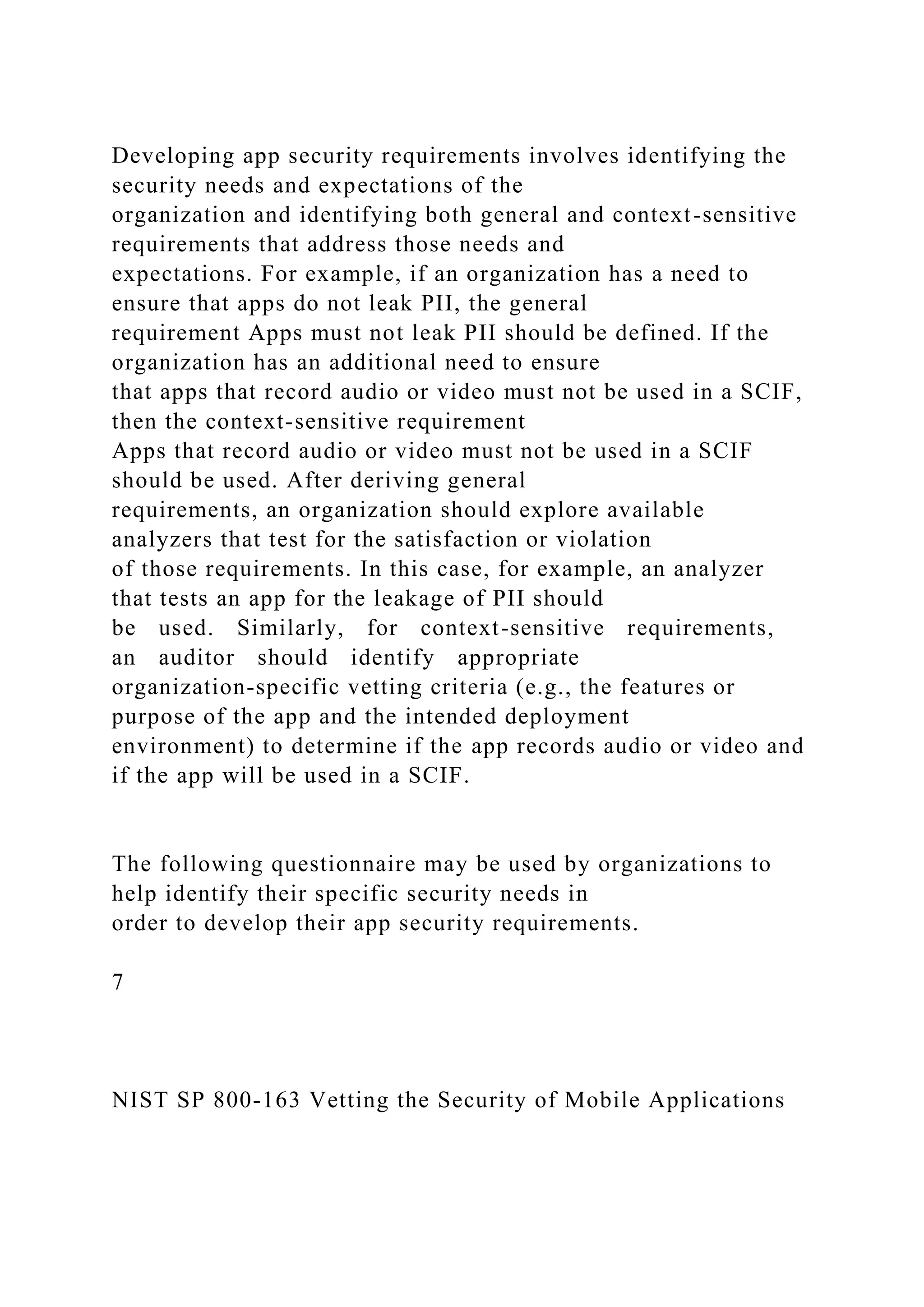

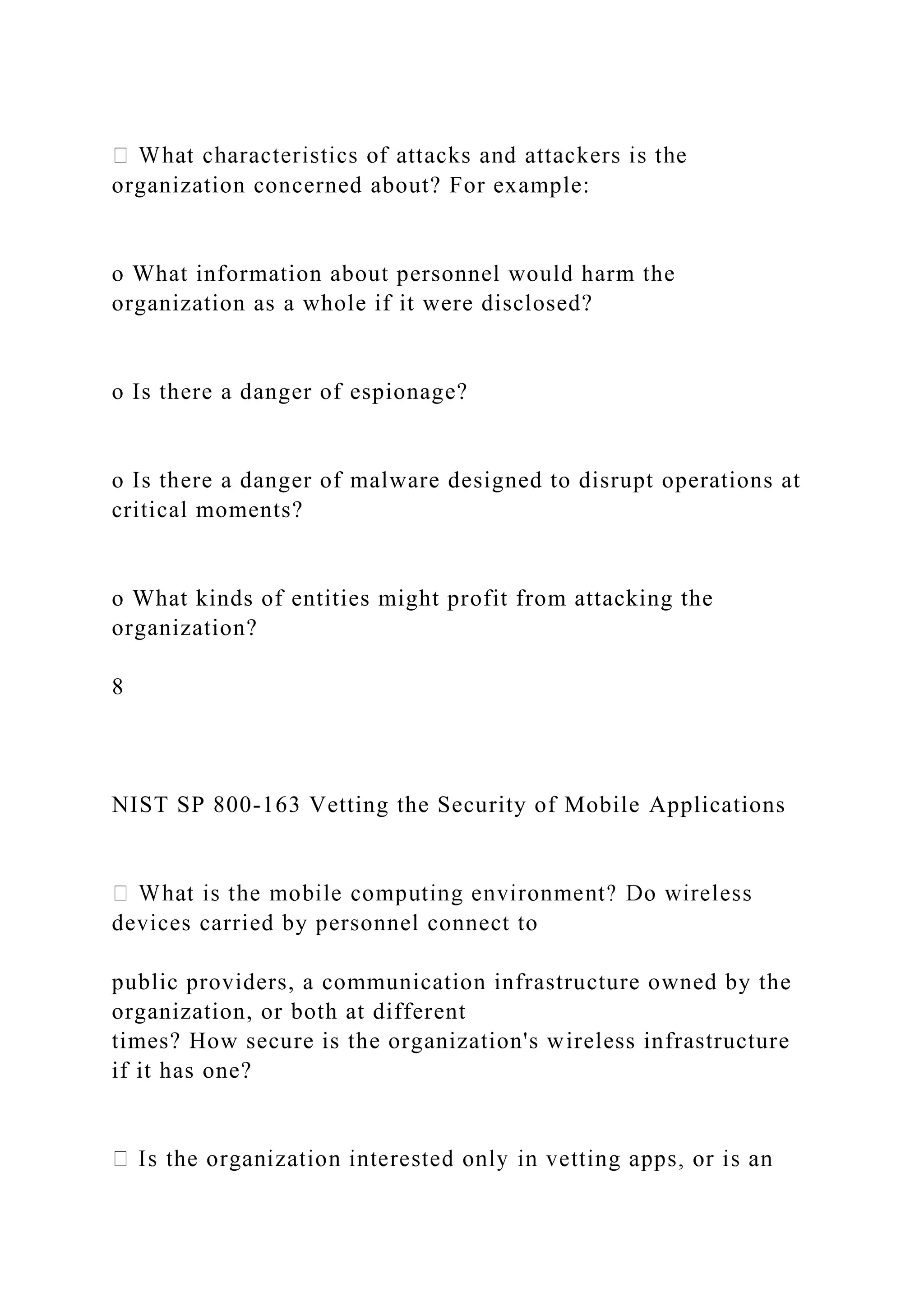
![app vetting process expected to evaluate
other aspects of mobile device security such as the operating
system (OS), firmware, hardware, and
communications? Is the app vetting process meant only to
perform evaluations or does it play a
broader role in the organization’s approach to mobile security?
Is the vetting process part of a larger
security infrastructure, and if so, what are the other
components? Note that only software-related
vetting is in the scope of this document, but if the organization
expects more than this, the vetting
process designers should be aware of it.
expected to handle, and how much variation is
permissible in the time needed to process individual apps? High
volume combined with low
funding might necessitate compromises in the quality of the
evaluation. Some organizations may
believe that a fully automated assessment pipeline provides
more risk reduction than it actually does
and therefore expect unrealistically low day-to-day expenses.
Organizations should perform a risk analysis [10] to understand
and document the potential security risks
in order to help identify appropriate security requirements.
Some types of vulnerabilities or weaknesses
discovered in apps may be mitigated by other security controls
included in the enterprise mobile device
architecture. With respect to these other controls, organizations
should review and document the mobile
device hardware and operating system security controls (e.g.,](https://image.slidesharecdn.com/1-221101035239-dffccca1/75/1-Security-and-vulnerability-assessment-analysis-tool-Microsoft-docx-89-2048.jpg)
![encrypted file systems), to identify which
security and privacy requirements can be addressed by the
mobile device itself. In addition, mobile
enterprise security technologies such as Mobile Device
Management (MDM) solutions should also be
reviewed to identify which security requirements can be
addressed by these technologies.
2.3.2 Understanding Vetting Limitations
As with any software assurance process, there is no guarantee
that even the most thorough vetting process
will uncover all potential vulnerabilities. Organizations should
be made aware that although app security
assessments should generally improve the security posture of
the organization, the degree to which they
do so may not be easily or immediately ascertained.
Organizations should also be made aware of what the
vetting process does and does not provide in terms of security.
Organizations should also be educated on the value of humans
in security assessment processes and
ensure that their app vetting does not rely solely on automated
tests. Security analysis is primarily a
human-driven process [11, 12]; automated tools by themselves
cannot address many of the contextual and
nuanced interdependencies that underlie software security. The
most obvious reason for this is that fully
understanding software behavior is one of the classic impossible
problems of computer science [13], and
in fact current technology has not even reached the limits of
what is theoretically possible. Complex,
multifaceted software architectures cannot be fully analyzed by](https://image.slidesharecdn.com/1-221101035239-dffccca1/75/1-Security-and-vulnerability-assessment-analysis-tool-Microsoft-docx-90-2048.jpg)
![automated means.
A further problem is that current software analysis tools do not
inherently understand what software has
to do to behave in a secure manner in a particular context. For
example, failure to encrypt data transmitted
to the cloud may not be a security issue if the transmission is
tunneled through a virtual private network
(VPN). Even if the security requirements for an app have been
correctly predicted and are completely
understood, there is no current technology for unambiguously
translating human-readable requirements
into a form that can be understood by machines.
For these reasons, security analysis requires humans (e.g.,
auditors) in the loop, and by extension the
quality of the outcome depends, among other things, on the
level of human effort and level of expertise
9
NIST SP 800-163 Vetting the Security of Mobile Applications
available for an evaluation. Auditors should be familiar with
standard processes and best practices for
software security assessment (e.g., see [11, 14, 15, 16]). A
robust app vetting process should use multiple
assessment tools and processes, as well as human interaction, to
be successful; reliance on only a single
tool, even with human interaction, is a significant risk because
of the inherent limitations of each tool.](https://image.slidesharecdn.com/1-221101035239-dffccca1/75/1-Security-and-vulnerability-assessment-analysis-tool-Microsoft-docx-91-2048.jpg)
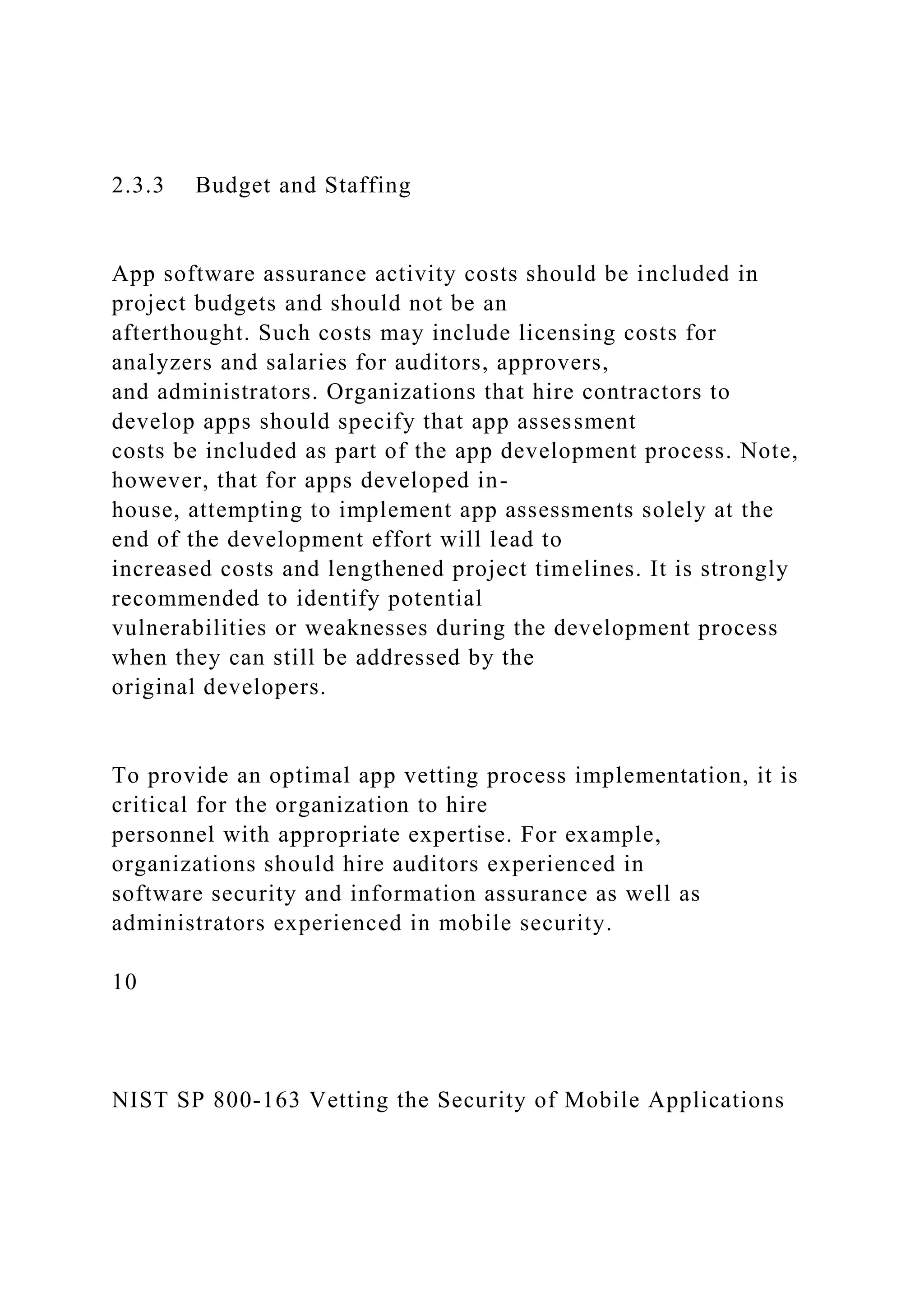
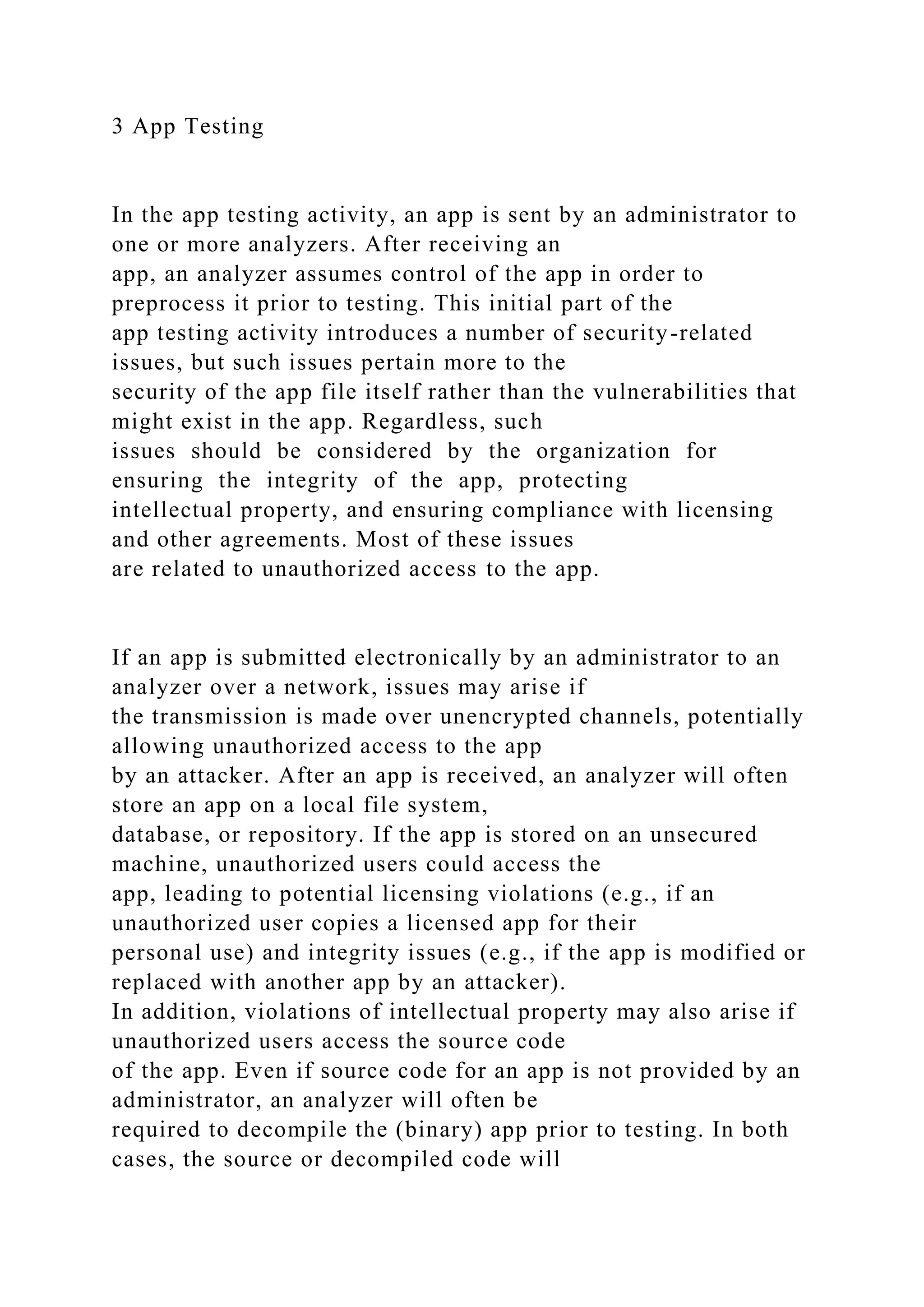
![often be stored on a machine by the analyzer. If that machine is
unsecured, the app's code may be
accessible to unauthorized users, potentially allowing a
violation of intellectual property. Note that
organizations should review an app’s End User License
Agreement (EULA) regarding the sending of an
app to a third-party for analysis as well as the reverse
engineering of the app’s code by the organization or
a third-party to ensure that the organization is not in violation
of the EULA.
If an analyzer is external to the organization, then the
responsibility of ensuring the security of the app file
falls on the analyzer. Thus, the best that an organization can do
to ensure the integrity of apps, the
protection of intellectual property, and the compliance with
licensing agreements is to understand the
security implications surrounding the transmission, storage, and
processing of an app by the specific
analyzer.
After an app has been preprocessed by an analyzer, the analyzer
will then test the app for software
vulnerabilities that violate one or more general app security
requirements. In this section, we describe
these general requirements and the testing approaches used to
detect vulnerabilities that violate these
requirements. Descriptions of specific Android and iOS app
vulnerabilities are provided in Appendices B
and C. In addition, recommendations related to the app testing
activity are described in Appendix A.2. For
more information on security testing and assessment tools and
techniques that may be helpful for
performing app testing, see [17].](https://image.slidesharecdn.com/1-221101035239-dffccca1/75/1-Security-and-vulnerability-assessment-analysis-tool-Microsoft-docx-94-2048.jpg)
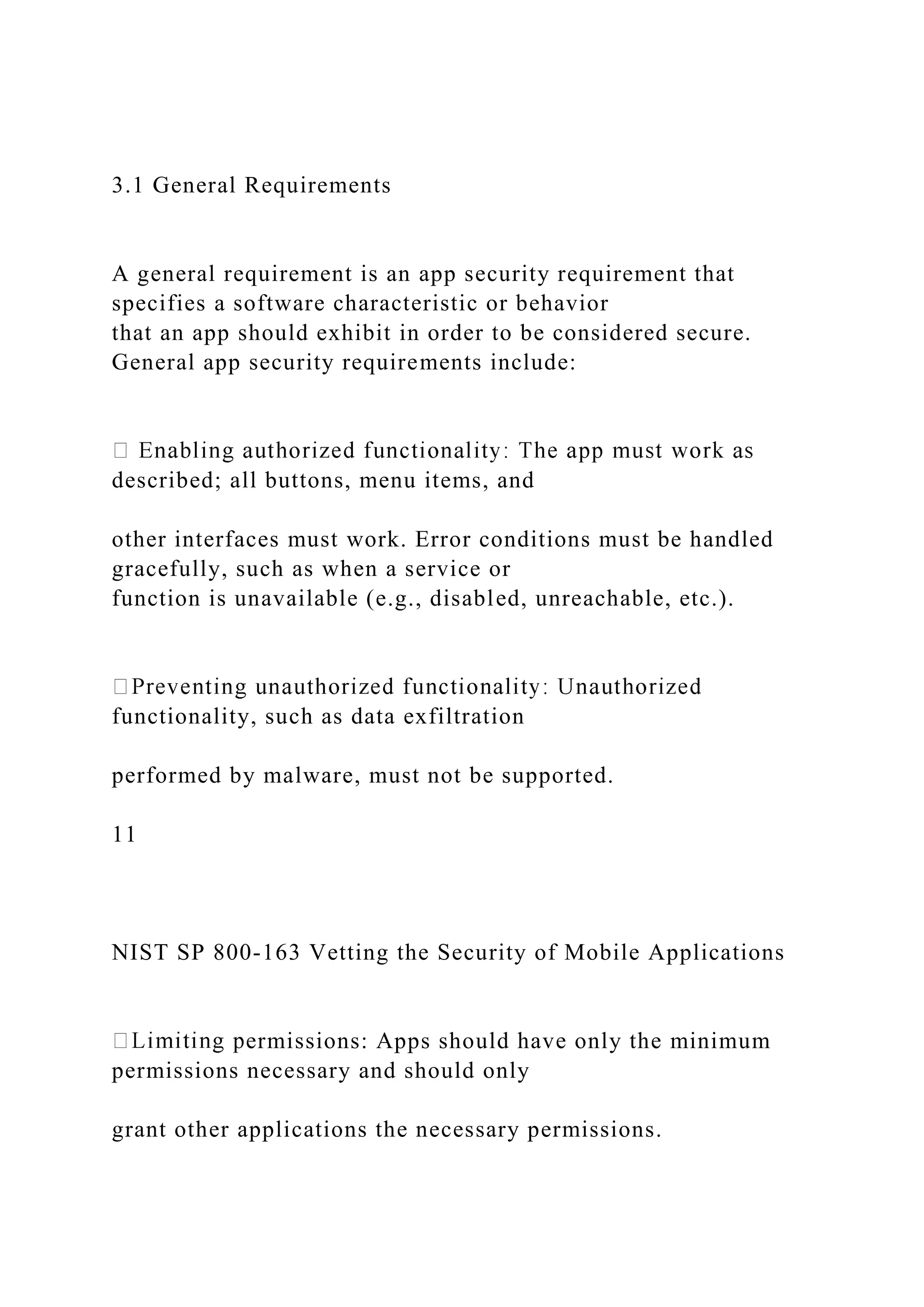
![transmit sensitive data should protect the
confidentiality and integrity of this data. This category includes
preserving privacy, such as asking
permission to use personal information and using it only for
authorized purposes.
dependencies, such as on libraries, in a
reasonable manner and not for malicious reasons.
to identify any new weaknesses.
Well-written security requirements are most useful to auditors
when they can easily be translated into
specific evaluation activities. The various processes concerning
the elicitation, management, and tracking
of requirements are collectively known as requirements
engineering [18, 19], and this is a relatively
mature activity with tools support. Presently, there is no
methodology for driving all requirements down
to the level where they could be checked completely3 by
automatic software analysis, while ensuring that
the full scope of the original requirements is preserved. Thus,
the best we can do may be to document the
process in such a way that human reviews can find gaps and
concentrate on the types of vulnerabilities, or
weaknesses, that fall into those gaps.
3.1.1 Enabling Authorized Functionality](https://image.slidesharecdn.com/1-221101035239-dffccca1/75/1-Security-and-vulnerability-assessment-analysis-tool-Microsoft-docx-96-2048.jpg)

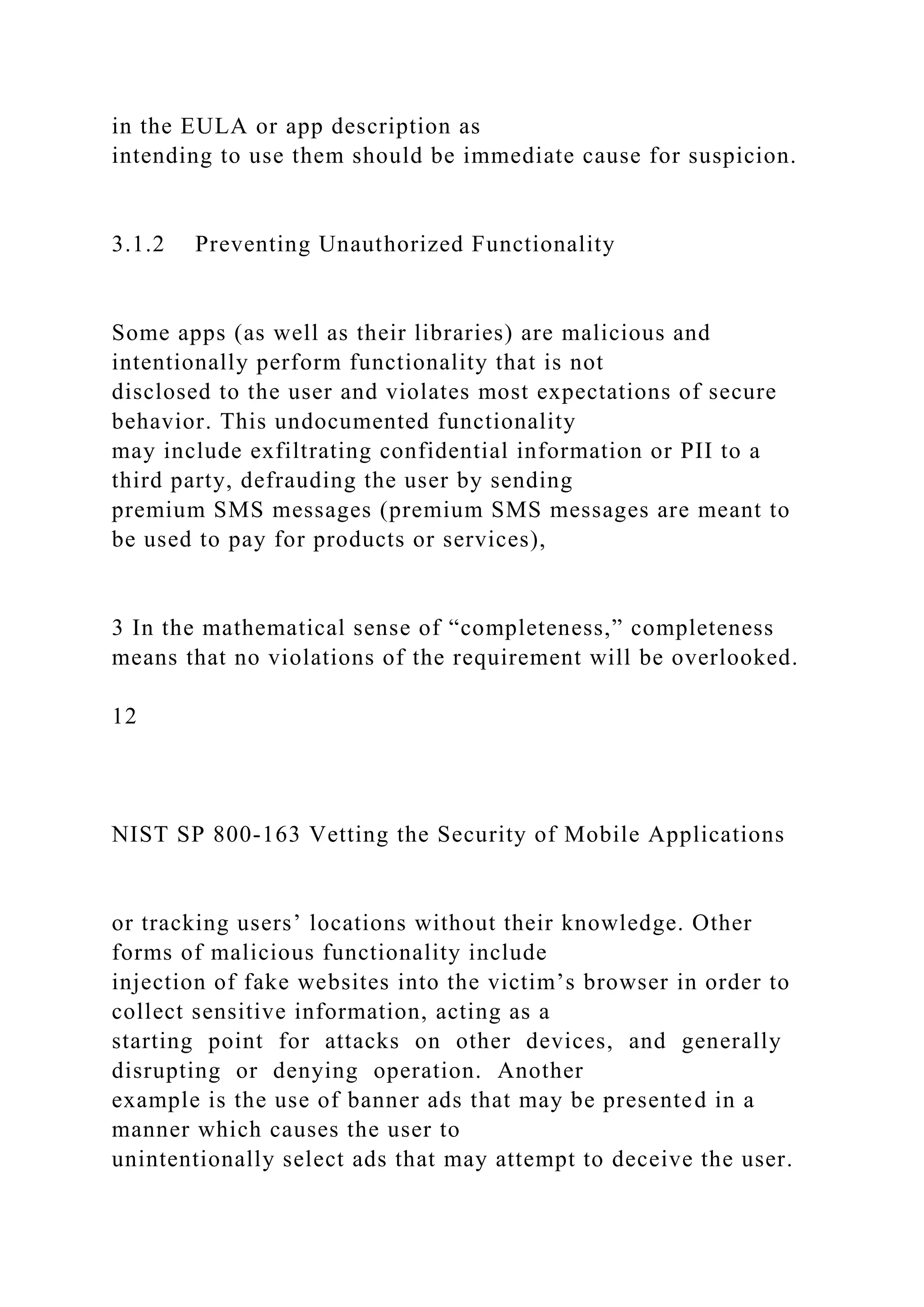
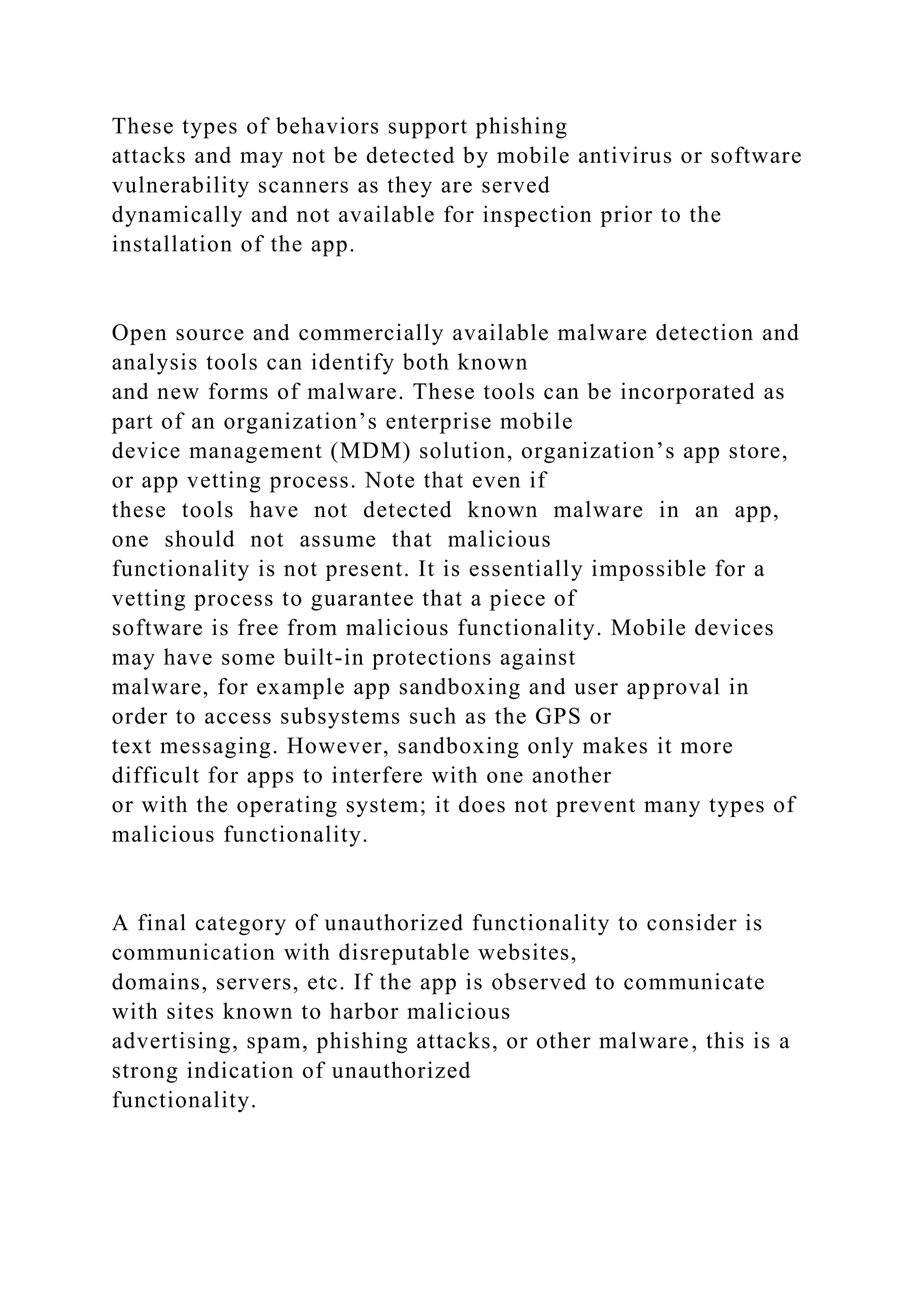
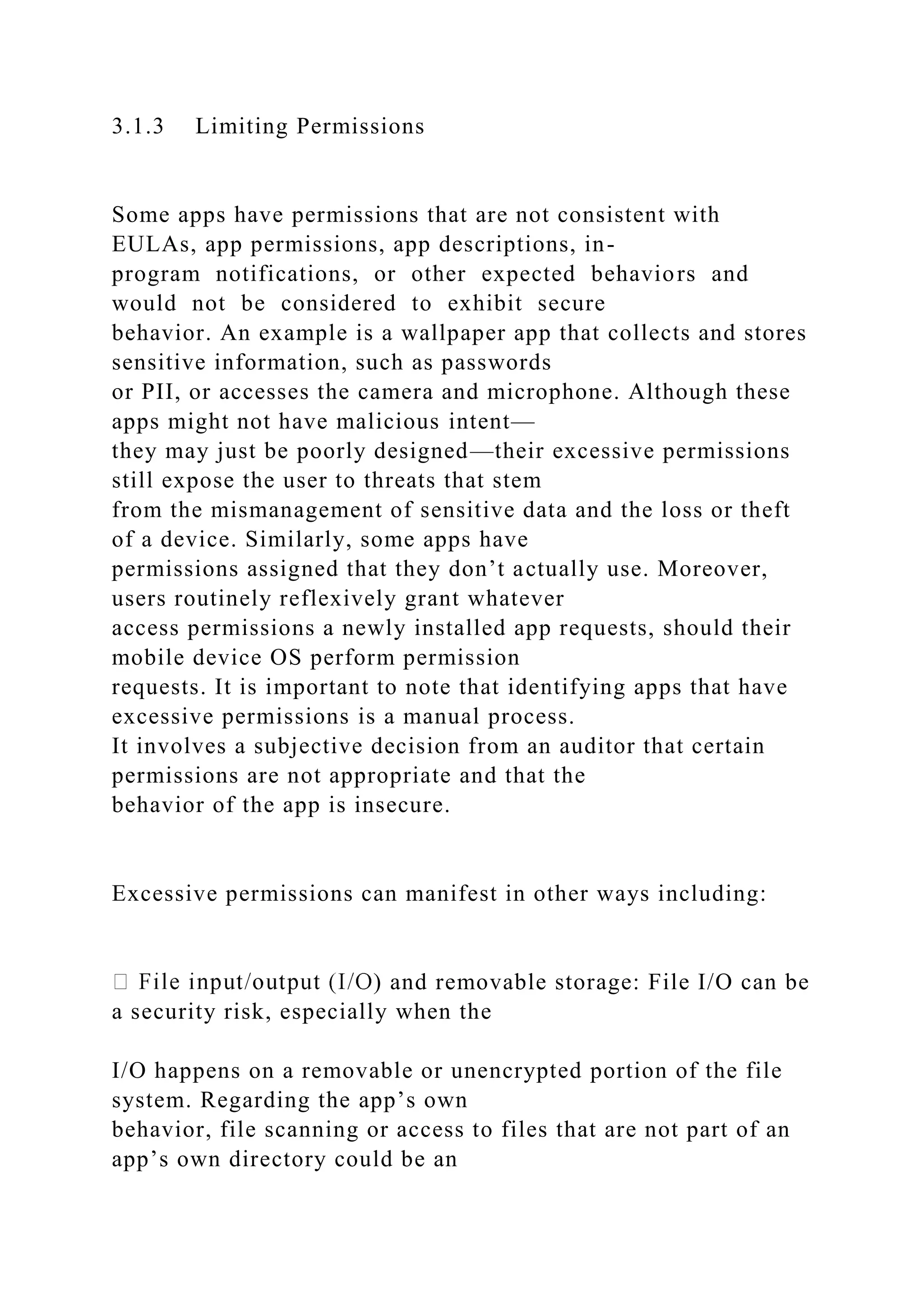
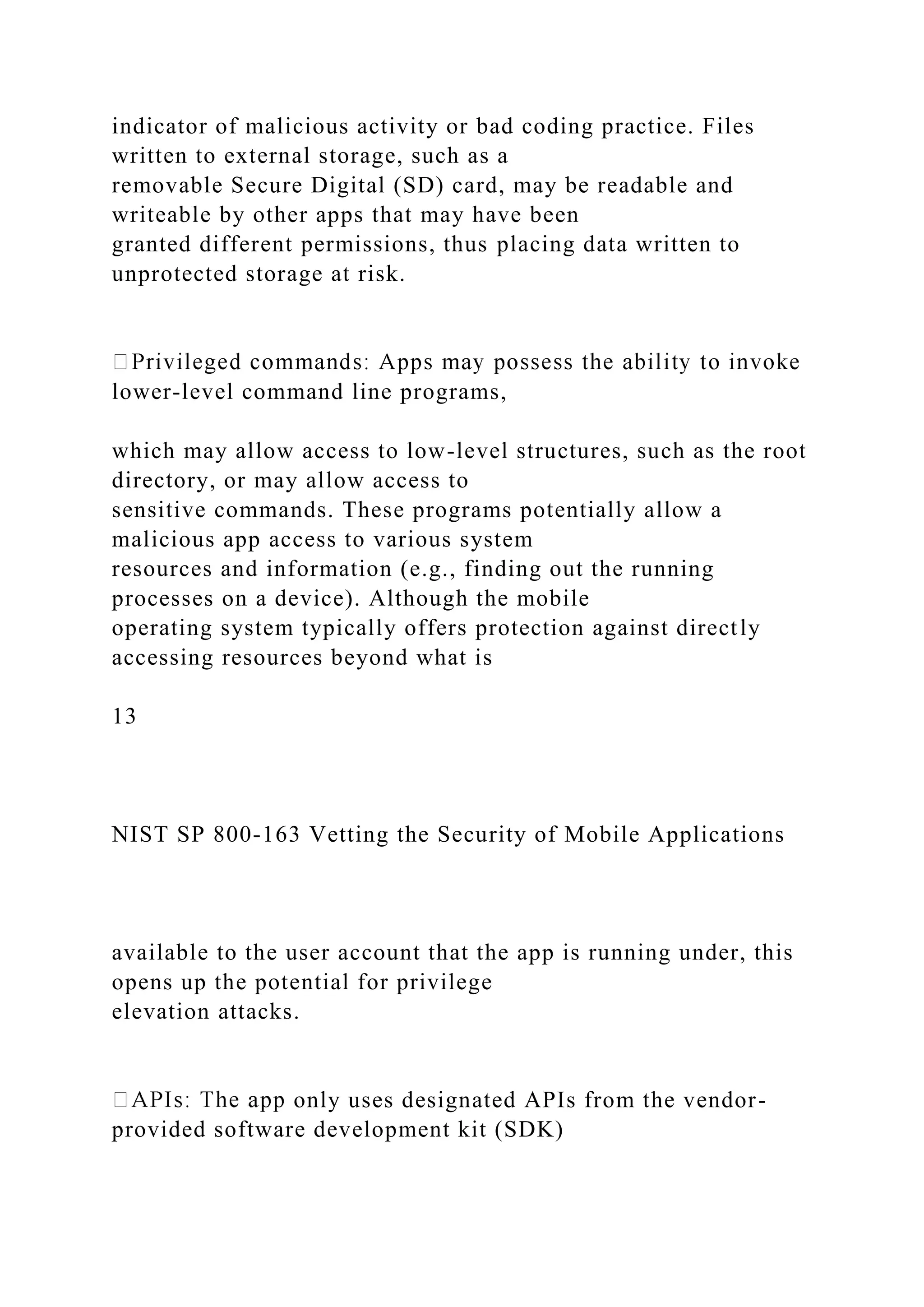
![and uses them properly; no other API calls are permitted.4 For
the permitted APIs, the analyzer
should note where the APIs are transferring data to and from the
app.
3.1.4 Protecting Sensitive Data
Many apps collect, store, and/or transmit sensitive data, such as
financial data (e.g., credit card numbers),
personal data (e.g., social security numbers), and login
credentials (e.g., passwords). When implemented
and used properly, cryptography can help maintain the
confidentiality and integrity of this data, even if a
protected mobile device is lost or stolen and falls into an
attacker’s hands. However, only certain
cryptographic implementations have been shown to be
sufficiently strong, and developers who create
their own implementations typically expose their apps to
exploitation through man-in-the-middle attacks
and other forms.
Federal Information Processing Standard (FIPS) 140-2
precludes the use of unvalidated cryptography for
the cryptographic protection of sensitive data within federal
systems. Unvalidated cryptography is viewed
by NIST as providing no protection to the data. A list of FIPS
140-2-validated cryptographic modules and
an explanation of the applicability of the Cryptographic Module
Validation Program (CMVP) can be
found on the CMVP website [20]. Analyzers should reference
the CMVP-provided information to
determine if each app is using properly validated cryptographic
modules and approved implementations](https://image.slidesharecdn.com/1-221101035239-dffccca1/75/1-Security-and-vulnerability-assessment-analysis-tool-Microsoft-docx-102-2048.jpg)
![of those modules.
It is not sufficient to use appropriate cryptographic
algorithms and modules; cryptography
implementations must also be maintained in accordance with
approved practices. Cryptographic key
management is often performed improperly, leading to
exploitable weaknesses. For example, the presence
of hard-coded cryptographic keying material such as keys,
initialization vectors, etc. is an indication that
cryptography has not been properly implemented by an app and
might be exploited by an attacker to
compromise data or network resources. Guidelines for proper
key management techniques can be found
in [21]. Another example of a common cryptographic
implementation problem is the failure to properly
validate digital certificates, leaving communications protected
by these certificates subject to man-in-the-
middle attacks.
Privacy considerations need to be taken into account for apps
that handle PII, including mobile-specific
personal information like location data and pictures taken by
onboard cameras, as well as the broadcast
ID of the device. This needs to be dealt with in the UI as well as
in the portions of the apps that
manipulate this data. For example, an analyzer can verify that
the app complies with privacy standards by
masking characters of any sensitive data within the page
display, but audit logs should also be reviewed
when possible for appropriate handling of this type of
information. Another important privacy
consideration is that sensitive data should not be disclosed
without prior notification to the user by a](https://image.slidesharecdn.com/1-221101035239-dffccca1/75/1-Security-and-vulnerability-assessment-analysis-tool-Microsoft-docx-103-2048.jpg)
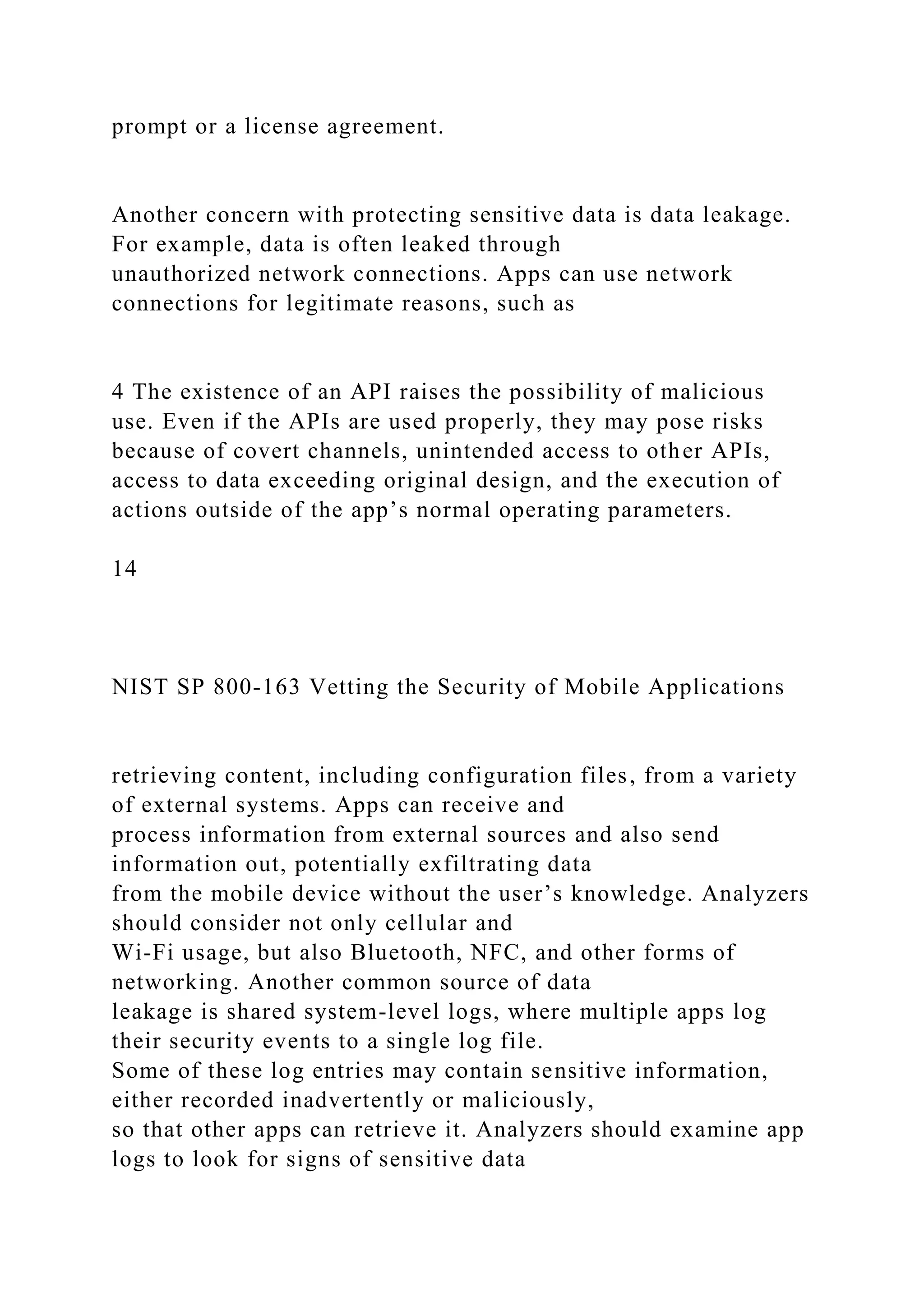

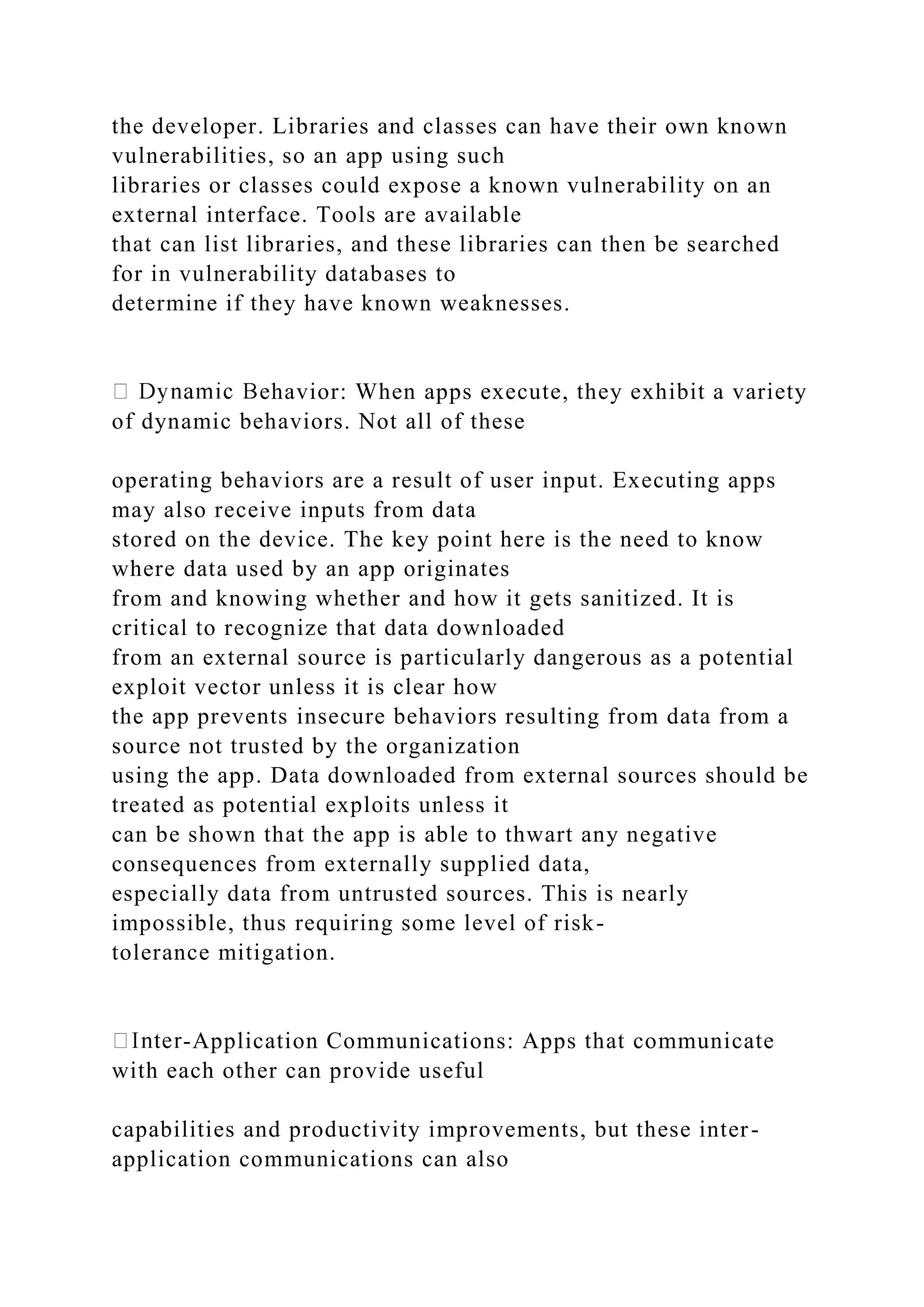
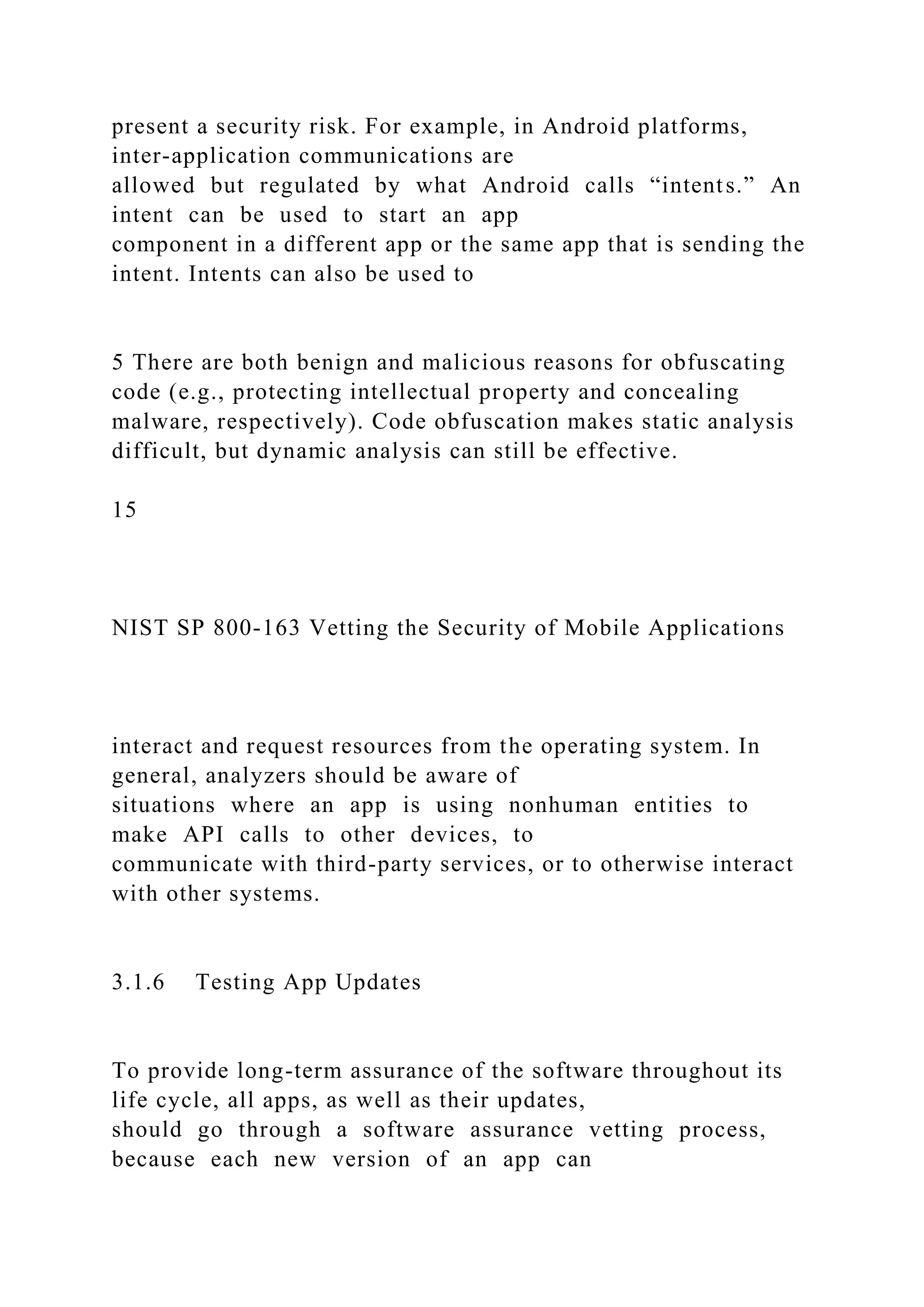

![To detect the satisfaction or violation of a general requirement,
an analyzer tests an app for the presence
of software vulnerabilities. Such testing may involve (1)
correctness testing, (2) analysis of the app's
source code or binary code, (3) the use of static or dynamic
analysis, and (4) manual or automatic testing
of the app.
3.2.1 Correctness Testing
One approach for testing an app is software correctness testing
[22]. Software correctness testing is the
process of executing a program with the intent of finding errors.
Although software correctness testing is
aimed primarily at improving quality assurance, verifying and
validating described functionality, or
estimating reliability, it can also help to reveal potential
security vulnerabilities since such vulnerabilities
often have a negative effect on the quality, functionality, and
reliability of the software. For example,
software that crashes or exhibits unexpected behavior is often
indicative of a security flaw. One of the
advantages of software correctness testing is that it is
traditionally based on specifications of the specific
software to be tested. These specifications can then be
transformed into requirements that specify how the
software is expected to behave under test. This is distinguished
from security assessment approaches that
often require the tester to derive requirements themselves; often
such requirements are largely based on
security requirements that are considered to be common across
many different software artifacts and may
not test for vulnerabilities that are unique to the software under
test. Nonetheless, because of the tight](https://image.slidesharecdn.com/1-221101035239-dffccca1/75/1-Security-and-vulnerability-assessment-analysis-tool-Microsoft-docx-109-2048.jpg)
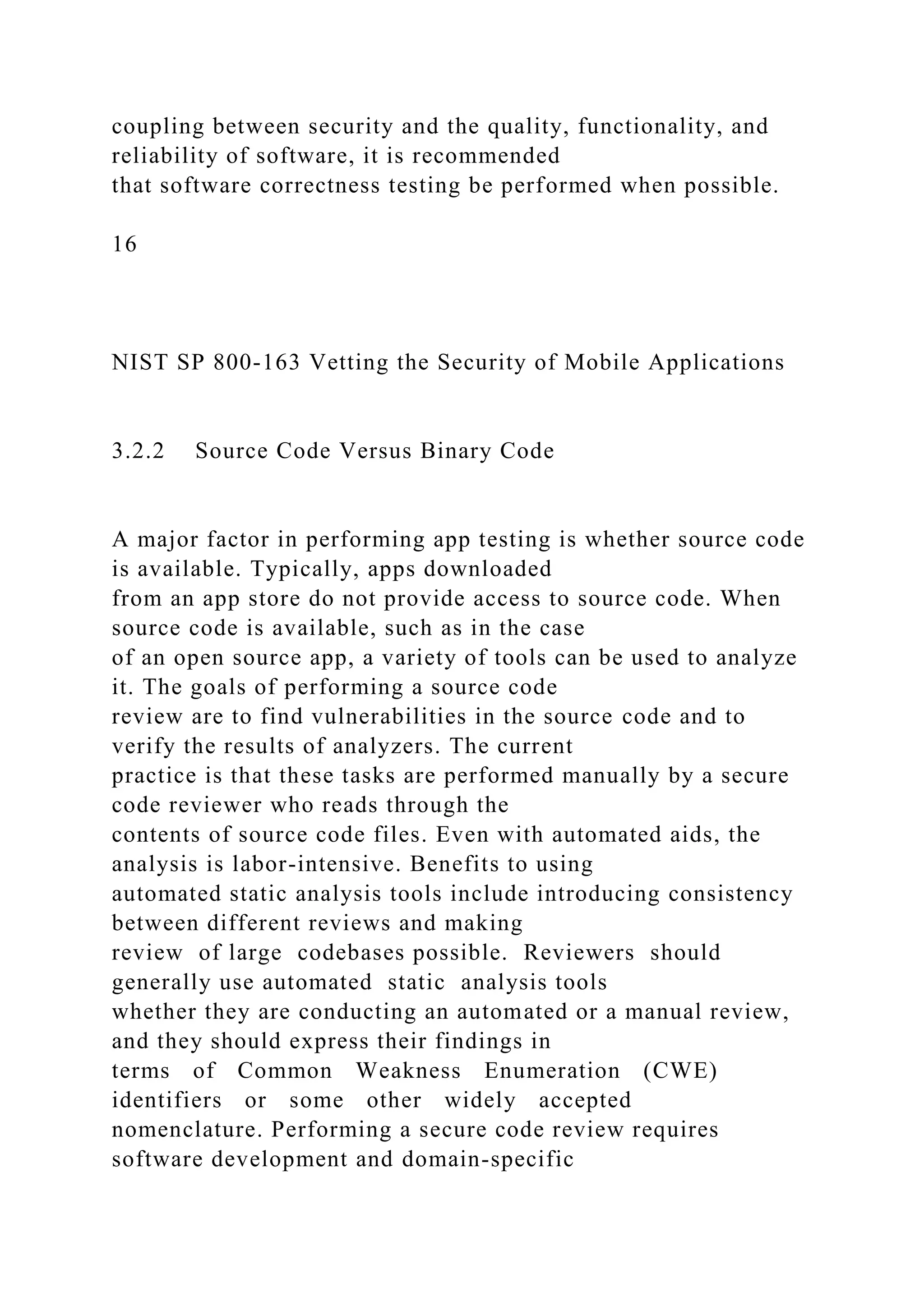
![knowledge in the area of application security. Organizations
should ensure that the individuals performing
source code reviews have the necessary skills and expertise.
Note that organizations that intend to develop
apps in-house should also refer to guidance on secure
programming techniques and software quality
assurance processes to appropriately address the entire software
development life cycle [11, 23].
When source code is not available, binary code can be vetted
instead. In the context of apps, the term
“binary code” can refer to either byte-code or machine code.
For example, Android apps are compiled to
byte-code that is executed on a virtual machine, similar to the
Java Virtual Machine (JVM), but they can
also come with custom libraries that are provided in the form of
machine code, that is, code executed
directly on the mobile device's CPU. Android binary apps
include byte-code that can be analyzed without
hardware support using emulated and virtual environments.
3.2.3 Static Versus Dynamic Analysis
Analysis tools are often characterized as being either static or
dynamic.6 Static analysis examines the app
source code and binary code, and attempts to reason over all
possible behaviors that might arise at
runtime. It provides a level of assurance that analysis results are
an accurate description of the program’s
behavior regardless of the input or execution environment.
Dynamic analysis operates by executing a
program using a set of input use cases and analyzing the
program’s runtime behavior. In some cases, the](https://image.slidesharecdn.com/1-221101035239-dffccca1/75/1-Security-and-vulnerability-assessment-analysis-tool-Microsoft-docx-111-2048.jpg)
![enumeration of input test cases is large, resulting in lengthy
processing times. However, methods such as
combinatorial testing can reduce the number of dynamic input
test case combinations, reducing the
amount of time needed to derive analysis results [25]. Still,
dynamic analysis is unlikely to provide 100
percent code coverage [26]. Organizations should consider the
technical trade-off differences between
what static and dynamic tools offer and balance their usage
given the organization’s software assurance
goals.
Static analysis requires that binary code be reverse engineered
when source is not available, which is
relatively easy for byte-code,7 but can be difficult for machine
code. Many commercial static analysis
tools already support byte-code, as do a number of open source
and academic tools.8 For machine code, it
is especially hard to track the flow of control across many
functions and to track data flow through
6 For mobile devices, there are analysis tools that label
themselves as performing behavioral testing. Behavioral testing
(also
known as behavioral analysis) is a form of static and dynamic
testing that attempts to detect malicious or risky behavior,
such as the oft-cited example of a flashlight app that accesses a
contact list. [24] This publication assumes that any mention
of static or dynamic testing also includes behavioral testing as a
subset of its capabilities.
7 The ASM framework [27] is a commonly used framework for
byte-code analysis.
8 Such as [28, 29, 30, 31].](https://image.slidesharecdn.com/1-221101035239-dffccca1/75/1-Security-and-vulnerability-assessment-analysis-tool-Microsoft-docx-112-2048.jpg)
![17
NIST SP 800-163 Vetting the Security of Mobile Applications
variables, since most variables are stored in anonymous
memory locations that can be accessed in
different ways. The most common way to reverse engineer
machine code is to use a disassembler or a
decompiler that tries to recover the original source code. These
techniques are especially useful if the
purpose of reverse engineering is to allow humans to examine
the code, since the outputs are in a form
that can be understood by humans with appropriate skills. But
even the best disassemblers make mistakes
[32], and some of those mistakes can be corrected with formal
static analysis. If the code is being reverse
engineered for static analysis, then it is often preferable to
disassemble the machine code directly to a
form that the static analyzer understands rather than creating
human-readable code as an intermediate
byproduct. A static analysis tool that is aimed at machine code
is likely to automate this process.
For dynamic testing (as opposed to static analysis), the most
important requirement is to be able to see the
workings of the code as it is being executed. There are two
primary ways to obtain this information. First,
an executing app can be connected to a remote debugger, and
second, the code can be run on an emulator
that has debugging capabilities built into it. Running the code
on a physical device allows the analyzer to](https://image.slidesharecdn.com/1-221101035239-dffccca1/75/1-Security-and-vulnerability-assessment-analysis-tool-Microsoft-docx-113-2048.jpg)
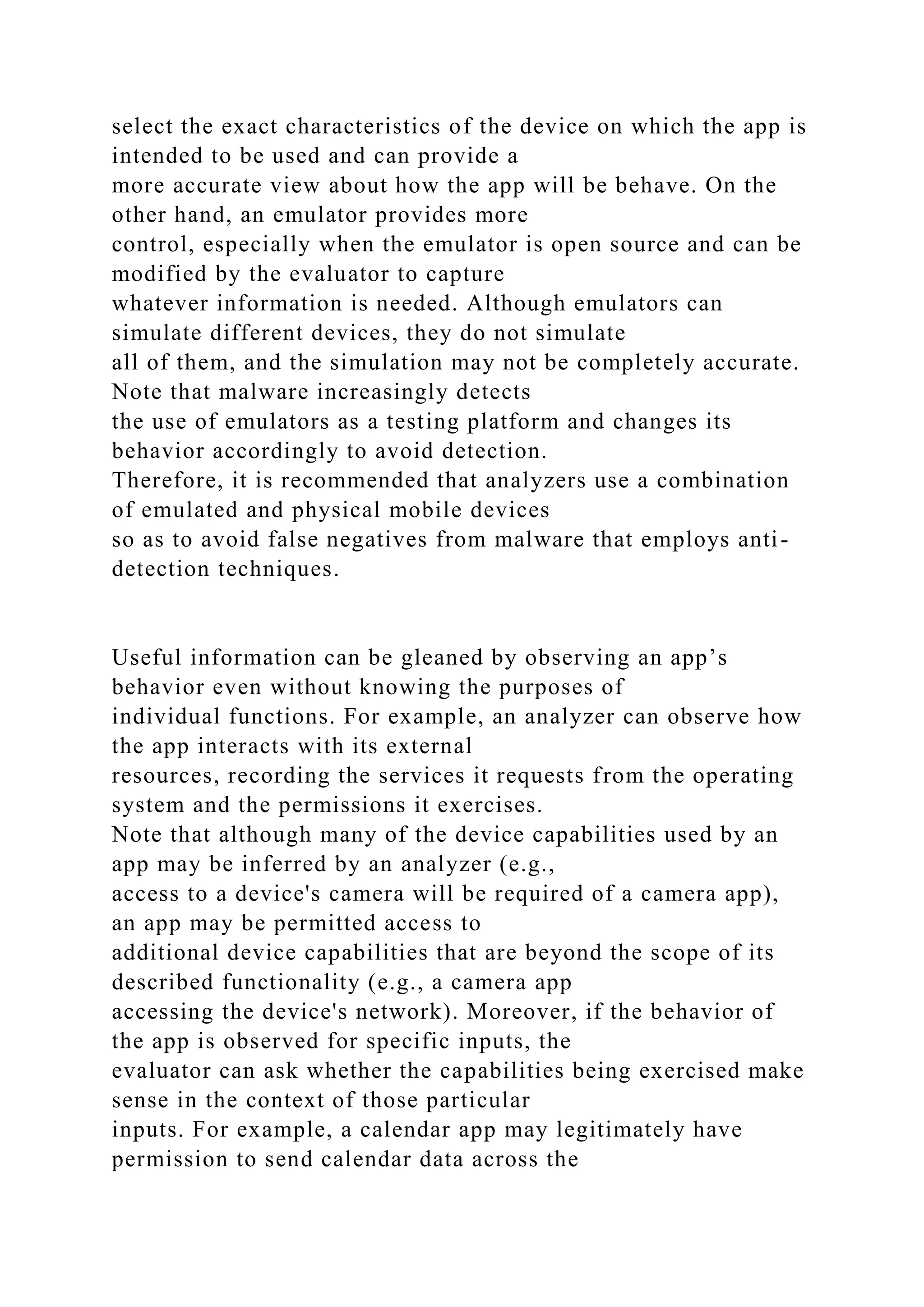
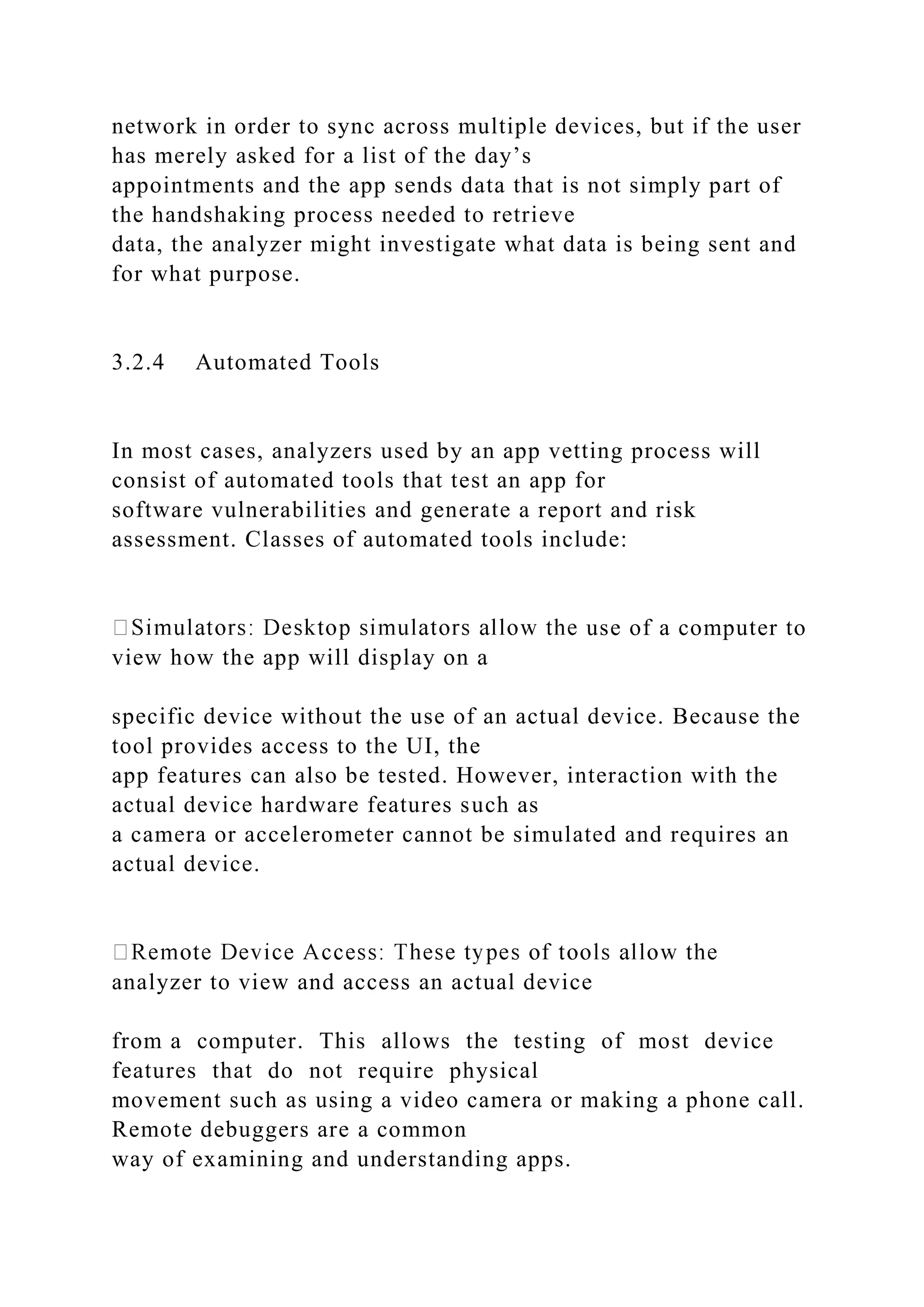

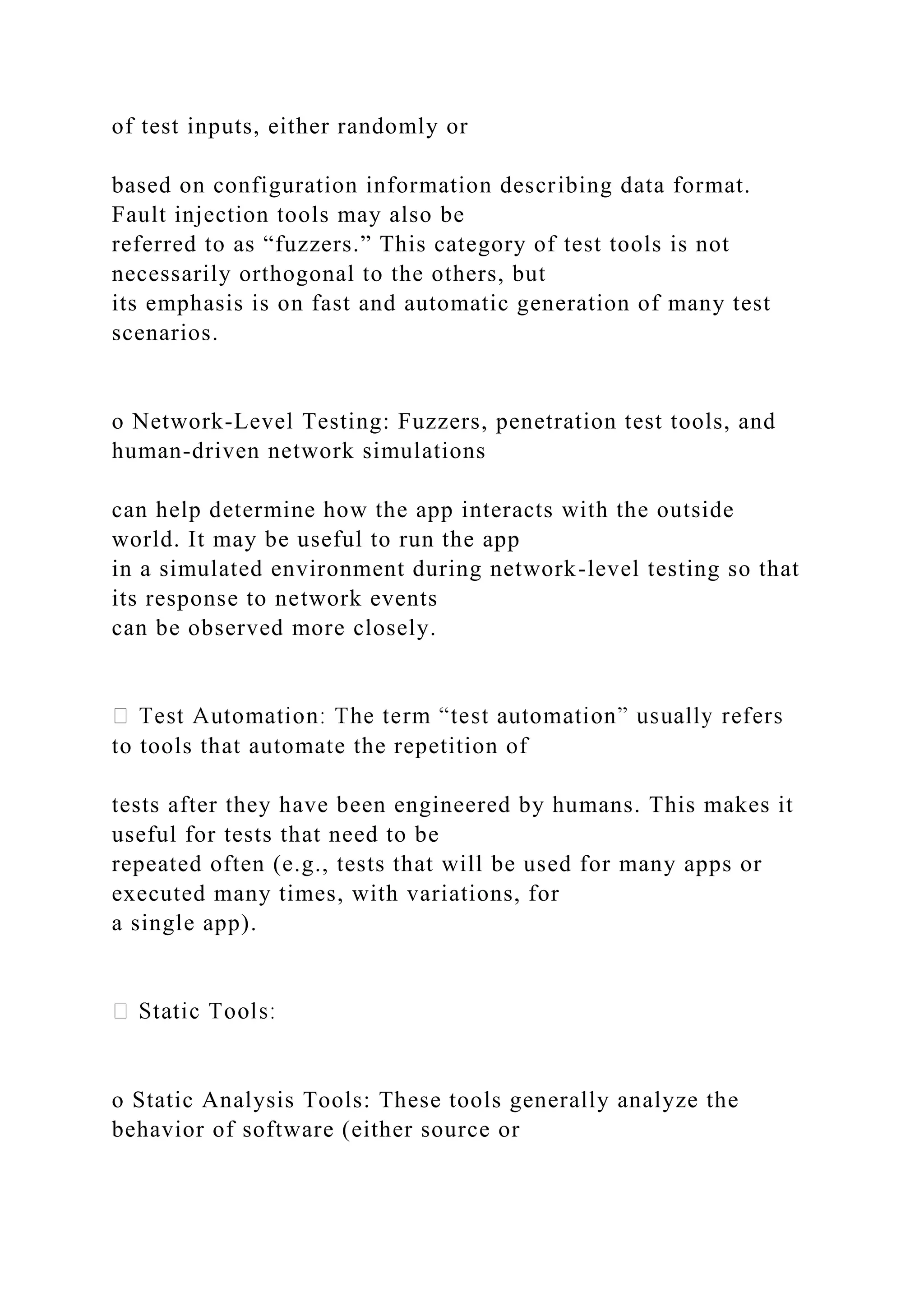
![binary code) to find software vulnerabilities, though—if
appropriate specifications are available—
static analysis can also be used to evaluate correctness. Some
static analysis tools operate by
looking for syntax embodying a known class of potential
vulnerabilities and then analyzing the
behavior of the program to determine whether the weaknesses
can be exploited. Static tools
should encompass the app itself, but also the data it uses to the
extent that this is possible; keep in
mind that the true behavior of the app may depend critically on
external resources. 9
o Metrics Tools: These tools measure aspects of software not
directly related to software behavior
but useful in estimating auxiliary information such as the effort
of code evaluation. Metrics can
also give indirect indications about the quality of the design and
development process.
Commercial automated app testing tools have overlapping or
complementary capabilities. For example,
one tool may be based on techniques that find integer overflows
[34] reliably while another tool may be
better at finding weaknesses related to command injection
attacks [35]. Finding the right set of tools to
evaluate a requirement can be a challenging task because of the
varied capabilities of diverse commercial
9 The Software Assurance Metrics and Tool Evaluation
(SAMATE) test suite [33] provides a baseline for evaluating
static](https://image.slidesharecdn.com/1-221101035239-dffccca1/75/1-Security-and-vulnerability-assessment-analysis-tool-Microsoft-docx-118-2048.jpg)
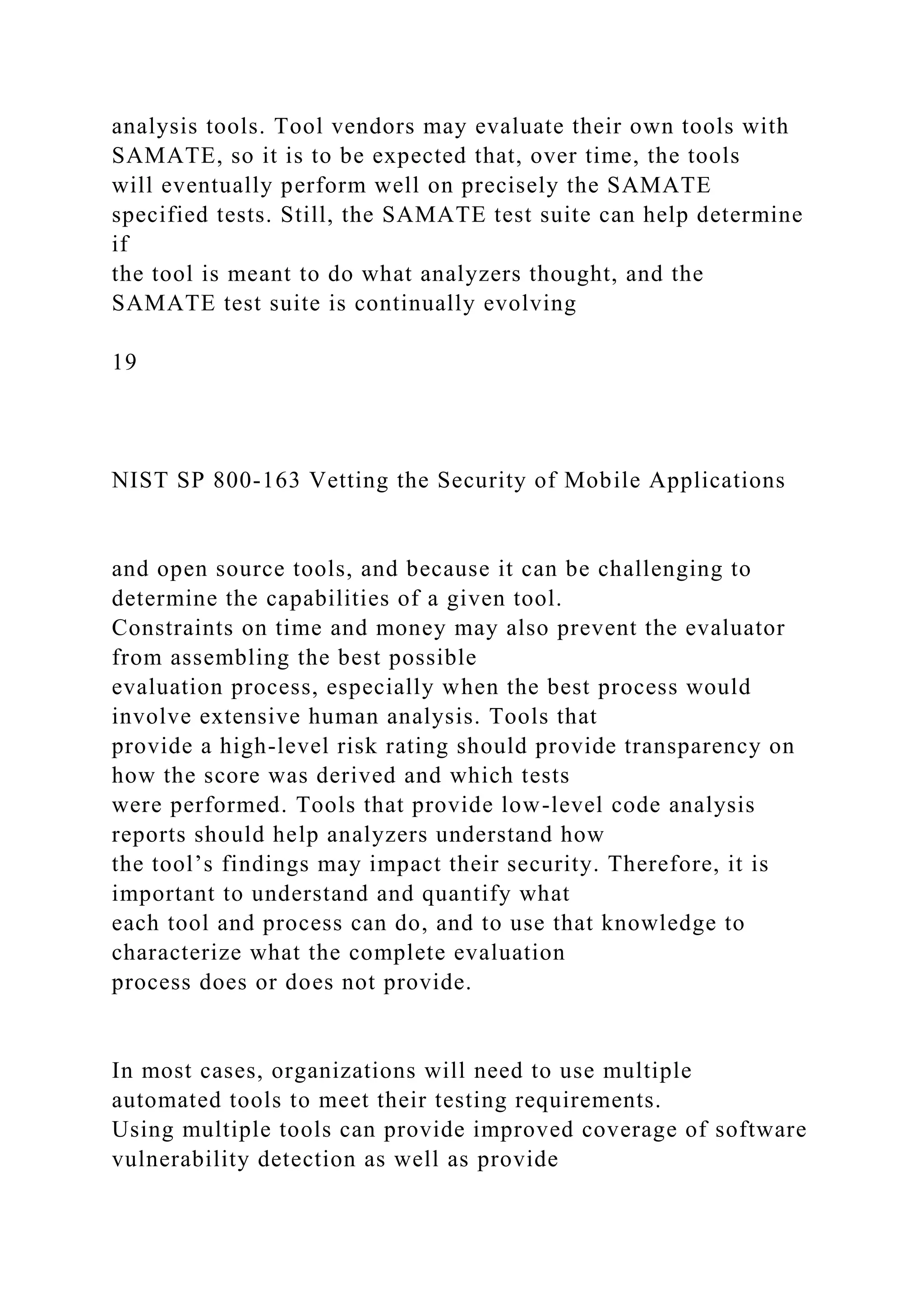
![validation of test results for those tools that provide
overlapping tests (i.e., if two or more tools test for the
same vulnerability).
3.3 Sharing Results
The sharing of an organization's findings for an app can greatly
reduce the duplication and cost of app
vetting efforts for other organizations. Information sharing
within the software assurance community is
vital and can help analyzers benefit from the collective efforts
of security professionals around the world.
The National Vulnerability Database (NVD) [36] is the U.S.
government repository of standards-based
vulnerability management data represented using the Security
Content Automation Protocol (SCAP) [37].
This data enables automation of vulnerability management,
security measurement, and compliance. The
NVD includes databases of security checklists, security-
related software flaws, misconfigurations,
product names, and impact metrics. SCAP is a suite of
specifications that standardize the format and
nomenclature by which security software products communicate
software flaw and security configuration
information. SCAP is a multipurpose protocol that supports
automated vulnerability checking, technical
control compliance activities, and security measurement. Goals
for the development of SCAP include
standardizing system security management, promoting
interoperability of security products, and fostering
the use of standard expressions of security content. The CWE
[38] and Common Attack Pattern
Enumeration and Classification (CAPEC) [39] collections can
provide a useful list of weaknesses and](https://image.slidesharecdn.com/1-221101035239-dffccca1/75/1-Security-and-vulnerability-assessment-analysis-tool-Microsoft-docx-120-2048.jpg)
![attack approaches to drive a binary or live system penetration
test. Classifying and expressing software
vulnerabilities is an ongoing and developing effort in the
software assurance community, as is how to
prioritize among the various weaknesses that can be in an app
[40] so that an organization can know that
those that pose the most danger to the app, given its intended
use/mission, are addressed by the vetting
activity given the difference in the effectiveness and
coverage of the various available tools and
techniques.
20
NIST SP 800-163 Vetting the Security of Mobile Applications
4 App Approval/Rejection
After an app has been tested by an analyzer, the analyzer
generates a report that identifies detected
software vulnerabilities and a risk assessment that expresses the
estimated level of risk associated with
using the app. The report and risk assessment are then made
available to one or more auditors of the
organization. In this section, we describe issues surrounding the
auditing of report and risk assessments
by an auditor, the organization-specific vetting criteria used by
auditors to determine if an app meets the
organization’s context-sensitive requirements, and issues
surrounding the final decision by an approver to
approve or reject an app. Recommendations related to the app
approval/rejection activity are described in](https://image.slidesharecdn.com/1-221101035239-dffccca1/75/1-Security-and-vulnerability-assessment-analysis-tool-Microsoft-docx-121-2048.jpg)
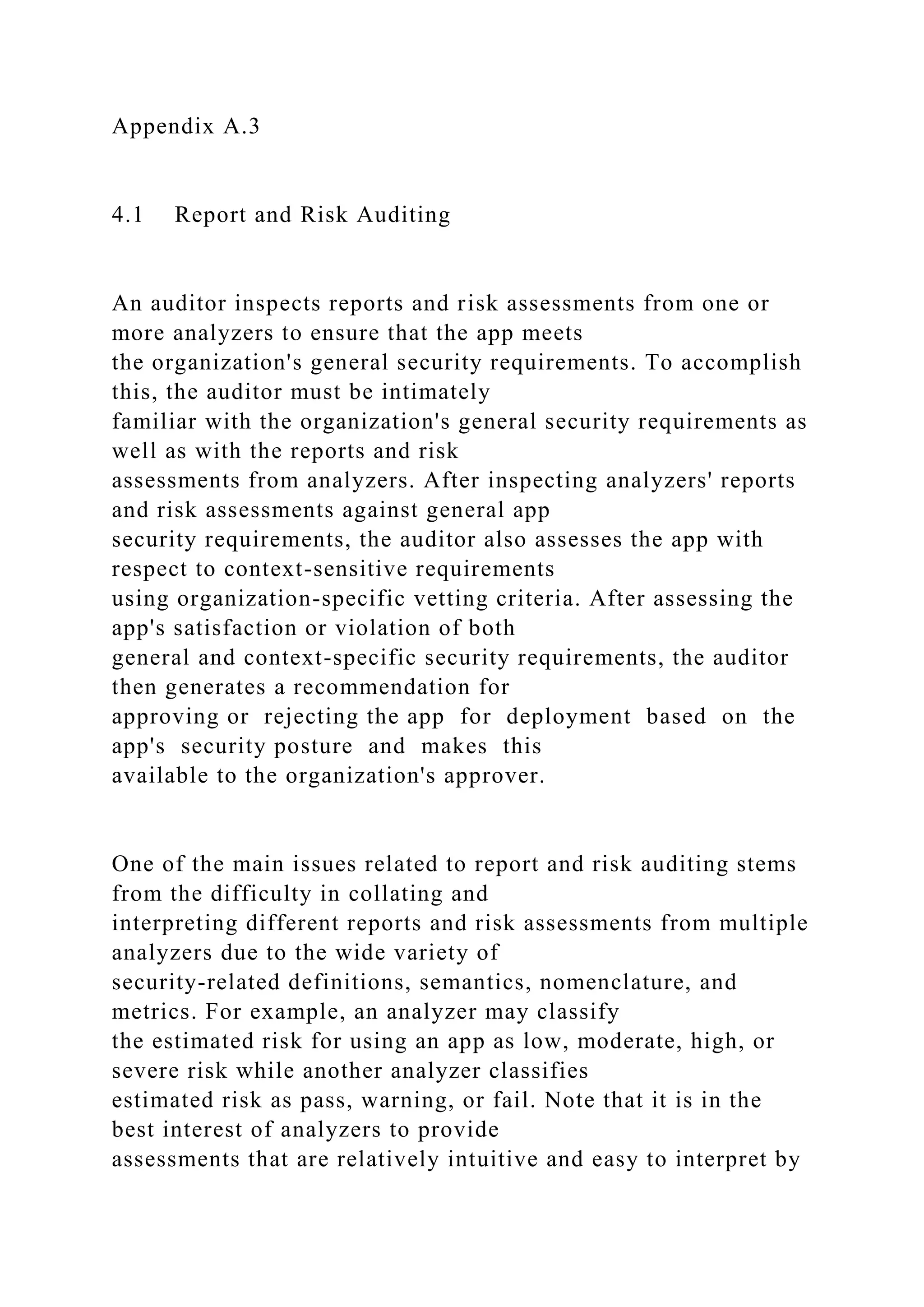
![auditors. Otherwise, organizations will
likely select other analyzers that generate reports and
assessments that their auditors can understand.
While some standards exist for expressing risk assessment (e.g.,
the Common Vulnerability Scoring
System [41]) and vulnerability reports (e.g., Common
Vulnerability Reporting Framework [42]), the
current adoption of these standards by analyzers is low. To
address this issue, it is recommended that an
organization identify analyzers that leverage vulnerability
reporting and risk assessment standards. If this
is not possible, it is recommended that the organization provide
sufficient training to auditors on both the
security requirements of the organization as well as the
interpretation of reports and risk assessments
generated by analyzers.
The methods used by an auditor to derive a recommendation for
approving or rejecting an app is based on
a number of factors including the auditor's confidence in the
analyzers' assessments and the perceived
level of risk from one or more risk assessments as well as the
auditor's understanding of the organization's
risk threshold, the organization's general and context-sensitive
security requirements, and the reports and
risk assessments from analyzers. In some cases, an organization
will not have any context-sensitive
requirements and thus, auditors will evaluate the security
posture of the app based solely on reports and
risk assessments from analyzers. In such cases, if risk
assessments from all analyzers indicate a low
security risk associated with using an app, an auditor may
adequately justify the approval of the app based
on those risk assessments (assuming that the auditor has
confidence in the analyzers' assessments).](https://image.slidesharecdn.com/1-221101035239-dffccca1/75/1-Security-and-vulnerability-assessment-analysis-tool-Microsoft-docx-123-2048.jpg)
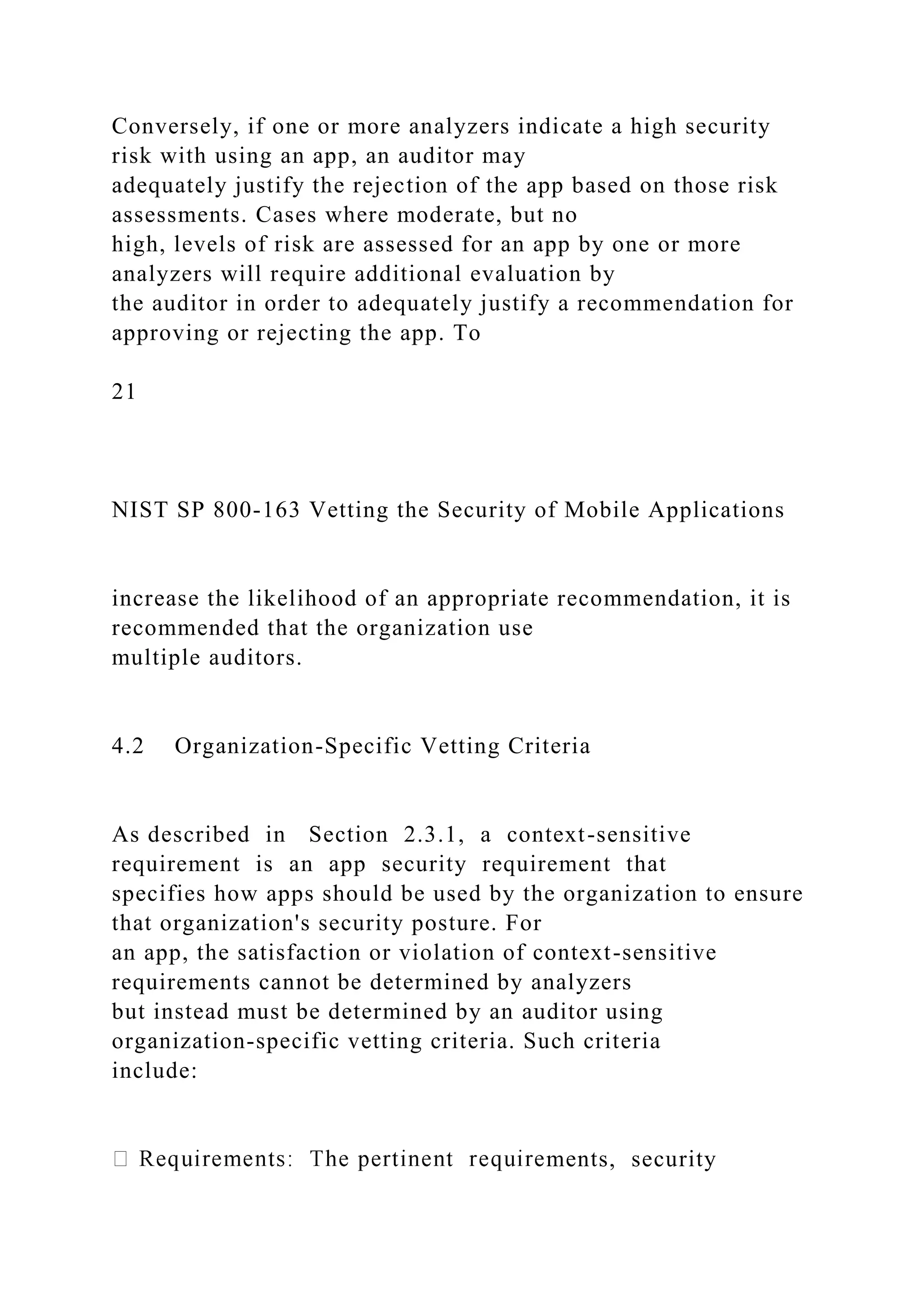
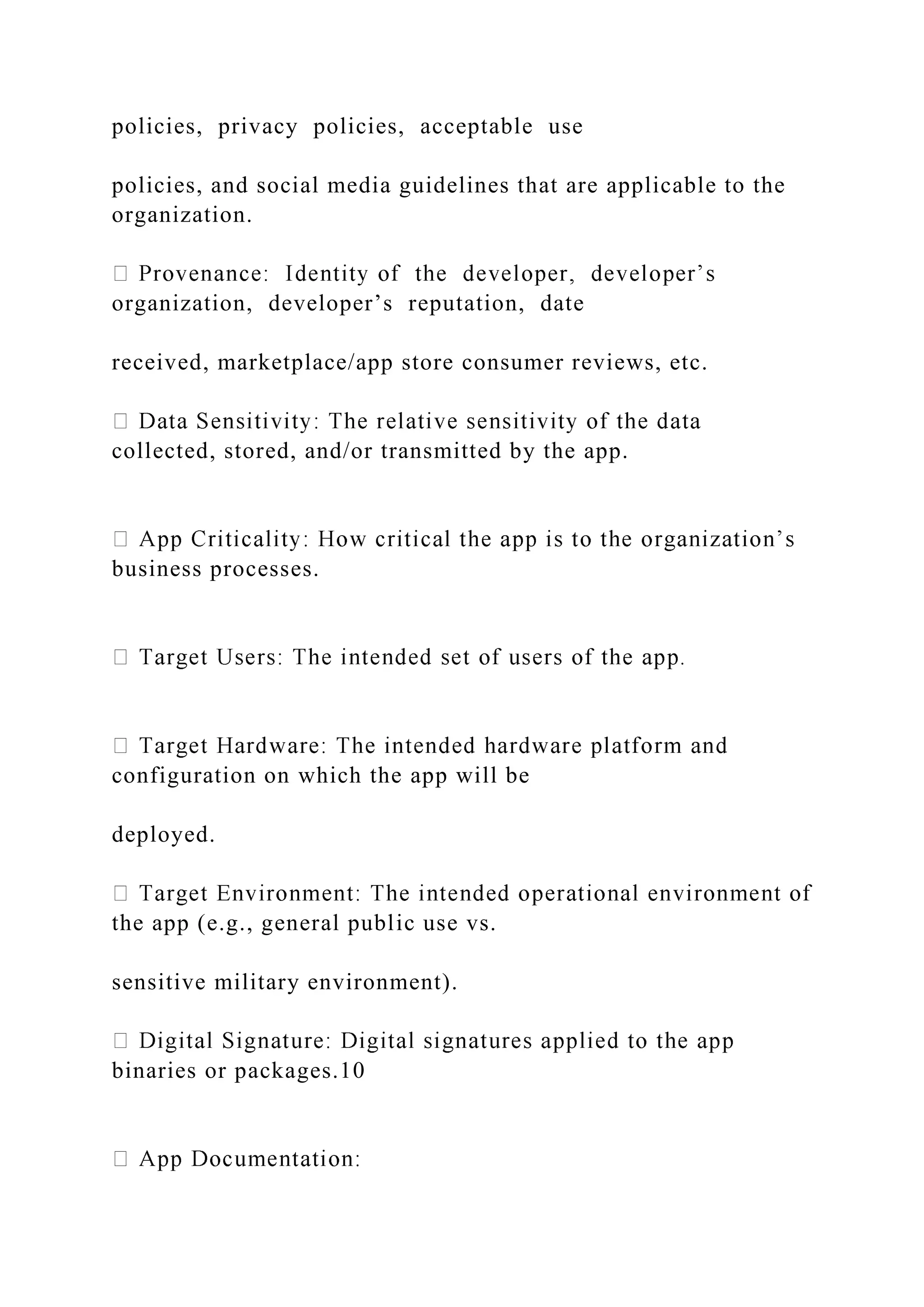
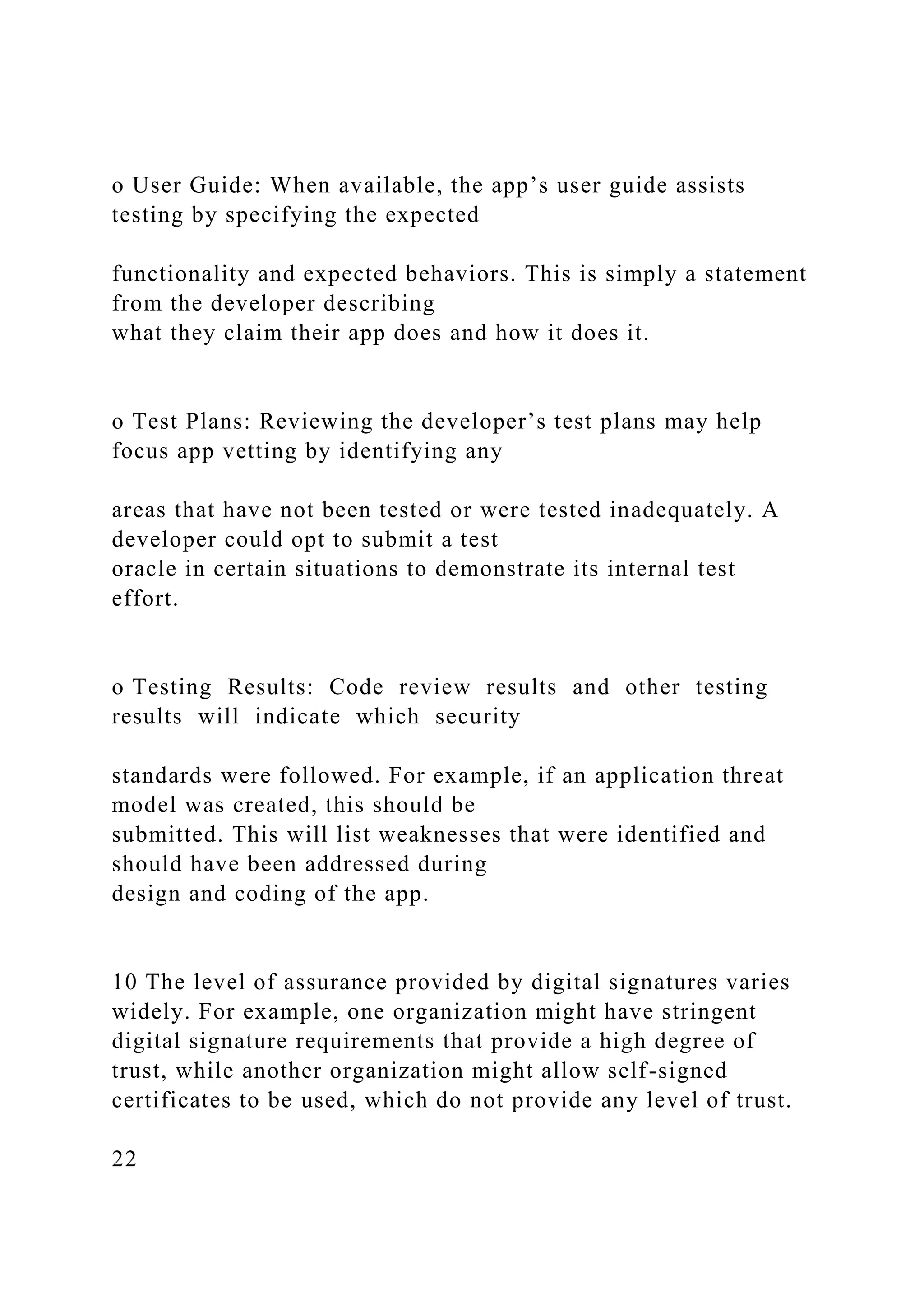
![NIST SP 800-163 Vetting the Security of Mobile Applications
o Service-Level Agreement: If an app was developed for an
organization by a third party, a
Service-Level Agreement (SLA) may have been included as part
of the vendor contract. This
contract should require the app to be compatible with the
organization’s security policy.
Some information can be gleaned from app documentation in
some cases, but even if documentation does
exist, it might lack technical clarity and/or use jargon specific
to the circle of users who would normally
purchase the app. Since the documentation for different apps
will be structured in different ways, it may
also be time-consuming to find the information for evaluation.
Therefore, a standardized questionnaire
might be appropriate for determining the software’s purpose and
assessing an app developer’s efforts to
address security weaknesses. Such questionnaires aim to
identify software quality issues and security
weaknesses by helping developers address questions from end
users/adopters about their software
development processes. For example, developers can use the
Department of Homeland Security (DHS)
Custom Software Questionnaire [43] to answer questions such
as Does your software validate inputs from
untrusted resources? and What threat assumptions were made
when designing protections for your
software? Another useful question (not included in the DHS](https://image.slidesharecdn.com/1-221101035239-dffccca1/75/1-Security-and-vulnerability-assessment-analysis-tool-Microsoft-docx-127-2048.jpg)

![non-security-related criteria including budgetary, policy, and
mission-specific criteria to render the
organization’s official decision to approve or reject the app.
After this decision is made, the organization
should then follow procedures for handling the approval or
rejection of the app. These procedures must be
specified by the organization prior to implementing an app
vetting process. If an app is approved,
procedures must be defined that specify how the approved app
should be processed and ultimately
deployed onto the organization's devices. For example, a
procedure may specify the steps needed to
digitally sign an app before being submitted to the administrator
for deployment onto the organization's
devices. Similarly, if an app is rejected, a procedure may
specify the steps needed to identify an
alternative app or to resolve detected vulnerabilities with the
app developer. Procedures that define the
steps associated with approving or rejecting an app should be
included in the organization's app security
policies.
11 Vulnerability databases generally reference vulnerabilities
by their Common Vulnerabilities and Exposures (CVE)
identifier. For more information on CVE, see [44].
23
NIST SP 800-163 Vetting the Security of Mobile Applications
Appendix A—Recommendations](https://image.slidesharecdn.com/1-221101035239-dffccca1/75/1-Security-and-vulnerability-assessment-analysis-tool-Microsoft-docx-129-2048.jpg)

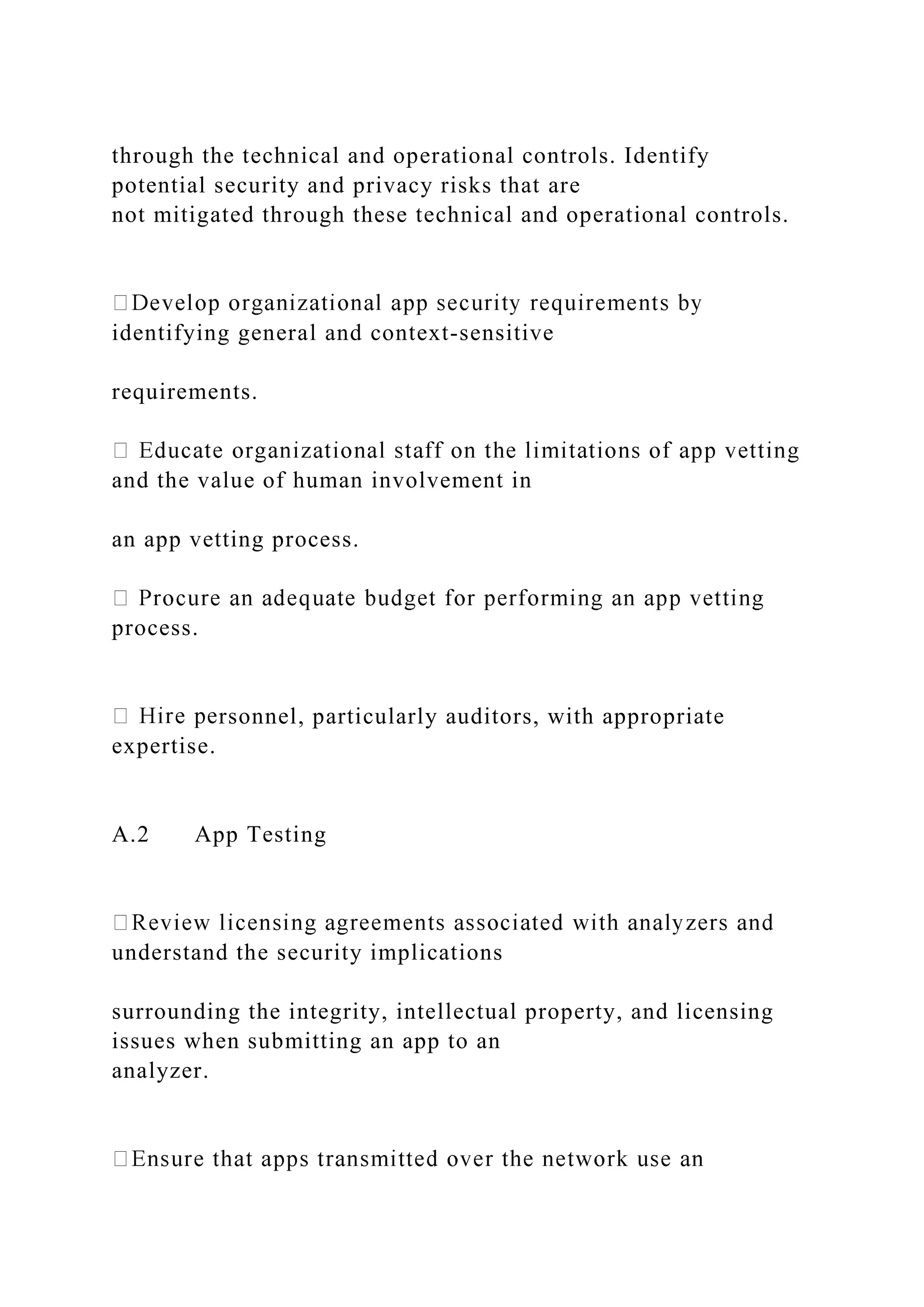

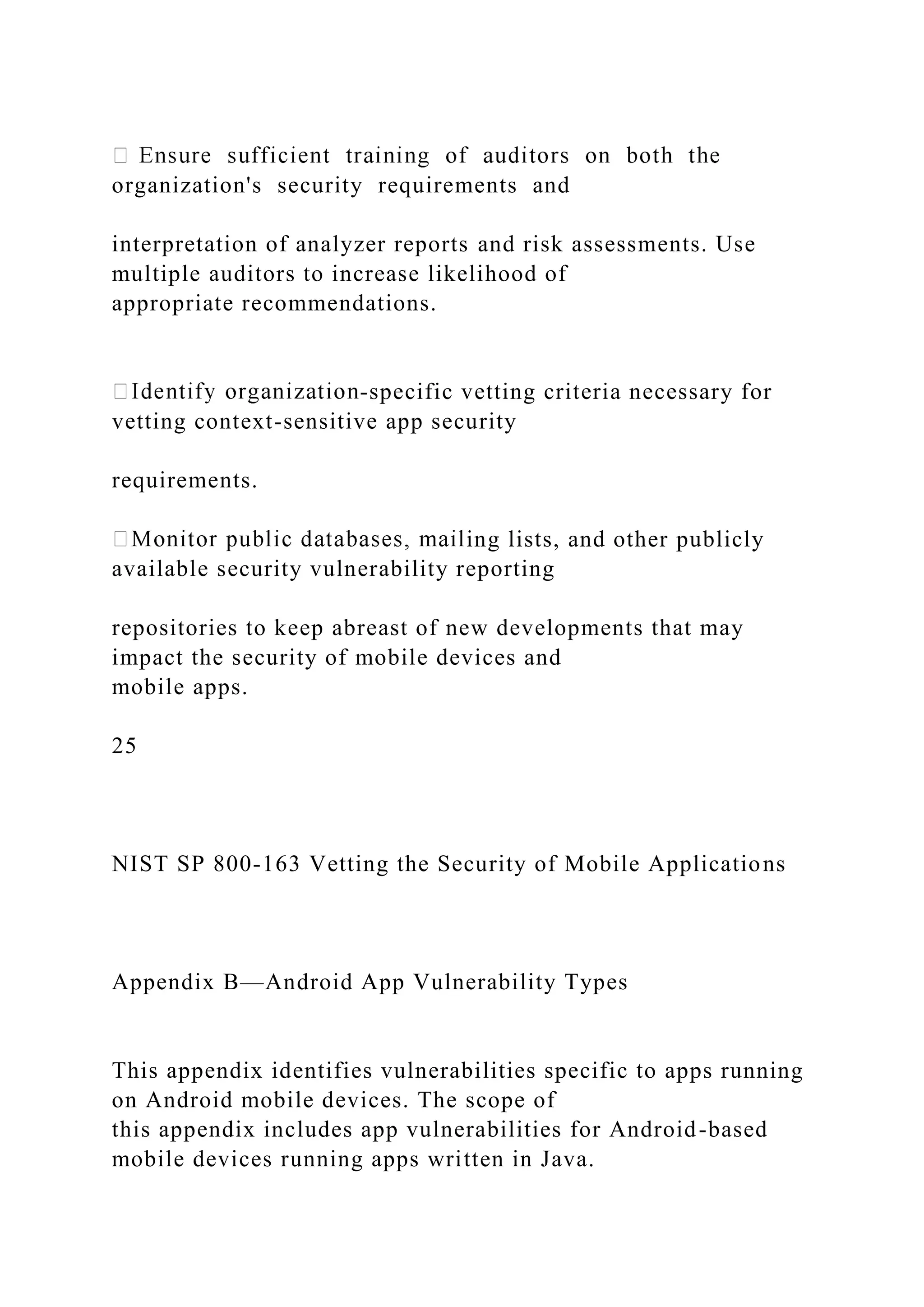
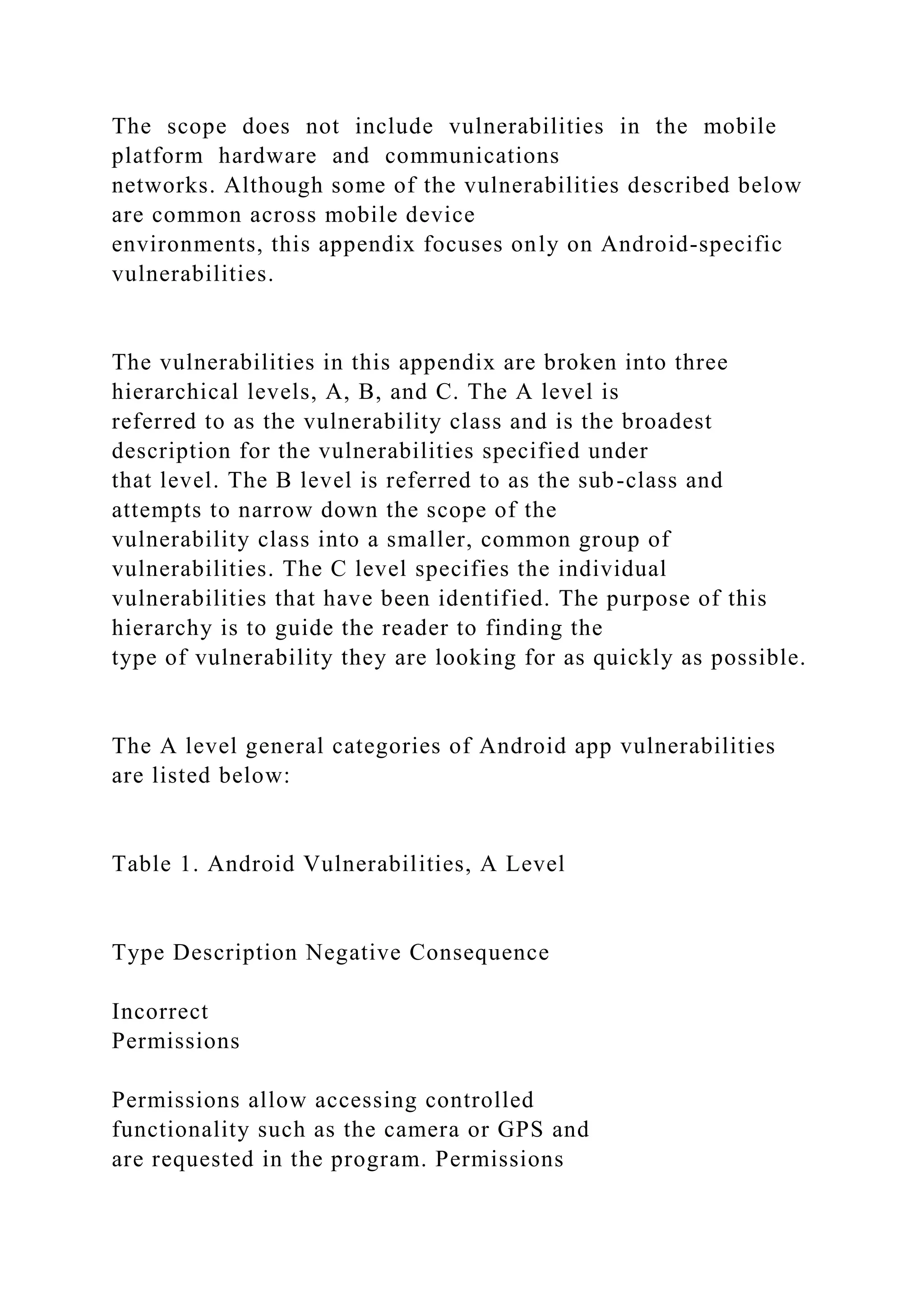
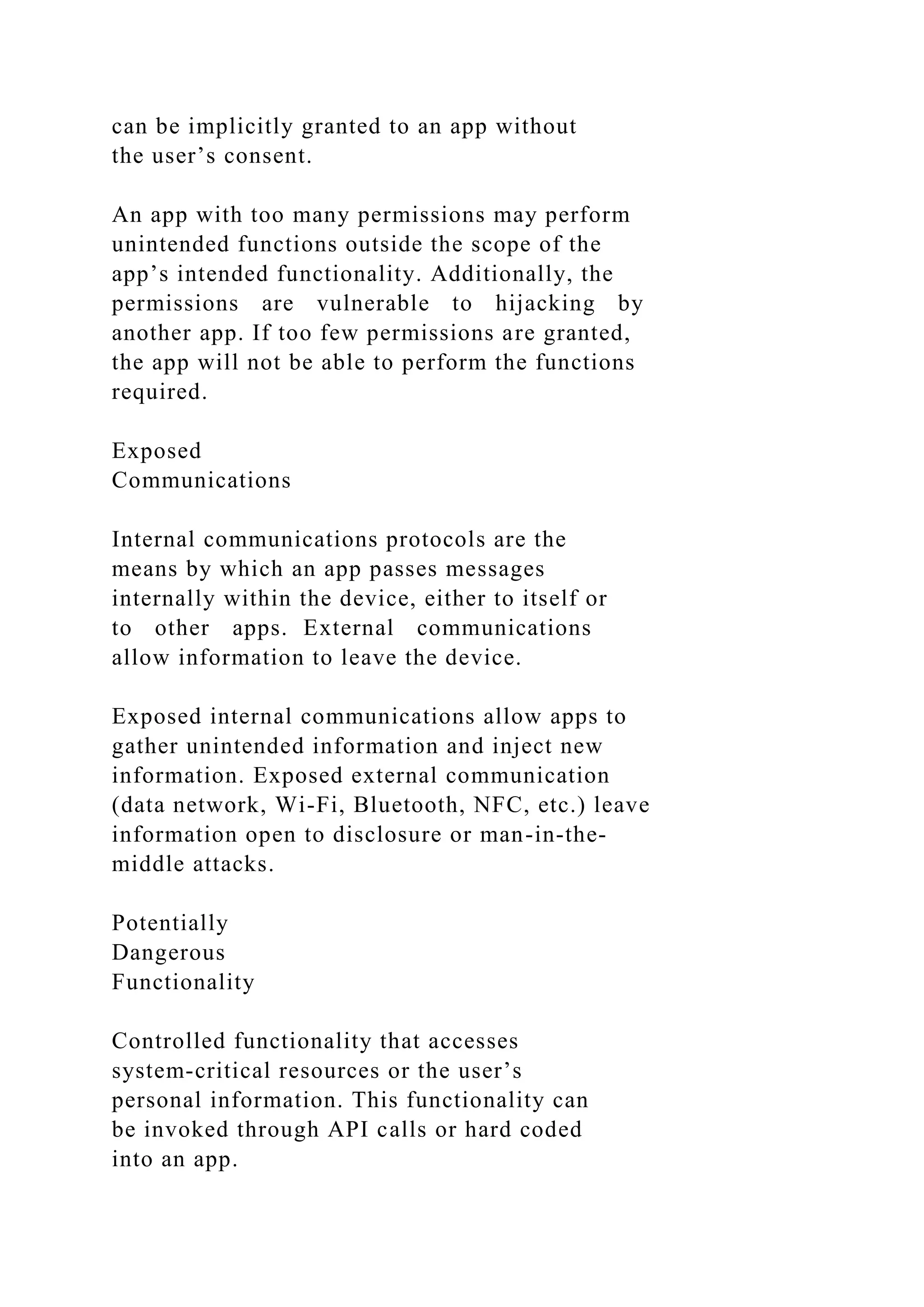
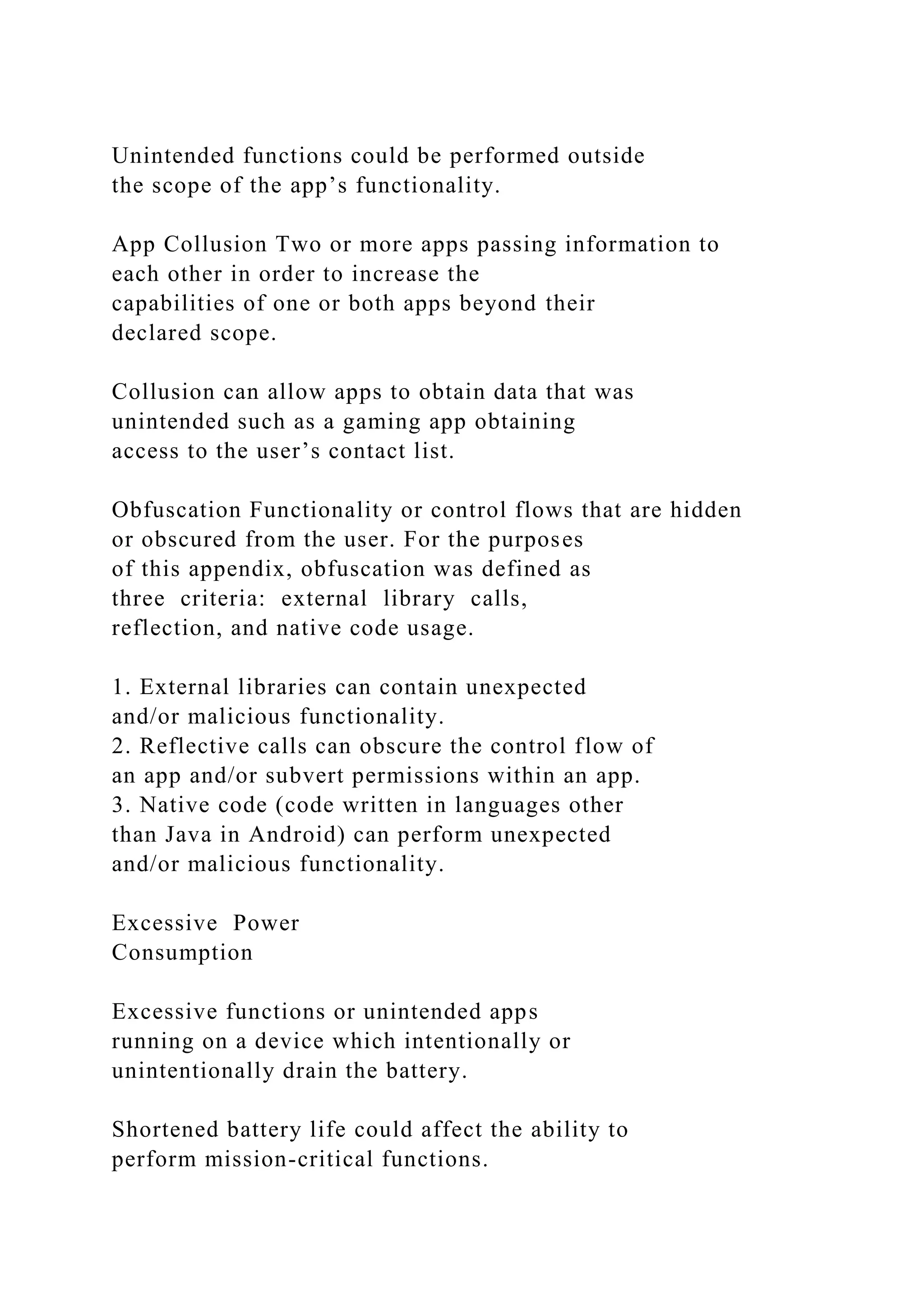
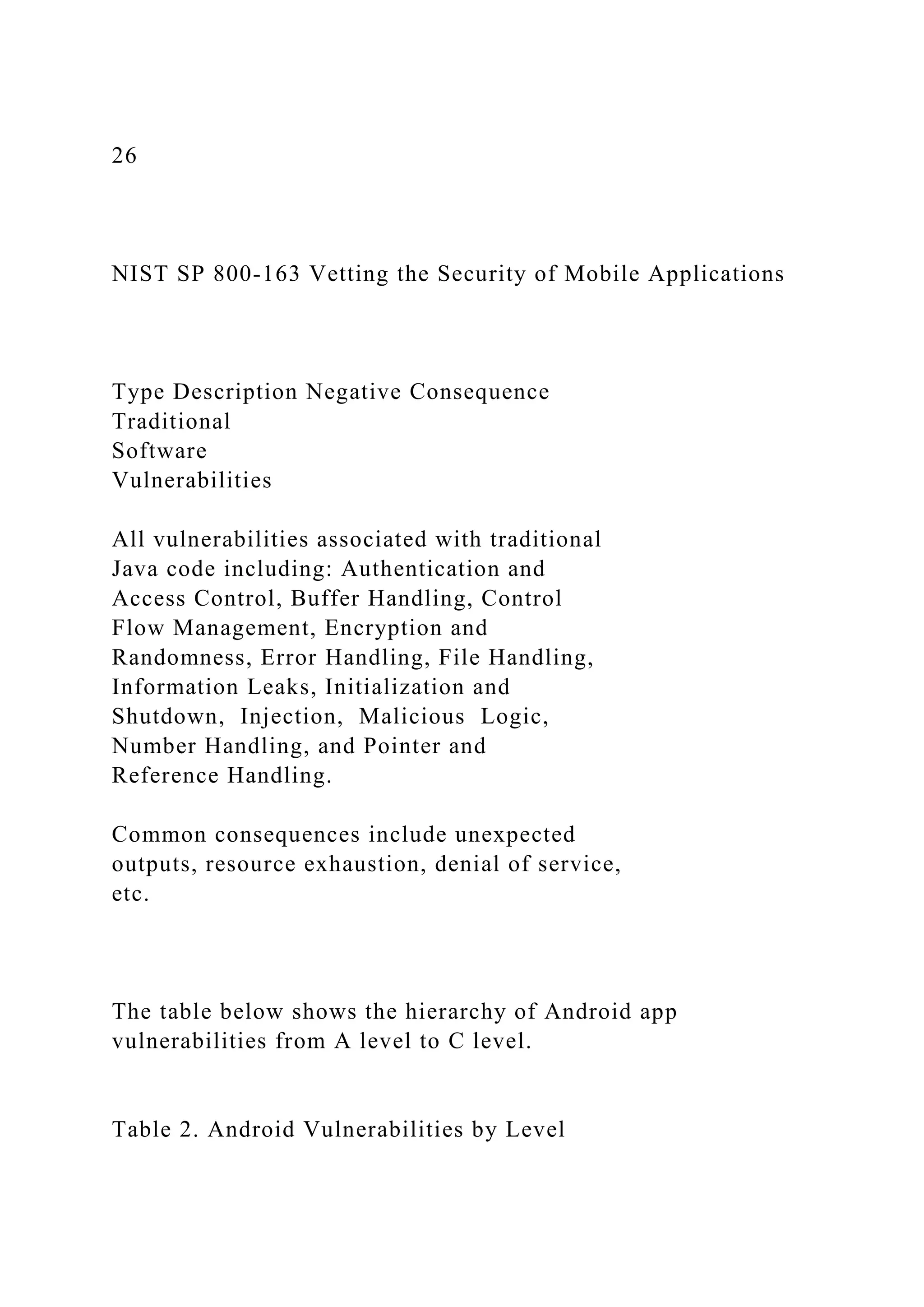
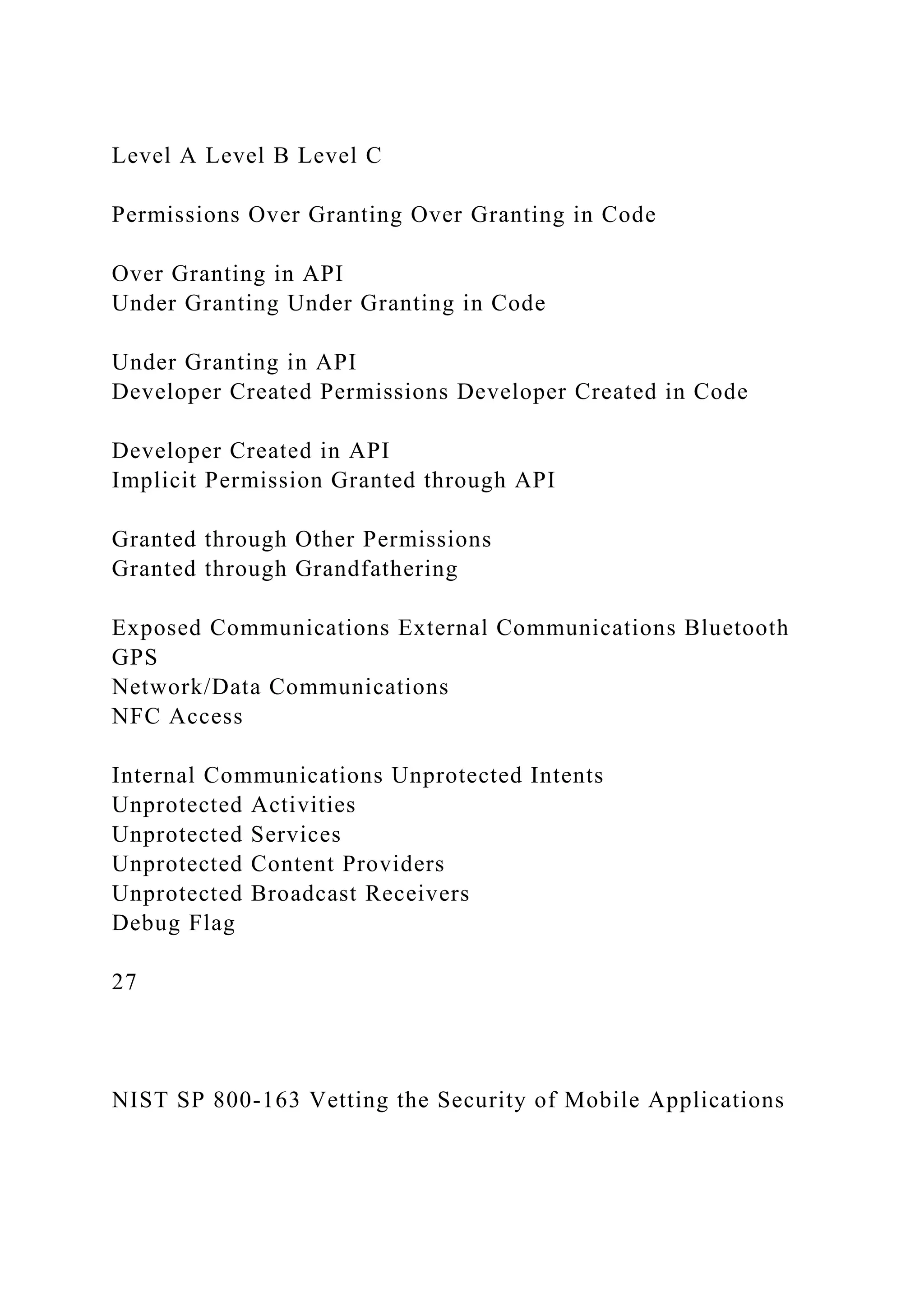

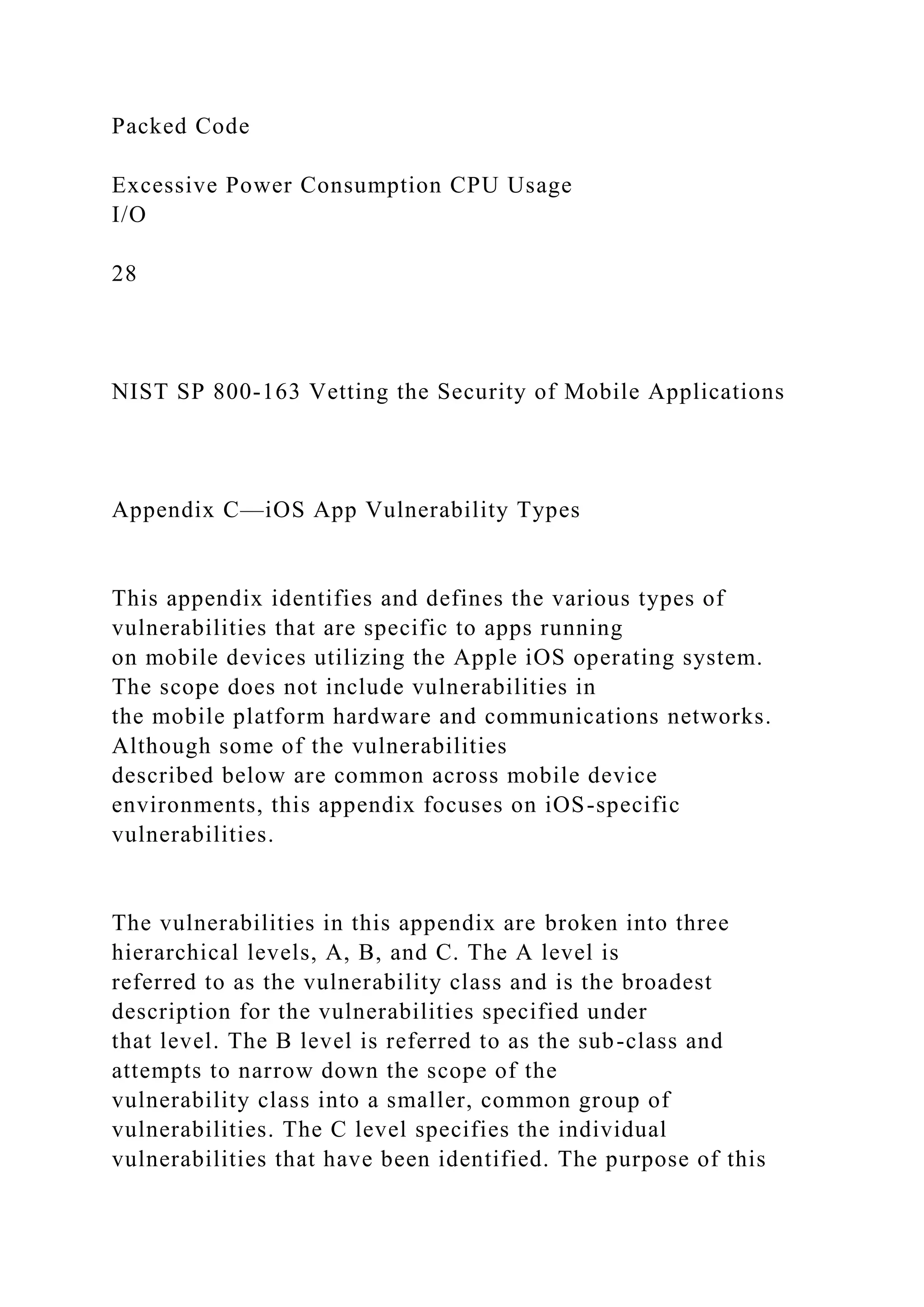

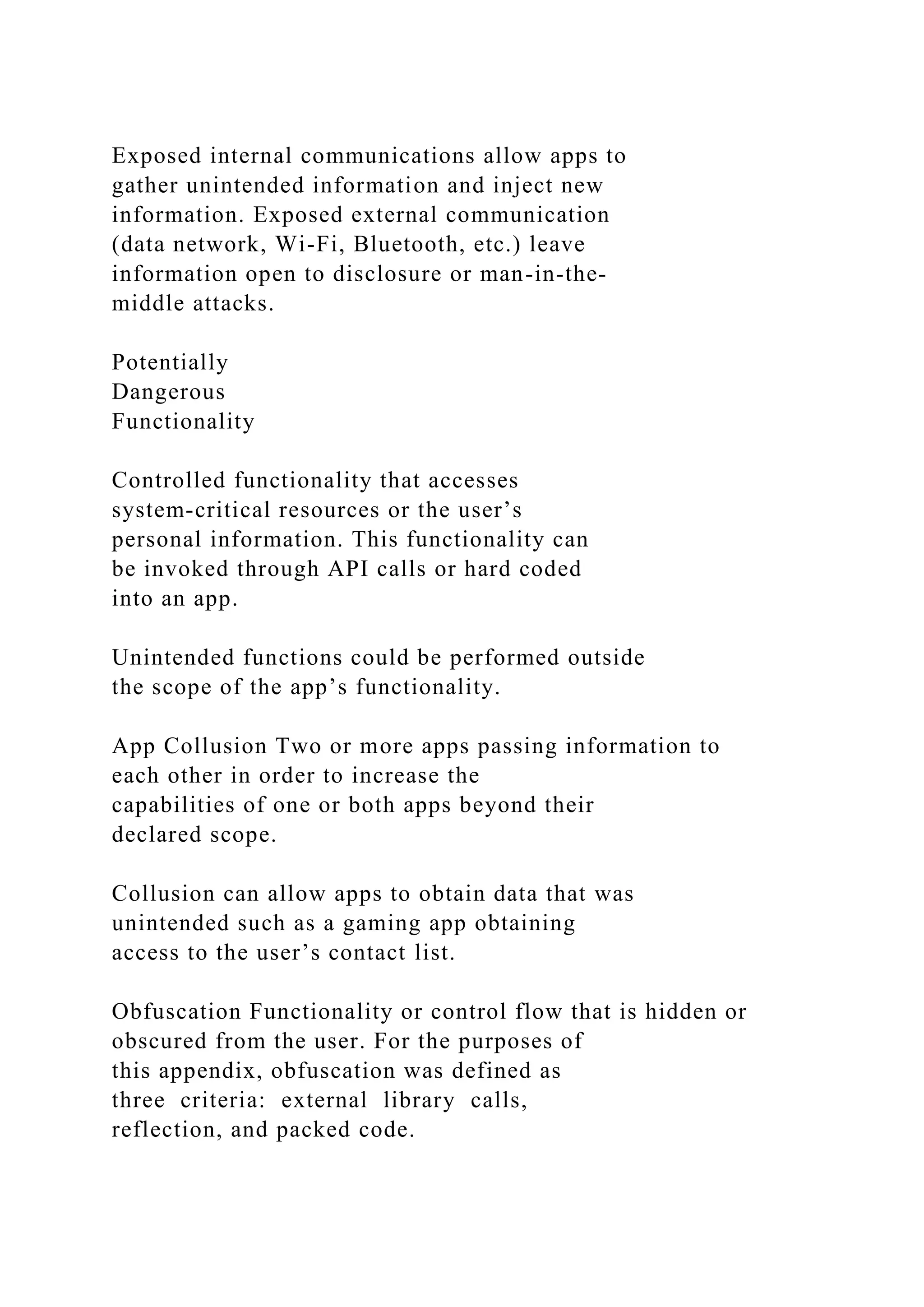

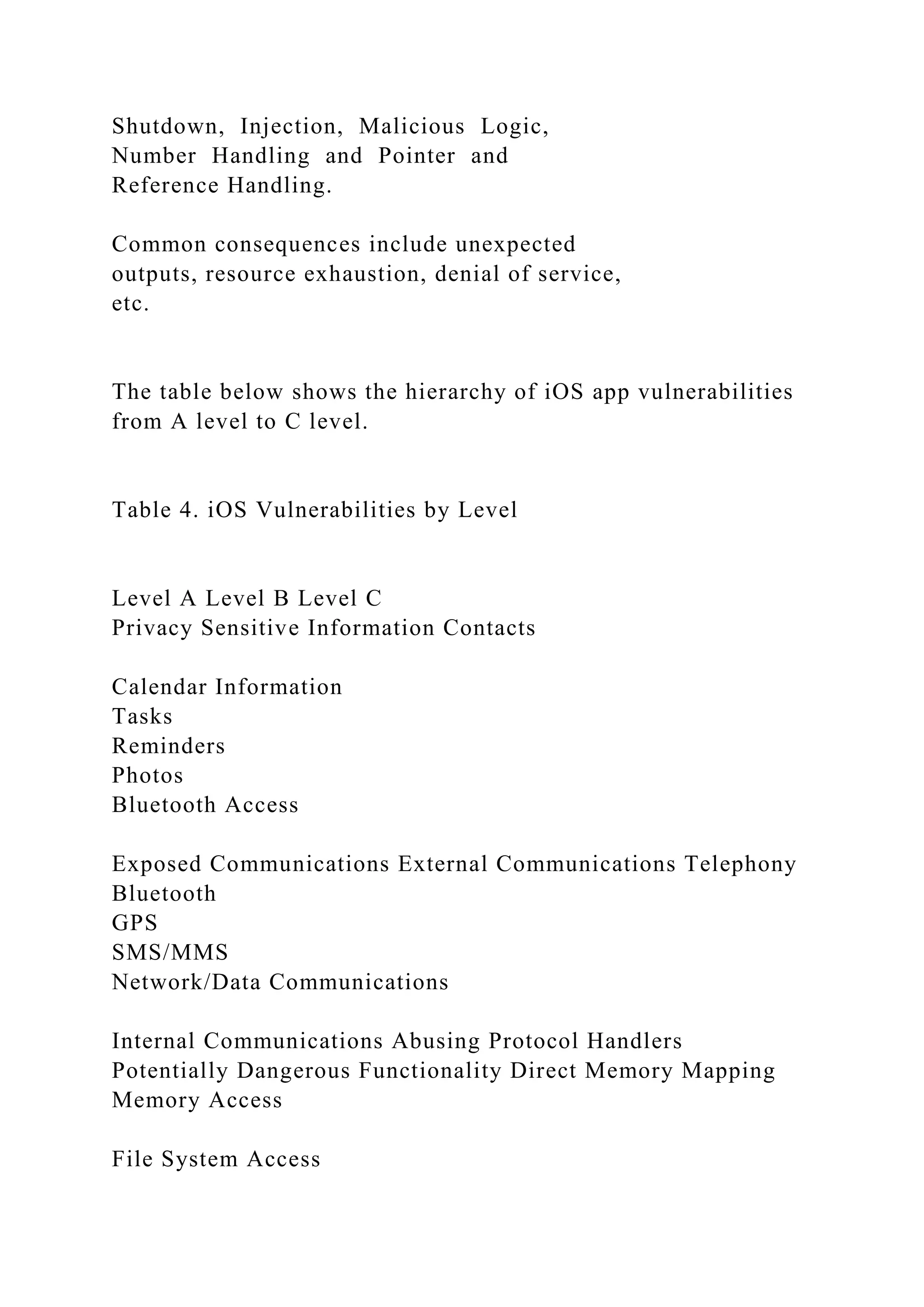

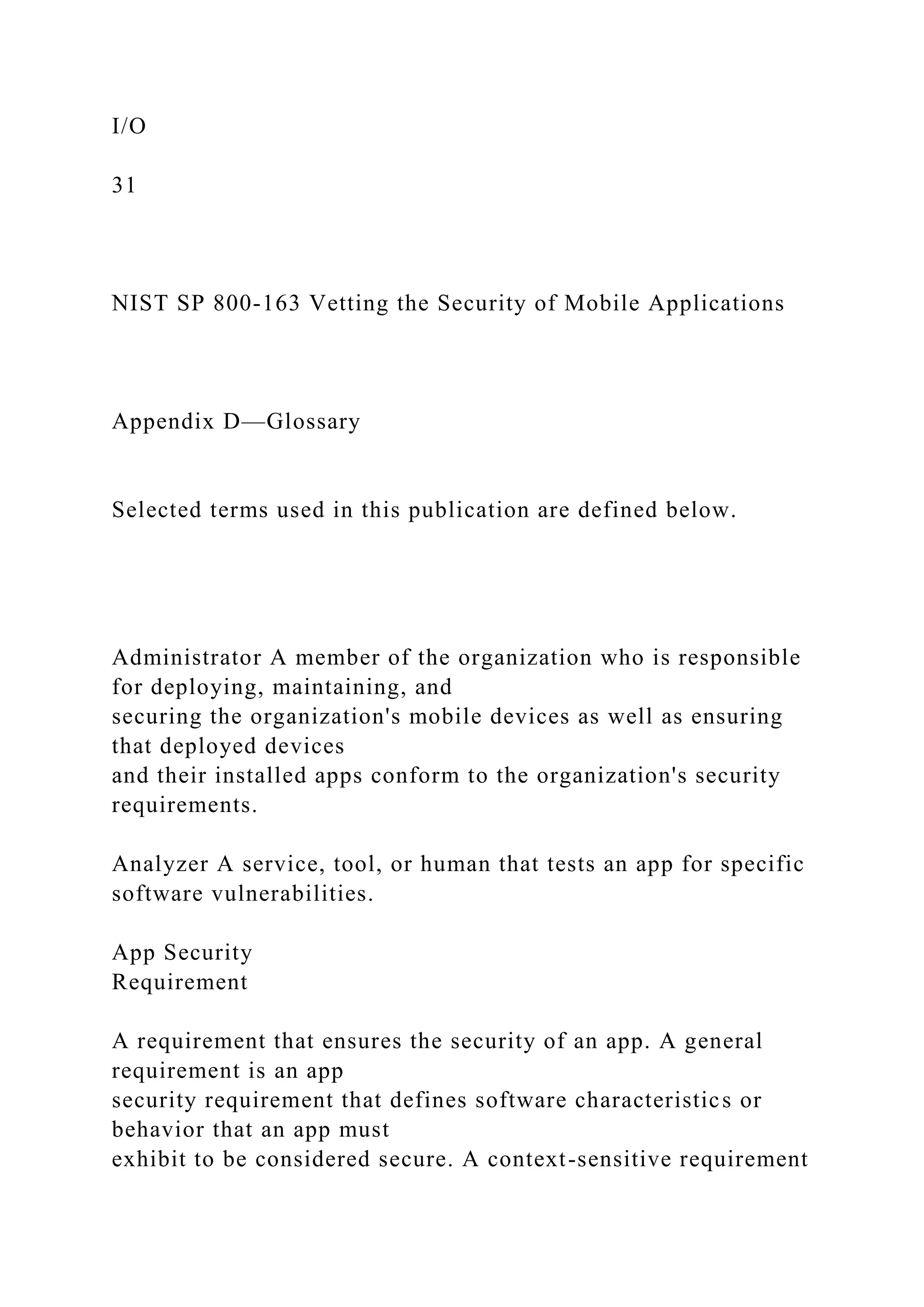
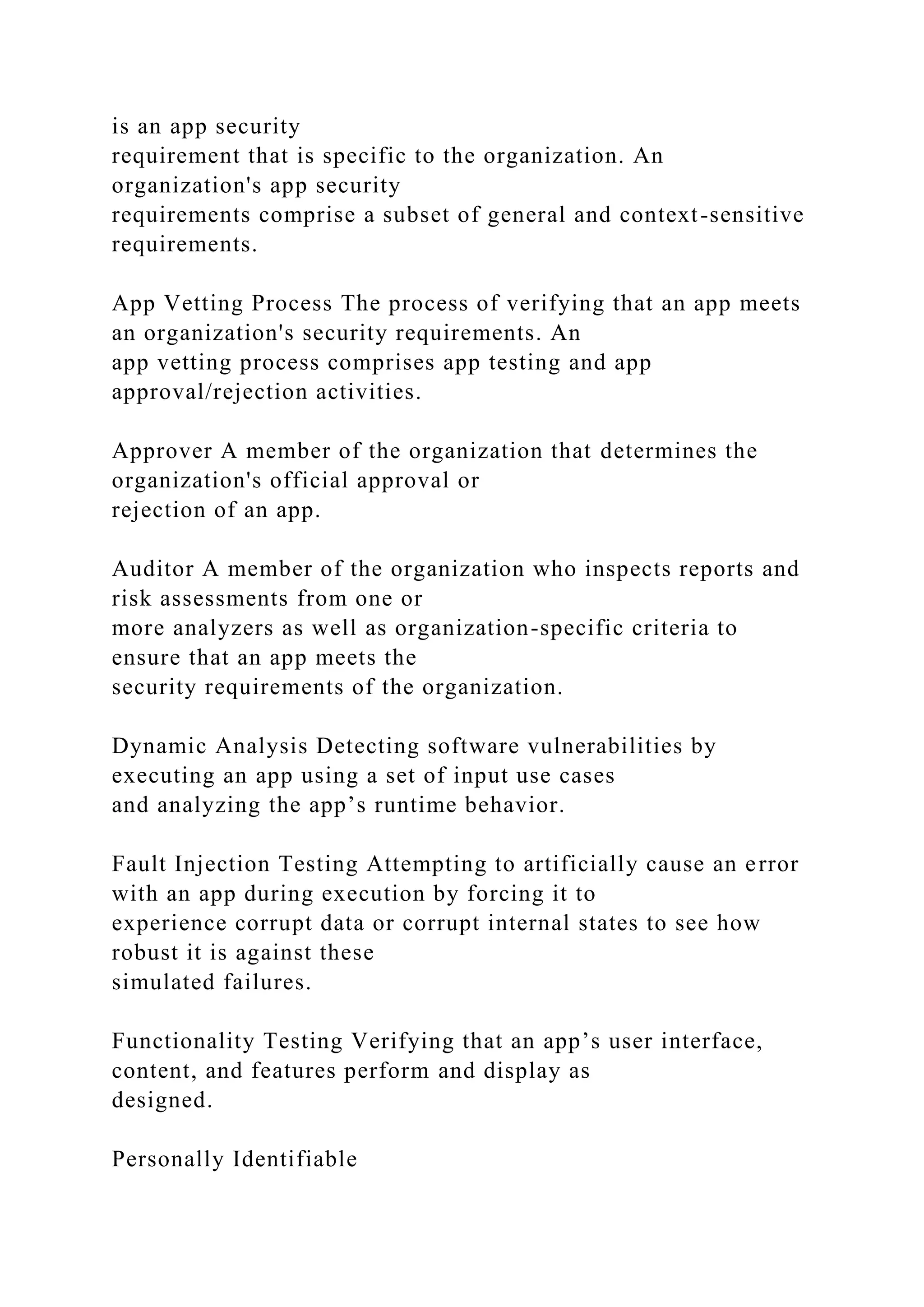
![Information
Any information about an individual that can be used to
distinguish or trace an
individual's identify and any other information that is linked or
linkable to an
individual [45].
Risk Assessment A value that defines an analyzer's estimated
level of security risk for using an app.
Risk assessments are typically based on the likelihood that a
detected vulnerability
will be exploited and the impact that the detected vulnerability
may have on the app or
its related device or network. Risk assessments are typically
represented as categories
(e.g., low-, moderate-, and high-risk).
Static Analysis Detecting software vulnerabilities by examining
the app source code and binary and
attempting to reason over all possible behaviors that might arise
at runtime.
Software Assurance The level of confidence that software is
free from vulnerabilities, either intentionally
designed into the software or accidentally inserted at any time
during its life cycle and
that the software functions in the intended manner.
Software Correctness
Testing
The process of executing a program with the intent of finding
errors and is aimed
primarily at improving quality assurance, verifying and
validating described](https://image.slidesharecdn.com/1-221101035239-dffccca1/75/1-Security-and-vulnerability-assessment-analysis-tool-Microsoft-docx-148-2048.jpg)
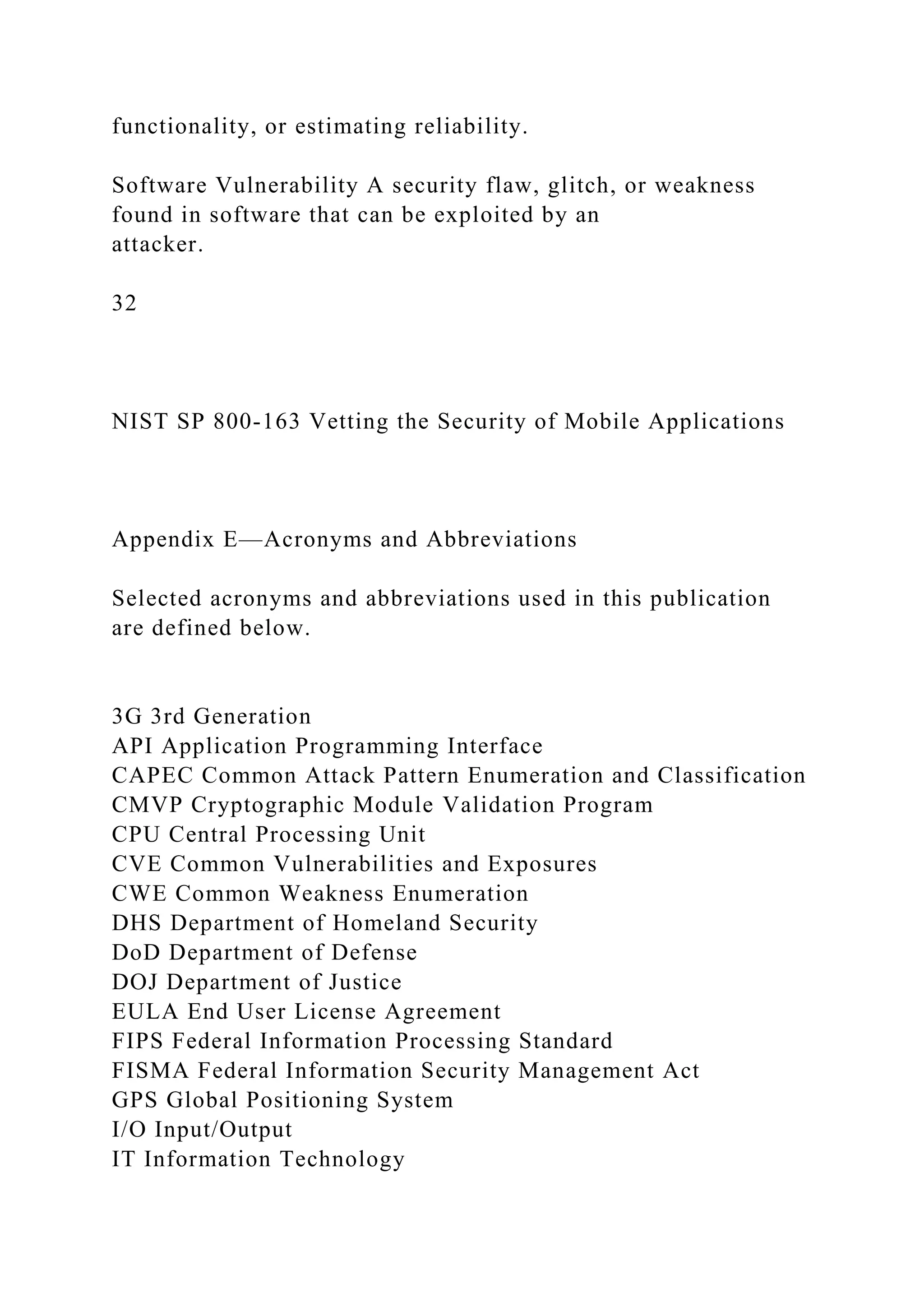
![ITL Information Technology Laboratory
JVM Java Virtual Machine
LTE Long-Term Evolution
MDM Mobile Device Management
NFC Near Field Communications
NIST National Institute of Standards and Technology
NVD National Vulnerability Database
OMB Office of Management and Budget
OS Operating System
PII Personally Identifiable Information
QoS Quality of Service
SAMATE Software Assurance Metrics And Tool Evaluation
SCAP Security Content Automation Protocol
SD Secure Digital
SDK Software Development Kit
SLA Service-Level Agreement
SMS Short Message Service
SP Special Publication
UI User Interface
VPN Virtual Private Network
Wi-Fi Wireless Fidelity
33
NIST SP 800-163 Vetting the Security of Mobile Applications
Appendix F—References
References for this publication are listed below.
[1] Committee on National Security Systems (CNSS)](https://image.slidesharecdn.com/1-221101035239-dffccca1/75/1-Security-and-vulnerability-assessment-analysis-tool-Microsoft-docx-150-2048.jpg)
![Instruction 4009, National Information
Assurance Glossary, April 2010.
https://www.cnss.gov/CNSS/issuances/Instructions.cfm
(accessed 12/4/14).
[2] National Aeronautics and Space Administration (NASA)
NASA-STD-8739.8 w/Change 1,
Standard for Software Assurance, July 28, 2004 (revised May 5,
2005).
http://www.hq.nasa.gov/office/codeq/doctree/87398.htm
(accessed 12/4/14).
[3] Radio Technical Commission for Aeronautics (RTCA),
RTCA/DO-178B, Software
Considerations in Airborne Systems and Equipment
Certification, December 1, 1992 (errata
issued March 26, 1999).
[4] International Electrotechnical Commission (IEC), IEC
61508, Functional Safety of
Electrical/Electronic/Programmable Electronic Safety-related
Systems, edition 2.0 (7 parts),
April 2010.
[5] International Organization for Standardization (ISO), ISO
26262, Road vehicles -- Functional
safety (10 parts), 2011.](https://image.slidesharecdn.com/1-221101035239-dffccca1/75/1-Security-and-vulnerability-assessment-analysis-tool-Microsoft-docx-151-2048.jpg)
![[6] M. Souppaya and K. Scarfone, Guidelines for Managing the
Security of Mobile Devices in the
Enterprise, NIST Special Publication (SP) 800-124 Revision 1,
June 2013.
http://dx.doi.org/10.6028/NIST.SP.800-124r1.
[7] National Information Assurance Partnership, Protection
Profile for Mobile Device Fundamentals
Version 2.0, September 17, 2014. https://www.niap-
ccevs.org/pp/PP_MD_v2.0/ (accessed
12/4/14).
[8] Joint Task Force Transformation Initiative, Security and
Privacy Controls for Federal
Information Systems and Organizations, NIST Special
Publication (SP) 800-53 Revision 4, April
2013 (updated January 15, 2014).
http://dx.doi.org/10.6028/NIST.SP.800-53r4.
[9] NIST, AppVet Mobile App Vetting System [Web site],
http://csrc.nist.gov/projects/appvet/
(accessed 12/4/14).
[10] Joint Task Force Transformation Initiative, Guide for
Conducting Risk Assessments, NIST
Special Publication (SP) 800-30 Revision 1, September 2012.
http://csrc.nist.gov/publications/nistpubs/800-30-](https://image.slidesharecdn.com/1-221101035239-dffccca1/75/1-Security-and-vulnerability-assessment-analysis-tool-Microsoft-docx-152-2048.jpg)
![rev1/sp800_30_r1.pdf (accessed 12/4/14).
[11] G. McGraw, Software Security: Building Security In,
Upper Saddle River, New Jersey: Addison-
Wesley Professional, 2006.
[12] M. Dowd, J. McDonald and J. Schuh, The Art of Software
Security Assessment - Identifying and
Preventing Software Vulnerabilities, Upper Saddle River, New
Jersey: Addison-Wesley
Professional, 2006.
34
NIST SP 800-163 Vetting the Security of Mobile Applications
[13] H.G. Rice, “Classes of Recursively Enumerable Sets and
Their Decision Problems,” Transactions
of the American Mathematical Society 74, pp. 358-366, 1953.
http://dx.doi.org/10.1090/S0002-
9947-1953-0053041-6.
[14] J.H. Allen, S. Barnum, R.J. Ellison, G. McGraw, and N.R.
Mead, Software Security Engineering:
a Guide for Project Managers, Upper Saddle River, New Jersey:
Addison-Wesley, 2008.](https://image.slidesharecdn.com/1-221101035239-dffccca1/75/1-Security-and-vulnerability-assessment-analysis-tool-Microsoft-docx-153-2048.jpg)
![[15] Microsoft Corporation, The STRIDE Threat Model [Web
site], http://msdn.microsoft.com/en-
us/library/ee823878%28v=cs.20%29.aspx, 2005 (accessed
12/4/14).
[16] Trike - open source threat modeling methodology and tool
[Web site], http://www.octotrike.org
(accessed 12/4/14).
[17] K. Scarfone, M. Souppaya, A. Cody and A. Orebaugh,
Technical Guide to Information Security
Testing and Assessment, NIST Special Publication (SP) 800-
115, September 2008.
http://csrc.nist.gov/publications/nistpubs/800-115/SP800-
115.pdf (accessed 12/4/14).
[18] D. C. Gause and G. M. Weinberg, Exploring Requirements:
Quality Before Design, New York:
Dorset House Publishing, 1989.
[19] B. Nuseibeh and S. Easterbrook, “Requirements
engineering: a roadmap,” Proceedings of the
Conference on The Future of Software Engineering (ICSE '00),
Limerick, Ireland, June 7-9, 2000,
New York: ACM, pp. 35-46.
http://dx.doi.org/10.1145/336512.336523.
[20] NIST, Cryptographic Module Validation Program (CMVP)
[Web site],](https://image.slidesharecdn.com/1-221101035239-dffccca1/75/1-Security-and-vulnerability-assessment-analysis-tool-Microsoft-docx-154-2048.jpg)
![http://csrc.nist.gov/groups/STM/cmvp/ (accessed 12/4/14).
[21] E. Barker and Q. Dang, Recommendation for Key
Management, Part 3: Application-Specific Key
Management Guidance, NIST Special Publication (SP) 800-57
Part 3 Revision 1 (DRAFT), May
2014. http://csrc.nist.gov/publications/drafts/800-
57pt3_r1/sp800_57_pt3_r1_draft.pdf (accessed
12/4/14).
[22] M. Pezzè and M. Young, Software Testing and Analysis:
Process, Principles and Techniques,
Hoboken, New Jersey: John Wiley & Sons, Inc., 2008.
[23] G.G. Schulmeyer, ed., Handbook of Software Quality
Assurance, 4th Edition, Norwood,
Massachusetts: Artech House, Inc., 2008.
[24] B.B. Agarwal, S.P. Tayal and M. Gupta, Software
Engineering and Testing, Sudbury,
Massachusetts: Jones and Bartlett Publishers, 2010.
[25] J.R. Maximoff, M.D. Trela, D.R. Kuhn and R. Kacker, A
Method for Analyzing System State-
space Coverage within a t-Wise Testing Framework, 4th Annual
IEEE International Systems
Conference, April 5-8, 2010, San Diego, California, pp. 598-
603.
http://dx.doi.org/10.1109/SYSTEMS.2010.5482481.](https://image.slidesharecdn.com/1-221101035239-dffccca1/75/1-Security-and-vulnerability-assessment-analysis-tool-Microsoft-docx-155-2048.jpg)
![[26] G.J. Myers, The Art of Software Testing, second edition,
Hoboken, New Jersey: John Wiley &
Sons, Inc., 2004.
[27] OW2 Consortium, ASM - Java bytecode manipulation and
analysis framework [Web site],
http://asm.ow2.org/ (accessed 12/4/14).
35
NIST SP 800-163 Vetting the Security of Mobile Applications
[28] H. Chen, T. Zou and D. Wang, “Data-flow based
vulnerability analysis and java bytecode,” 7th
WSEAS International Conference on Applied Computer Science
(ACS’07), Venice, Italy,
November 21-23, 2007, pp. 201-207. http://www.wseas.us/e-
library/conferences/2007venice/papers/570-602.pdf (accessed
12/4/14).
[29] University of Maryland, FindBugs: Find Bugs in Java
Programs - Static analysis to look for bugs
in Java code [Web site], http://findbugs.sourceforge.net/
(accessed 12/4/14).
[30] R.A. Shah, Vulnerability Assessment of Java Bytecode,](https://image.slidesharecdn.com/1-221101035239-dffccca1/75/1-Security-and-vulnerability-assessment-analysis-tool-Microsoft-docx-156-2048.jpg)
![Master’s Thesis, Auburn University,
December 16, 2005. http://hdl.handle.net/10415/203.
[31] G. Zhao, H. Chen and D. Wang, “Data-Flow Based
Analysis of Java Bytecode Vulnerability,” In
Proceedings of the Ninth International Conference on Web-Age
Information Management (WAIM
'08), Zhanjiajie, China, July 20-22, 2008, Washington, DC:
IEEE Computer Society, pp. 647-653.
http://doi.ieeecomputersociety.org/10.1109/WAIM.2008.99.
[32] G. Balakrishnan, WYSINWYX: What You See Is Not What
You eXecute, Ph.D. diss. [and Tech.
Rep. TR-1603], Computer Sciences Department, University of
Wisconsin-Madison, Madison,
Wisconsin, August 2007.
http://research.cs.wisc.edu/wpis/papers/balakrishnan_thesis.pdf
(accessed 12/4/14).
[33] NIST, SAMATE: Software Assurance Metrics And Tool
Evaluation [Web site],
http://samate.nist.gov/Main_Page.html (accessed 12/4/14).
[34] The MITRE Corporation, Common Weakness Enumeration
CWE-190: Integer Overflow or
Wraparound [Web site],
http://cwe.mitre.org/data/definitions/190.html (accessed
12/4/14).](https://image.slidesharecdn.com/1-221101035239-dffccca1/75/1-Security-and-vulnerability-assessment-analysis-tool-Microsoft-docx-157-2048.jpg)
![[35] The MITRE Corporation, Common Weakness Enumeration
CWE-77: Improper Neutralization of
Special Elements used in a Command ('Command Injection')
[Web site],
http://cwe.mitre.org/data/definitions/77.html (accessed
12/4/14).
[36] NIST, National Vulnerability Database (NVD) [Web site],
http://nvd.nist.gov/ (accessed 12/4/14).
[37] NIST, Security Content Automation Protocol (SCAP) [Web
site], http://scap.nist.gov/ (accessed
12/4/14).
[38] The MITRE Corporation, Common Weakness Enumeration
[Web site], http://cwe.mitre.org/
(accessed 12/4/14).
[39] The MITRE Corporation, Common Attack Pattern
Enumeration and Classification [Web site],
https://capec.mitre.org/ (accessed 12/4/14).
[40] R.A. Martin and S.M. Christey, “The Software Industry’s
‘Clean Water Act’ Alternative,” IEEE
Security & Privacy10(3), pp. 24-31, May-June 2012.
http://dx.doi.org/10.1109/MSP.2012.3.
[41] Forum of Incident Response and Security Teams (FIRST),
Common Vulnerability Scoring System](https://image.slidesharecdn.com/1-221101035239-dffccca1/75/1-Security-and-vulnerability-assessment-analysis-tool-Microsoft-docx-158-2048.jpg)
![(CVSS-SIG) [Web site], http://www.first.org/cvss (accessed
12/4/14).
[42] Industry Consortium for Advancement of Security on the
Internet (ICASI), The Common
Vulnerability Reporting Framework (CVRF) [Web site],
http://www.icasi.org/cvrf (accessed
12/4/14).
36
NIST SP 800-163 Vetting the Security of Mobile Applications
[43] U.S. Department of Homeland Security, Software & Supply
Chain Assurance – Community
Resources and Information Clearinghouse (CRIC):
Questionnaires [Web site],
https://buildsecurityin.us-cert.gov/swa/forums-and-working-
groups/acquisition-and-
outsourcing/resources#ques (accessed 12/4/14).
[44] The MITRE Corporation, Common Vulnerabilities and
Exposures (CVE) [Web site],
https://cve.mitre.org/ (accessed 12/4/14).
[45] E. McCallister, T. Grance and K. Scarfone, Guide to
Protecting the Confidentiality of Personally](https://image.slidesharecdn.com/1-221101035239-dffccca1/75/1-Security-and-vulnerability-assessment-analysis-tool-Microsoft-docx-159-2048.jpg)
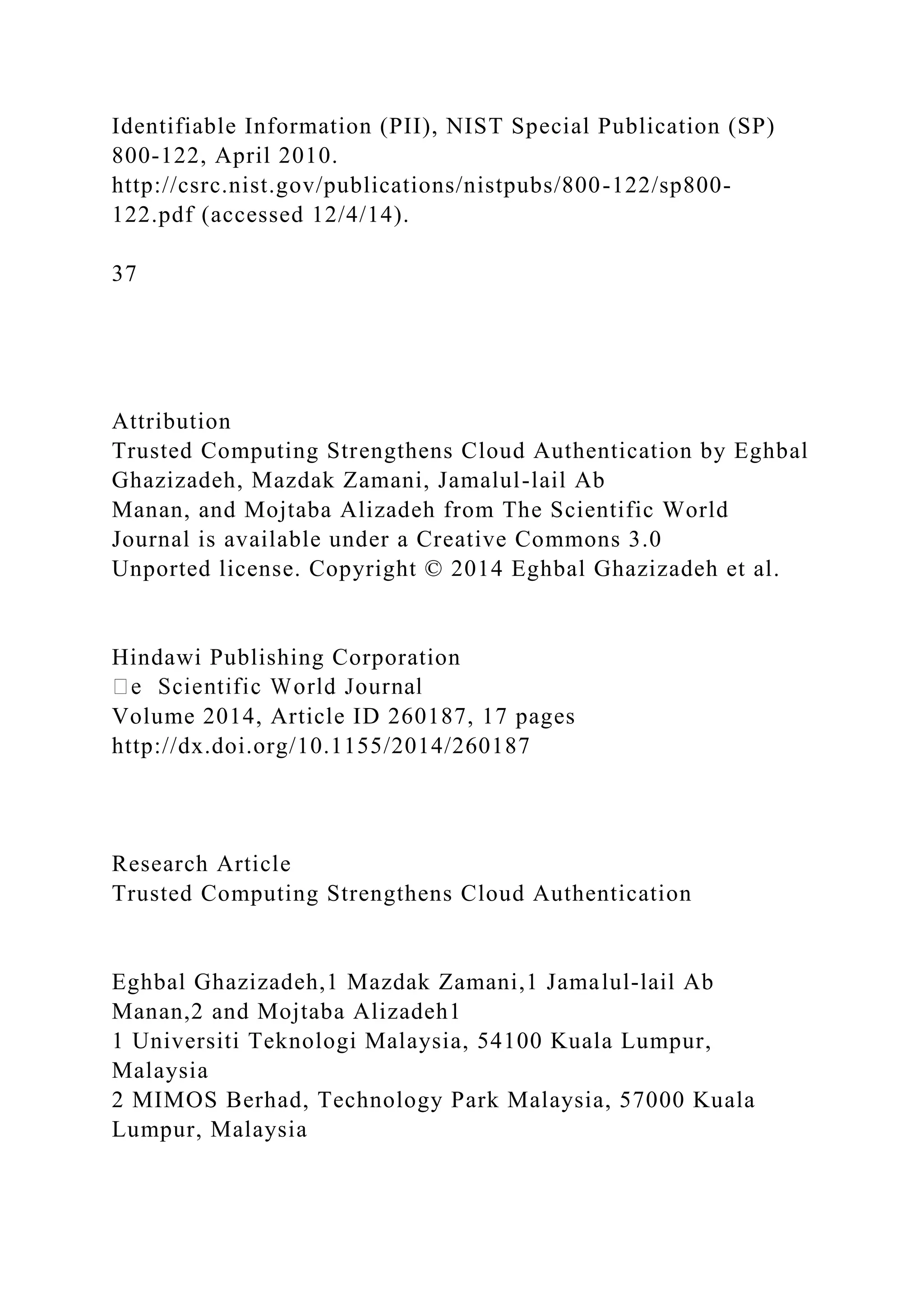
![Correspondence should be addressed to Eghbal Ghazizadeh;
[email protected]
Received 28 September 2013; Accepted 19 December 2013;
Published 18 February 2014
Academic Editors: J. Shu and F. Yu
Copyright © 2014 Eghbal Ghazizadeh et al. This is an open
access article distributed under the Creative Commons
Attribution
License, which permits unrestricted use, distribution, and
reproduction in any medium, provided the original work is
properly
cited.
Cloud computing is a new generation of technology which is
designed to provide the commercial necessities, solve the IT
management issues, and run the appropriate applications.
Another entry on the list of cloud functions which has been
handled
internally is Identity Access Management (IAM). Companies
encounter IAM as security challenges while adopting more
technologies became apparent. Trust Multi-tenancy and trusted
computing based on a Trusted Platform Module (TPM) are great
technologies for solving the trust and security concerns in the
cloud identity environment. Single sign-on (SSO) and OpenID
have
been released to solve security and privacy problems for cloud
identity. This paper proposes the use of trusted computing,
Federated
Identity Management, and OpenID Web SSO to solve identity
theft in the cloud. Besides, this proposed model has been
simulated in
.Net environment. Security analyzing, simulation, and BLP
confidential model are three ways to evaluate and analyze our
proposed](https://image.slidesharecdn.com/1-221101035239-dffccca1/75/1-Security-and-vulnerability-assessment-analysis-tool-Microsoft-docx-161-2048.jpg)
![model.
1. Introduction
The new definition of cloud computing has been born
by Amazon’s EC2 in 2006 in the territory of information
technology. Cloud computing has been revealed because
of commercial necessities and makes a suitable application.
According to NIST definition, “cloud computing is a model
for enabling ubiquitous, convenient, on-demand network
access to a shared pool of configurable computing resources.”
Resource pooling, on-demand self-service, rapid elasticity,
measured serviced, and broad network access are five vital
features of cloud computing. Cloud has various attributes.
It can be executed; supplies materials; can be organized and
is in infrastructure based. These qualities provide rapid and
unrestricted automatic access [1].
“The push for growth in 2011 is leading to changes in em-
phasis,” said M. Chiu. Also he said that IT is now recognized
by business transformation, or better said that digitaliza-
tion is accelerating. Cloud computing and IT management
according to statistics are of top ten business and technol-
ogy priorities of Asian CIOs strongly. Cloud computing, IT
management, mobile technology, virtualization, business
http://www.hindawi.com/journals/tswj/2014/260187/
https://creativecommons.org/licenses/by/3.0/
https://creativecommons.org/licenses/by/3.0/
http://dx.doi.org/10.1155/2014/260187
mailto:[email protected]](https://image.slidesharecdn.com/1-221101035239-dffccca1/75/1-Security-and-vulnerability-assessment-analysis-tool-Microsoft-docx-162-2048.jpg)
![intelligence, infrastructure, business process
management, data management, enterprise application,
collaboration tech- nologies, and network data
communication are the top ten technology priorities.
Cloud will move to become the most popular business
worldwide. It shows that business and technology have
been dominated by cloud computing. Therefore,
thousands of new business are released every day about
cloud computing technology [2].
1.1. Security and Cloud Computing. While cost and
ease are two top benefits of cloud, trust and security
are two concerns of cloud computing users. Cloud
computing has claimed insurance for sensitive data
such as accounting, government, and healthcare and
brought opportuneness for end users. Virtualization,
multitenancy, elasticity, and data owners which
traditional security techniques cannot solve security
problems for them are some new issues in the cloud
computing. Trust is one of the most important issues in
cloud computing security; indeed, two trust questions are
in cloud computing. The first question is do cloud users
trust cloud computing? And second question is how to
make a trusted
2 The Scientific World Journal
base environment for cloud users? However, when it comes
to transfer their businesses to cloud, people tend to worry](https://image.slidesharecdn.com/1-221101035239-dffccca1/75/1-Security-and-vulnerability-assessment-analysis-tool-Microsoft-docx-163-2048.jpg)
![about the privacy and security. Is CSP trustworthy? Will the
concentrated resources in the cloud be more attractive to
hackers? Will the customers be locked in to a particular CSP?
All these concerns constitute the main based obstacle to cloud
computing. Based on these questions and also to address
these concerns when considering moving critical application,
cloud must deliver a sufficient and powerful security level
for the cloud user in terms of new security issues in cloud
computing [3].
Abbadi and Martin illustrated that trust is not a novel
concept but users need to understand the subjects associated
with cloud computing. Technology and business perspective
are two sides of trust computing. The emerging technologies
that best address these issues must be determined. They
believed that trust means an act of confidence, faith, and
reliance. For example, if a system gives users insufficient
information, they will give less trust to the system. In contrast,
if the system gives users sufficient information, they will
trust the system well. There are some important issues with
trust. Control of our assets is the most important security
issue in cloud computing because users trust a system less
when users do not have much control of it. For example,
bank customers use a confidentiality ATM because when they
withdraw money from an ATM machine, they trust it [4].
Cloud computing suppliers should prepare a secure
territory for their consumers. A territory is a collection
of computing environments connected by one or more
networks that control the use of a common security policy.
Regulation and standardization are other issues of trust that
PGP, X509, and SAML are three examples for establishing
trust by using standard. Access management, trust, identity
management, single sign-on and single sign-off, audit and
compliance, and configuration management are six patterns
that identify basic security in cloud computing. Computer](https://image.slidesharecdn.com/1-221101035239-dffccca1/75/1-Security-and-vulnerability-assessment-analysis-tool-Microsoft-docx-164-2048.jpg)
![researchers believe that trust is one of the most important
parts of security in cloud computing. There are three distinct
ways to prove trust. First, we trust someone because we know
them. Second, we trust someone because the person puts
trust on us. Third, sometimes we trust someone because
an organization that we trust vouches for that person. In
addition, there are three distinct definitions of trust. First,
trust means the capability of two special groups to define a
trust connection with an authentication authority. Second,
trust identifies that the authority can exchange credentials
(X.509 Certificates). Third, it uses those credentials to secure
messages and create signed security token (SAML). The main
goal of trust is that users can access a service even though that
service does not have knowledge of the users [5].
Trusted computing grows with technology development
and is raised by the Trusted Computing Group. Trusted
computing is the industry’s response to growing security
problems in the enterprise and is based on hardware root
trust. From this, enterprise system, application, and network
can be made safer and secure. With trusted computing, the
computer or system will reliably act in definite ways and
thus works in specific ways, and those performances will
be obligated by hardware and software when the owner of
those systems enabled these technologies. Therefore, using
trust causes computer environments to be safer, less prone to
viruses and malware, and thus more consistent.
In addition, trusted computing will permit computer
systems to propose improved security and efficiency. The
main aim of trusted computing has prepared a framework for
data and network security that covers data protection, dis-
aster recovery, encryption, authentication, layered security,
identity, and access control [6].](https://image.slidesharecdn.com/1-221101035239-dffccca1/75/1-Security-and-vulnerability-assessment-analysis-tool-Microsoft-docx-165-2048.jpg)
![1.2. Cloud Computing and Federated Identity. One of the
problems with cloud computing is the management and
maintenance of the user’s account. Because of the many
advantages of cloud such as cost and security, identity man-
agement should promise all the cloud advantages. Therefore,
the new proposed model and standards should make use of
all the cloud advantages and prepare an environment to ease
the use of all of them.
Private cloud, public cloud, community cloud, and hybrid
cloud are four essential types of cloud computing that
were named by cloud users and venders. The community
cloud definition shares infrastructure for definite community
between organizations with common concern and private
or internal cloud shares cloud services between a classified
set of users. Attending to establish the best digital identity
for users to use is the most important concern of cloud
providers. Cloud prepares a large amount of various comput-
ing resources; consequently, diverse users in the same system
can share their information and work together. Classified
identity and common authentication are an essential part of
cloud authentication and federated identity acts as a service
based on a common authentication even though it is broadly
used by most important companies like Amazon, Microsoft,
Google, IBM, and Yahoo [7].
Today’s internet user has about thirteen accounts that
require usernames and passwords and enters about eight
passwords per day. It becomes a problem and internet users
face the load of managing this huge number of accounts
and passwords, which leads to password tiredness; indeed
the burden of human memory, password fatigue may cause
users to use password management strategies that reduce the
security of their secured information. Besides, the site centric
Web makes online and each user account is created and](https://image.slidesharecdn.com/1-221101035239-dffccca1/75/1-Security-and-vulnerability-assessment-analysis-tool-Microsoft-docx-166-2048.jpg)
![managed in a distinct administrative domain so that profile
management and personal content sharing will be difficult.
SSO or Web single sign-on systems are invited to address the
mentioned problem with the site centric. Web users, identity
provider and service provider are three parts of SSO and they
have a distinct role in identity scenario. An IdP collects user
identity information and authenticates users, while an RP
trusts on the authenticated identity to make authorization
decisions. OpenID is a promising and open user centric Web
SSO solution. More than one billion OpenID accounts have
been permitted to use service providers according to the
OpenID Foundation. Furthermore, the US Government has
cooperated with the OpenID Foundation in the provision of
the Open Government Initiative’s pilot acceptance of OpenID
technology [8].
The Scientific World Journal 3
Single username and password is an essential part of
single sign-on protocols in terms of authenticate crossway
numerous systems and applications, efforts to statement
privacy, and security issues for web users. There are three
widespread Web SSO implementations that named that
OpenID, Passport/Live ID, and SAML will be enclosed along
with details of common weaknesses and issues [9].
Web SSO solutions were initially advanced by numer-
ous educational institutions in the mid-1990s. For example,
Cornell University’s SideCar, Stanford University’s WebAuth
and Yale’s Central Authentication System (CAS) were entirely
early reformers in the field [10].](https://image.slidesharecdn.com/1-221101035239-dffccca1/75/1-Security-and-vulnerability-assessment-analysis-tool-Microsoft-docx-167-2048.jpg)
![SSO today has a critical role in cloud security and
becomes essential to realize how secure the deployed SSO
mechanisms truly are. Nevertheless, it is a new idea and
no previous work includes a broad study on commercially
deployed web SSO systems, a key to understanding of what
extent these real systems are subject to security breaches [11].
In addition, Wang and Shao showed that weaknesses that
do not illustrate on the protocol level could be brought in by
what the system essentially agrees to each SSO party to do
[12].
1.3. Background of the Problem. Madsen et al. in [13] defined
some problems of federated identity and illustrated that FIM
or Federated Identity Management established on standards
permits and simplifies joining federated organizations in
terms of sharing user identity attributes, simplifying authen-
tication and allowance, or denying using service access
requirements. The definition of SSO is defined as using it
facility user authenticates only one time to home identity
provider and logging in to access successive service providing
service providers within the federated identity. There are
some active problems and concerns in a federated identity
environment like misuse of user identity information through
SSO capability in service providers and identity providers,
user’s identity theft, service providers and identity providers,
and trustworthiness of the user. Federated identity has iden-
tified that regardless of good architectures it still has some
security problems that should be considered in the real estate
implementation.
Wang in [9] discovered another problem of federated
identity that is switching authentication mechanisms to an
SSO solution. It means further education of the users is](https://image.slidesharecdn.com/1-221101035239-dffccca1/75/1-Security-and-vulnerability-assessment-analysis-tool-Microsoft-docx-168-2048.jpg)
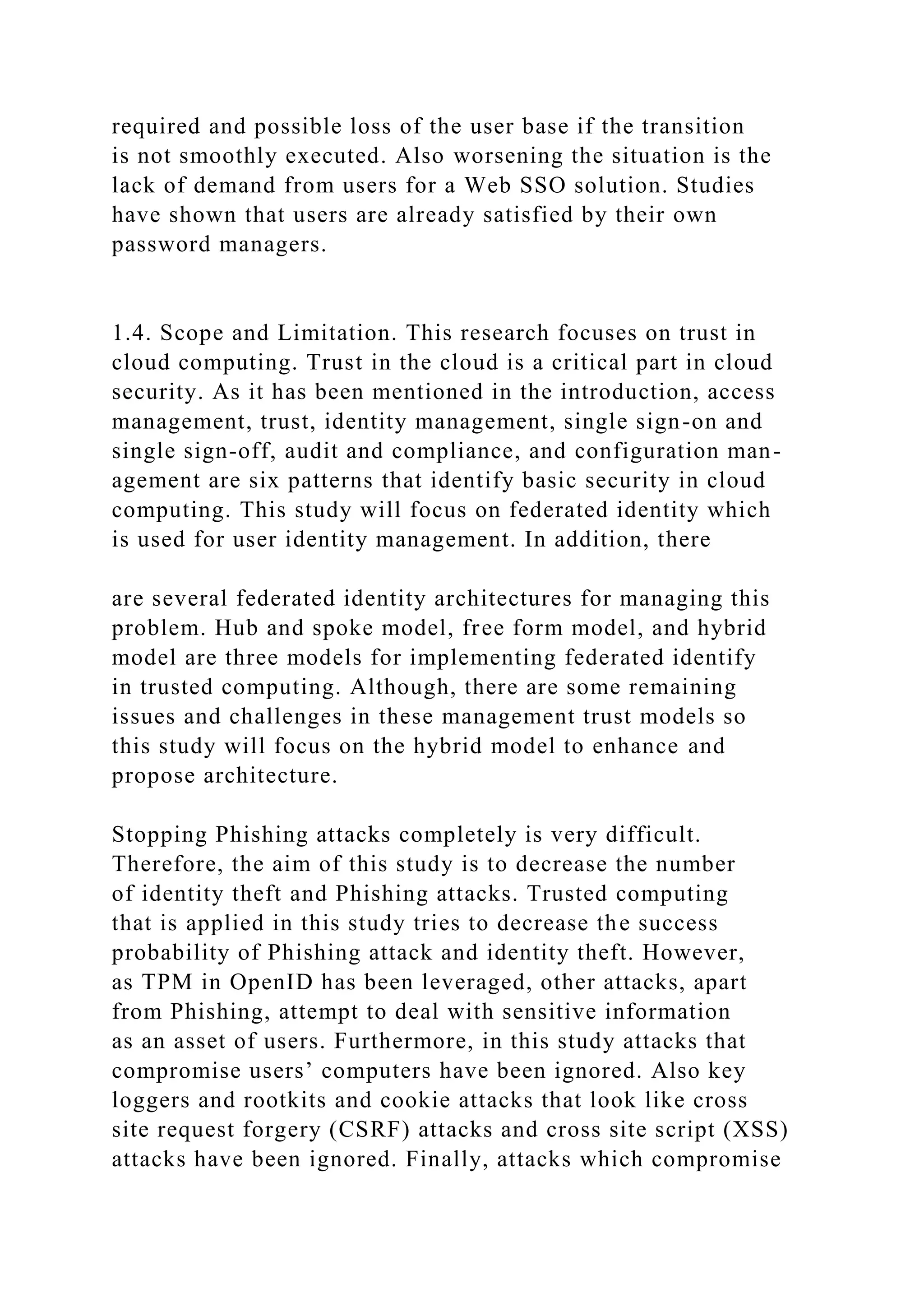
![the integrity of the website will not be discussed.
In conclusion, this study’s scope is single sign-on authen-
tication by using some of the protocols like SAML, OAuth,
and OpenID. As it has been mentioned, user uses these
authentication models in many APIs uses these authentica-
tion models. Visual Studio 2012 and SQL Server 2012 have
been used for simulation of the proposed model.
1.5. Related Work. You and Jun in [14] proposed Internet
Personal Identification Number or I-PIN technique to make
stronger user authentications with the cloud OpenID envi-
ronment against phishing problem of relying parties which
means users could obtain internet service with the OpenID,
although, forcing in OpenID territory in some countries
has been found by them. Besides, they analyze and evaluate
their methods in comparison with the existing OpenID
method, and they recommend some ways to secure OpenID
environment. In their method user has to choose only 1
company out of 3 companies which delivers OpenID and the
index to be a member in order to obtain OpenID service. If
a user receives I-PIN information from main confirmation
authority via IDP with creation OpenID, the problem of main
authentication that OpenID has could be solved.
In addition, they evaluated their study and after compari-
son with an existing OpenID they confirmed that authentica-
tion is secure and safe against attack and private information
exposition. Also they found the problem of Phishing and
shown that the existing OpenID system could be solving
Phishing problem and relying party authentication guaran-
tees security against the exposition of user’s passwords and
ID.
Ding and Wei in [15] proposed a multilevel security](https://image.slidesharecdn.com/1-221101035239-dffccca1/75/1-Security-and-vulnerability-assessment-analysis-tool-Microsoft-docx-170-2048.jpg)
![framework of OpenID authentication. They claimed that
their recommended framework is appropriate for all types of
rule-based security model. They presented the basic OpenID
infrastructure based on the single sign-on explanations that
included hierarchy, OpenID components, and other security
issues. Next they proposed a security access control structure
for OpenID based on BLP model, which can be used to
4 The Scientific World Journal
resolve the difficulty on the access control of multilevel
security, and finally they store the security label in the XML
document.
Mat Nor et al. in [16] took initiative remote user authen-
tication protocol with both elements of trust and privacy by
using TPM (VTPM). Ding and Wei investigated the security
access control scheme for OpenID based on BLP model,
which can be used to solve the problem on access control
of multilevel security with storing the security label in XML
document. Sun et al. [17] discussed the problem of Web SSO
adoption for RPs and argued that solutions in this space
must offer RPs sufficient business incentives and trustworthy
identity services in order to succeed. Fazli BinMat Nor and
Ab Manan [18] proposed an enhanced remote authentication
protocol with hardware based attestation and pseudonym
identity enhancement to mitigate MITM attacks as well as
improving user identity privacy.
Latze and Ultes-Nitsche in [19] proposed using the
trusted TPM (VTPM) for ensuring both an e-commerce
application’s integrity and binding user authentication to](https://image.slidesharecdn.com/1-221101035239-dffccca1/75/1-Security-and-vulnerability-assessment-analysis-tool-Microsoft-docx-171-2048.jpg)
![user credentials and the usage of specific hardware during
the authentication process. Urien in [20] illustrated strong
authentication (without password) for OpenID, according to
a plug and play paradigm, based on SSL smart cards against
Phishing attack. Khiabani et al. in [21] discovered previous
trust and privacy models in pervasive systems and analyzed
them to highlight the importance of trusted computing
platforms in tackling their weaknesses.
1.6. Paper Organization. The rest of this paper is organized
as follows. In the next section, we discuss the proposed
solution in detail. Section 3 provides a simulation of trusted
OpenID. In Section 4, we consider issues that may arise
when implementing the solution and analysis based on these
issues in three approaches, and Section 5 summarizes our
conclusions.
2. Proposed
Solution
In this part, the proposed procedure will be explained.
Programming languages help this study to evaluate the
efficiency of the procedure. Waterfall model will be utilized
to design and implement the prototype. Thus, firstly the
requirements will be analyzed and secondly the algorithms
based on the requirements will be proposed to solve the
problem. Thirdly, the implantation steps and the essential](https://image.slidesharecdn.com/1-221101035239-dffccca1/75/1-Security-and-vulnerability-assessment-analysis-tool-Microsoft-docx-172-2048.jpg)
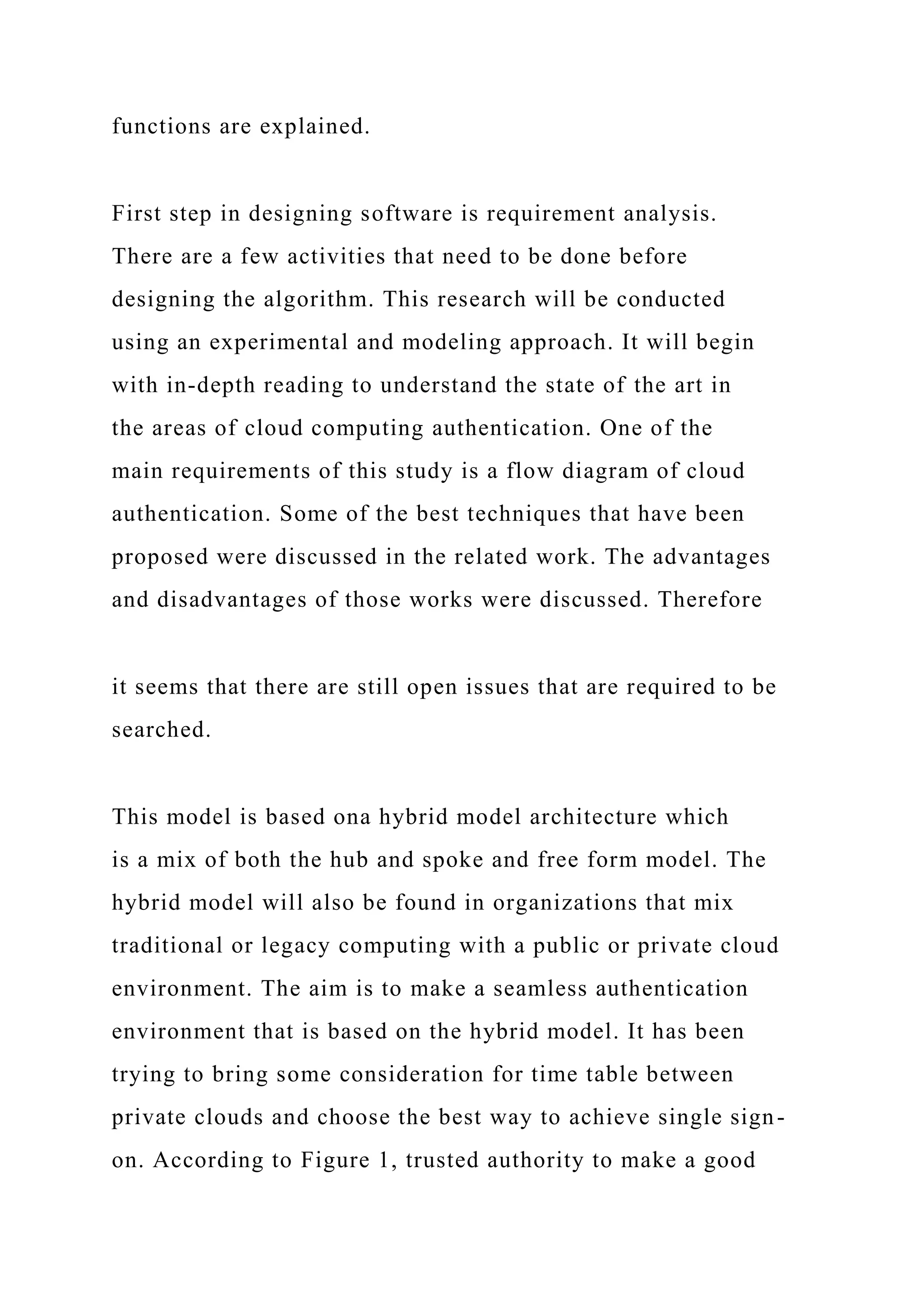
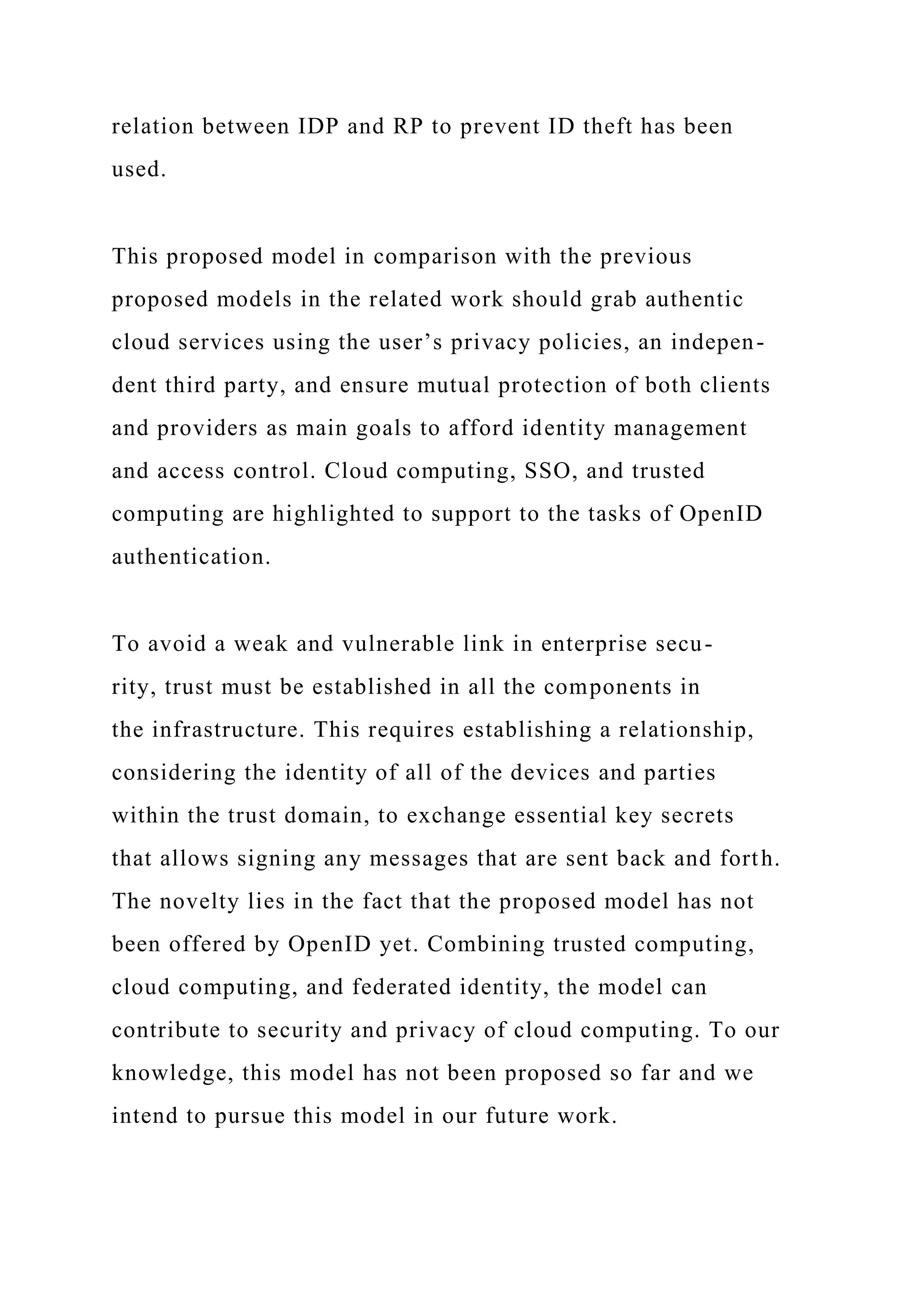
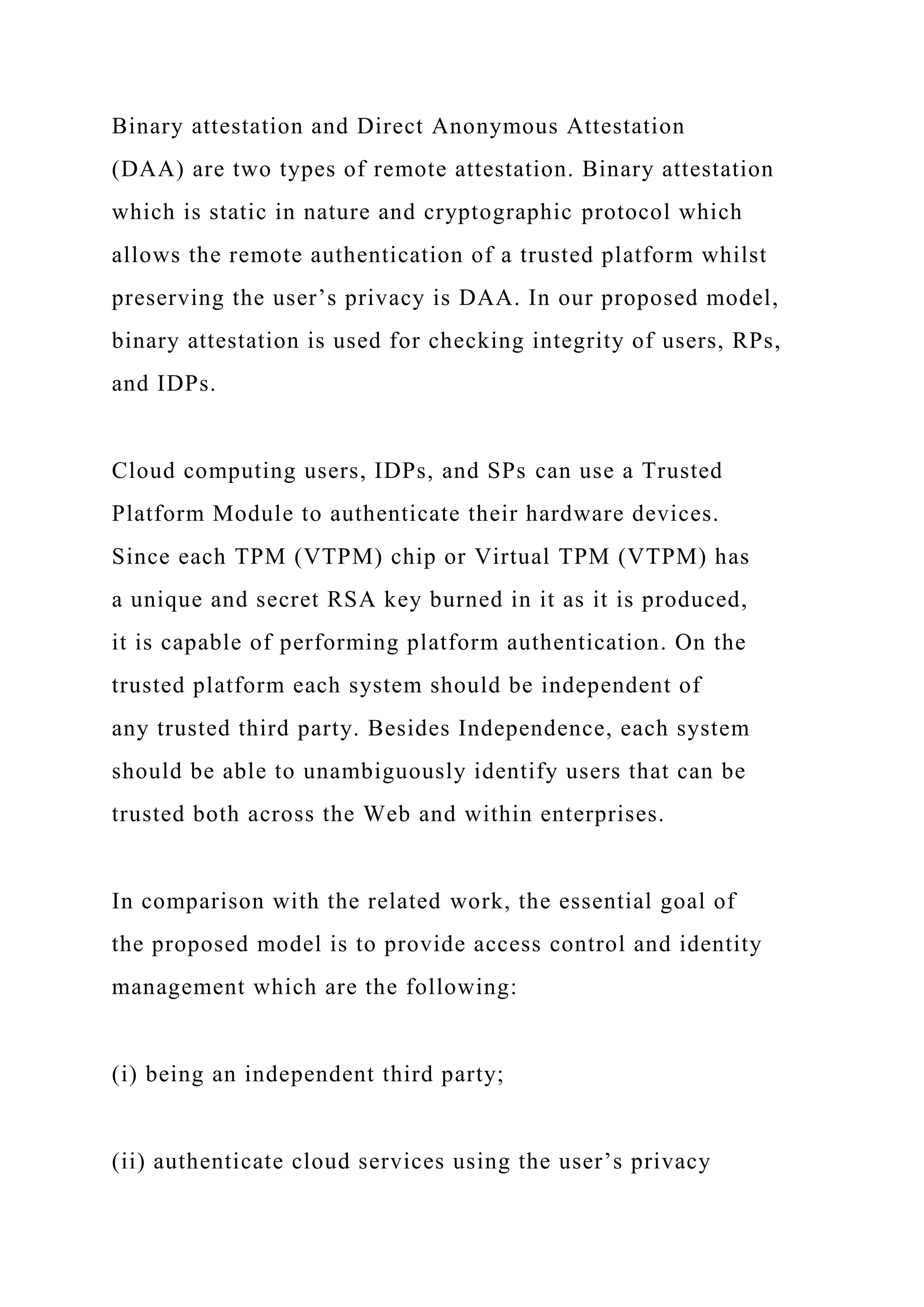
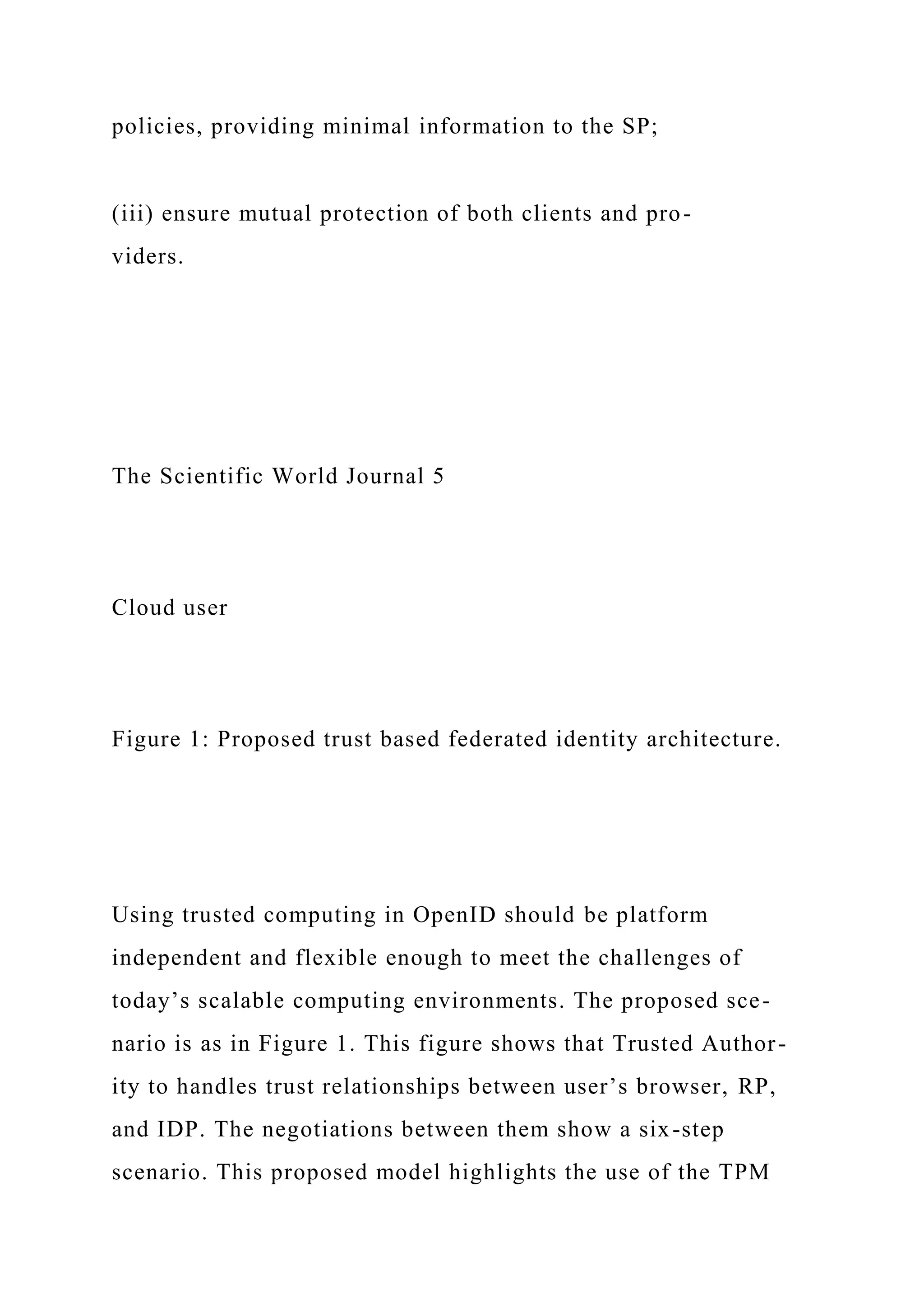


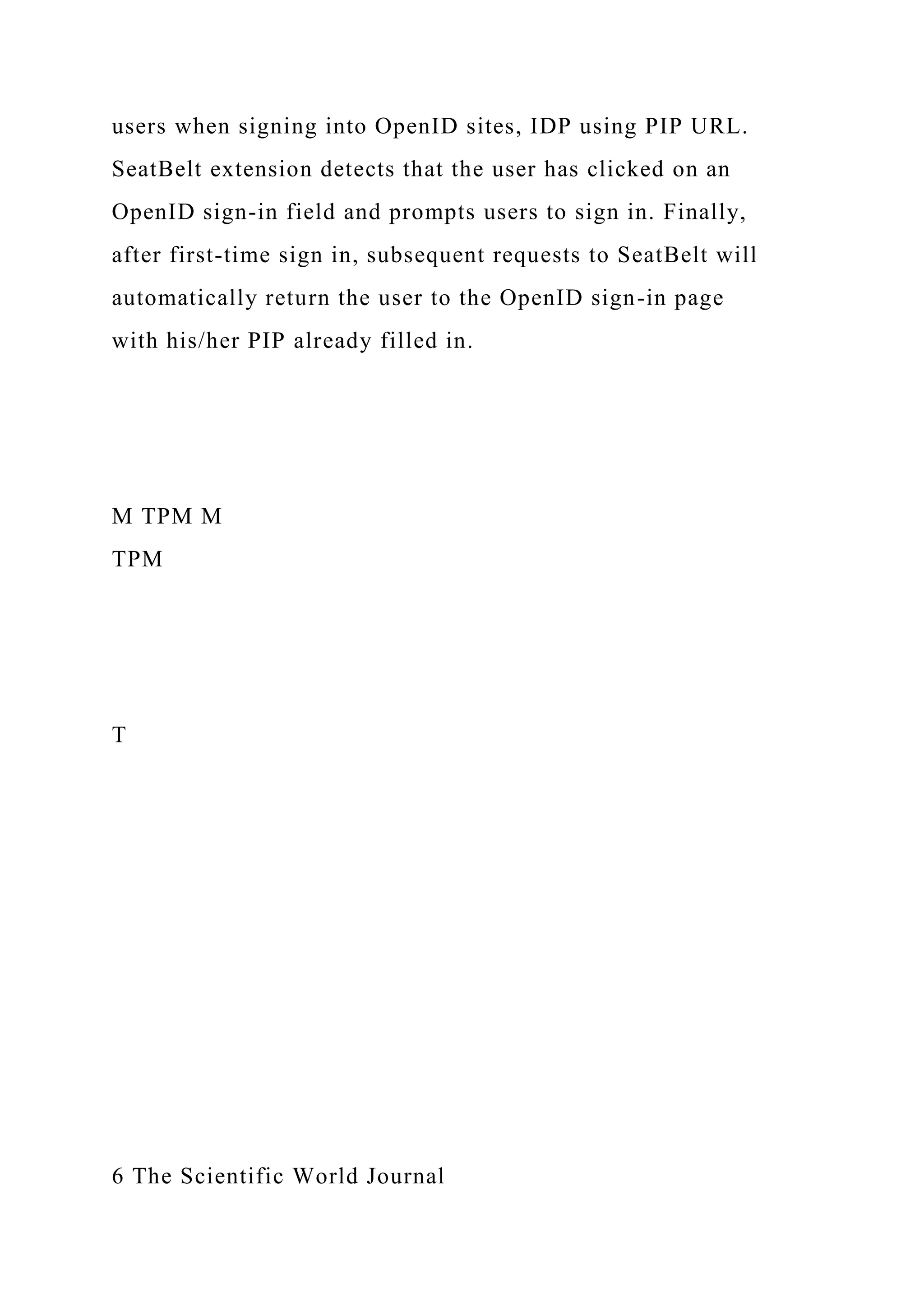
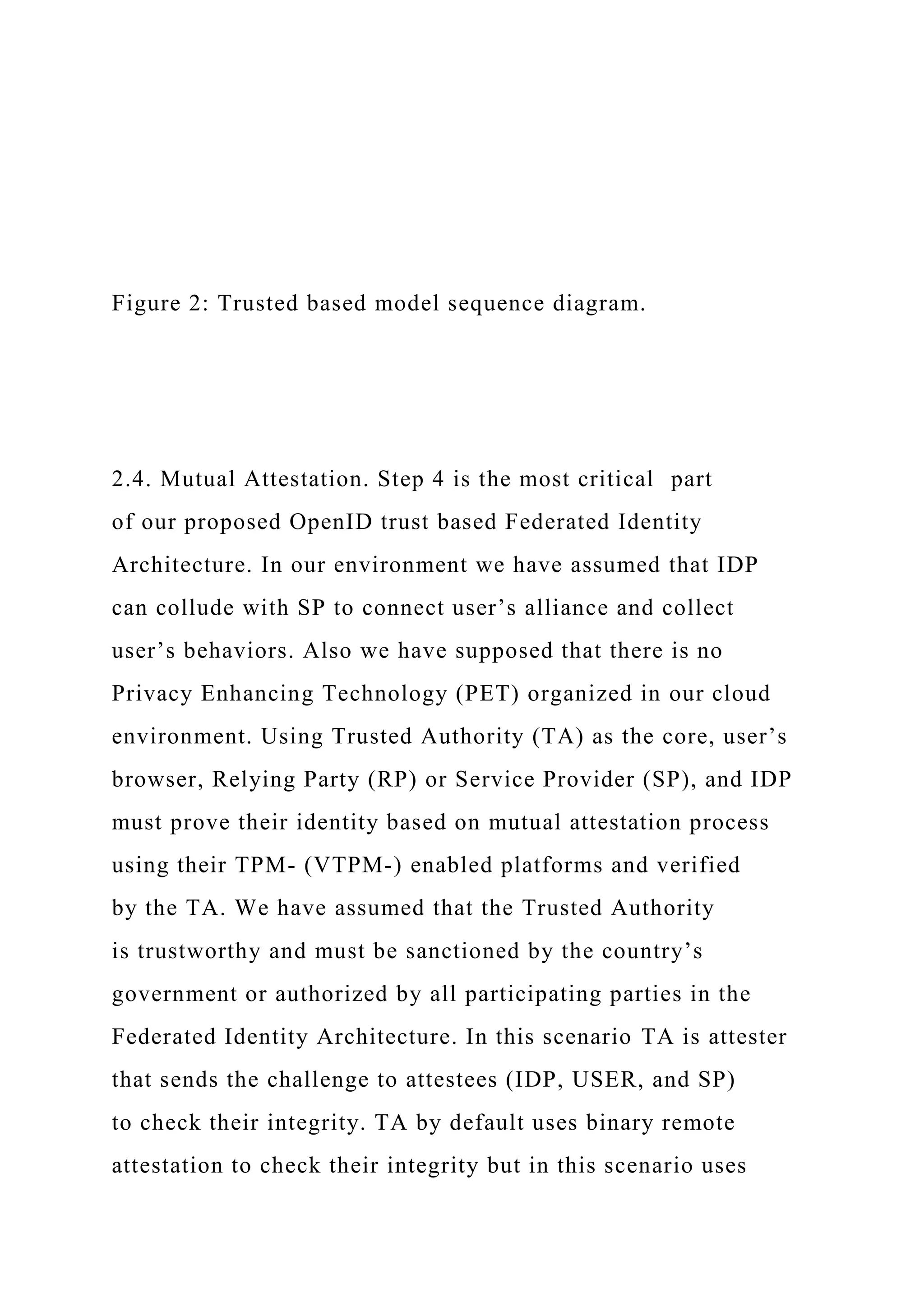
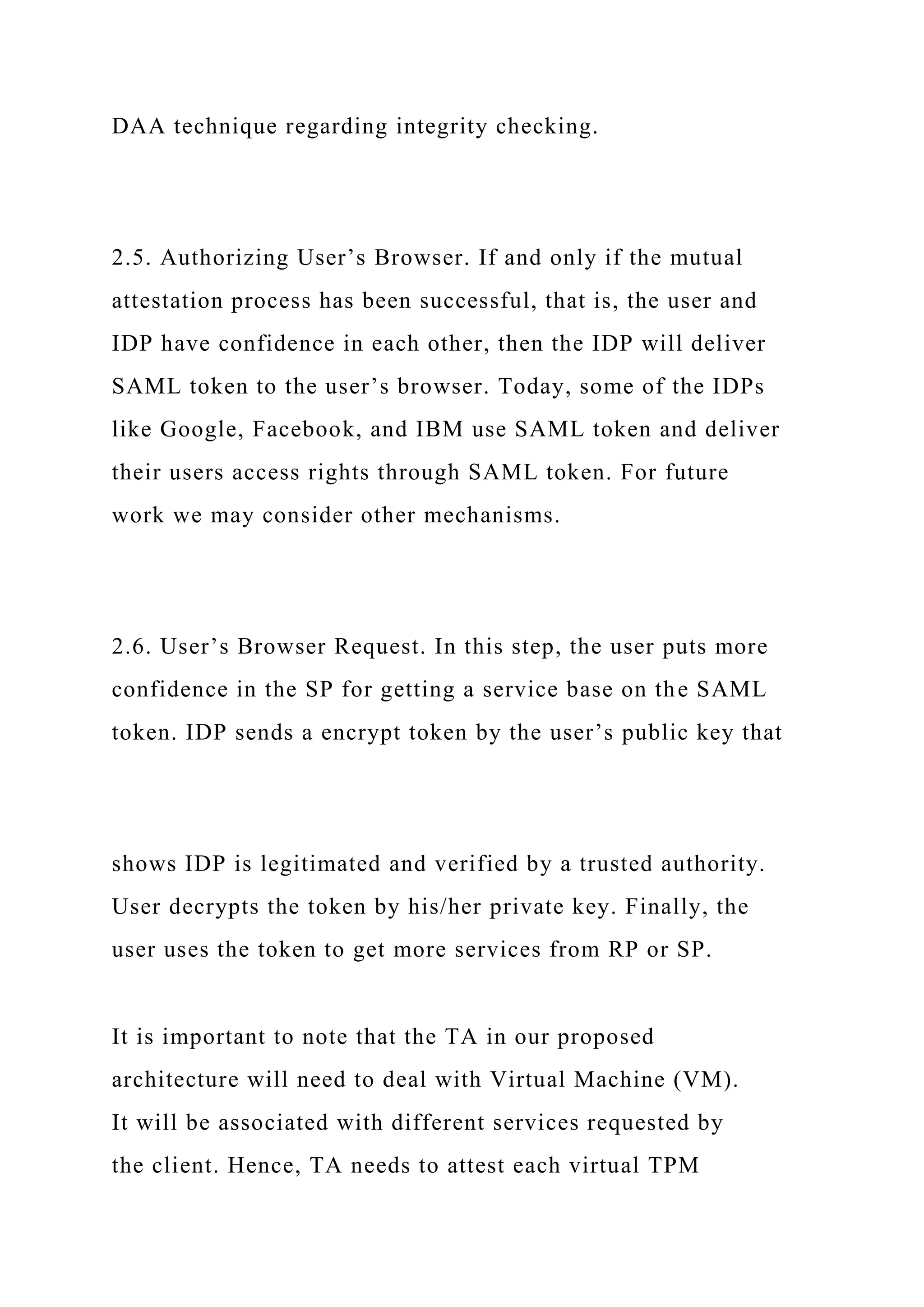
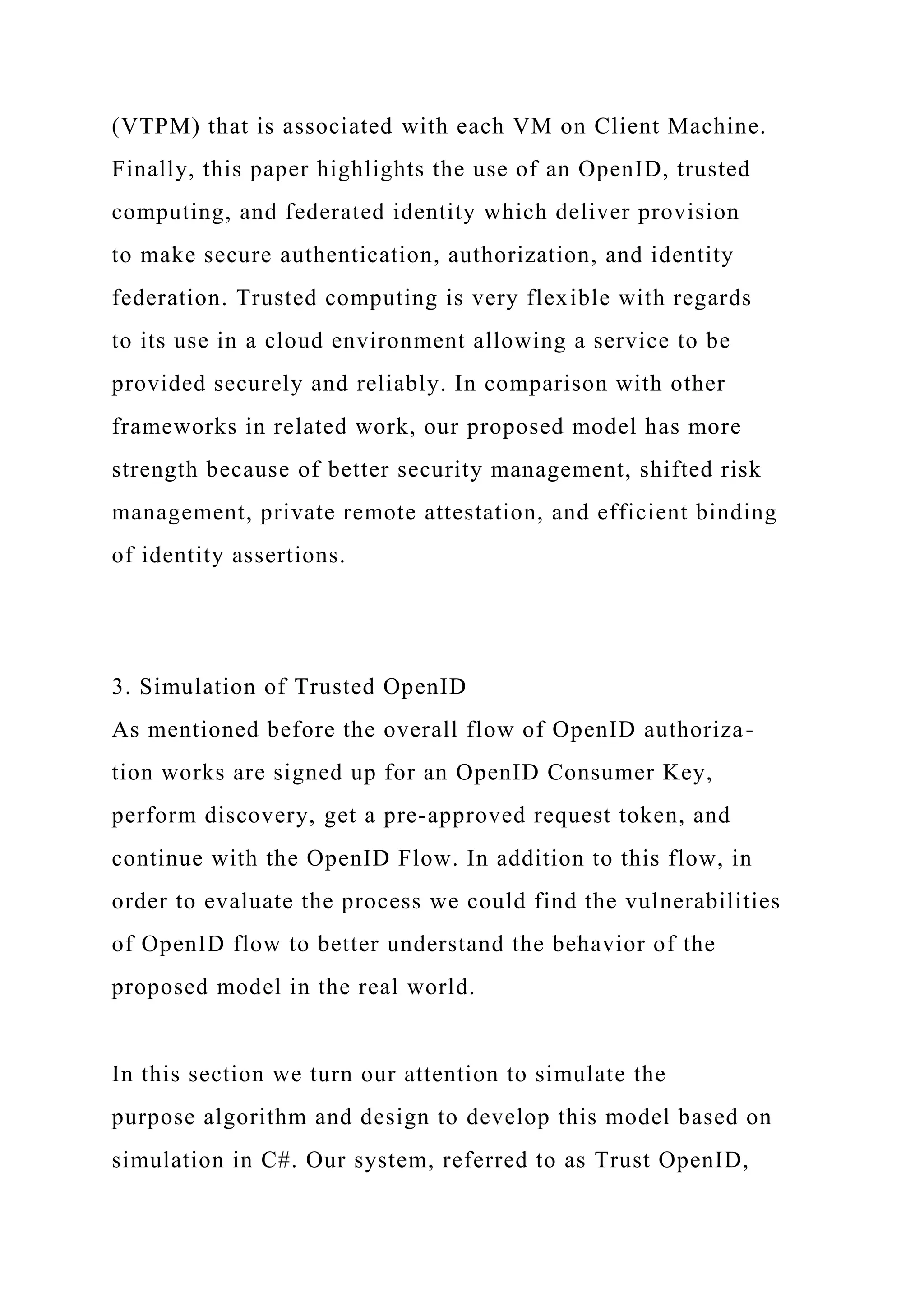

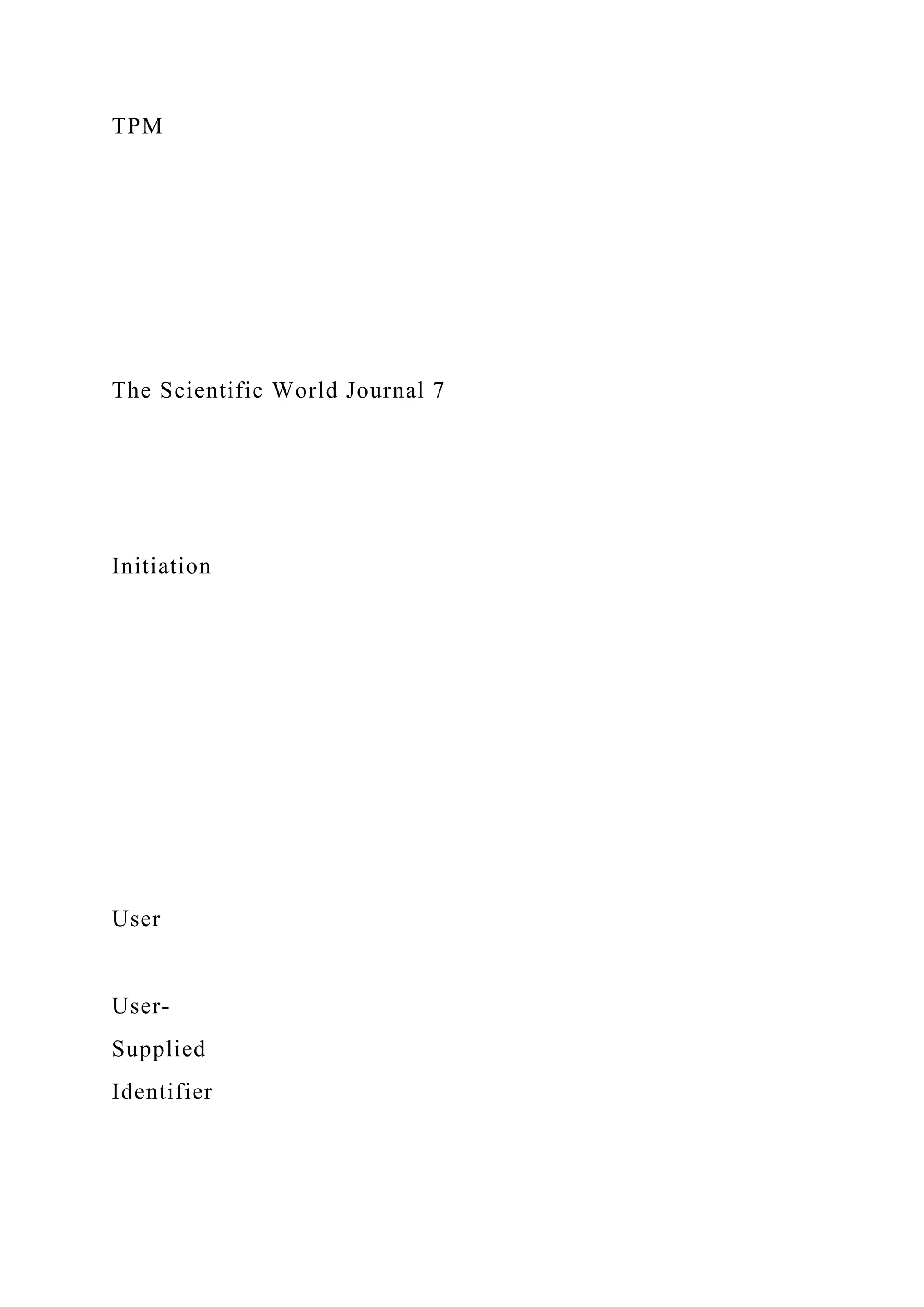
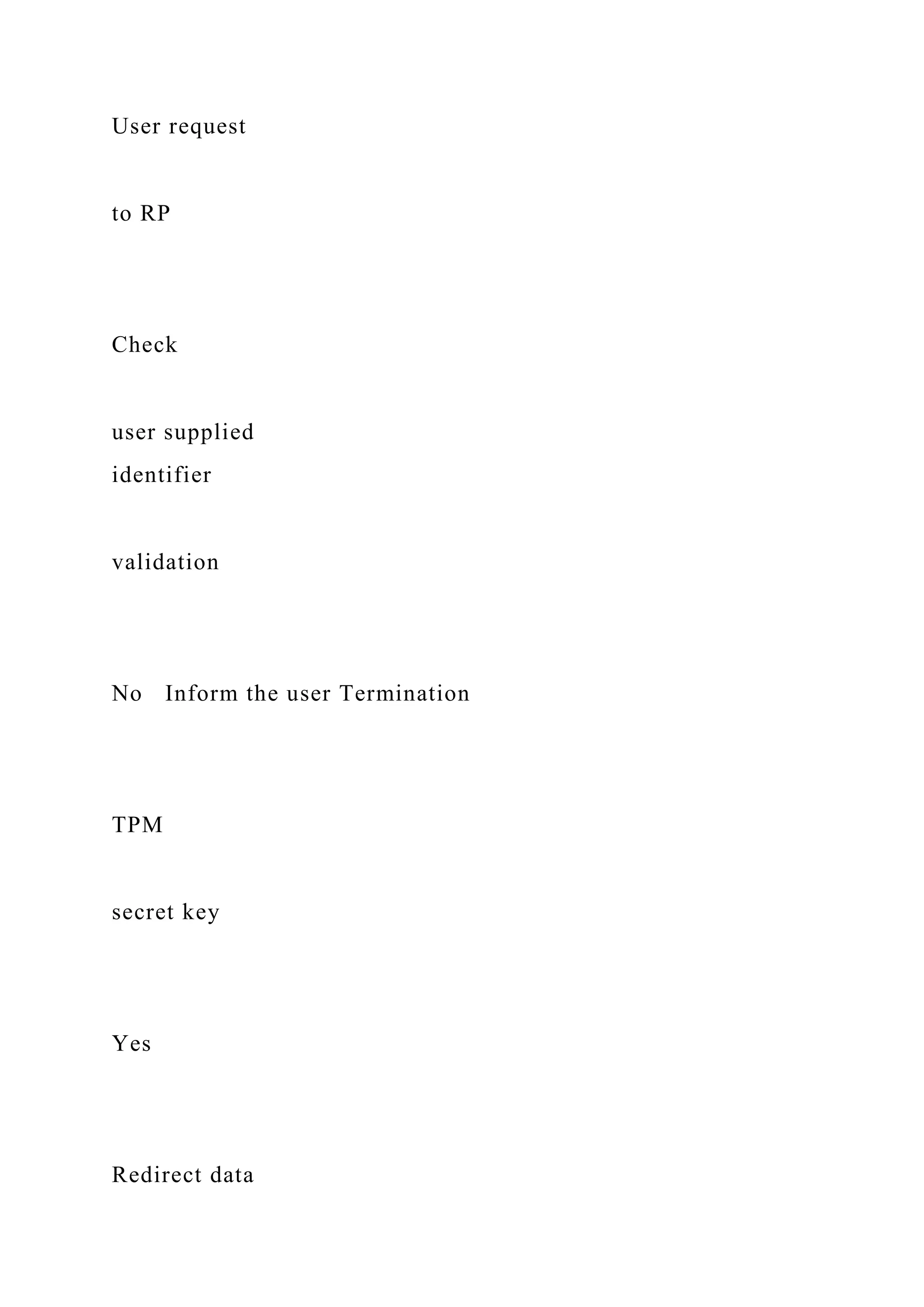


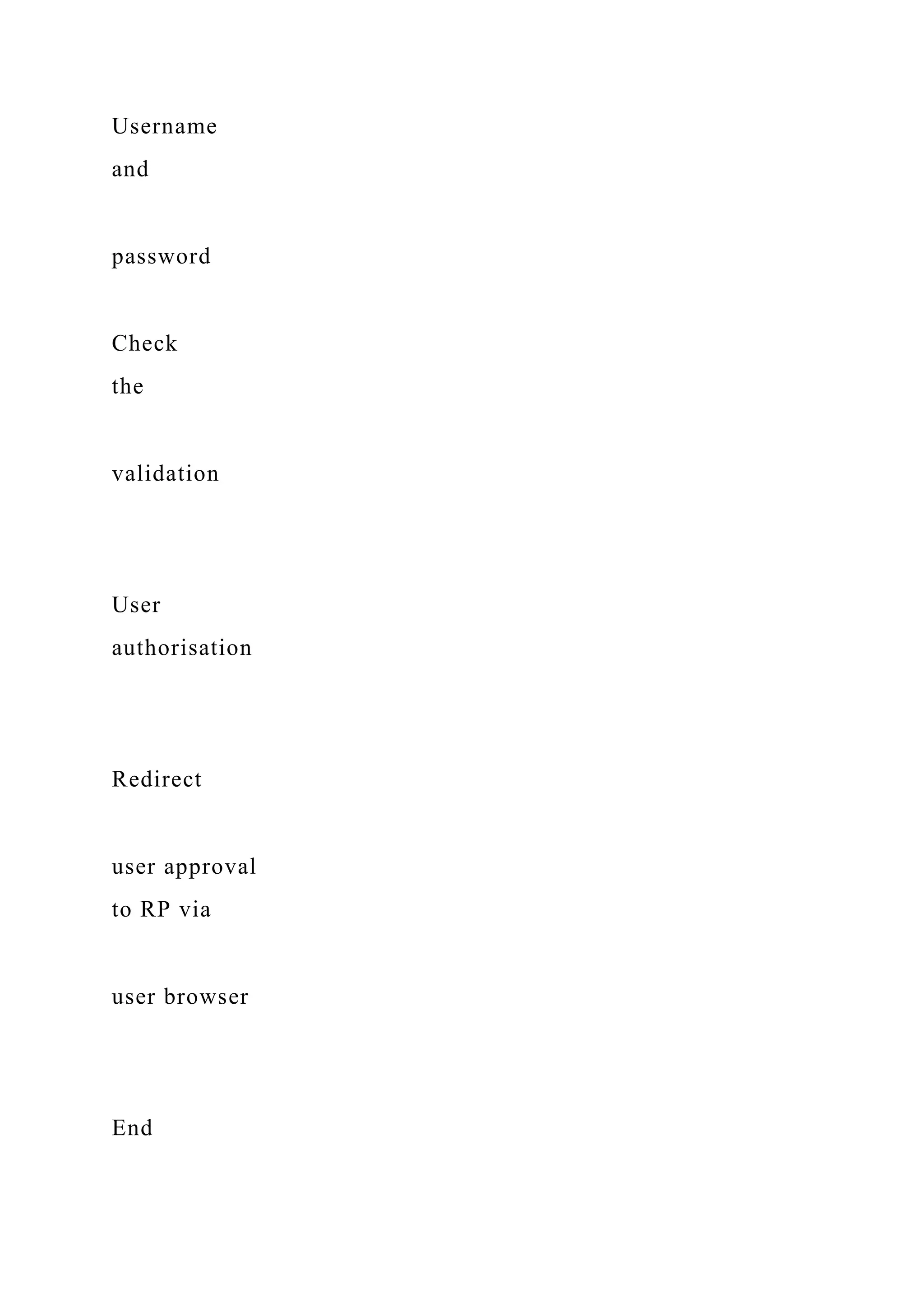

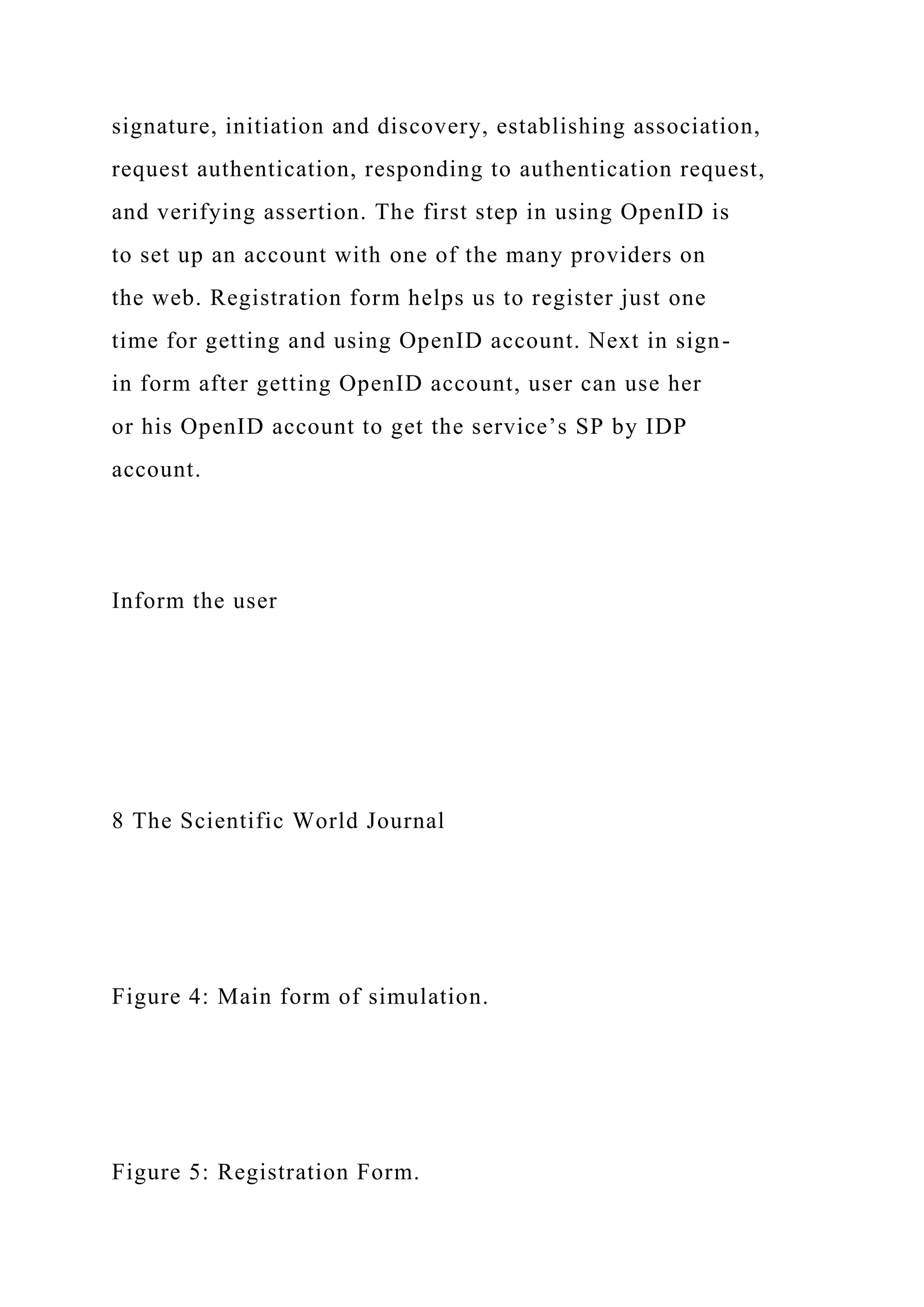
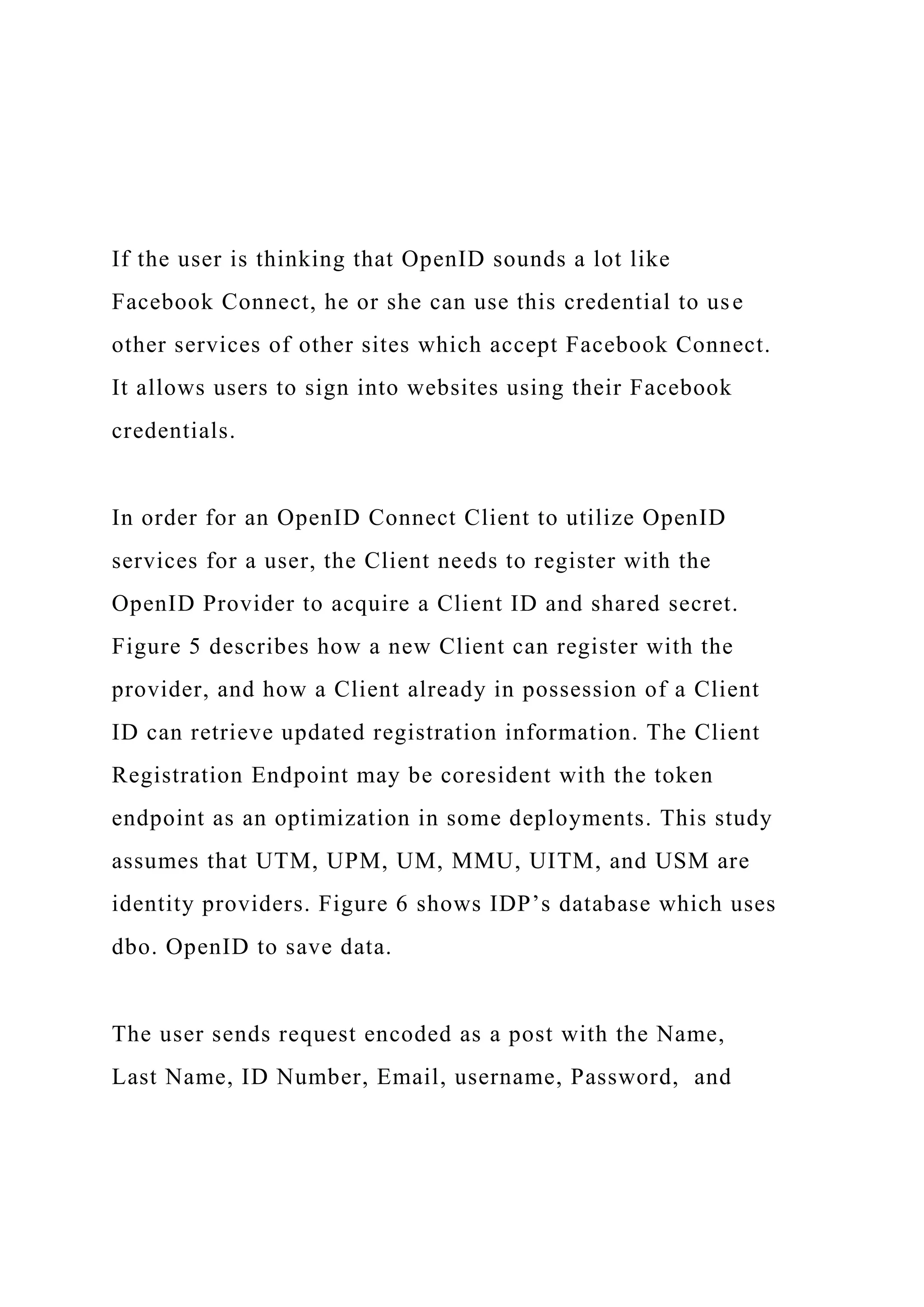

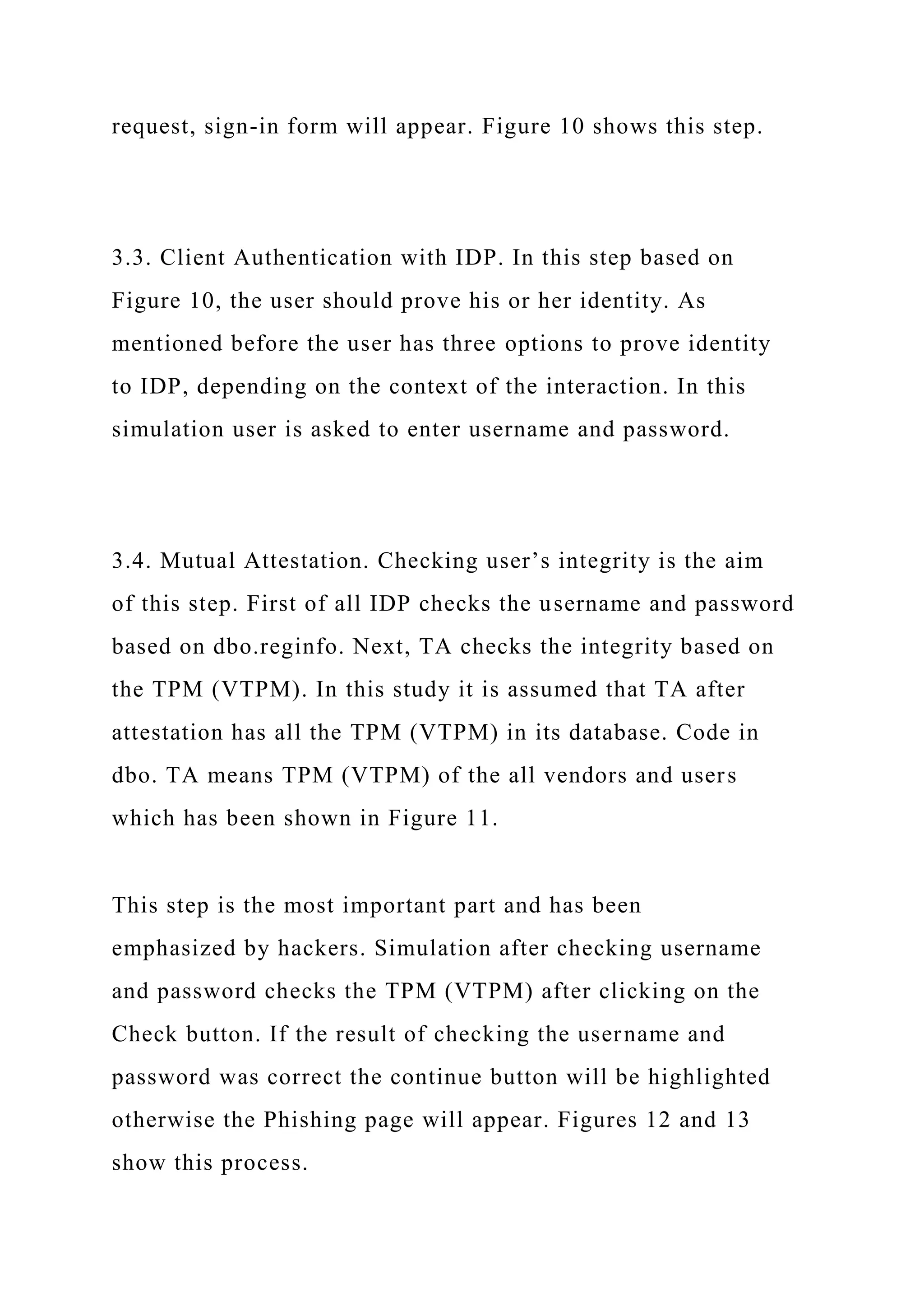
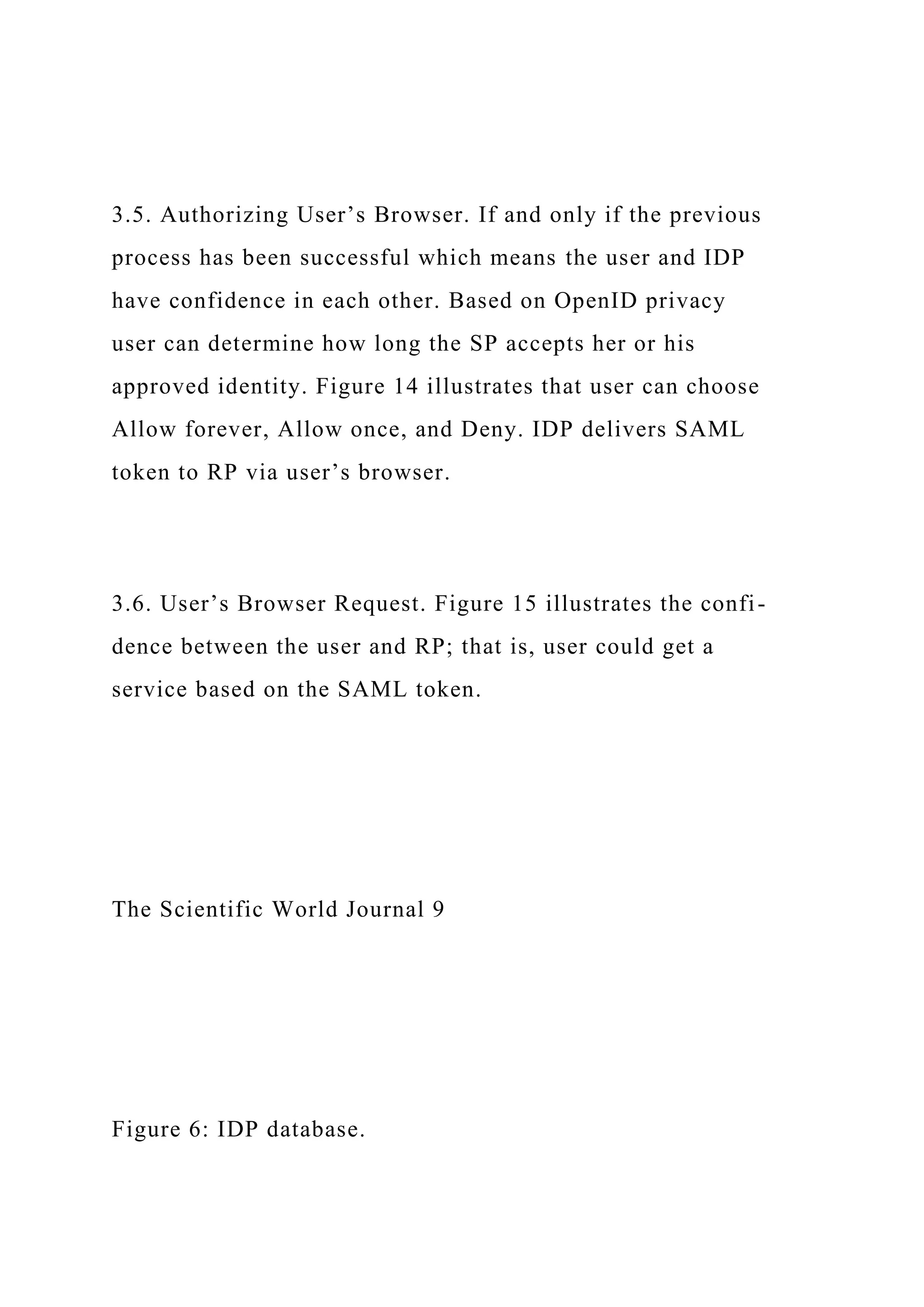
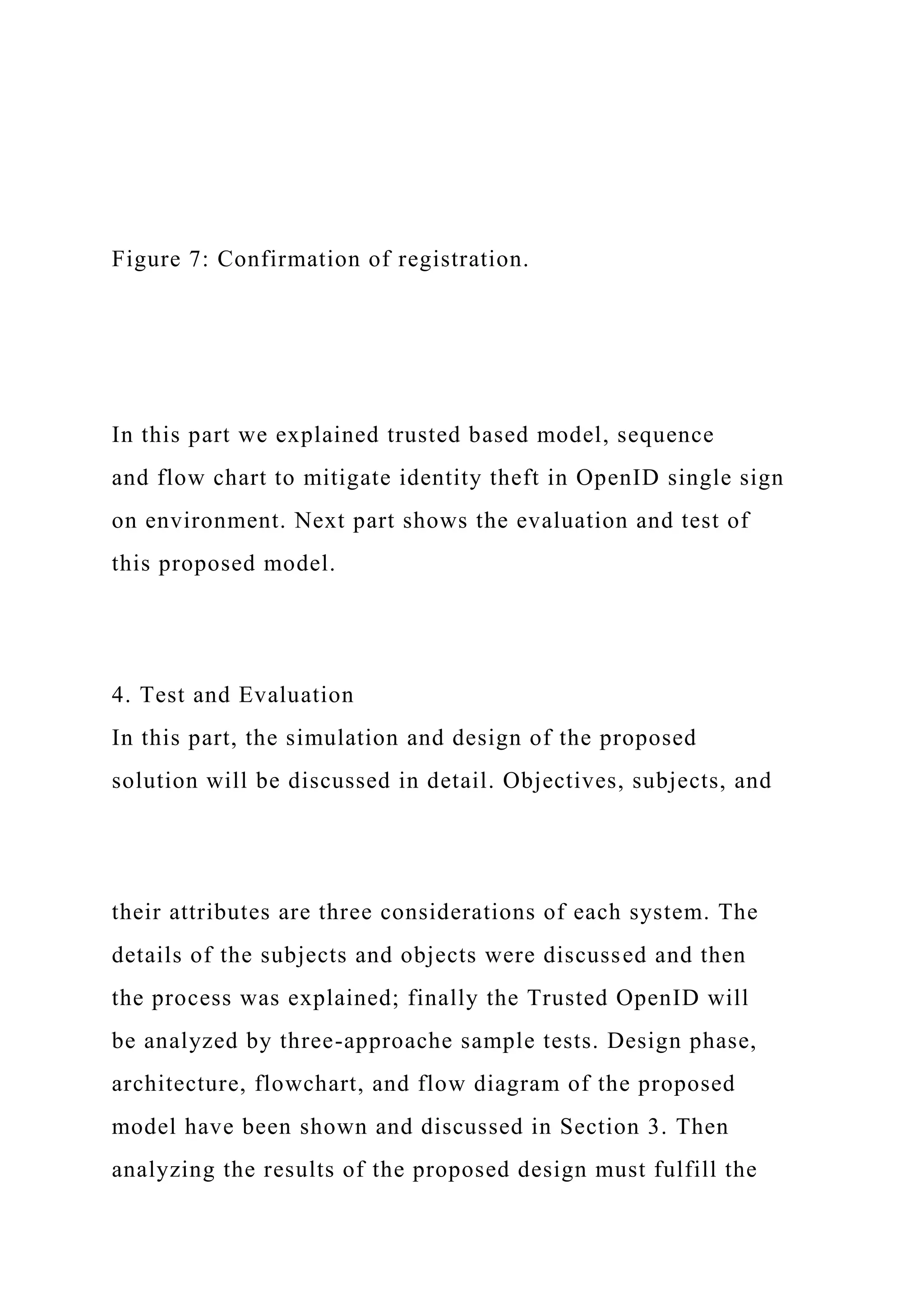
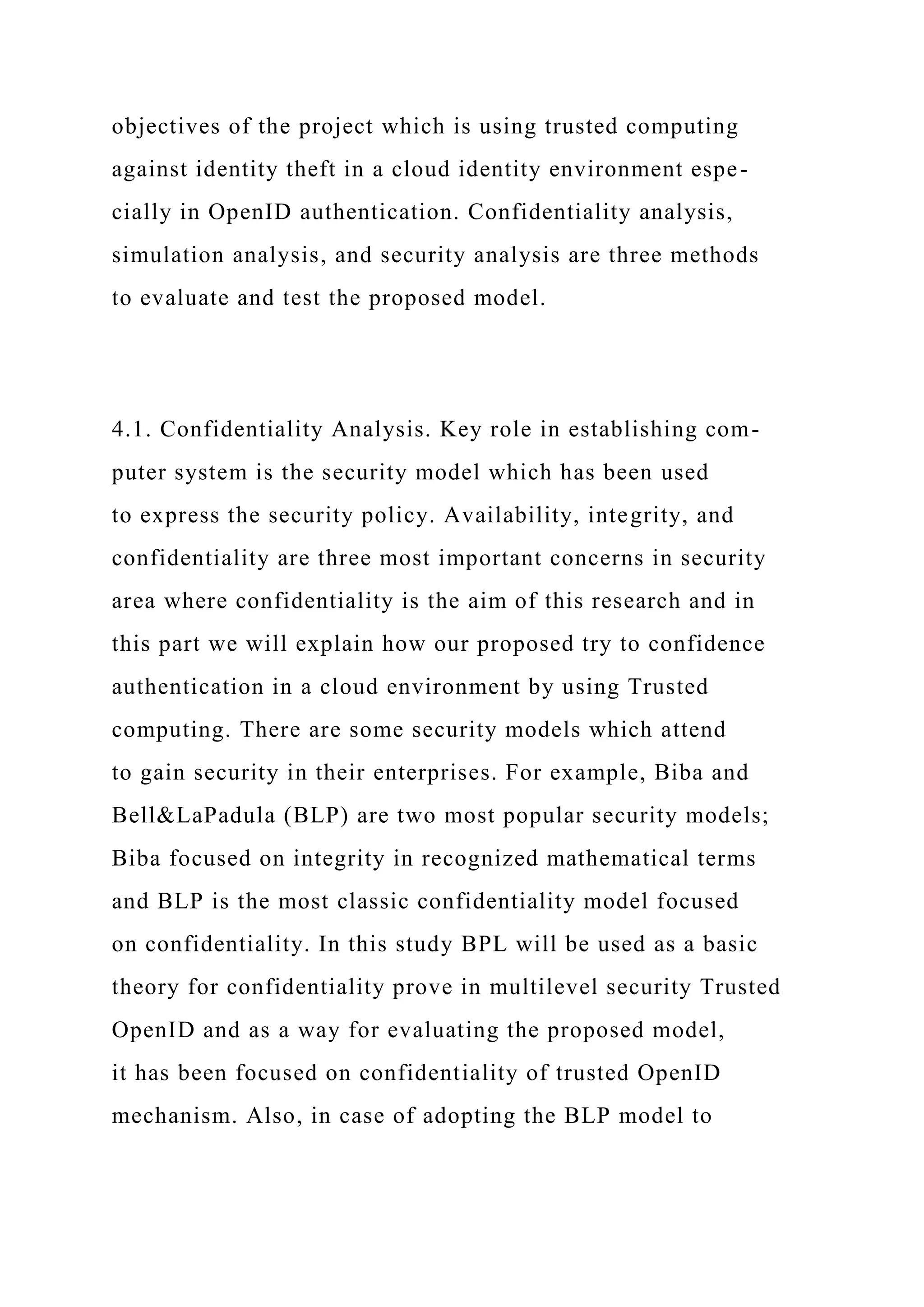
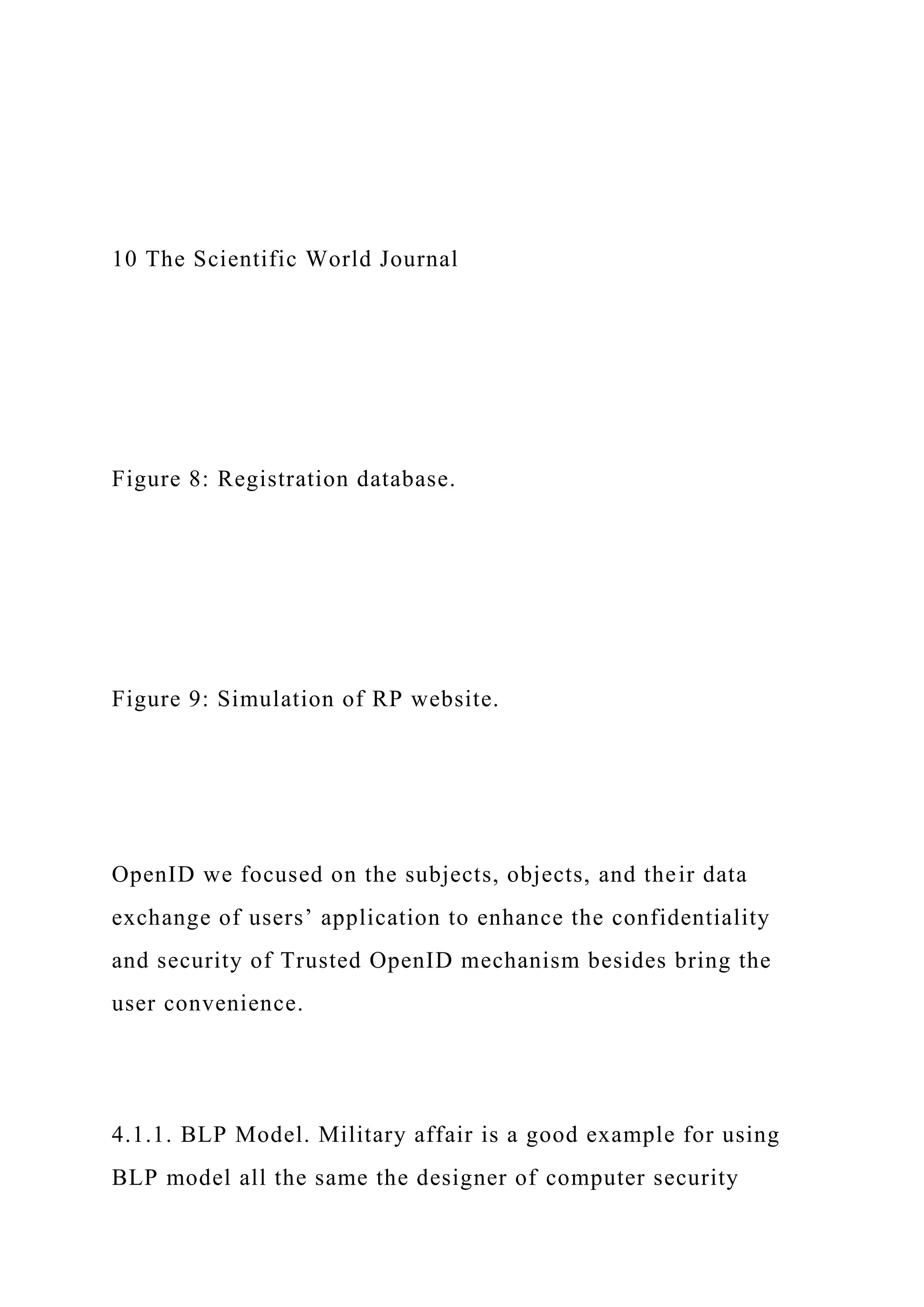
![utilized and applied to contribute to computer security. While
this model has so many advantages, but there are some
Figure 10: IDP Sign on.
disadvantages such as forgetting access history [15]. Security
level and access matrix are two main parts in BLP model
which define the access permissions. Security policies accept
information flowing upwards from a low security level to
a high security level and also prevent information flowing
downwards from a high security level to a low security level.
4.1.2. Terminology
Identifier (I): an Identifier is either an “http” or “https” URI,
commonly referred to as a “URL” within this document or an](https://image.slidesharecdn.com/1-221101035239-dffccca1/75/1-Security-and-vulnerability-assessment-analysis-tool-Microsoft-docx-198-2048.jpg)

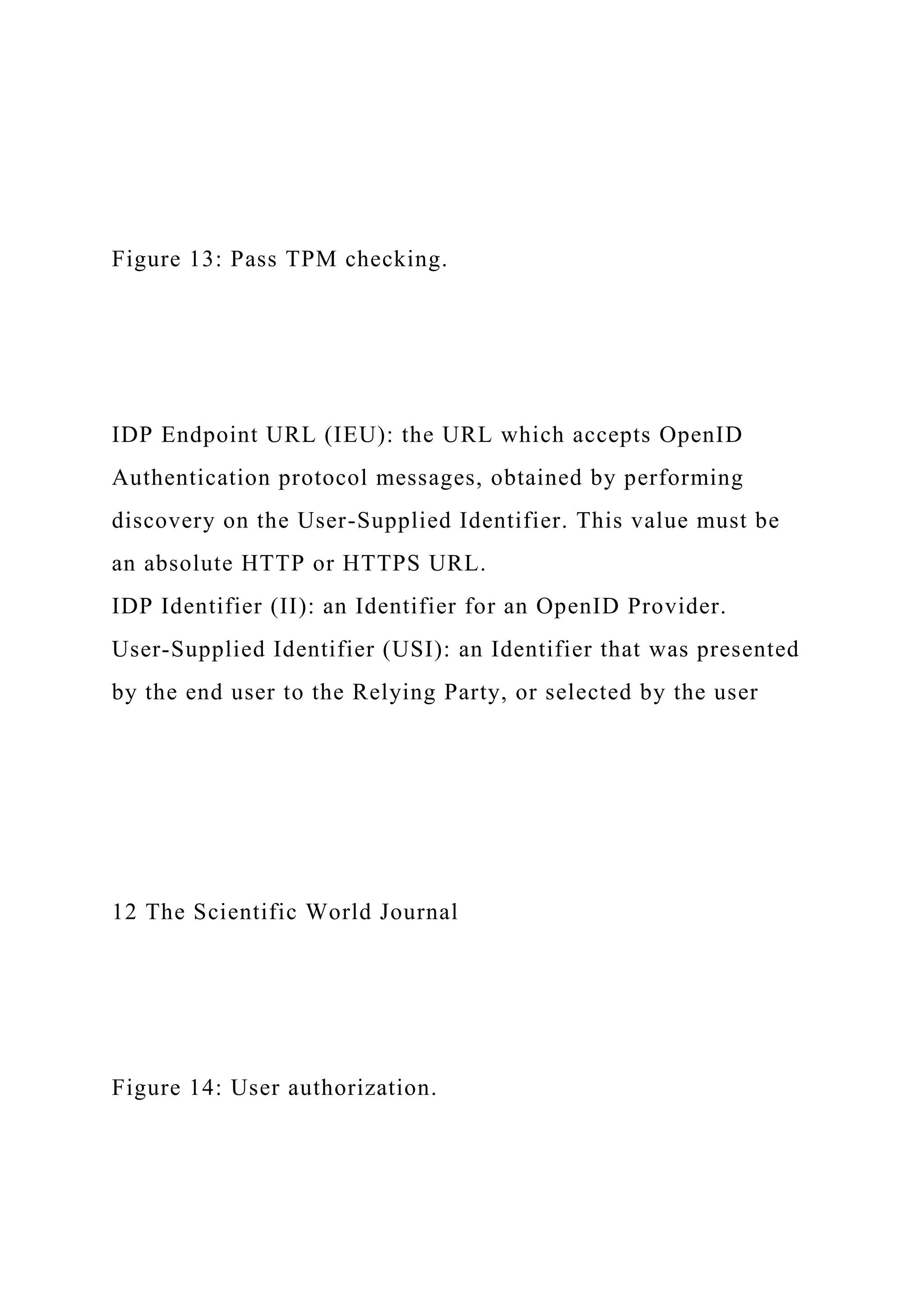

![As mentioned before TA by default uses binary remote
attestation to check their integrity but in this scenario uses
DAA technique regarding integrity checking.
Trusted Authority (TA): an enterprise to verify mutual attes-
tation process using the TPM- (VTPM-)enabled platforms.
Figure 16 shows completely the objects and subjects of the
proposed model and the place based on the final OpenID
authentication architecture. These subjects and objects help
to end user to prove that he or she owns a URL or XRI
through a series of communications between the user and the
website to which he/she is authenticated. The user submits the
URI/XRI identifier at OpenID Relying Party through User-
Agent’s browser.
4.1.3. Protocol Overview. Based on the OpenID authentica-
tion [22] in the first step, the end user initiates authentication
by presenting a USI to the RP via their UA. To initiate OpenID
Authentication, the RP should present the end user with a
form that has a field for entering a USI.
Next, after normalizing the USI, RP performs discovery
on USI and establishes the IEU that the end user uses for
authentication. Upon successful completion of discovery, RP](https://image.slidesharecdn.com/1-221101035239-dffccca1/75/1-Security-and-vulnerability-assessment-analysis-tool-Microsoft-docx-202-2048.jpg)
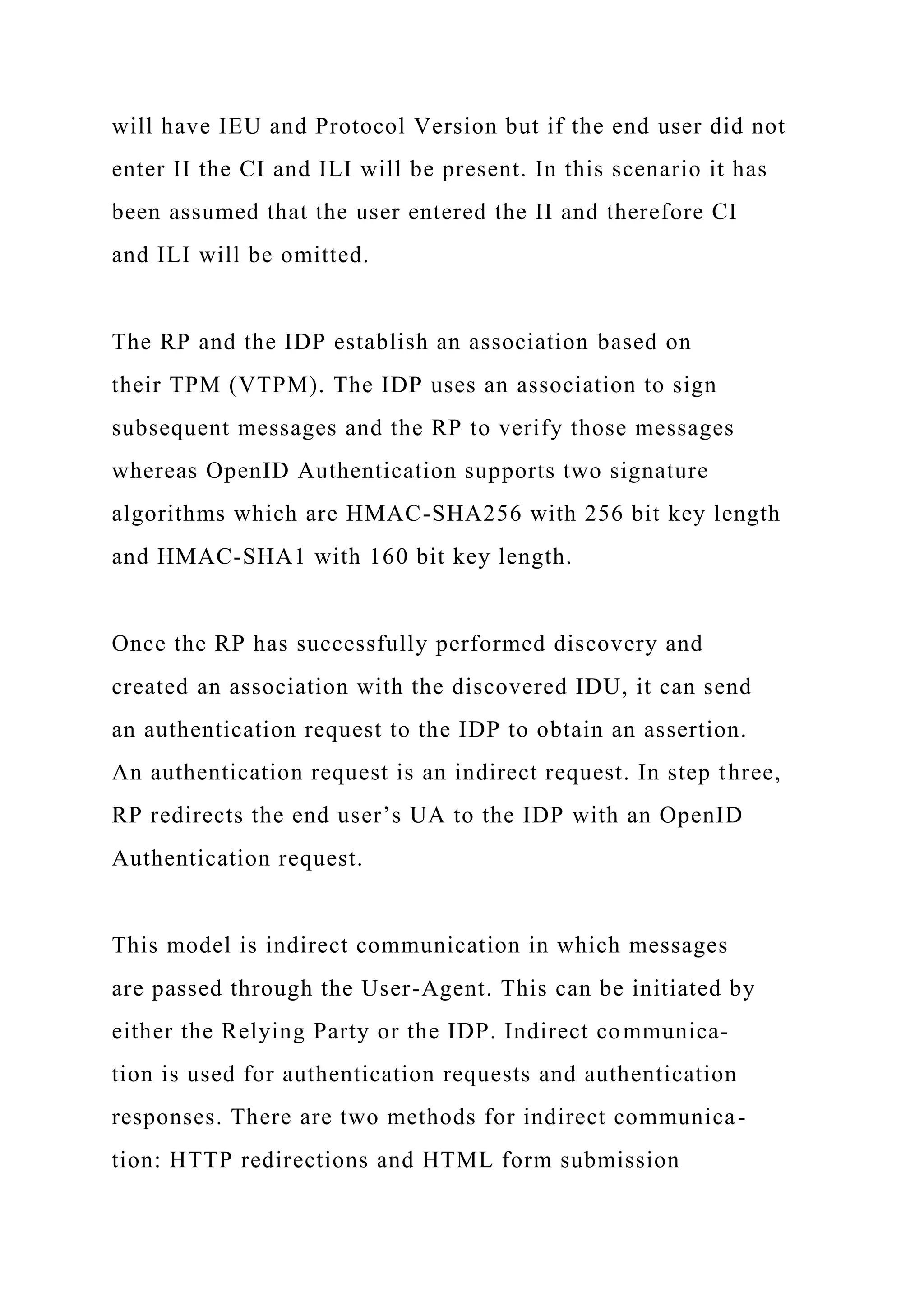
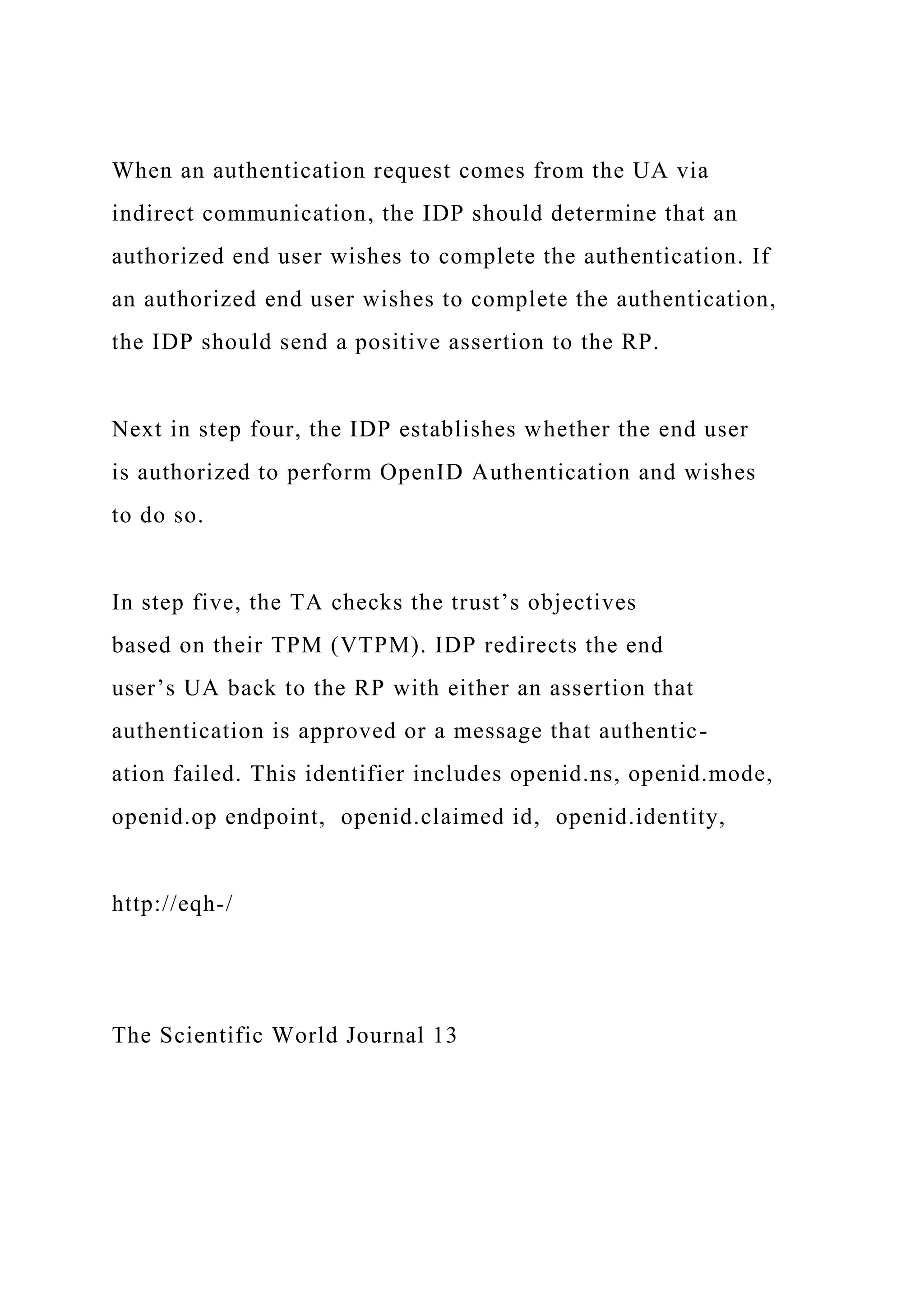

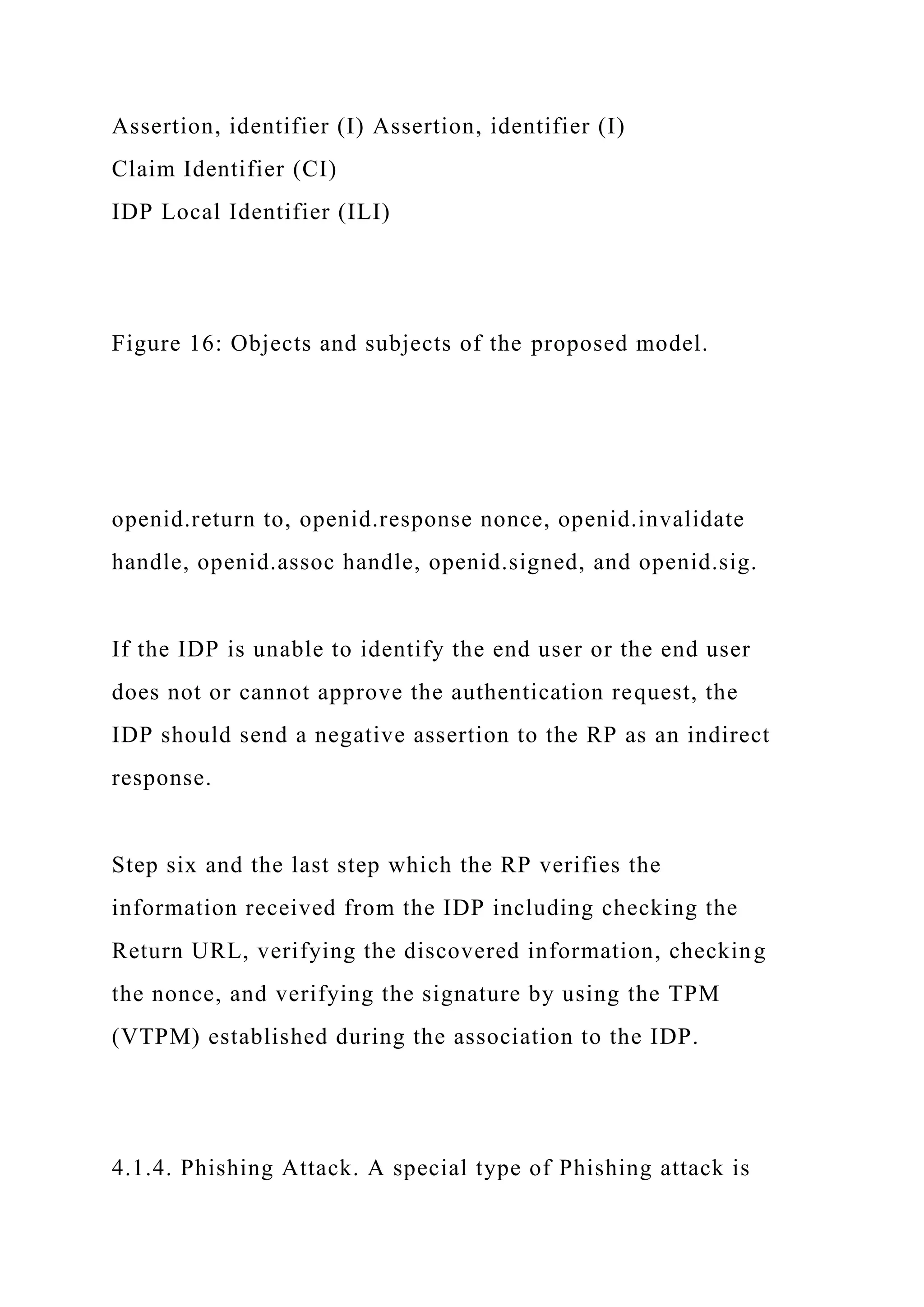
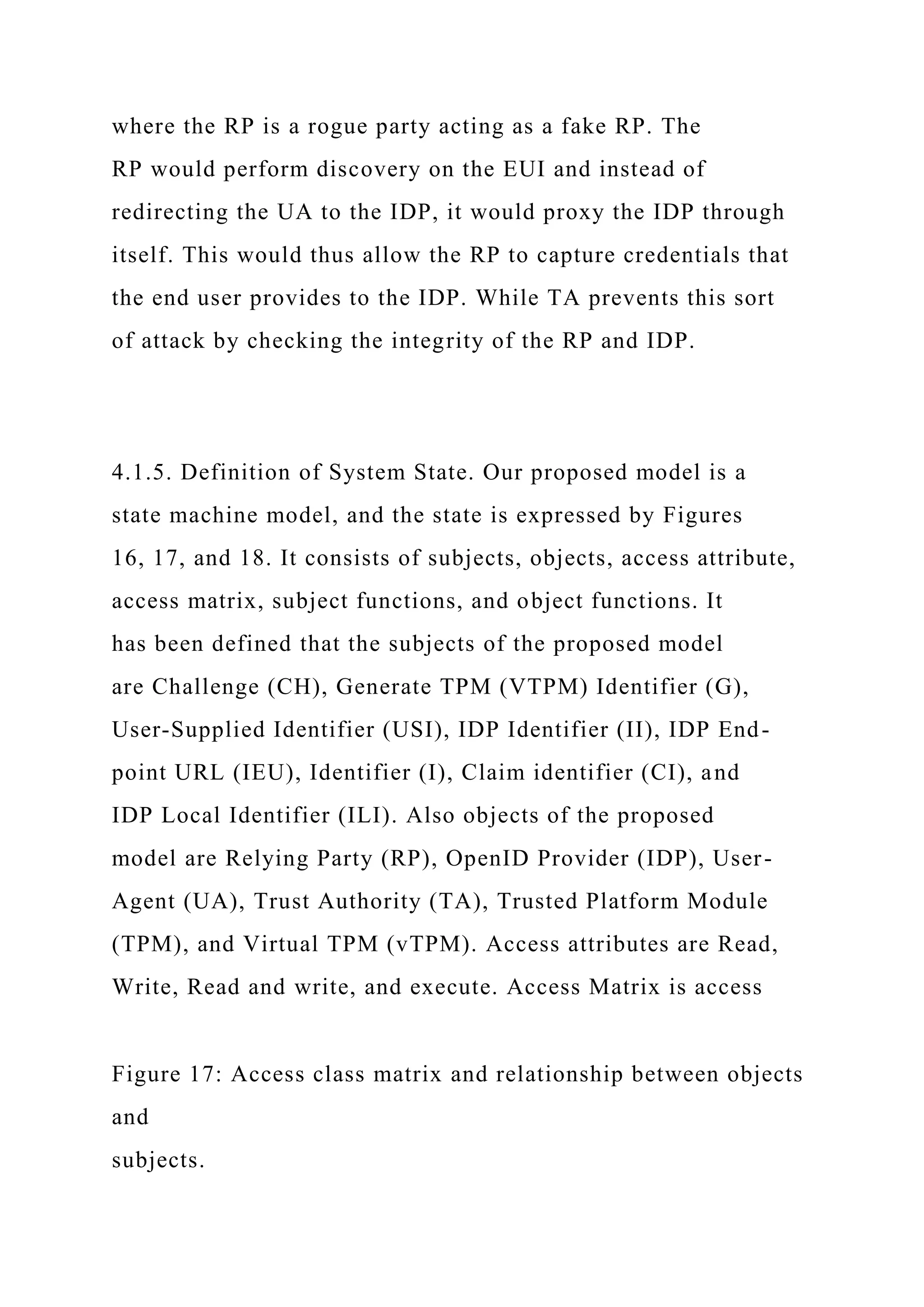
![matrix, where each member represents the access authority
of subject to object.
The proposed model state machine is �� where each
member of �� is ��.
(1) �� ∈ �� where �� is sorted quaternion.
(2) �� = (��, ��, ��, ��), where,
(3) �� ⊆ (�� × �� × ��),
(4) �� is a set of subjects.
(5) �� is a set of objects.
(6) �� = [��, ��, ��, ��] is the set of access attribute.
(7) �� is access matrix, where ���� ⊆ �� signifies the
access
authority of ���� to ����.
(8) ∈ �� is the access class function, denoted as �� =
(����, ����).
TPM](https://image.slidesharecdn.com/1-221101035239-dffccca1/75/1-Security-and-vulnerability-assessment-analysis-tool-Microsoft-docx-208-2048.jpg)
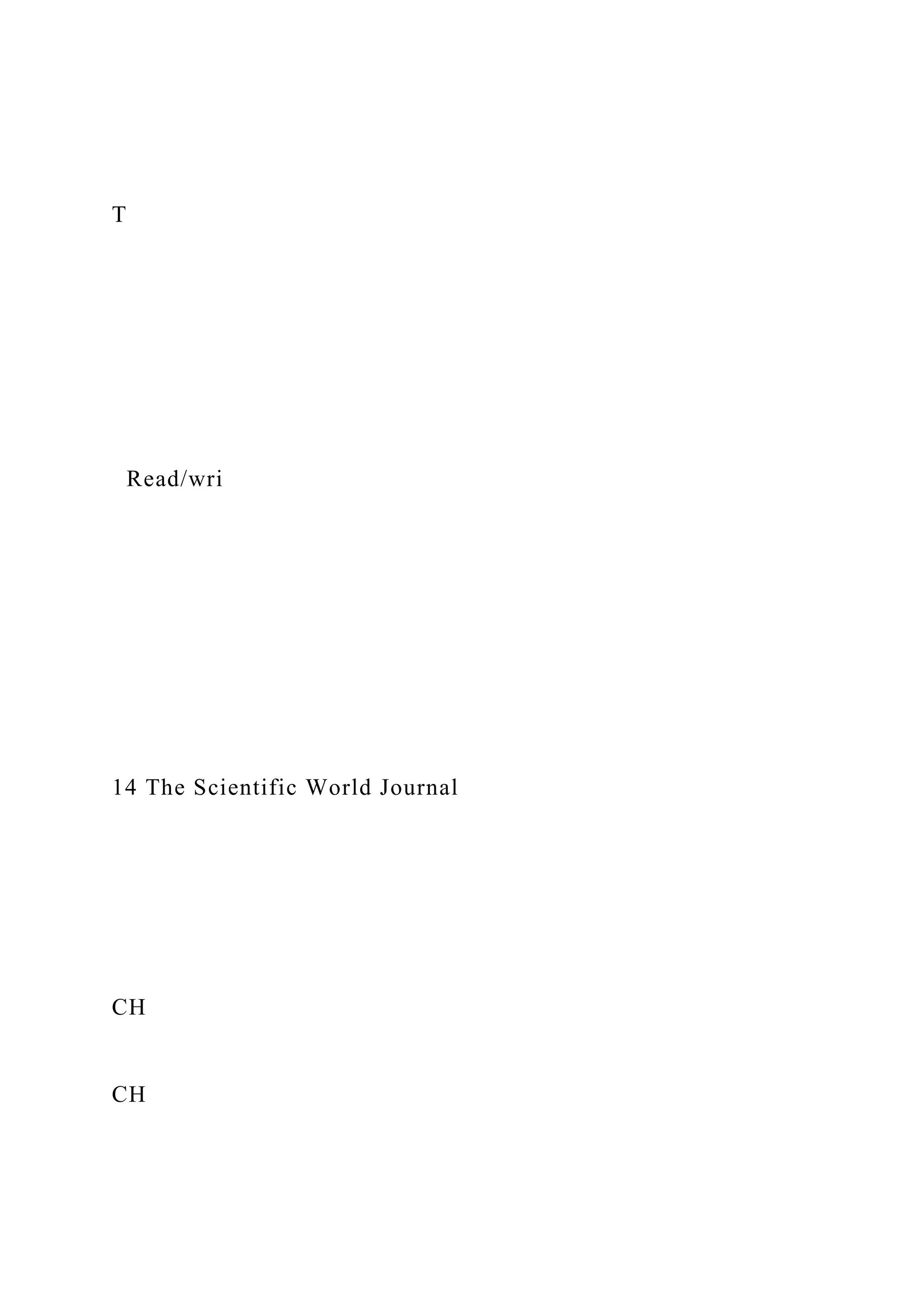
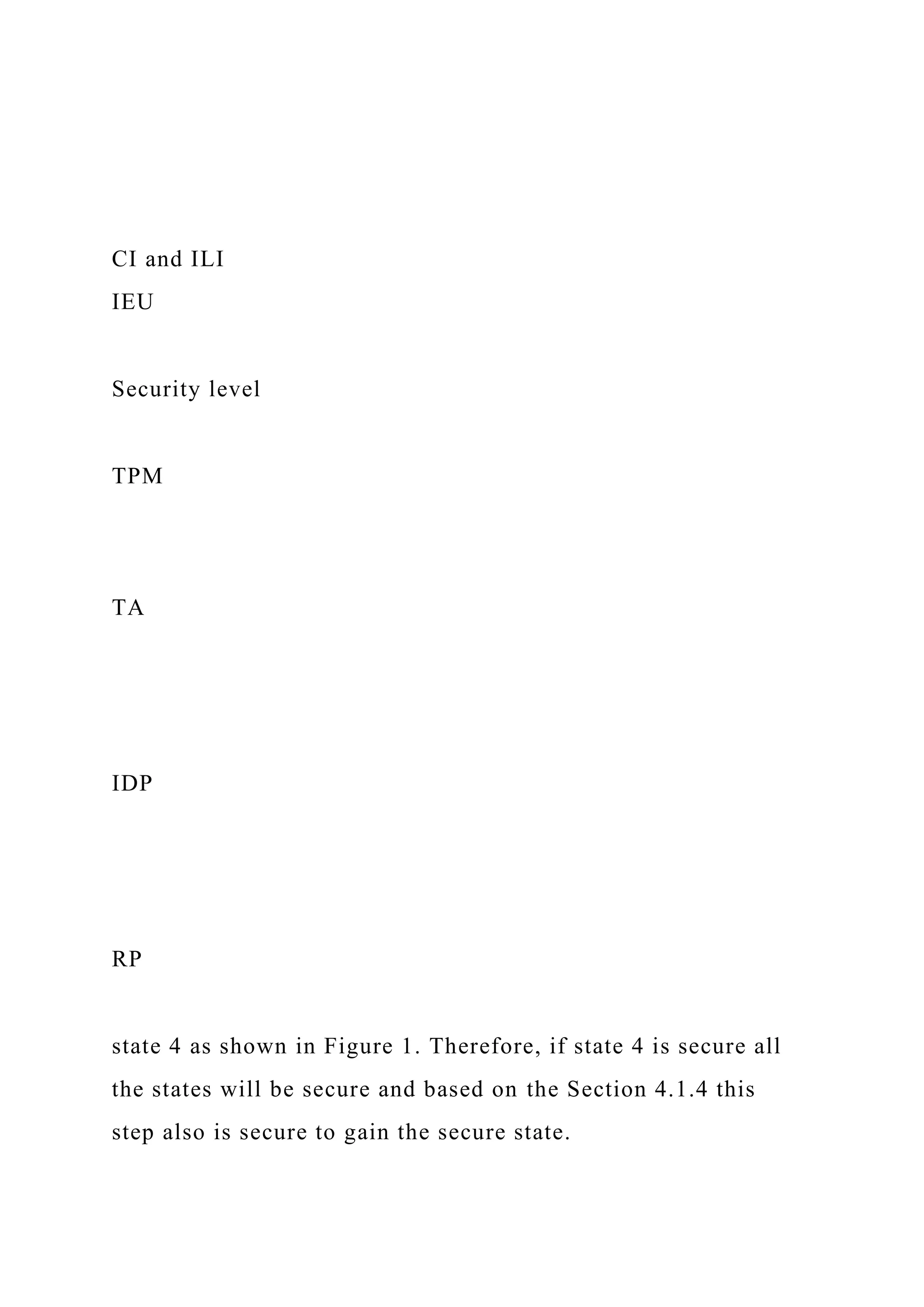
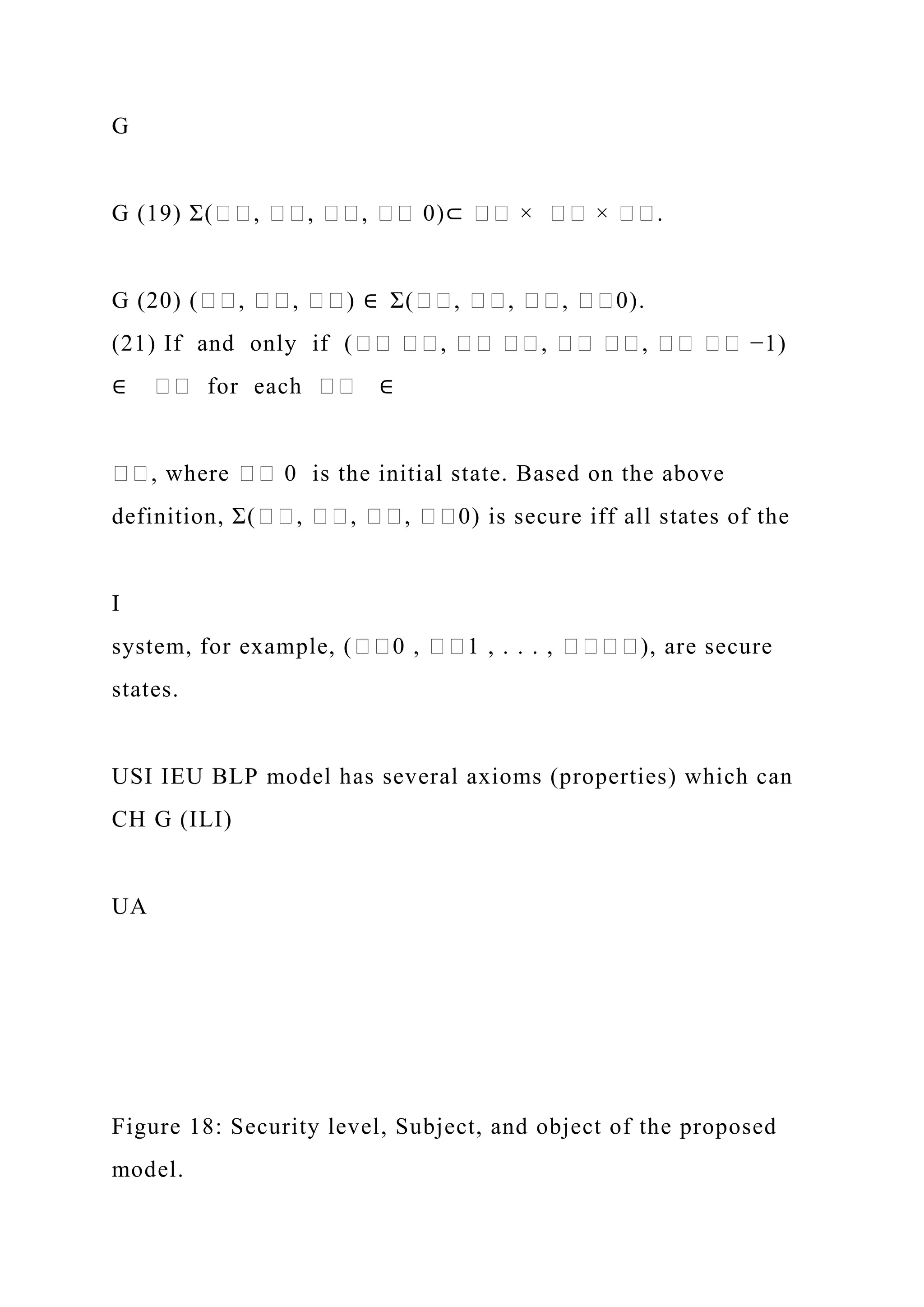

![���� (��))],
shows the relation the entire subjects, objects, security
functions, security level of the proposed model. As
shown in this figure confidentiality of the TPM
(VTPM) is highest in the state machine and the lowest
is the user agent. Therefore,
(11) Confidentiality level is ��1(������),
��2(����), ��3(������),
��4(����), and level ��5(����).
(12) �� signifies the existing Hierarchy on the
proposed model as shown in Figure 18.
(13) ��: �� × �� → × �� shows all therolese in the
proposed
model in which �� is the system response and the next
state. �� is the requests set and �� is the arbitrate set
of the request which is yes, no, error, and question.
In this study question is important because if the
response equal to question, it means that the current
rule cannot transact with this request.
(14) �� = [��1 , ��2 , . . . , ����], where �� is the list](https://image.slidesharecdn.com/1-221101035239-dffccca1/75/1-Security-and-vulnerability-assessment-analysis-tool-Microsoft-docx-213-2048.jpg)
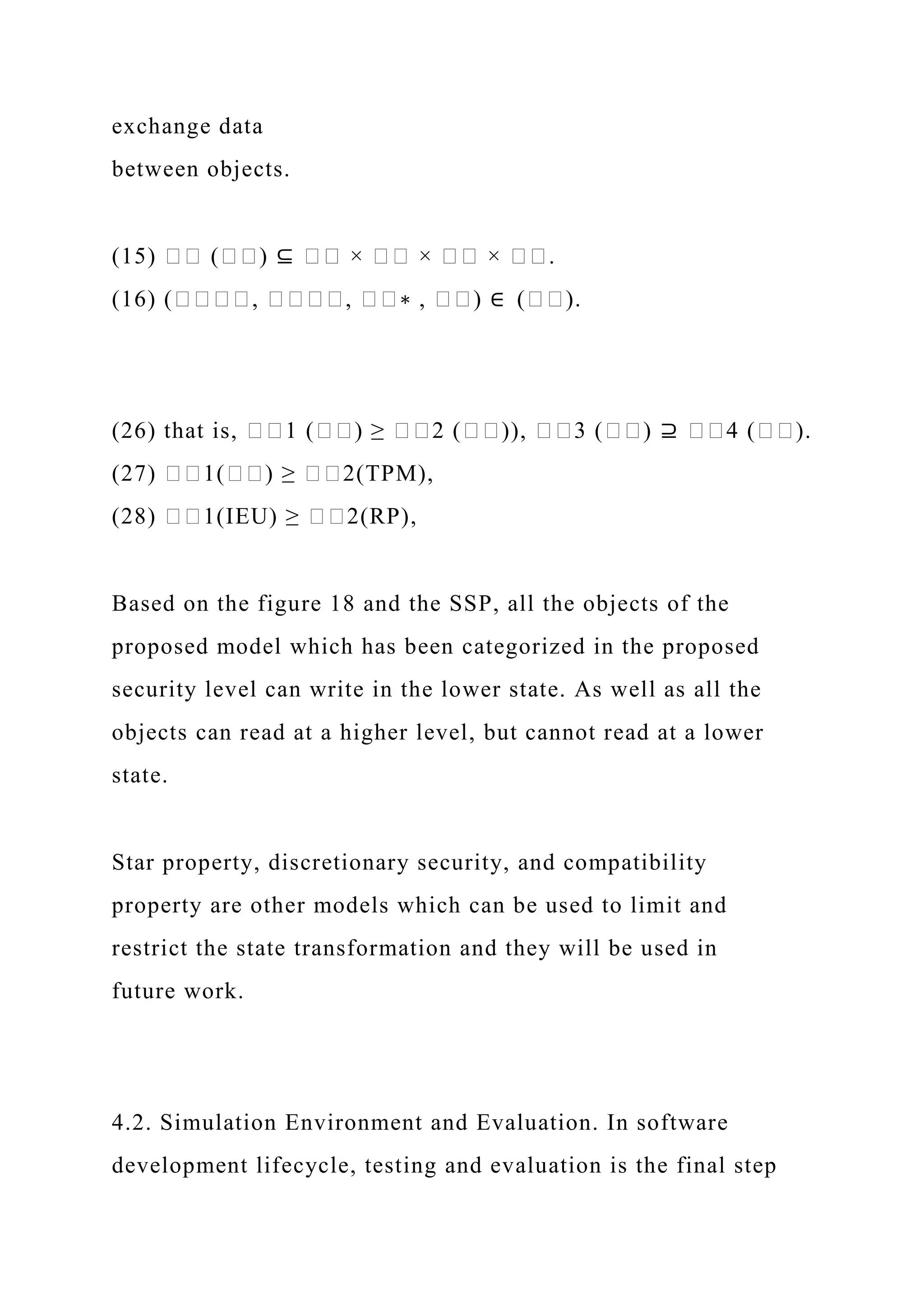
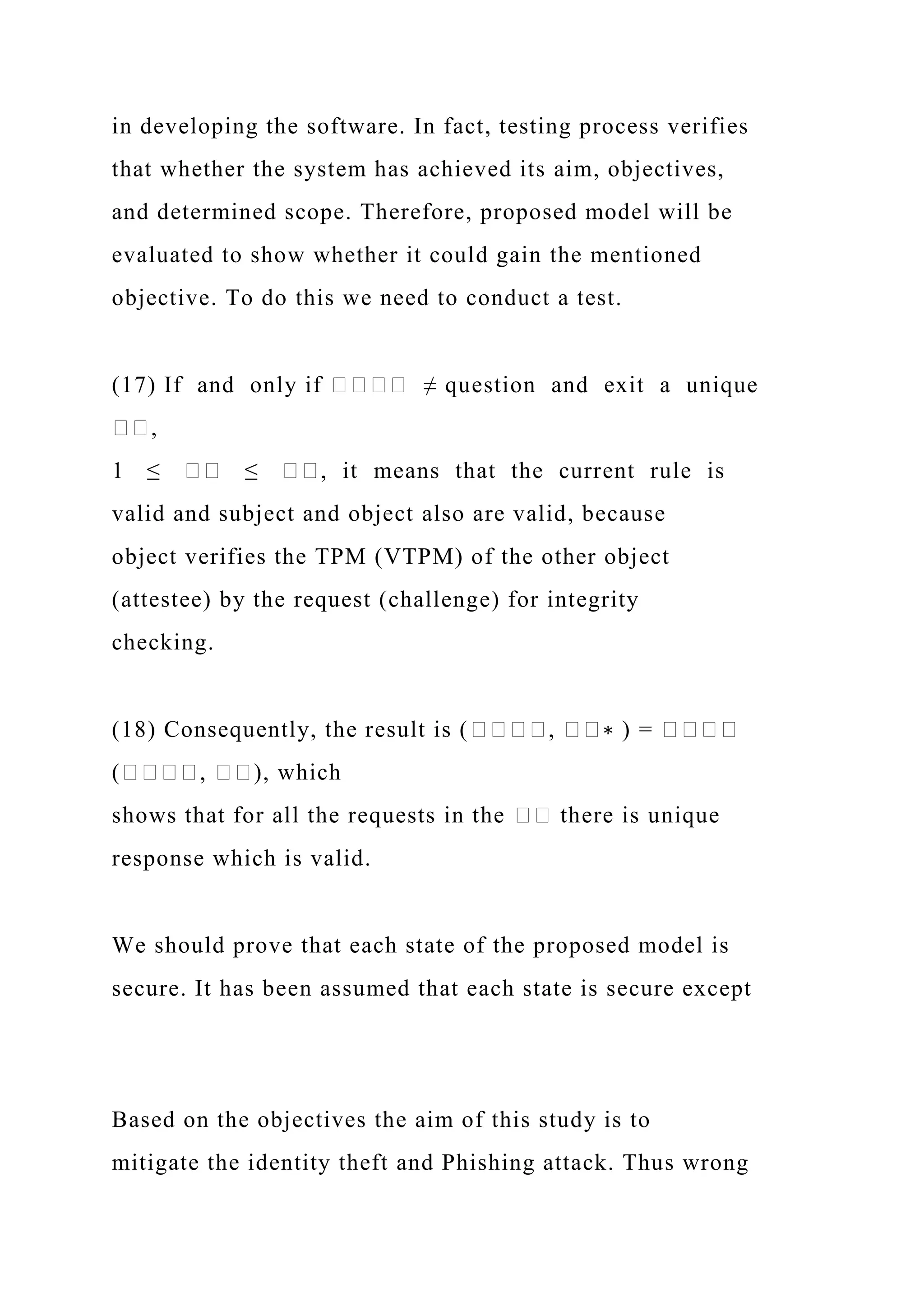
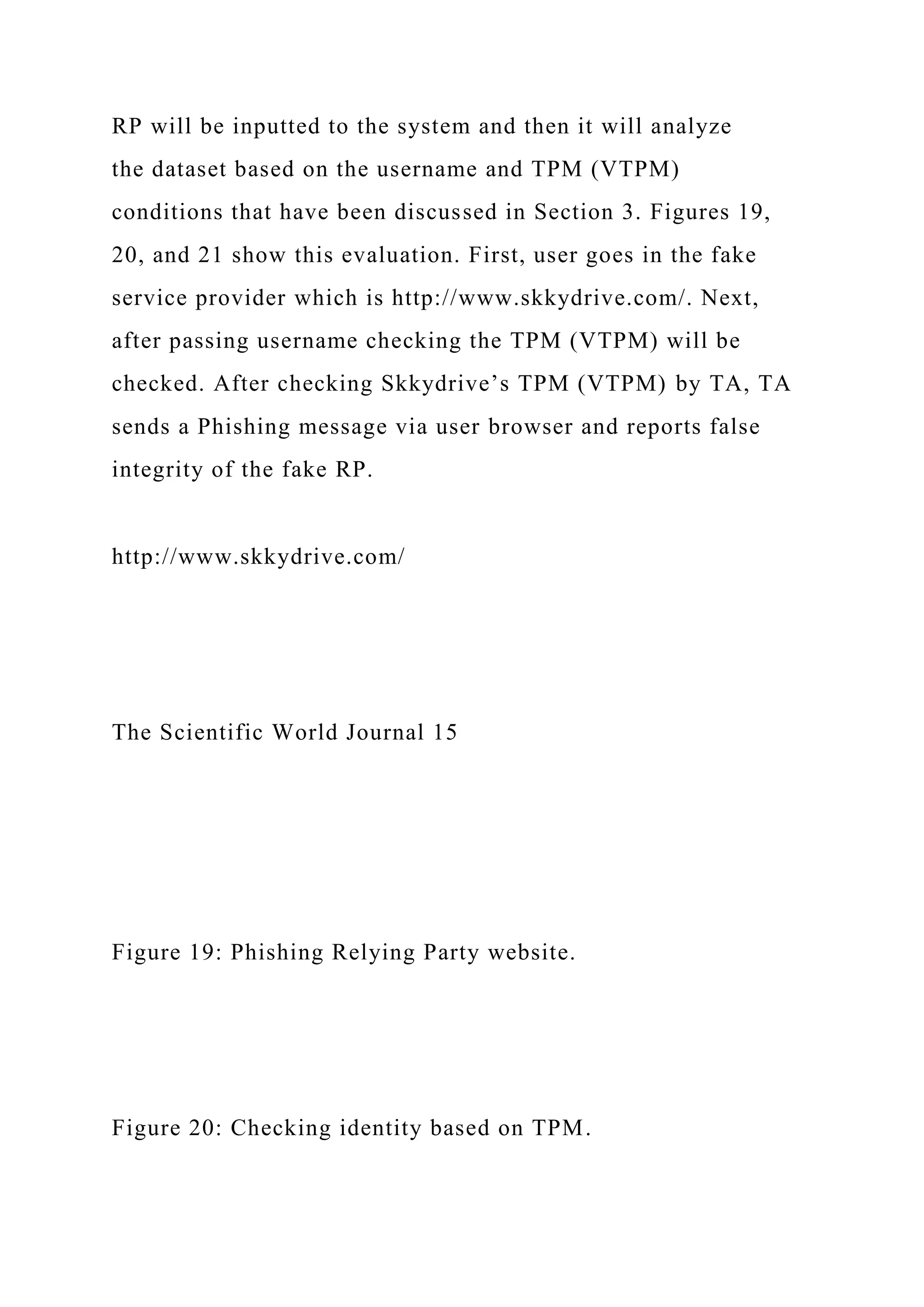

![Figure 21: TA reports phishing message.
certificates and the fact that it is difficult to compromise the
components. The attacker is assumed to call TPM (vTPM)
commands without bounds and without knowing the TPM
(vTPM) root key, expecting to obtain or replace the user
key. The analysis goal in TPM (vTPM) study is to guarantee
the corresponding property of IDP, the user, RP execution,
and the integrity of them [21, 23]. Also, the overall aim
of the proposed model is verifying the TA. Therefore, to
compromise the solution, an attacker must at least know TPM
content and then target the components accordingly.
An essential axiom is TPM (vTPM) and is bound to
one and only one Platform which has been used in this
study to check the integrity. Hence in [24] Black Hat showed
how one TPM could be physically compromised to gain
access to the secrets stored inside. But Microsoft believed
that using a TPM is still an effective means to help protect
sensitive information and accordingly take advantage of
a TPM. The attack shown requires physical possession of
the PC and requires someone with specialized equipment,](https://image.slidesharecdn.com/1-221101035239-dffccca1/75/1-Security-and-vulnerability-assessment-analysis-tool-Microsoft-docx-218-2048.jpg)
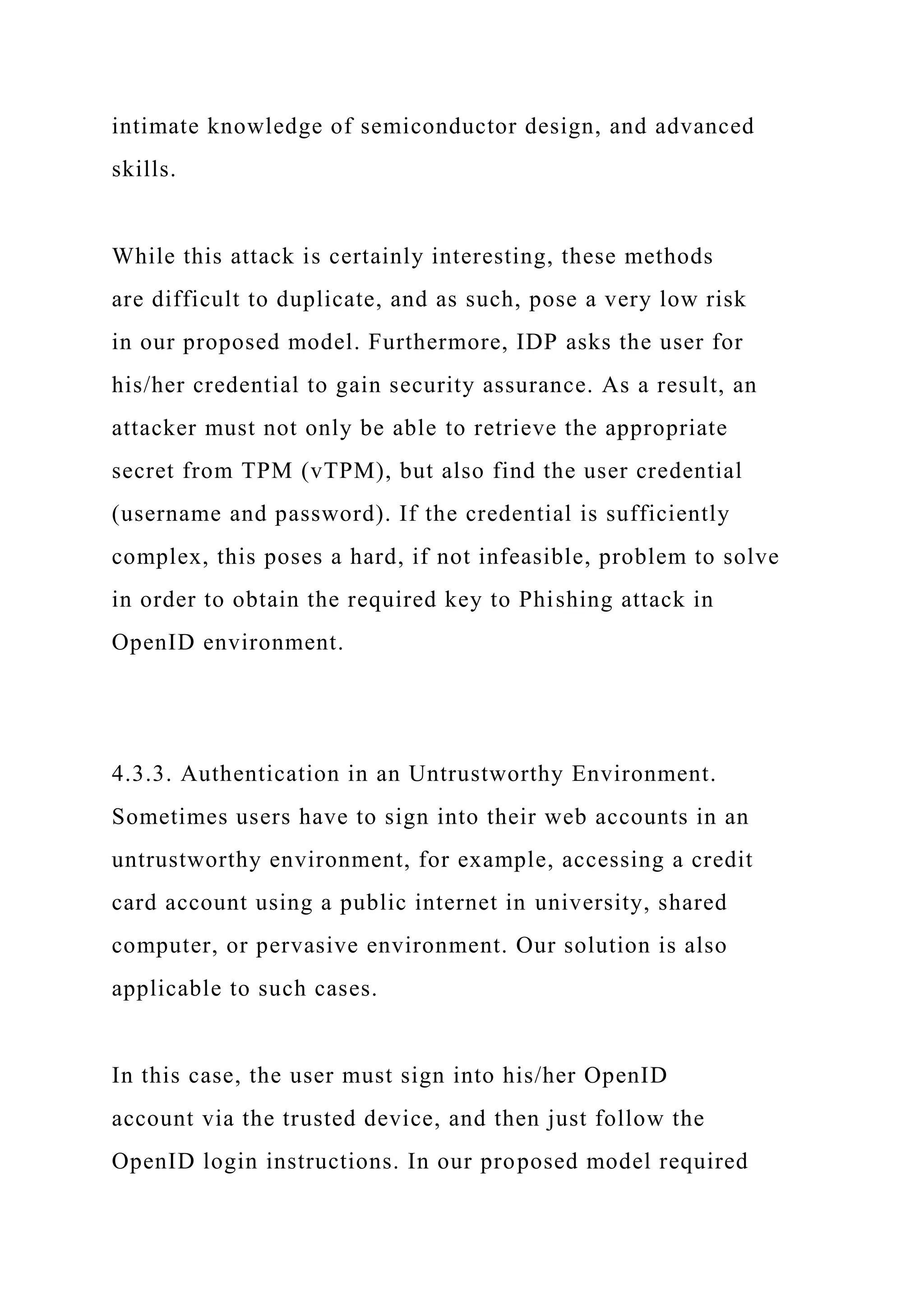
![16 The Scientific World Journal
checking the TPM for each authentication regardless of
cookies attesting the integrity of the trusted device. Because
of the using TPM and trusted device, the user can read the
authentication information from the device and then log into
the website on the untrustworthy device.
Khiabani et al. [21] described that pervasive systems are
weaving themselves in our daily life, making it possible to
collect user information invisibly, in an unobtrusive manner
by even unknown parties. So OpenID as a security activity
would be a major issue in these environments. The huge
number of interactions between users and pervasive devices
necessitates a comprehensive trust model which unifies
different trust factors like context, recommendation, and
history to calculate the trust level of each party precisely.
Trusted computing enables effective solutions to verify the
trustworthiness of computing platforms in untrustworthi-
ness environment.](https://image.slidesharecdn.com/1-221101035239-dffccca1/75/1-Security-and-vulnerability-assessment-analysis-tool-Microsoft-docx-220-2048.jpg)
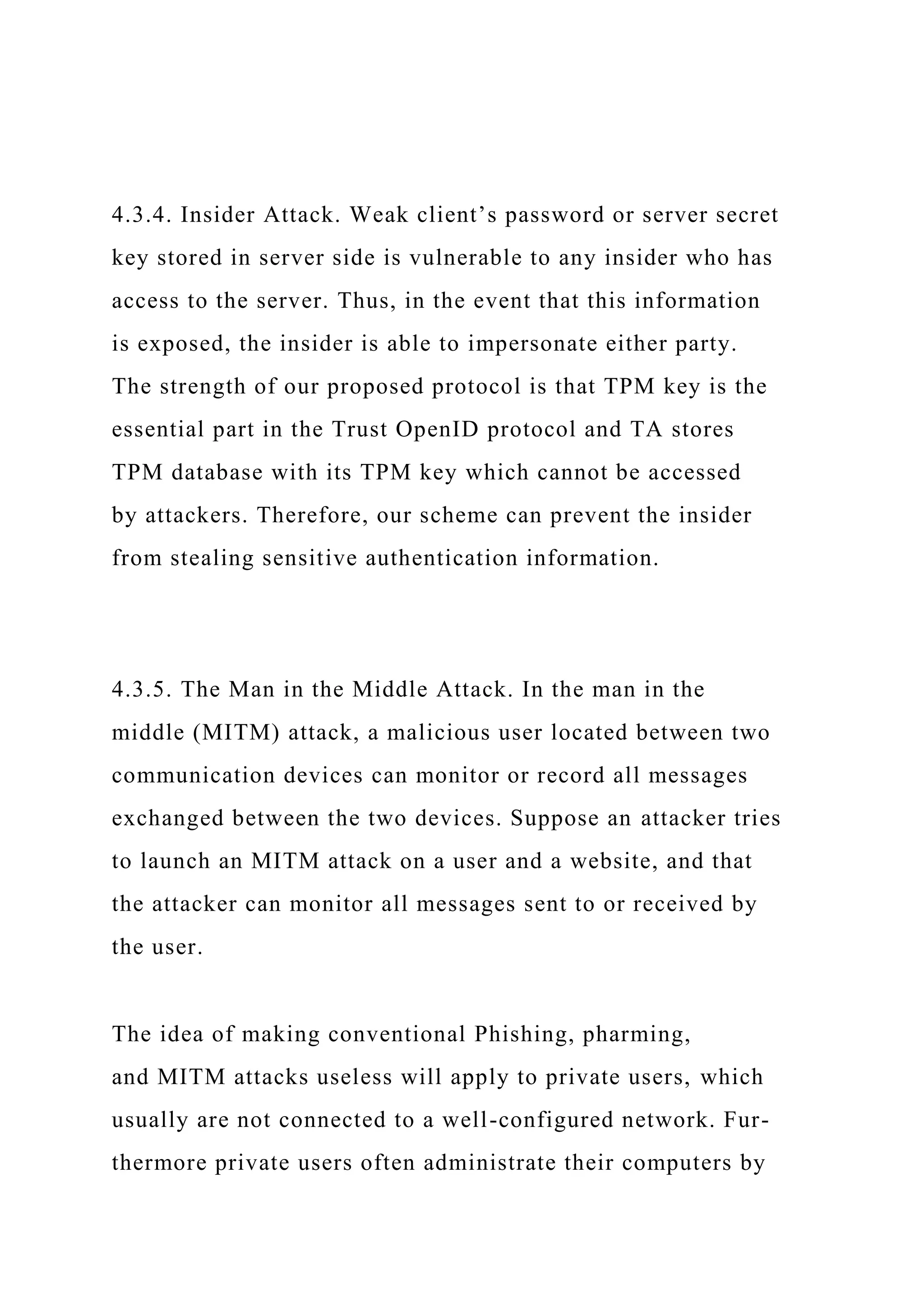
![themselves. Using public key infrastructures (PKI), stronger
mutual authentication such as secret keys and password,
latency examination, second channel verification, and one
time password are some of the ways which have been released
to prevent MITM in the network area.
Mat Nor et al. in [16] described that many security
measures have been implemented to prevent MITM attacks
such as Secure Sockets Layer (SSL) or Transport Layer
Security (TLS) protocol; adversaries have come out with a
new variant of MITM attack which is known as the Man-
in-the-Browser (MitB) attack which tries to manipulate the
information between a user and a browser and is much harder
to detect due to its nature of attacks.
Trust relationship between interacting platforms has
become a major element in increasing the user confidence
when dealing with Internet transactions especially in online
banking and electronic commerce. Therefore, in our pro-
posed model in order to ensure the validity of the integrity
measurement from the genuine TPM (vTPM), the Attestation
Identity Key (AIK) is used to sign the integrity measurement.
AIK is an asymmetric key and is derived from the unique
Endorsement Key (EK) certified by its manufacturer which](https://image.slidesharecdn.com/1-221101035239-dffccca1/75/1-Security-and-vulnerability-assessment-analysis-tool-Microsoft-docx-222-2048.jpg)
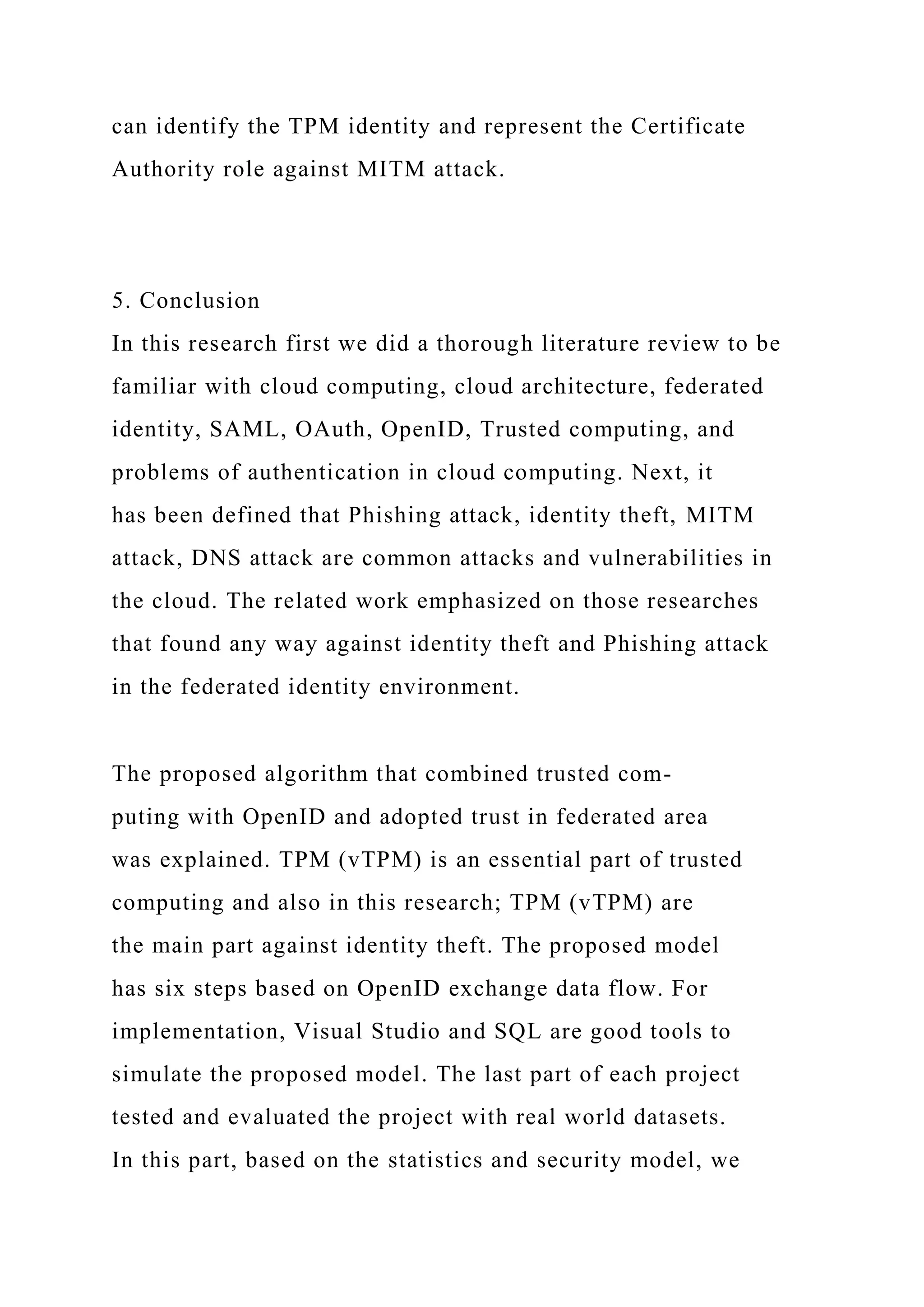
![proposed BLP and adopted it for the Trusted OpenID model.
The main goal of this research was to gain some predefined
security objectives based on the problem statement. Besides,
the simulation method has been evaluated against Phishing
attack and also has evaluated the strengths and weaknesses
of the proposed solution in terms of security and considered
possible improvements.
Conflict of Interests
The authors declare that there is no conflict of interests
regarding the publication of this paper.
Acknowledgments
The authors would like to express greatest appreciation
to the Ministry of High Education (MOHE) Malaysia
through Prototype Development Research Grant Scheme
(R.K130000.7338.4L622) for financial support of the research
done in Advanced Informatics School (AIS), Universiti
Teknologi Malaysia (UTM).
References
[1] P. Mell and T. Grance, “The NIST definition of cloud](https://image.slidesharecdn.com/1-221101035239-dffccca1/75/1-Security-and-vulnerability-assessment-analysis-tool-Microsoft-docx-224-2048.jpg)
![computing
(draft),” NIST Special Publication, vol. 800, p. 145, 2011.
[2] A. Earls, “Gartner takes on cloud identity management,”
2012,
http://searchsoa.techtarget.com/tip/Gartner-takes-on-cloud-
identity-management.
[3] U. F. Rodriguez, M. Laurent-Maknavicius, and J. Incera-
Dieguez, Federated Identity Architectures, 2006.
http://searchsoa.techtarget.com/tip/Gartner-takes-on-cloud-
The Scientific World Journal 17
[4] I. M. Abbadi and A. Martin, “Trust in the cloud,”
Information
Security Technical Report, vol. 16, no. 3-4, pp. 108–114, 2011.
[5] A. Carmignani, Identity Federation Using SAML and
WebSphere](https://image.slidesharecdn.com/1-221101035239-dffccca1/75/1-Security-and-vulnerability-assessment-analysis-tool-Microsoft-docx-225-2048.jpg)
![Software, 2010.
[6] TCG, “Trusted computing,” 2012,
http://www.trustedcomput-
inggroup.org/trusted computing.
[7] L. Yan, C. Rong, and G. Zhao, “Strengthen cloud computing
security with federal identity management using hierarchical
identity-based cryptography,” Cloud Computing, pp. 167–177,
2009.
[8] S.-T. Sun, E. Pospisil, I. Muslukhov, N. Dindar, K. Hawkey,
and
K. Beznosov, “What makes users refuse web single sign-on?:
an empirical investigation of OpenID,” in Proceedings of the
7th
Symposium on Usable Privacy and Security (SOUPS ’11), p. 4,
July
2011.
[9] S. Wang, An Analysis of Web Single Sign-on, 2011.
[10] H. Hodges, Johansson, and Morgan, Towards Kerberizing
Web](https://image.slidesharecdn.com/1-221101035239-dffccca1/75/1-Security-and-vulnerability-assessment-analysis-tool-Microsoft-docx-226-2048.jpg)
![Identity and Services, Kerberos Consortium, 2008.
[11] A. Armando, R. Carbone, L. Compagna, J. Cuellar, and L.
Tobarra, “Formal analysis of SAML 2.0 web browser single
sign-
on: breaking the SAML-based single sign-on for google apps,”
in Proceedings of the 6th ACM Workshop on Formal Methods in
Security Engineering (FMSE ’08), pp. 1–9, October 2008.
[12] K. Wang and Q. Shao, “Analysis of cloud computing and
information security,” in Proceedings of the 2nd International
Conference on Frontiers of Manufacturing and Design Science
(ICFMD ’11), pp. 3810–3813, Taichung, Taiwan, December
2011.
[13] P. Madsen, Y. Koga, and K. Takahashi, “Federated identity
management for protecting users from ID theft,” in Proceedings
of the Workshop on Digital Identity Management, pp. 77–83,
2005.
[14] J. H. You and M. S. Jun, “A mechanism to prevent RP
phishing
in OpenID system,” in Proceedings of the IEEE/ACIS 9th Inter-
national Conference on Computer and Information Science
(ICIS](https://image.slidesharecdn.com/1-221101035239-dffccca1/75/1-Security-and-vulnerability-assessment-analysis-tool-Microsoft-docx-227-2048.jpg)
![’10), pp. 876–880, 2010.
[15] X. Ding and J. Wei, “A scheme for confidentiality
protection
of OpenID authentication mechanism,” in Proceedings of the
International Conference on Computational Intelligence and
Security (CIS ’10), pp. 310–314, December 2010.
[16] F. B. Mat Nor, K. Abd Jalil, and J.-L. Ab Manan, “Remote
user authentication scheme with hardware-based attestation,”
Communications in Computer and Information Science, vol.
180,
no. 2, pp. 437–447, 2011.
[17] S.-T. Sun, Y. Boshmaf, K. Hawkey, and K. Beznosov, “A
billion
keys, but few locks: the crisis of web single sign-on,” in
Proceedings of the New Security Paradigms Workshop (NSPW
’10), pp. 61–71, September 2010.
[18] K. A. J. Fazli Bin Mat Nor and J. l. Ab Manan, “Mitigating
man-
in-the-browser attacks with Hardware-based authentication
scheme,” International Journal of Cyber-Security and Digital
Forensics, vol. 1, no. 3, p. 6, 2012.](https://image.slidesharecdn.com/1-221101035239-dffccca1/75/1-Security-and-vulnerability-assessment-analysis-tool-Microsoft-docx-228-2048.jpg)
![[19] C. Latze and U. Ultes-Nitsche, “Stronger authentication in
e-
commerce: how to protect even Näıve user against Phishing,
pharming, and MITM attacks,” in Proceedings of the Interna-
tional Association of Science and Technology for Development
(IASTED ’07), pp. 111–116, October 2007.
[20] P. Urien, “An OpenID provider based on SSL smart cards,”
in
Proceedings of the 7th IEEE Consumer Communications and
Networking Conference (CCNC ’10), pp. 1–2, Las Vegas, Nev,
USA, 2010.
[21] H. Khiabani, J.-L. A. Manan, and Z. M. Sidek, “A study of
trust
& privacy models in pervasive computing approach to trusted
computing platforms,” in Proceedings of the International Con-
ference for Technical Postgraduates (TECHPOS ’09), pp. 1–5,
December 2009.
[22] B. Ferg, OpenID Authentication 2. 0-Final, OpenID
Commu-
nity, 2007.](https://image.slidesharecdn.com/1-221101035239-dffccca1/75/1-Security-and-vulnerability-assessment-analysis-tool-Microsoft-docx-229-2048.jpg)
![[23] M. Donovan and E. Visnyak, “Seeding the cloud with trust:
real world trusted multi-tenancy use cases emerge,” 2011,
http://www.ittoday.info/Articles/Trust/Trust.htm.
[24] P. Cooke, “Black Hat TPM Hack and BitLocker,” 2010,
http://bl-
ogs.windows.com/windows/b/windowssecurity/archive/2010/
02/10/black-hat-tpm-hack-and-bitlocker.aspx.
http://www.ittoday.info/Articles/Trust/Trust.htm
http://bl-/
Eghbal Ghazizadeh,1 Mazdak Zamani,1 Jamalul-lail Ab
Manan,2 and Mojtaba Alizadeh11. Introduction2. Proposed](https://image.slidesharecdn.com/1-221101035239-dffccca1/75/1-Security-and-vulnerability-assessment-analysis-tool-Microsoft-docx-230-2048.jpg)